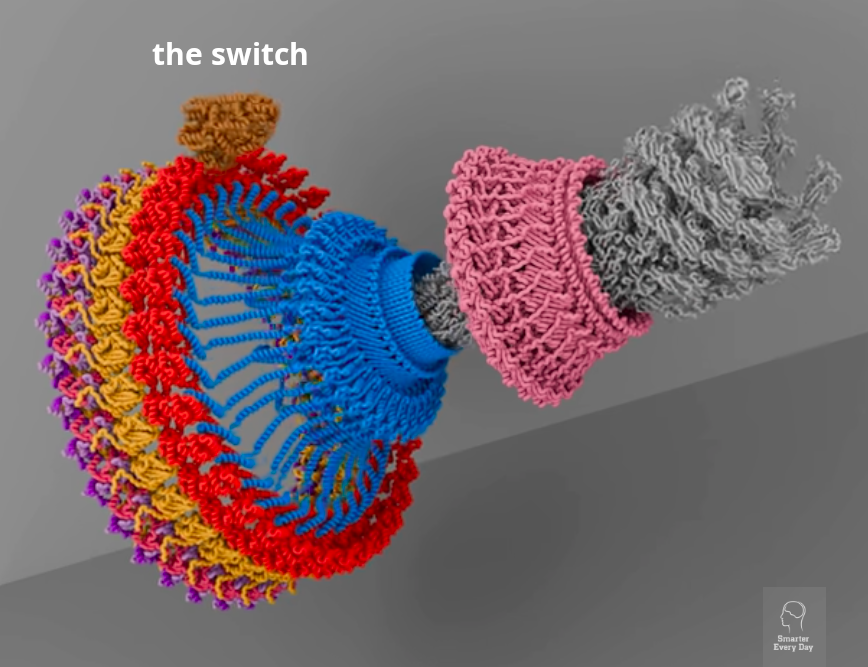 |
three minds | straight | random | switch | |
Bacteria flagellar motors rotate clockwise (untangling the flagella and making the bacteria tumble randomly) or counterclockwise (wrapping the flagella into a whip and making the bacteria swim straight). An excitatory regulator CheY, when phosphorylated by enzyme CheA kinase, triggers the switch from swimming to tumbling. The motor is thought to have evolved from ATP synthase employed as a primitive secretion system.
Smarter Every Day. Nature's Incredible Rotating Motor (It’s Electric!)
Prashant K. Singh, Pankaj Sharma, Oshri Afanzar, Margo H. Goldfarb, Elena Maklashina, Michael Eisenbach, Gary Cecchini, T. M. Iverson. CryoEM structures reveal how the bacterial flagellum rotates and switches direction.
Renyi Liu, Howard Ochman. Stepwise formation of the bacterial flagellar system. #1755  |
-3350000000 |
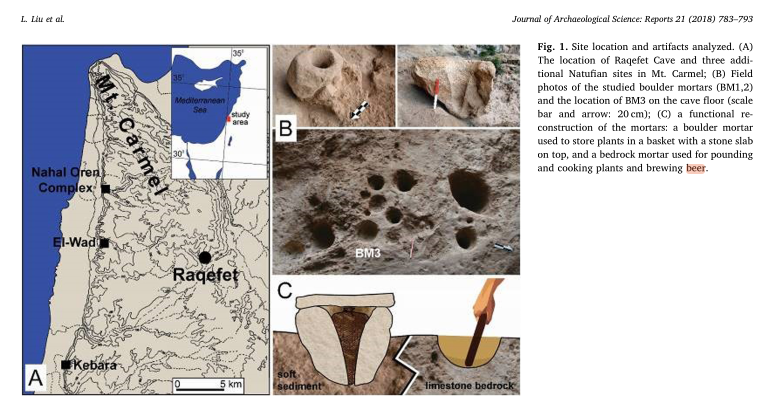 |
three minds | drinking | brewing | experimenting | |
Archeologists Jiajing Wang and György Lengyel reported on the ritual use of alcoholic beverages by the pre-agricultural Natufians at the Raqefet Cave in Israel.
The Natufians at Raqefet Cave collected locally available plants, stored malted seeds, and made beer as a part of their mortuary rituals to venerate the dead and/or to enhance group cohesion among the living ... They used stone mortars as brewing facilities, involving three basic stages: malting, mashing, and fermenting. The deep boulder mortars (BM1 and BM2) were used at least in part as storage containers for keeping cereals and USOs, including malted wheat/barley; the bedrock mortar (BM3) was used for pounding, cooking, and brewing beer (Fig. 1C). The Raqefet Cave mortars reveal the earliest evidence for making basketry with bast fibers, including flax, as malting equipment. Using boulder mortars for food storage was a significant innovation, which may have facilitated the shift towards a sedentary life style ... The time and effort invested in the manufacture of deep stone mortars in mortuary contexts and in acquisition of knowledge apparently required for beer brewing indicate an important ritual function played by alcoholic beverages in the Natufian culture. The
Raqefet Cave beer was likely very low in alcoholic content, but it accounts for the earliest known experiment in making fermented beverages in the world.
Jiajing Wang, György Lengyel. Fermented beverage and food storage in 13,000 y-old stone mortars at Raqefet Cave, Israel: Investigating Natufian ritual feasting. #1748  |
-11000 |
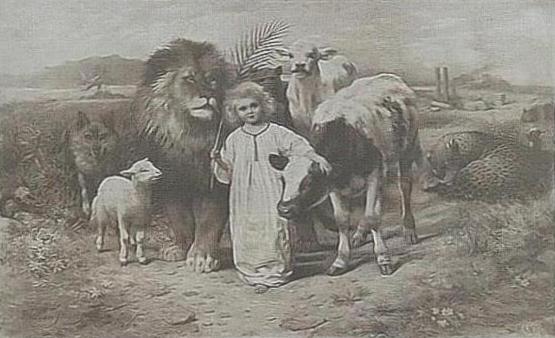 |
three minds | appearances | hearsay | fear of the Lord | |
Hebrew prophet Isaiah prophesied that the House of David, the son of Jesse, would bring forth a Messiah who would judge not by appearances, nor by hearsay, but animated by the fear of the Lord.
And a shoot shall spring forth from the stem of Jesse, and a twig shall sprout from his roots. And the spirit of the Lord shall rest upon him, a spirit of wisdom and understanding, a spirit of counsel and heroism, a spirit of knowledge and fear of the Lord. And he shall be animated by the fear of the Lord, and neither with the sight of his eyes shall he judge, nor with the hearing of his ears shall he chastise. And he shall judge the poor justly, and he shall chastise with equity the humble of the earth, and he shall smite the earth with the rod of his mouth and with the breath of his lips he shall put the wicked to death. And righteousness shall be the girdle of his loins, and faith the girdle of his loins.
And a wolf shall live with a lamb ... and a small child shall lead them. ... They shall neither harm nor destroy on all My holy mount, for the land shall be full of knowledge of the Lord as water covers the seabed.
Yeshayahu (Isaiah) - Chapter 11. #1746  |
-700 |
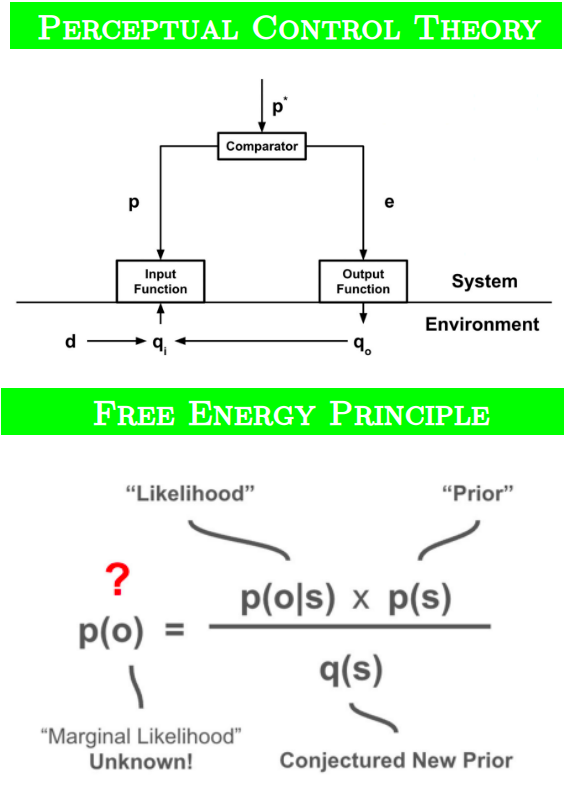 |
three minds | external negative feedback | internal generative model | | |
Theoretical and computational neuroscientists Ty Roachford, Warren Mansell and Rodrigo Pena compared Perceptual Control Theory and the Free Energy Principle. They concluded that the two frameworks are complementary.
PCT achieves a mechanistic definition of behavior by focusing on a ubiquitous physical feature that living and some non-living things must have—namely, control through mechanistic negative feedback. This is in contrast to the FEP, which achieves a statistical definition of behavior by ubiquitously interpreting all things as minimizing free energy over a generative model. Whilst PCT redefines behavior as the control of perception, FEP redefines behavior as the reduction in uncertainty about states expected to bring about preferred perceptions. To put it even more simply, PCT regards control as fundamental and as a precondition for probability estimation, whereas FEP regards information as fundamental and as a precondition for control. At their core, PCT systems have no internal model to maintain and update, and require no information for probability theory to utilize, whereas an internal world model
updated by reducing uncertainty through new information is fundamental to FEP.
Ty Roachford, Warren Mansell, Rodrigo Pena. PCT vs. FEP: A Comparison Between Reorganization Theory and Bayesian Inference.
Ty Roachford: "PCT vs. FEP: A Comparison" #1744  |
2025 |
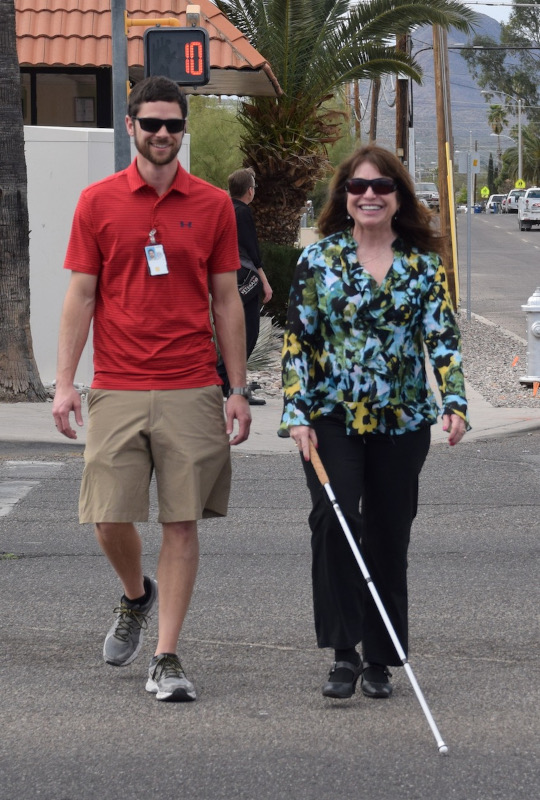 |
three minds | calibrate | generate | | |
British neuroscientist Anil Seth, following Plato, Kant and Helmholtz, explained perception as controlled hallucination.
The basic idea is that the brain has no direct access to the world or the body. It's locked away inside this bony skull. And so it has to make inference about what's out there on the basis of the sensory signals that it gets. The sensory signals that come in through the eyes and the ears, you know, they're they're only indirectly related to what's out there in the world. They're noisy. They're ambiguous. They're uncertain. They're unlabeled. So the idea is the brain is doing something like Bayesian inference. It's saying OK, here's what I believe now about the state of the world in the body and here's some new data so how should I update what I believe?
... the first claim is that the brain does this by continually generating predictions about the sensory data that it's expecting to get in levels across these hierarchies in the brain. Sensory input in this view isn't something that's read out by the brain. It's rather prediction error. It's the difference between what the brain expects and what it gets. And so the brain uses sensory data to keep its predictions tied to the world. And in doing this, it can sort of solve this problem, at least approximately, of Bayesian inference, of inferring in a best guess the most likely causes of sensory signals. So that's kind of a claim about the mechanism in the brain.
And the second claim, at least for me, is that what we consciously experience is not a readout of the sensory signals. It is rather the content of the brain's predictions. So it's sort of coming from the inside-out calibrated by the outside-in sensory signals. And that's why I use the the term controlled hallucination because it connotes something like experience being internally generated but controlled by sensory signals from the world and the body.
Evan McGloughlin. No. 1 Consciousness Expert: Optical Illusions that Prove Reality is a Lie, Emotions, Books and AI! #1743  |
2025 |
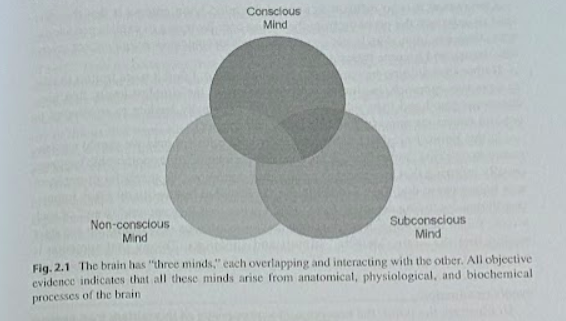 |
three minds | memories | sense of self | | |
American neuroscientist W.R.Klemm argued for a materialist account of our experience by which the brain has "three minds": non-conscious, subconscious and conscious.
• Non-conscious processing enables neurons to detect sensations. Even animals can be afraid of snakes. But we have to ask, "Are they aware that they have detected a snake?" That is, do they have a sense of self, and do they know that they know about snakes and why they are to be avoided?
• Subconscious mind is the mind with buried memories, unrecognized desires, compulsions and assorted emotions. This mind operates when we sleep and operates without conscious recognition throughout our wakefulness.
• Conscious mind, most fundamentally, has the "sense of self." That is, conscious mind knows it exists, residing separate from subconscious mind and able to be aware of at least some of what it knows and thinks.
For now, let me assert that a whole mind consists of three interacting "minds," each of which IS brain function - albeit different manifestations of brain function.
W.R.Klemm. Atoms of Mind: The "Ghost in the Machine" Materializes.
Klemm's Three Minds #1736 ❤️Daniel Friedman  |
2011 |
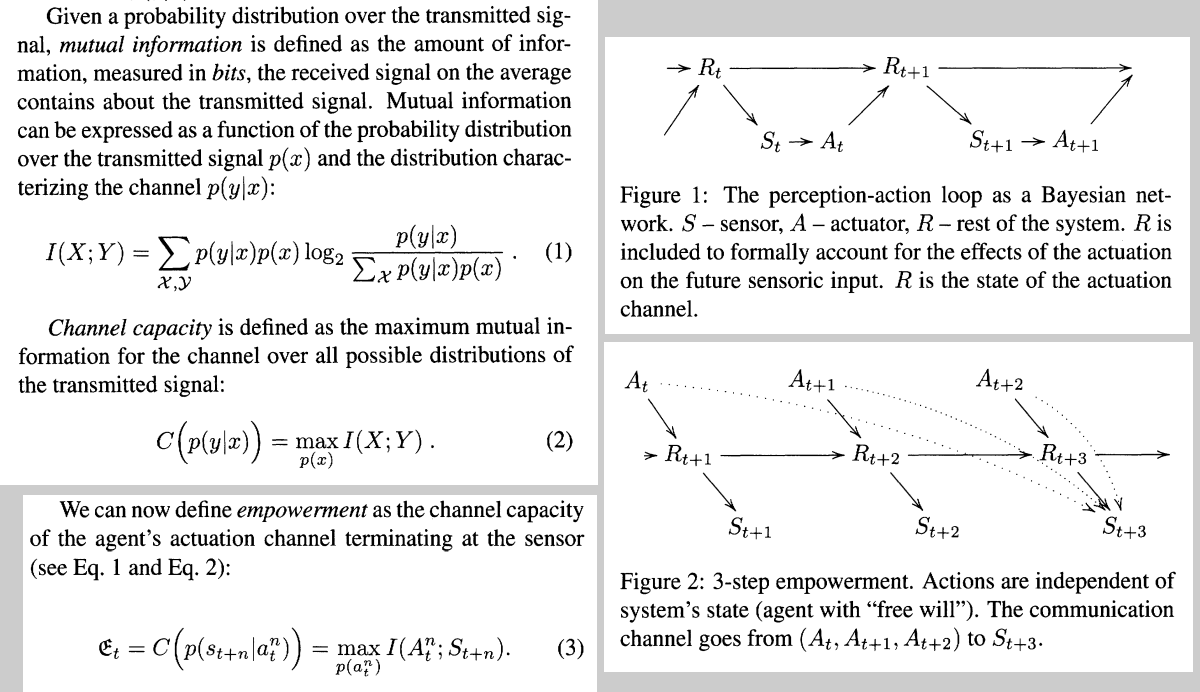 |
three minds | perception | action | control | |
Adaptive systems and algorithm researchers Alexander S. Klyubin, Daniel Polani and Chrystopher L. Nehaniv in the United Kingdom proposed empowerment as a general purpose utility function which explains the sensory motor apparatus for a variety of agents.
...similar to Gibson's ecological approach to visual perception, we define what an agent does solely in terms of what it perceives. ... We build on Gibson's view of perception-action as being central to agents and go even further by: (1) making actuators as important as sensors, and (2) providing an agent-centric quantification of the amount of control or influence the agent has and perceives.
Alexander S. Klyubin, Daniel Polani, and Chrystopher L. Nehaniv. Empowerment: A Universal Agent-Centric Measure of Control.
#1734  |
2005 |
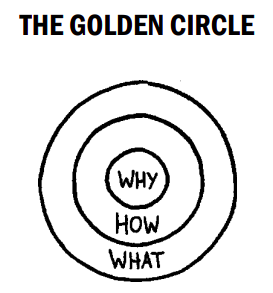 |
foursome | | what | how | why |
American inspirational speaker Simon Sinek, inspired by the golden ratio, defined the Golden Circle as a target with three rings, What - How - Why, with Why at the center.
• WHAT: Every single company and organization on the planet knows WHAT they do. This is true no matter how big or small, no matter what industry. Everyone is easily able to describe the products or services a company sells or the job function they have within that system. WHATs are easy to identify.
• HOW: Some companies and people know HOW they do WHAT they do. Whether you call them a "differentiating value proposition," "proprietary process" or "unique selling proposition," HOWs are often given to explain how something is different or better. Not as obvious as WHATs, many think these are the differentiating or motivating factors in a decision. It would be false to assume that's all that is required. There is one missing detail:
• WHY: Very few people or companies can clearly articulate WHY
they do WHAT they do. When I say WHY, I don't mean to make money—that's a result. By WHY I mean what is your purpose, cause or belief? WHY does your company exist? WHY do you get out of bed every morning? And WHY should anyone care? When most organizations or people think, act or communicate they do so from the outside in, from WHAT to WHY. And for good reason—they go from clearest thing to the fuzziest thing. We say
WHAT we do, we sometimes say HOW we do it, but we rarely say WHY we do WHAT we do.
But not the inspired companies. Not the inspired leaders. Every
single one of them, regardless of their size or their industry, thinks,
acts and communicates from the inside out.
Simon Sinek. Start With 'Why'.
Wikipedia: Start with Why
Simon Sinek. Start with Why: How Great Leaders Inspire Everyone to Take Action. #1721  |
2009 |
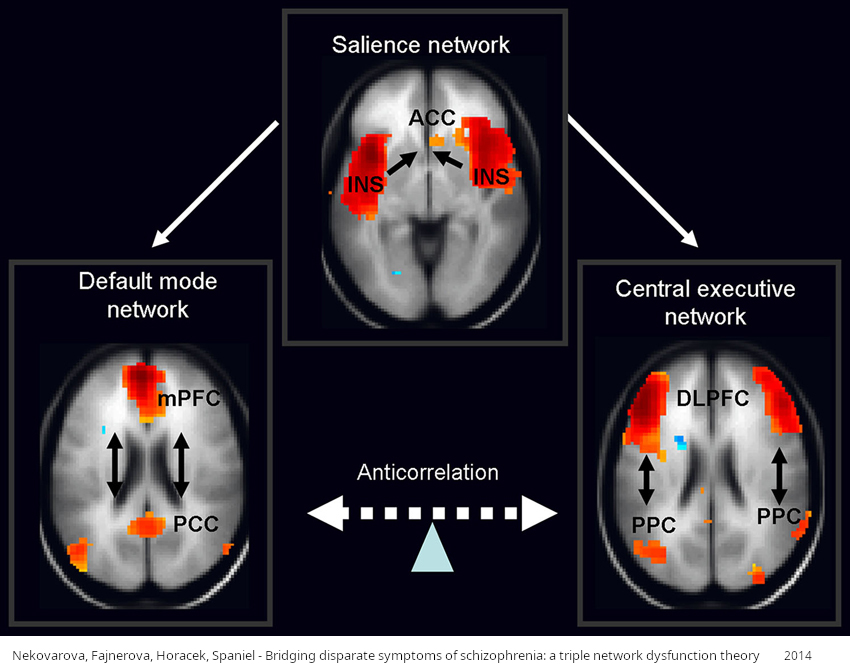 |
three minds | stimulated | relaxed | concentrated | |
American neuropsychiatrist Vinod Menon proposed the triple network model which relates large scale networks in the human brain. The salience network SN facilitates switching between the frontoparietal network (FPN) and the default mode network (DMN). The frontoparietal network is also known as the central executive network.
The SN integrates sensory, emotional, and cognitive information and acts as an interface between the DMN and the FPN to integrate and balance internal mental processes with external stimulus–driven cognitive and affective processes.
Vinod Menon. The Triple Network Model, Insight, and Large-Scale Brain Organization in Autism.
Vinod Menon. Large-scale brain networks and psychopathology: a unifying triple network model
Tereza Nekovarova, Iveta Fajnerova, Jiri Horacek, Filip Spaniel. Bridging disparate symptoms of schizophrenia: a triple network dysfunction theory. #1713  |
2011 |
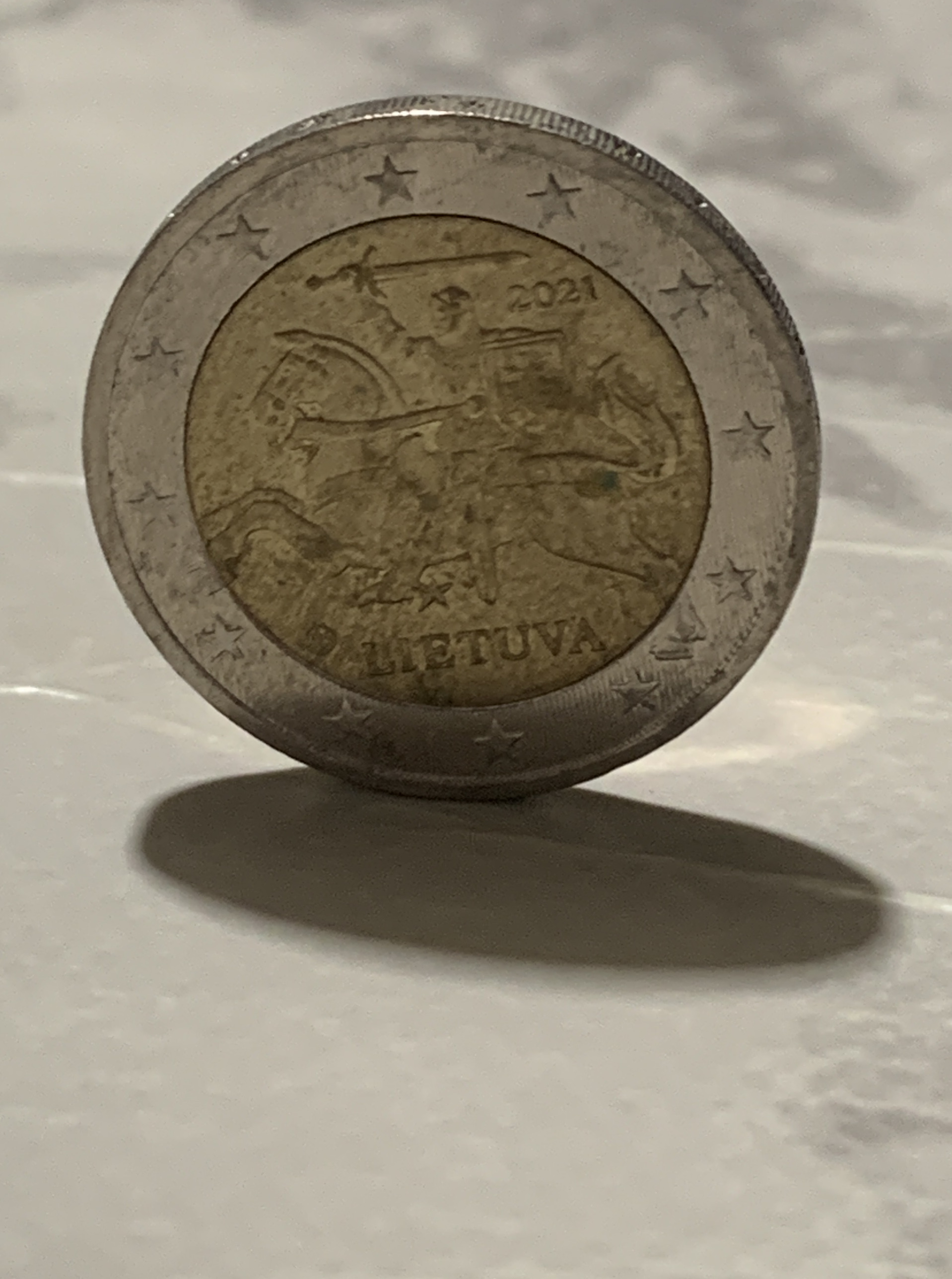 |
three minds | likely | unlikely | | |
Lithuanian author Mantas Adomėnas, in his novel "The Coin and the Labyrinth", described how Tomas analyzed his colleagues at the spy bureau, seeking out his betrayor.
...this must be done in two strokes, two stages: first to name the most predictable, statistically most likely fate of the protagonist; subsequently - and here lies the trick - to discard this first version as a bad, worthless card. Only then to look for that deeper, unexpected "I" by which the agent might astonish.
"Why? ... That's likely to be closer to the truth than the initial guess.
The initial guess distinguishes that which is likely, regular. For the modern person's mind, just as contemporary science, just as literature, orients itself to that which is likely, average and predictable. The science of old analyzed the possibility of unicorns, giants and centaurs. Literature was about that which is amazing, incredible, unique, miraculous, but modern literature exiled that beyond the horizon of experience.
Thus neither in literature nor in life do we expect sudden plot twists, such as a hurricane, flood or deux ex machina. And if they happen, we take them to be a cheap trick not worthy of a real writer... When something unusual happens in our lives, we say, "If it happened in a novel, nobody would believe it!" or "Truth is stranger than fiction". Thus in predicting the future, we should first expect that which is unlikely.
Mantas Adomėnas. Moneta ir labirintas.
#1703  |
2023 |
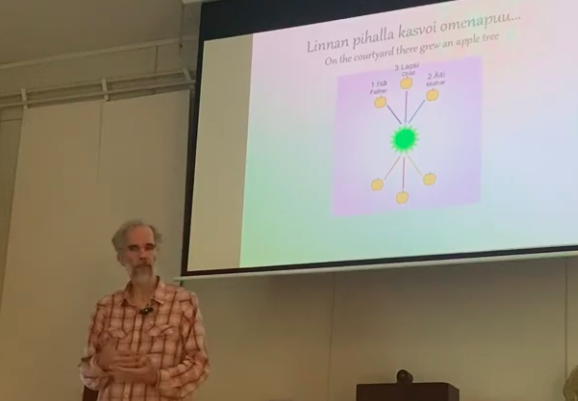 |
three minds | feminine | masculine | infantile | |
Finnish musician Veli Martin Keitel expounded the mythological world by which science and religion could work together.
So once upon in a far far far away land, there was ... the good king and the good queen and they had a child that was an innocent child. This is the basis of the holy trinity ... the Christian term for the original three archetypes which which came from the one kingdom. So out of oneness you get the three archetypes of of masculine, feminine and neutral.
Secrets of the World Tree by Veli Martin Keitel #1692  |
2025 |
 |
three minds | irrational | useful | grateful | |
American film director Woody Allen starred with Diane Keaton in the romantic comedy "Annie Hall". He ends the movie with a voice over about their relationship.
I realized what a terrific person she was and-and how much fun it was just knowing her and I-I thought of that old joke, you know, this-this-this guy goes to a psychiatrist and says, "Doc, uh, my brother's crazy. He thinks he's a chicken." And, uh, the doctor says, "Well, why don't you turn him in?" And the guy says, "I would, but I need the eggs." Well, I guess that's pretty much how how I feet about relationships. You know, they're totally irrational and crazy and absurd and ... but, uh, I guess we keep goin' through it because, uh, most of us need the eggs.
Woody Allen, Marshall Brickman. Annie Hall. Screenplay.
Annie Hall. Final Scene. #1688  |
1977 |
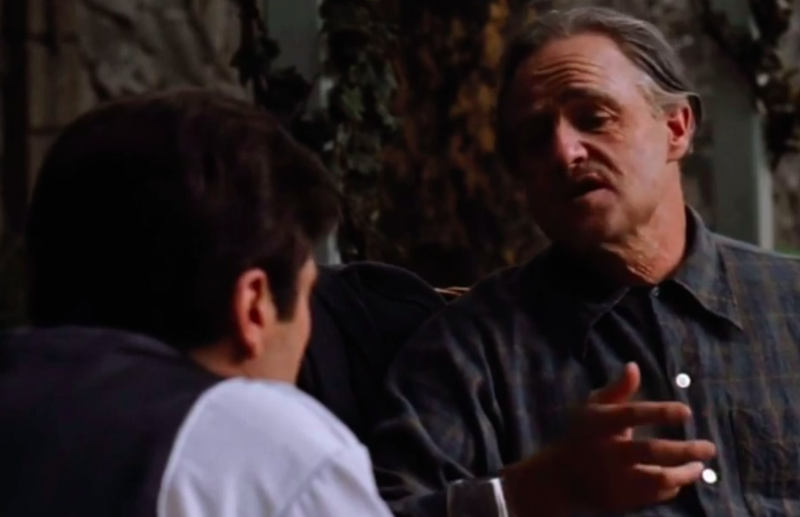 |
three minds | carefree | careful | willful | |
Author Mario Puzo and director Francis Ford Coppola wrote the screenplay for the Hollywood movie "The Godfather". The Godfather, Vito Corleone, played by Marlon Brando, warns his son Michael, played by Al Pacino, about their rival, who will try to assassinate Michael with the help of a betrayor.
I hope you don't mind the way I...I keep going over this Barzini business...
No, not at all...
It's an old habit. I spent my life trying to be careful. Women and children can be careless, but not men.
Mario Puzo, Francis Ford Coppola. The Godfather. Screenplay.
The Godfather. “Women And Children Can Be Careless, But Not Men”. #1687  |
1972 |
 |
threesome | designer | artifact | user | |
Italian philosopher Luca Possati developed a simulation for modeling human-technology interactions.
The purpose of the dau-active-inference package is to allow a user to run an active inference based simulation for three interacting agents: a Designer, an Artifact, and a User. The Designer is attempting to steer the Artifact, the Artifact is trying to steer the User, and the User is trying to steer the Artifact. The overall operation of the agents is based on the active inference principle and is represented in the following diagram...
GitHub. Designer-Artifact-User package. #1686  |
2025 |
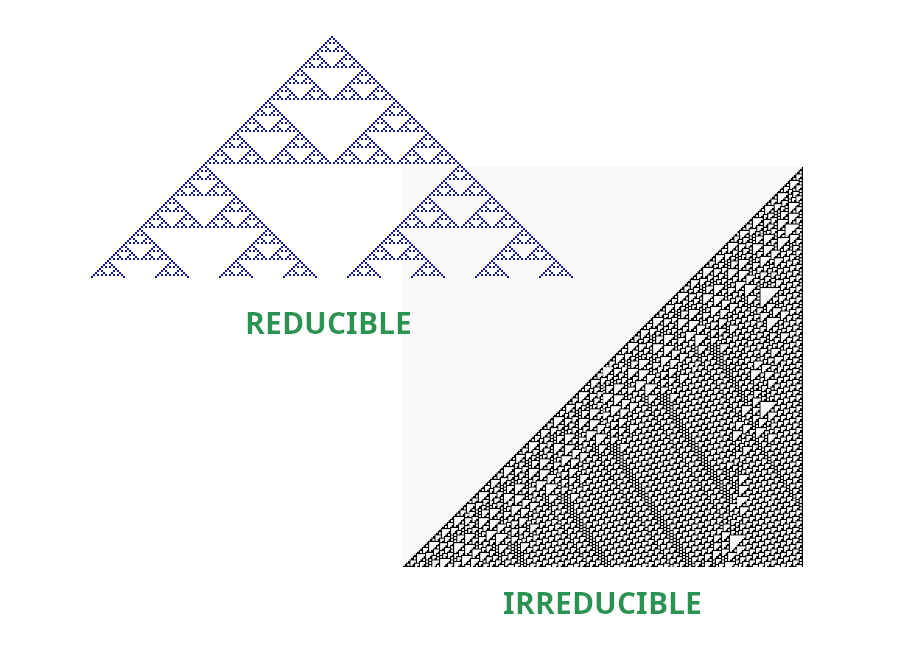 |
three minds | irreducibility | reducibility | | |
British-American computer scientist Stephen Wolfram proposed that the arrow of time is a consequence of computational reducibility.
... one of the questions in economics is what is value? What makes something valuable? ... computational reducibility.
... in the world at large, there's lots of computational irreducibility, lots of things that are unpredictable, lots of things you can't do quickly, and so on. But we humans have one thing in fairly short supply, and that's time ... So for us, anything that kind of speeds up what we can achieve is something that is valuable to us. And computational reducibility is the possibility of finding these little pockets where you can kind of jump ahead ...
Stephen Wolfram. The Simple Reason for Time's Arrow That Physics Missed. #1684  |
2025 |
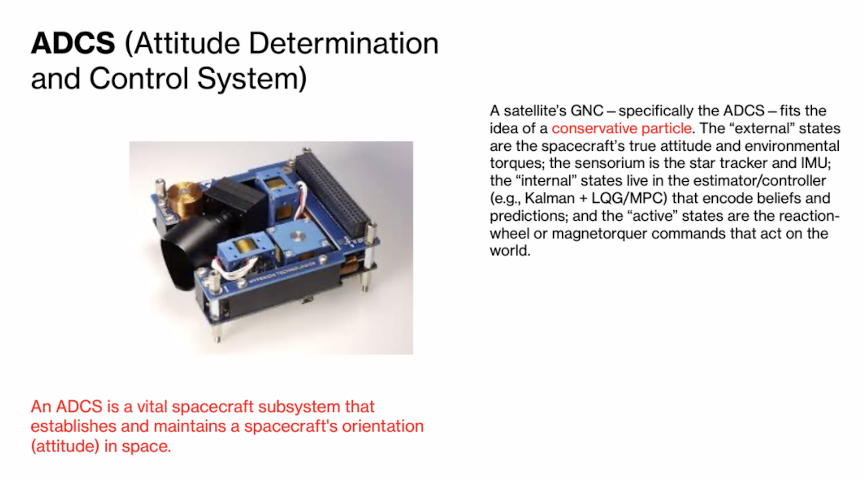 |
three minds | agents | agents and instruments | | |
Italian philosopher Luca Possati appealed to Active Inference to bridge two conceptions of agency.
Things go far beyond merely affecting what we do - they change and impact how reality is disclosed to us.
• a) the strong view, exemplified by Latour and ANT [Actor-network theory], which develops a symmetrical or "flat" ontology in which agency is distributed equally among humans and nonhumans, with no ontological or epistemological distinction between different types of agency;
• b) the weak view, represented by postphenomenology, the work of ecological psychologists, classical phenomenology, and anthropology, which maintains an ontological and epistemological distinction between human agency and nonhuman agency.
Luca Possati. What is an artifact? Active inference and technology. #1683  |
2025 |
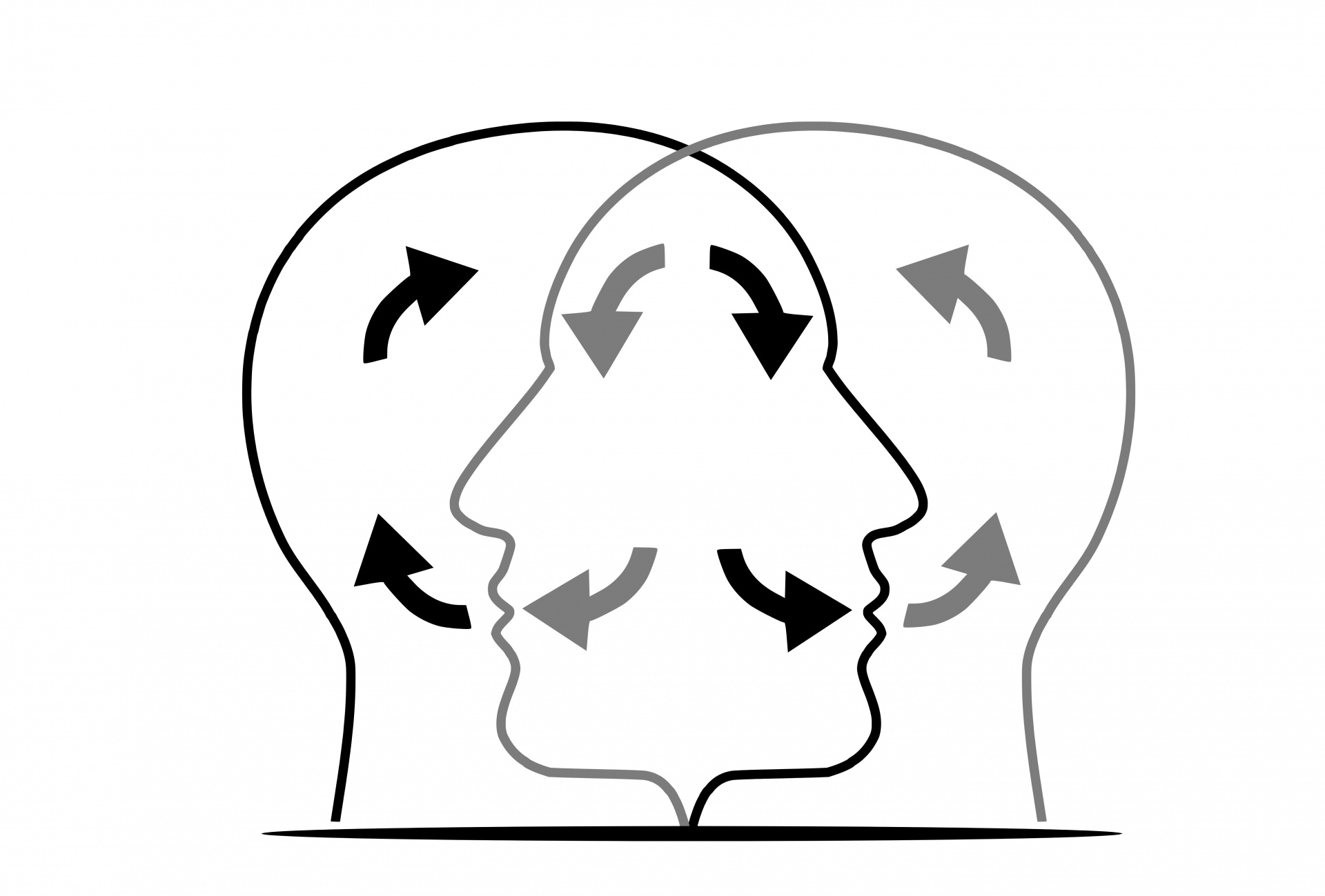 |
three minds | feel | analyze | | |
American AI researcher Ben Goertzel and his colleagues, inspired by the discovery of mirror neurons, interpreted i=j×k in the algebra of quaternions to stand for i observes (j observes k), and similarly for octonions.
The key point is that human self is intrinsically not autonomous and independent, but rather is intrinsically dialogic and intersubjective.
Another way to phrase this is in terms of “empathy.” ... we do it, in part, by running simulations of the other minds internally – by spawning virtual actors, virtual selves within our own minds that emulate these other actors (according our own understanding). This is why we have the feeling of
empathy – of feeling what another mind is feeling. It’s because we actually are feeling what the other mind is feeling – in an approximation, because we’re feeling what our internal simulation of the other mind is feeling. Thus, one way to define “empathy” is as the understanding of other minds via internal simulation of them. Clearly, internal simulation is not the only strategy the human mind takes to studying other minds – the patterns of errors we make in predicting others’ behaviors indicates that there is also an inferential, analytical component to a human’s understanding of others (Carruthers and Smith, 1996).
Ben Goertzel, Onar Aam, F. Tony Smith, Kent Palmer. Mirror Neurons, Mirrorhouses, and the Algebraic Structure of the Self.
Peter Carruthers, Peter K. Smith. Theories of Theories of Mind. #1678  |
2007 |
 |
three minds | feel | talk | peace | |
American black music maker D'Angelo opened his final album, Black Messiah, with the song Ain't It Easy, where he appeals to his darling
Ever hit with a choice that you can't decide?
Direction left or right
Shut your mouth off and focus on what you feel inside
See y'all know I'ma go with my vibe
You won't believe all the things you have to sacrifice
Just to get peace of mind
D'Angelo and The Vanguard. Ain't That Easy.
Sheldon Pearce. D'Angelo, R&B's reluctant icon, has died at 51. #1677  |
2014 |
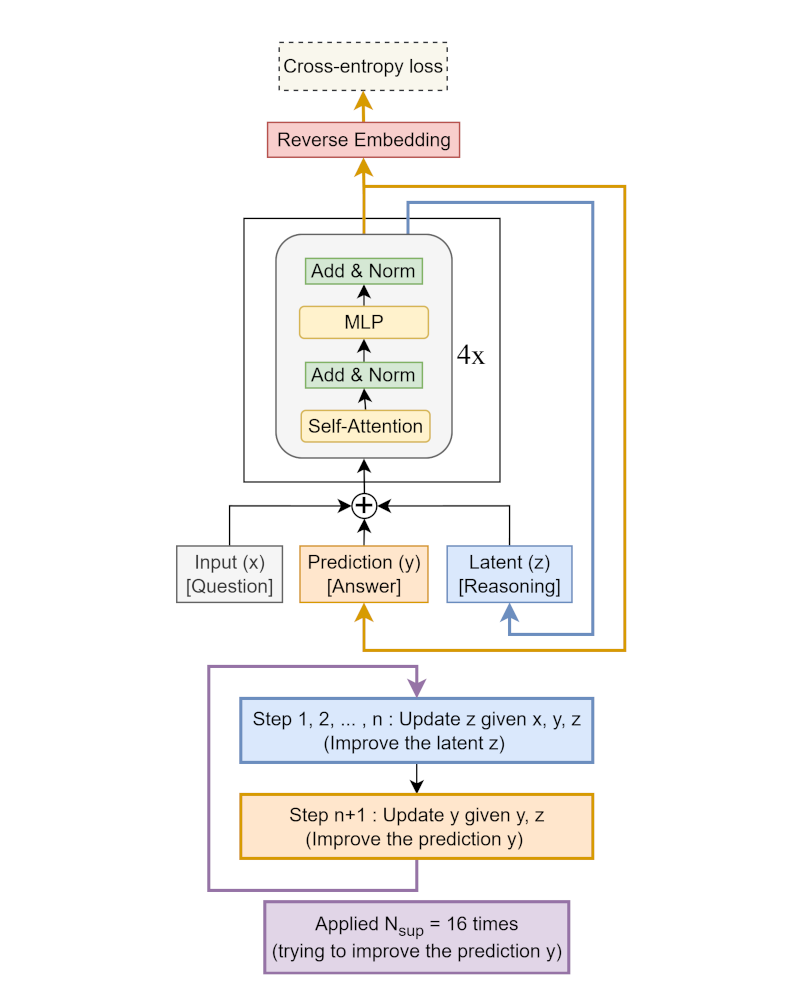 |
three minds | answering | questioning | reasoning | |
Canadian Artificial Intelligence researcher Alexia Jolicoeur-Martineau developed Tiny Recursive Model, a recursive reasoning approach with only 2 layers and 7 million parameters, which scored 45% on the ARC-AGI-1 test, higher than many Large Language Models.
Figure 1. Tiny Recursion Model (TRM) recursively improves its predicted answer y with a tiny network. It starts with the embedded input question x and initial embedded answer y, and latent z. For up to Nsup = 16 improvements steps, it tries to improve its answer y. It does so by
i) recursively updating n times its latent z given the question x, current answer y, and current latent z (recursive reasoning), and then
ii) updating its answer y given the current answer y and current latent z.
This recursive process allows the model to progressively improve its answer (potentially addressing any errors from its previous answer) in an extremely parameter-efficient manner while minimizing overfitting.
Alexia Jolicoeur-Martineau. Less is More: Recursive Reasoning with Tiny Networks.
#1674  |
2025 |
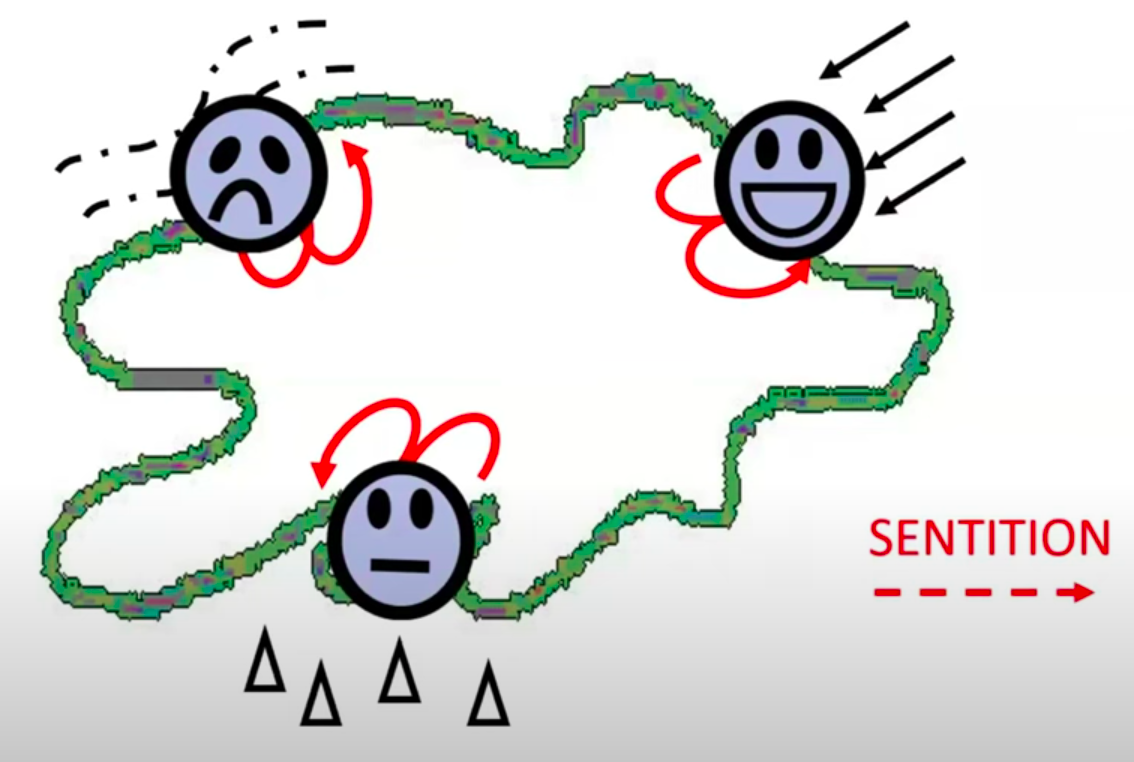 |
three minds | information | interpretation | | |
English neuropsychologist Nicholas Humphrey proposed a sequence of evolutionary events that led to phenomenal qualia.
Sensations ... are not material entities. They are ideas, representations, they're the way your brain represents what's happening at your sense organ and how you feel about it. This means we have to explain their properties not literally as the properties of brain states but rather as the properties of mind states dreamed up by the brain ... representing sensations has to involve a two-stage process. In the case of seeing red for example there will be A - the physical vehicle that carries the information about how the brain evaluates the light arriving at the eyes and then B - the cognitive operation that interprets this as the idea of phenomenal redness.
... I believe sensations originated as active behavioral responses to stimuli arriving at the body surface. There was something the subject did about the stimulation long before they evolved to be something ... these expressive responses that evaluate the inputs at the sense organ, I call them sentition, somewhere between volition and sensation. To start with there are entirely local responses wriggles of acceptance or rejection organized around the site of stimulation
... as the animal's life becomes more complex it reaches a stage where it would indeed benefit from retaining some kind of mental record of what's affecting it, a representation of the stimulus that can serve as the basis for planning and decision ... creating a copy of the command signals for the responses an efference copy that can be read in reverse, as it were, to recreate the meaning of the stimulation ...
the command signals, rather than bringing about actual motor behavior, begin to target the internal body map which the sense organs project to the brain. In this way, sentition evolves to be a virtual bodily response ... the response is being privatized ... it leads to a feedback loop between motor and sensory regions of the brain, a loop with the potential to sustain recursive activity ... the activity can be drawn out in time so as to give rise to the thick moment of sensation ... the activity can be channeled and stabilized to create a mathematically complex attractor state, a dynamic pattern of activity that recreates itself. ... the upshot ... a very special kind of attractor, one that the subject reads is having the feel of phenomenal qualia
Nicholas Humphrey. The Evolution of Consciousness & Sentience: A Tribute to Daniel Dennett. #1670  |
2024 |
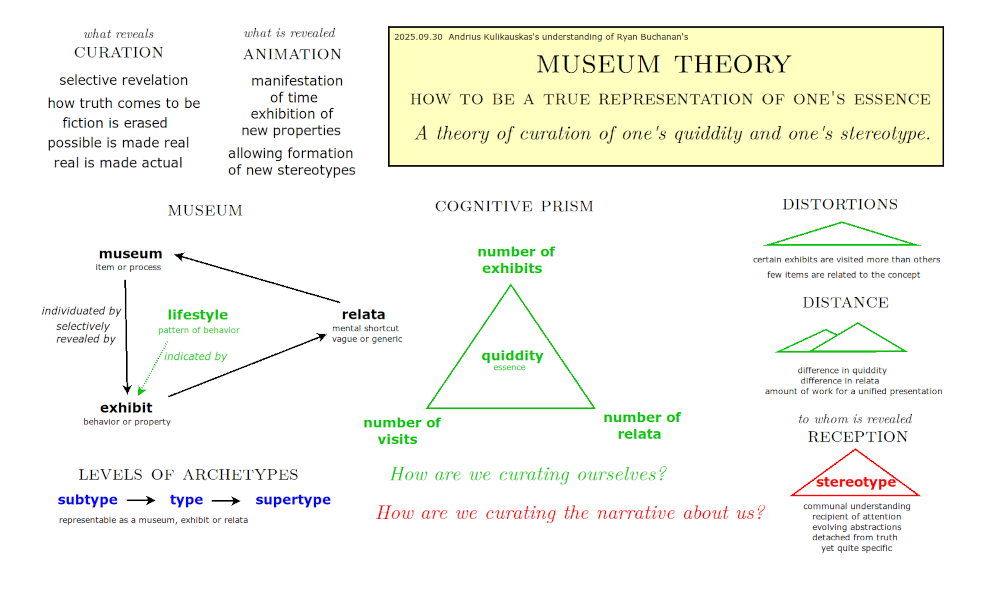 |
three minds | exhibit | relate | curate | |
American polydidact Ryan Buchanan introduced museum theory, which examines how we exhibit, relate and curate ourselves, essentially as quiddities and socially as stereotypes.
By virtue of existing in physical or conceptual space, each and every item (or process) is a museum, which individuates itself through a process of selective revelation over time. An exhibit, we shall say, is some behavior or innate, observable property, which is indicative of an overarching pattern of behavior, or in the case of humans, a lifestyle.
...Now, the relata are formed through the unconscious assignment of "meta-tags;" basically mental or cosmic hyperlinks, which serve as cognitive shortcuts to other, related data.
...The thesis here is that any conceivable object or process is representable as a museum, and sentient systems - organisms with what Freud would call a "superego," seek to curate the exhibits of museums unconsciously or otherwise. Humans, in particular, seek to perfect the stereotype of themselves, by either modifying their behavior, or by using various tactics to engineer and control the visitation of outsiders or modify the publics' processes of affiliation.
Ryan Buchanan. Towards a Theory of Organic Museums. #1669  |
2025 |
 |
three minds | excite | inhibit | transport | |
Chinese zoologists Zhiheng Gou, Xiao Wang and Wen Wang considered the "yin and yang" regulation of the neurotransmitters glutamate, which excites neurons, and gamma-aminobutyric acid (GABA), which inhibits neurons. They are at work in the hydrozoan Hydra vulgaris, which has the simplest and most archaic nervous system. In vertebrates, transport protein families Excitatory/Neutral Amino Acid Transporter (EAAT) and GABA Transporter (GAT) transport glutamate and GABA, respectively.
How glutamate and GABA quickly turn over excitatory and inhibitory effects in animals has long been an enigma. Recently, research on the balance between glutamate and GABA has focused on the EAAT and GAT transporter system in mammals. But there are still many uncertainties in this balance system. Firstly, while evidence indicates how glutamate causes the release of GABA, a few studies show the opposite process.
Secondly, our review shows the evolution of EAAT, but little is known about the GAT. Furthermore, following the point mentioned above, whether invertebrates have an EAAT- GAT transporter system still awaits further
investigation. Finally, the interaction between GABA and glutamate is not only a kind of transmitter exchange via transport proteins, but also a complex regulating network regulated by their receptors. Taking advantage of the current “omics” data, the pathway and even regulatory network of the GABA-glutamate “yin and yang” balanced regulation system should be clarified in the near future.
Zhiheng Gou, Xiao Wang, Wen Wang. Evolution of neurotransmitter gamma-aminobutyric acid, glutamate and their receptors. #1666  |
-540000000 |
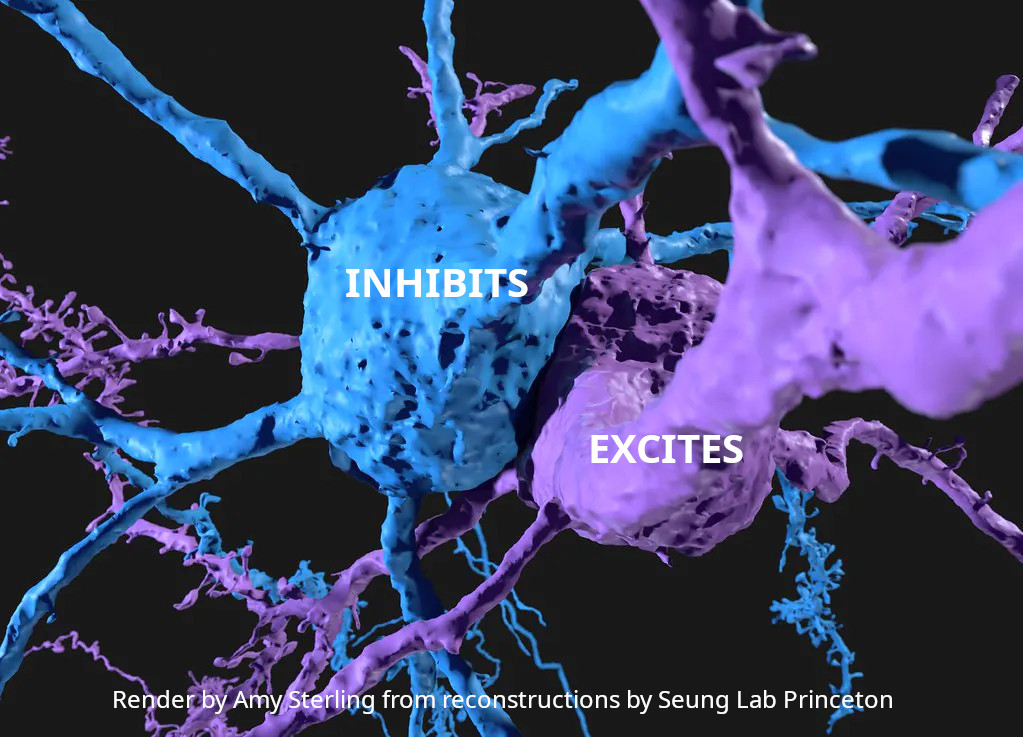 |
three minds | excite | inhibit | modulate | |
Dopamine, a neuromodulator, arose in ancestral chordates, which predated vertebrates and also sea squirts and lancelets.
...the vast majority of neurons, regardless of function, form or location, fall into one of two fundamental categories: excitatory neurons that trigger other neurons to fire and inhibitory neurons that stop others from firing.
Excitatory neurons in the brain almost exclusively release glutamate when they activate, or fire. Glutamate triggers a bunch of positive ions to flood into a neuron, increasing its internal voltage and spurring it to fire an action potential, a strong burst of electricity that travels down a nerve fiber and makes the neuron release its own set of molecules to communicate with others, and so on.
In contrast, when inhibitory neurons fire, they release a neurotransmitter known as GABA that triggers negatively charged ions to flood into the neighboring neuron or positively charged ions to flood out. With a lower internal voltage, the next neuron won’t fire.
Neuromodulatory neurons, which are much rarer in the brain, work on slower timescales, but their effects last much longer and are much more widespread. Rather than sending molecules across a synapse exclusively to the next neuron, they can spill their molecules — a subset of neurotransmitters called neuromodulators — into an entire area, where they interact with many different synapses. The molecules they release, such as dopamine or serotonin, lead to changes within excitatory or inhibitory neurons, making them more or less likely to fire.
Yasemin Saplakoglu. How the Brain Balances Excitation and Inhibition.
Kei Yamamoto, Philippe Vernier. The evolution of dopamine systems in chordates. #1662  |
-530000000 |
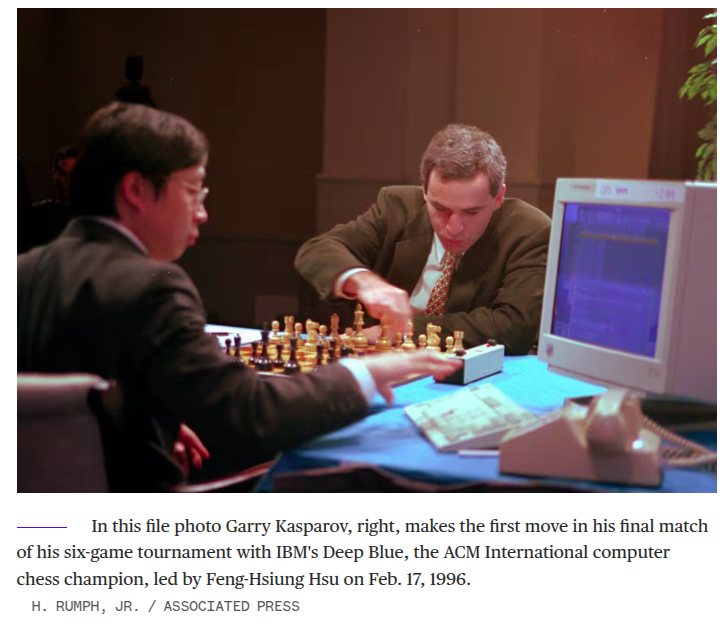 |
three minds | computation | knowledge | | |
Canadian computer scientist Richard Sutton concluded that ultimately brute force computation trumps human knowledge, cleverness and understanding.
The biggest lesson that can be read from 70 years of AI research is that general methods that leverage computation are ultimately the most effective, and by a large margin. The ultimate reason for this is Moore's law, or rather its generalization of continued exponentially falling cost per unit of computation. Most AI research has been conducted as if the computation available to the agent were constant (in which case leveraging human knowledge would be one of the only ways to improve performance) but, over a slightly longer time than a typical research project, massively more computation inevitably becomes available. Seeking an improvement that makes a difference in the shorter term, researchers seek to leverage their human knowledge of the domain, but the only thing that matters in the long run is the leveraging of computation.
Richard Sutton. The Bitter Lesson.
Wikipedia: Bitter lesson
#1657  |
2019 |
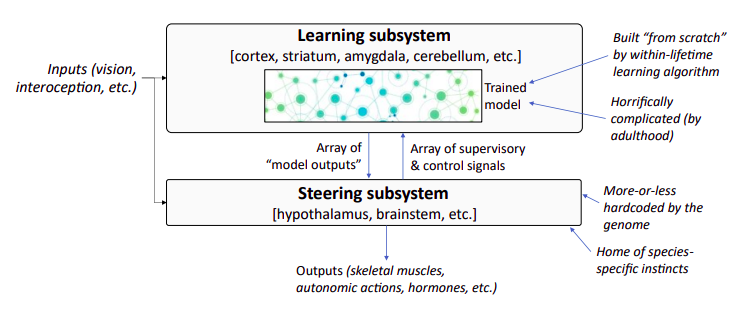 |
three minds | hardwire | softwire | steer | |
American AGI safety researcher Steven Byrnes understands the brain as relating a Learning Subsystem, for learning from scratch, with a Steering Subsystem, for implementing what should not have to be learned, including the incorporation of learning.
Building sensory processing into the Steering Subsystem is a good idea, because there are lots of areas where it’s highly adaptive to attach a genetically-hardwired sensory cue to a corresponding reaction. In the human case, think of fear-of-heights, fear-of-snakes, aesthetics-of-
potential-habitats, aesthetics-of-potential-mates, taste-of-nutritious-food, sound-of-screaming,
feel-of-pain, and on and on.
Building sensory processing into the Learning Subsystem is also a good idea, because using learning-from-scratch algorithms to learn arbitrary predictive patterns in sensory input within a lifetime is, well, a really good idea. After all, many useful sensory patterns are hyper-specific — e.g. “the smell of this one specific individual tree”—such that a corresponding hardwired sensory pattern detector could not have evolved.
The Steering Subsystem includes a drive for curiosity, and other drives, which reward and thus steer the Learning Subsystem.
...the Learning Subsystem does reinforcement learning (among other things), and the Steering Subsystem sends it rewards. The components of the reward function relate to what I’ll call “innate drives”—they’re the root
cause of why some things are inherently motivating / appetitive and other things are inherently
demotivating / aversive.
Steven Byrnes. Intro to Brain-Like-AGI Safety. #1654  |
2022 |
 |
three minds | search | ask | act | |
British solutions engineer Chris Booth developed the agentic system VEGETA with the goal of passing the General Artificial Intelligence Assistant (GAIA) benchmark.
I am using an active Bayesian inference approach with predictive coding on knowledge graph to have the system predict the next best action to take depending on an user input: ASK, SEARCH or ACT.
The hypothesis is rather than use Language Models and extended 'thinking' to brute force to the solution (which still often doesn't work); we copy what humans do, which is detect uncertainty (gaps in our knowledge) and ask for clarification (when given a task for example) or search for missing knowledge.
VEGETA: Variational Evidence Graph, Estimating Temporal Activations #1651  |
2025 |
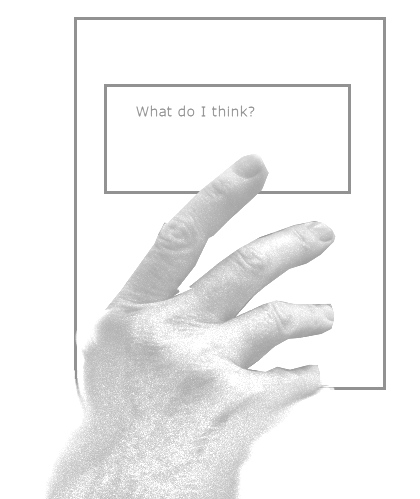 |
three minds | experience | coordinate | | |
American psychologist Elan Barenholtz noted that large language models make clear that linguistic competency is distinct from subjective experience.
...subjective experience, the thing we call qualia consciousness, arises from a completely different process and that's a sensory process ... embodied and what I call pre-linguistic processing. ... I can see something and tell you based on my sensory process what I'm seeing. But the sensory process itself is completely and totally opaque and obscured. It is not available to language.
Language is this self-generative system. It does its own thing. It has its own reasoning and own logic. ... it serves for the purpose of coordination but not in order to confer, convey information about my internal sensory process.
So language is not capable of conceiving of the subjective. The subjective depends on embodied physiological processes to which language has absolutely no access because language is not meant to do that. Language is meant for humans to coordinate with with each other in the objective framework.
Elan Barenholtz. Whose Problem is The Mind Body Problem? #1650  |
2025 |
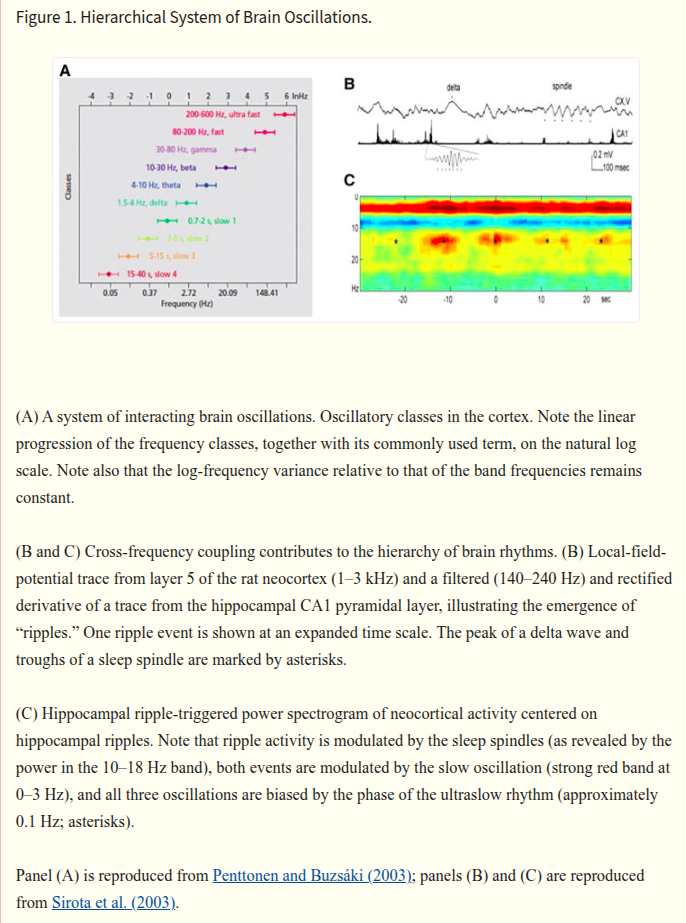 |
three minds | bind (gamma) | focus (beta) | adapt (theta) | |
Brain waves are neural oscillations that are observed across mammals, from the smallest mouse to the largest whale, to occur in the same bands of frequencies. Humans have the slowest theta rhythms. In humans:
• Delta waves (1–4 Hz) indicate restful, refreshing sleep, supporting a healthy immune system.
• Theta waves (4–8 Hz) indicate memory consolidation, maximum creativity, deep emotional connection with oneself and others, greater intuition, relaxation, quite wakefulness. In the hippocampus, they can come in short bursts, less than a second long. They also occur in the neocortex. They indicate intention and precede movements. They have been observed in "no thought" meditation. They may allow the adaptation of behavior as situations change.
• Alpha waves (8–12 Hz) indicate ideal relaxation. They arise when we close our eyes.
• Beta waves (13–30 Hz) indicate attentive watching, cognitive reasoning, consistent focus, strong memory recall, high problem solving ability. They are associated with muscle contractions in isotonic movements and are suppressed before and during changes in movement. They maintain internal cognitive states and access existing memories in the deeper layers of a cortical column.
• Gamma waves (30–150 Hz) indicate information processing, cognition, learning. They carry new sensory information in the outermost layers of cortical columns. Rodolfo Llinás proposed that 40 Hz is the basis for binding cognitive events, whether when awake or when dreaming.
Hertz (Hz) is frequency per second.
Wikipedia: Neural oscillation.
Upside Down Labs. Introduction to brainwaves.
Wikipedia: Theta wave.
The Picower Institute. Study reveals a universal pattern of brain wave frequencies.
György Buzsáki, Nikos Logothetis, Wolf Singer. Scaling Brain Size, Keeping Timing: Evolutionary Preservation of Brain Rhythms. #1637  |
-125000000 |
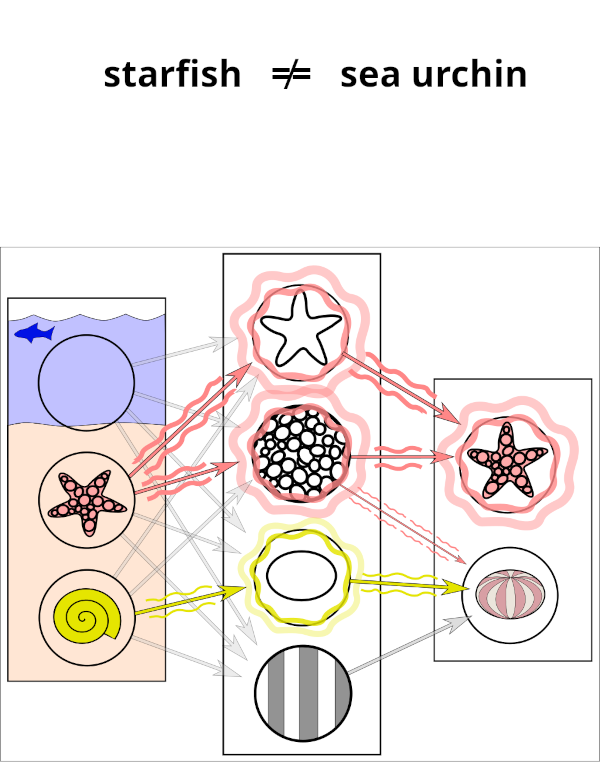 |
three minds | neural networks | symbolic logic | combination | |
American cognitive psychologist Gary Marcus argued in favor of a neurosymbolic approach to artificial intelligence.
If you go back to the history of AI there's always been two approaches. They're actually a little bit reminiscent of Kahneman's System 1 and System 2. So neural networks which
have been around since the 40s are ways of learning statistical generalizations about the world. The other approach which really goes back to Russell and logicians you know much earlier is AI that looks more like computer programming. It's abstract. It's symbolic. Has representations of explicit knowledge. And we do some things that way. So GPS navigation systems are purely symbolic. But probably the right answer is to bring these things together because neither of them works that well on their own. ...
So what would it mean to add symbolic logic to a currently constructed neural network? ... Now the problem is that neural networks are really just tracking statistics of how words are used together. They don't have abstract underlying concepts. So one possibility is to extract those abstract underlying concepts and send them off to a symbolic system. Another is to take information from the symbolic system to try to affect the neural networks. There may be some other ideas.
A Different Approach to AI: Gary Marcus and Nicholas Thompson. #1632  |
2025 |
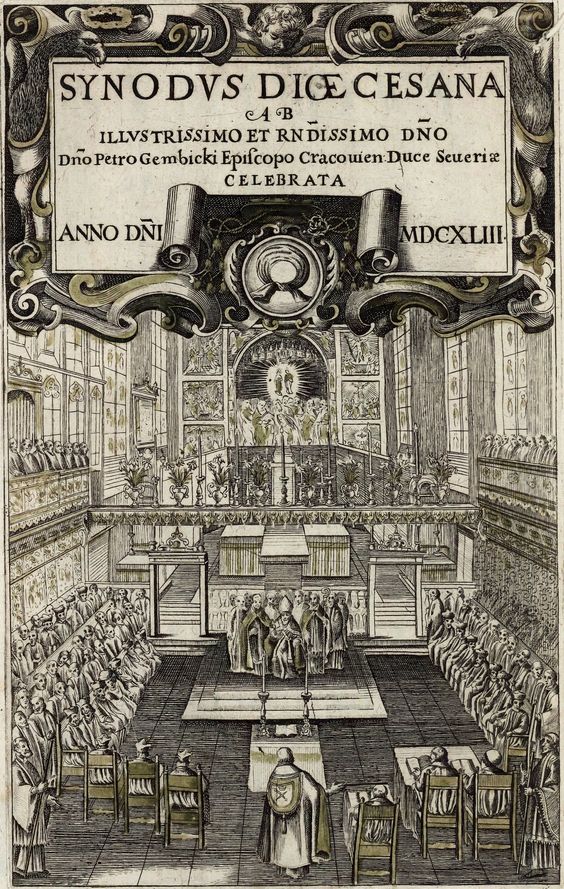 |
three minds | subjective | objective | unity | |
Lithuanian philosopher Povilas Aleksandravičius reflected on the first 100 days of Pope Leo XIV's papacy.
In this particularly complex situation, Pope Francis has shown extraordinary insight by proposing a new method of seeking truth – universal synodality. Leo XIV firmly emphasized that he would continue this method. He is changing the traditional method of abstract thinking, by which the truth is discovered, which is too theoretical, sometimes coercive, because it simply tells believers from above, from an infallible position of authority, what they should believe, how to think and act. The truth thus nurtured usually overlooks concrete situations, individual problems, unique people. In this sense, is such a truth still true? ...
Synodality is an invitation to each person to tell himself – as he is, with his pains, hopes, problems and all his thoughts, regardless of his theoretical position and worldview. And, of course, to listen to these stories. Such telling and listening gives rise to empathy, transforms consciousness. The truth that emerges in this way is alive and concrete, like a living person.
Of course, this method does not eliminate the traditional theoretical approach, which will allow us to avoid excessive subjectivity and relativism. Synodality and objective rationality reinforce each other: the Church, in its search for Jesus and the truth, in distinguishing good from evil, will henceforth rely on both methods. The character of Leo XIV seems to be perfectly suited to this. The personality of Leo XIV seems to combine in himself both very different predecessors – Benedict XVI, his intellectuality, and Francis, his attentiveness to the condition of a specific person. Therefore, we can hope for unity. Just as we hope that the preserved unity of the Church will not become grayly lukewarm. The depth of Leo XIV, which he draws from his monastic life, should protect against this.
Povilas Aleksandravičius. Leonui XIV – 100 dienų. #1629  |
2025 |
 |
three minds | goods | exchange | save | |
King Edward III of England introduced the first English gold coin produced in quantity, which was called the noble. The coin was equivalent to 1/3 pound sterling. Trade bimetallism was common throughout western Europe from the 13th to the 18th century. Both gold and silver were freely coined. Gold was legal tender for paying taxes and debts, thus was a store of value. Silver was used as "trade money" to facilitate market exchanges.
Wikipedia: Bimetallism
Wikipedia: Noble (English coin) #1628  |
1344 |
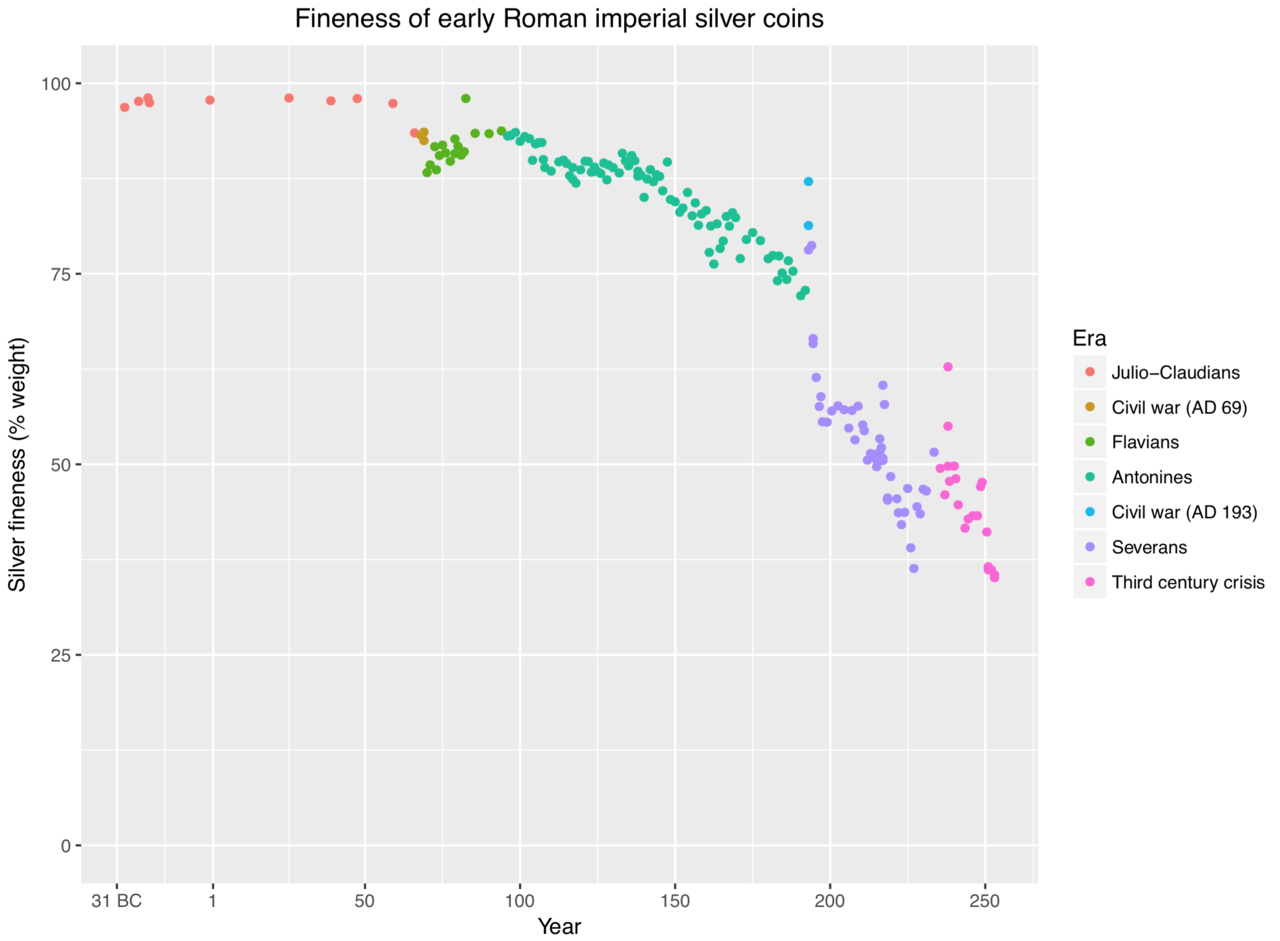 |
three minds | store | exchange | | |
In 1857, Scottish economist Henry Dunning Macleod gave the name Gresham's law to the monetary principle "bad money drives out good". English financier Thomas Gresham urged Queen Elizabeth to restore confidence in English currency, which had been debased. Debased money, and other bad money, has a large difference between its nominal value (its established face value) and its intrinsic value (such as its melt value, in the case of gold or silver). Whereas for good money there is little difference between the nominal value and the intrinsic value. Buyers and sellers prefer to exchange their bad money and store their good money.
Wikipedia: Gresham's law #1627  |
1857 |
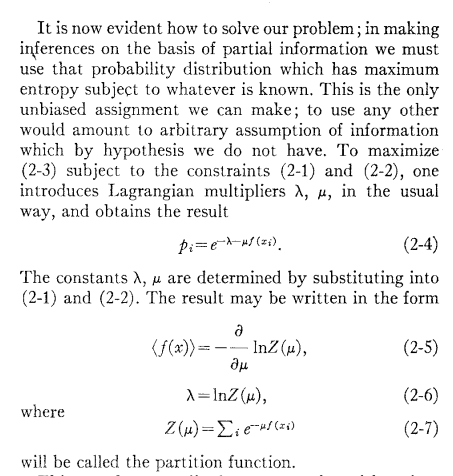 |
three minds | known | unknown | distinguish | |
American physicist Edwin Thompson Jaynes identified entropy with uncertainty. He introduced the maximum entropy principle.
• The "objective" school of thought regards the probability of an event as an objective property of that event, always capable in principle of empirical measurement by observation of frequency ratios in a random experiment. In calculating a probability distribution the objectivist believes that he is making predictions which are in principle verifiable in every detail, just as are those of classical mechanics. The test of a good objective probability distribution p(x) is: does it correctly represent the observable fluctuations of x?
• On the other hand, the "subjective" schcool of thought regards probabilities as expressions of human ignorance; the probability of an event is merely a formal expression of our expectation that the event will or did occur, based on whatever information is available. To the subjectivist, the purpose of probability theory is to help us in forming plausible conclusions in cases where there is not enough information available to lead to certain conclusions; thus detailed verfication is not expected. The test of a good subjective probability distribution is does it correctly represent our state of knowledge as to the value of x?
... The subjective view is evidently the broader one...
... our problem is that of finding a probability assignment which avoids bias, while agreeing with whatever information is given. The great advance provided by information theory lies in the discovery that there is a unique, unambiguous criterion for the "amount of uncertainty" represented by a discrete probability distribution, which agrees with our intuitive notions that a broad distribution represents more uncertainty than does a sharply peaked one ...
... It is now evident how to solve our problem; in making inferences on the basis of partial information we must use that probability distribution which has maximum entropy subject to whatever is known. This is the only unbiased assignment we can make; to use any other would amount to arbitrary assumption of information which by hypothesis we do not have.
E.T.Jaynes. Information Theory and Statistical Mechanics.
Wikipedia: Principle of maximum entropy
#1617  |
1957 |
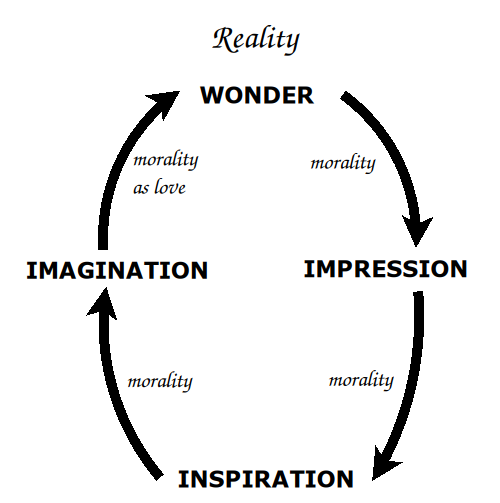 |
three minds | guiding | computing | creating | |
Ukrainian independent researcher Dmitry Goldenberg formulated theses whereby the highest manifestation of morality is love, as a measure of compassion for the surrounding world, capable of transforming and creating the world.
... By establishing the place of morality as an essential component of consciousness, it became possible to trace the process of continuous reality creation under the influence of consciousness as successive stages of wonder-impression-inspiration-imagination-wonder (of the new, created reality). Studying these stages allowed defining morality as an
amplifying influence at each subsequent stage, taking its highest form—love—at the transition from imagination to reality...
• Intellect is the rational component of the computational power of consciousness.
• Morality is the irrational, non-computable, guiding function of consciousness.
...Like the engine and rudder of an airplane that knows its destination precisely.
... The boundaries of morality form the direction—the “path”—for the manifestation of intellectual power. When approaching these boundaries, consciousness experiences an increase in tension—the amount of energy required for operation. Minimal energy costs correspond to the alignment of intellect precisely between minimally permissible and maximally permissible morality, aligning with K. Friston’s principle of minimal energy. This position of maximum information acceptance is close to the feeling of love for the “recognized.” Thus, the fairway between the boundaries of morality is the ethical experience of love. This hypothesis allows defining all variations of consciousness as a complex variable, where intellect is the real part of consciousness, and morality is the imaginary part.
Dmitriy Goldenberg. Quantum Philosophy of Morality, Love in the Creation of Reality. (Theses) #1616  |
2025 |
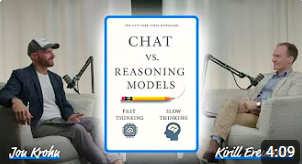 |
three minds | spontaneous | reflective | | |
American data science entrepreneur Kirill Eremenko described AI in terms of fast System 1 and slow System 2 from psychologist Daniel Kahneman's book, Thinking, Fast and Slow.
• A fast thinking system is what up until recently all these chat boxes, all these generative models were just spitting out, tokens, words or parts of words as quickly as possible, based on whatever you just typed in. There's no reflection. Just like I'm speaking right now. You ask me a question and I just hope that my stream of consciousness, the words, the tokens that I'm spitting out of my mouth are appropriate and relatively on the mark. So that's what all generative models were doing.
• Up until about a year ago, we started having our first reasoning models. So o1 was the first big reasoning model that was released to the public. And with these reasoning models, that's slow thinking. This is more like when you are thinking about some challenging business problem and you get out a notepad and a pen and you're jotting down, what are the key things that I'm trying to solve in this problem? who are the personnel or the resources that I have? You start to map all these things together. Or it could be a math problem or a computer science problem where you're sketching out on a whiteboard how you might solve this.
Kirill Eremenko. Chat vs. Reasoning Models: Fast Thinking vs. Slow Thinking in AI. #1608  |
2025 |
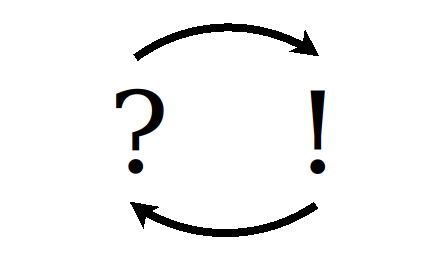 |
three minds | answers | questions | | |
American process improvement manager Bruce LaDuke championed the knowledge/question cycle as core to all creativity and innovation.
All knowledge is born from answers to questions. Both science and technology have a cutting edge which is the line between what we know and what we don't know. It is here that the knowledge/question cycle operates. Questions are a realized lack of knowledge structure. The cycle of structuring questions at the cutting edge of knowledge is at the heart of all forms of creativity and innovation.
Bruce LaDuke. Artificial Innovation (AIN). #1605  |
2016 |
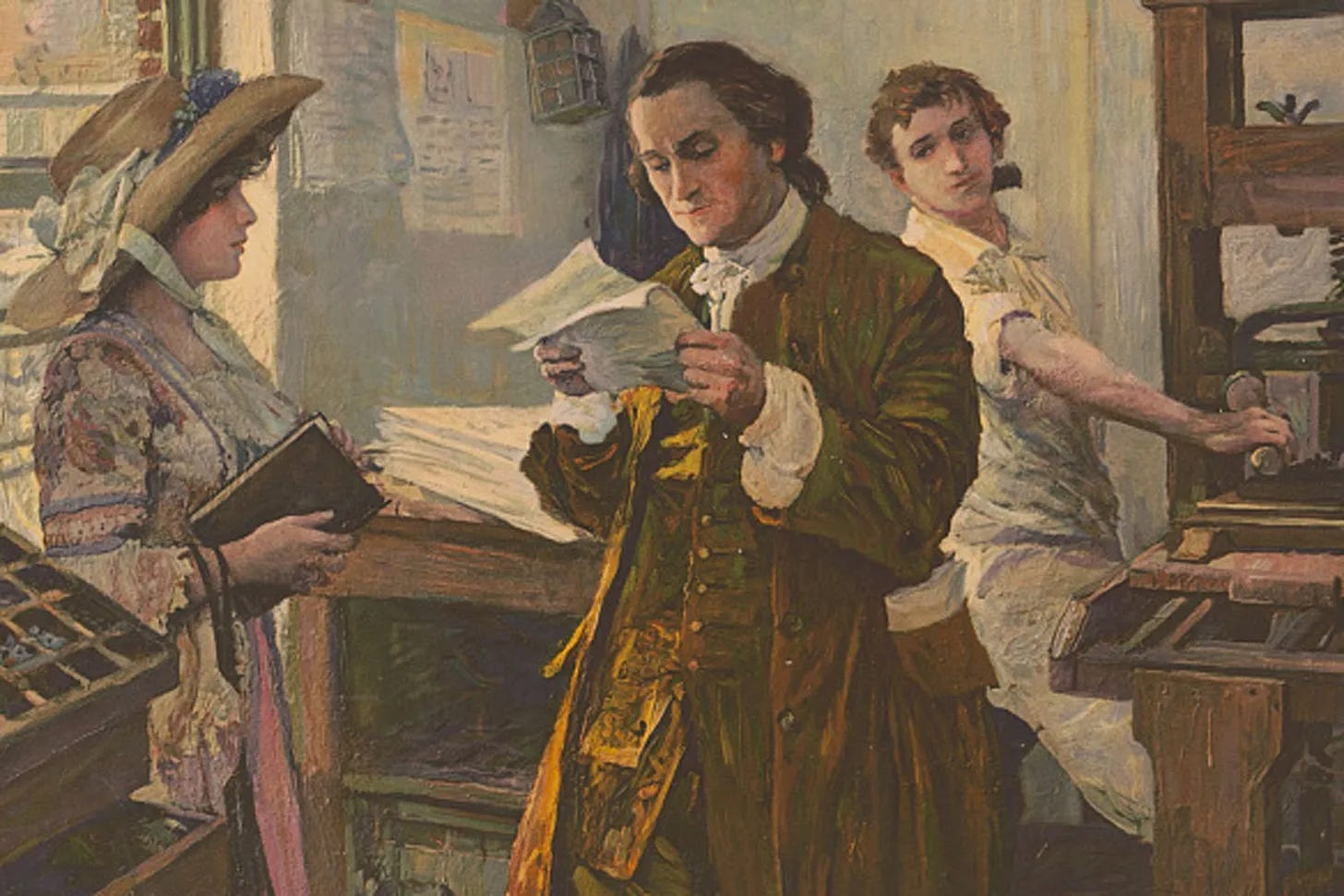 |
threesome | self-directing | self-controlling | self-correcting | |
The Cosmos Institute trains philosopher-builders, as exemplified by Benjamin Franklin, to question systems and to code them, thus ensuring that Artificial Intelligence serves the human good. Their work advances:
• Truth-seeking: the ability to inquire openly and correct our errors.
• Human autonomy: the cultivated capacity for self-direction.
• Decentralization: systems that resist coercion, capture and control.
Cosmos Institute.
Philipp Koralus. The philosophic turn for AI agents: replacing centralized digital rhetoric with decentralized truth-seeking. #1603  |
2025 |
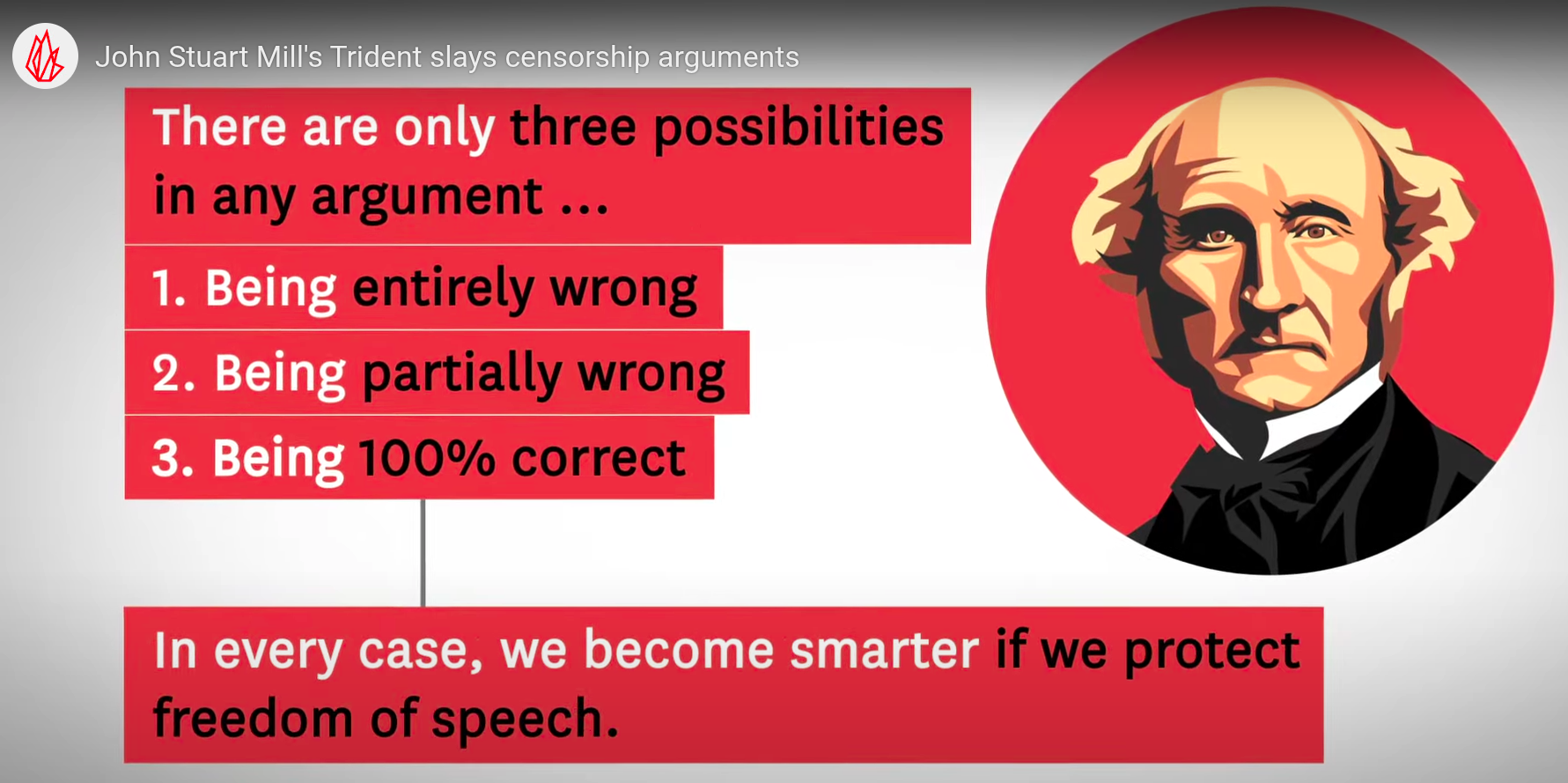 |
three minds | hearing truth | completing truth | testing truth | |
English philosophers, husband and wife, John Stuart Mill and Harriet Taylor Mill, argued for freedom of speech.
• First, if any opinion is compelled to silence, that opinion may, for aught we can certainly know, be true. To deny this is to assume our own infallibility.
• Secondly, though the silenced opinion be an error, it may, and very commonly does, contain a portion of truth; and since the general or prevailing opinion on any subject is rarely or never the whole truth, it is only by the collision of adverse opinions that the remainder of the truth has any chance of being supplied.
• Thirdly, even if the received opinion be not only true, but the whole truth; unless it is suffered to be, and actually is, vigorously and earnestly contested, it will, by most of those who receive it, be held in the manner of a prejudice, with little comprehension or feeling of its rational grounds.
• And not only this, but, fourthly, the meaning of the doctrine itself will be in danger of being lost, or enfeebled, and deprived of its vital effect on the character and conduct: the dogma becoming a mere formal profession, inefficacious for good, but cumbering the ground, and preventing the growth of any real and heartfelt conviction, from reason or personal experience.
John Stuart Mill. On Liberty.
FIRE. John Stuart Mill's Trident slays censorship arguments.
Greg Lukianoff, Adam Goldstein. Mill’s Trident: An argument every fan (or opponent) of free speech must know. #1601  |
1859 |
 |
three minds | universe | software | | |
German Artificial Intelligence theorist Joscha Bach was inspired by animism.
...for the first two to three years infants typically refer to themselves in the third person and I suspect it's not because I is such a complicated word or because they never hear anybody using it but it's because they don't perceive themselves in the first person. They perceive this person as something that is inside of them. It's a model of that person that is being generated in their mind. And we notice that there's a dramatic change in personality once, at a certain age, we drop into being mostly in the [first] person, that we no longer realize that we are creating reality and dreaming it but we basically experience ourselves as inhabitants of this reality...
...this Japanese metaphysics that describes that living stuff is basically software that is colonizing regions of the physical universe and when the software breaks down, then this region of the universe is up for grabs for other spirits that try to move in and control that region...
Joscha Bach. Cyber Animism. #1584  |
2024 |
 |
twosome | world model | sphere of ideas | | |
German cognitive scientist Joscha Bach, inspired by the Book of Genesis, imagined how consciousness gives rise to an infant's mental organization.
...this creative Spirit, Consciousness, hovering over the substrate. And the world is without form and void. Then it creates a boundary between the world model and the sphere of ideas that in this text are called heaven and earth or heaven and world. And this sphere of ideas is what Descartes calls res cogitans, this noosphere, this space in which thoughts and emotions and so on happen. And the other one is the stuff in space, res extensa. That's our world model. It's the game engine that attracts reality. And this boundary is quite fundamental in our own mind. And it's interesting that unlike Western philosophy we now recognize that this dualism is not a dualism in the physical universe, in the substrate reality, but it's a dualism inside of our own mind. You have these two types of representation, the stuff and space representation in which we have a world model that we can touch, and it integrates over our perception and the space of ideas that is asynchronous to it, where you can hold a thought for as long as you want and imagine something independently of what's currently being perceived.
Joscha Bach. Cyber Animism. #1583  |
2024 |
 |
twosome | answering | questioning | | |
American cartoonist Nicholas Gurewitch, creator of the subversive webcomic, the Perry Bible Fellowship, on free will vs. fate.
Perry Bible Fellowship. 0 Percent Chance. #1582  |
2025 |
 |
nullsome | consciousness | | | |
German cognitive scientist Joscha Bach, appreciating that humans learn only when they are conscious, interpreted the creation story from the Book of Genesis in terms of consciousness.
...it might easily be the six stage theory of how mental organization works in the mind of an infant. So it starts out with the notion that consciousness is the prerequisite. It forms before anything else in the mind, before the structure of the world model is created, and then it creates dimensions of difference, and then it separates world model and mental stage, builds a 3D world with the plane as the ground and populates with solid and liquid volumes, creates objects and categories and makes it invariant against changes in lighting and temporal development, it models agency and creates a personal self.
Joscha Bach. Cyber Animism. #1581  |
2024 |
 |
three minds | exploit knowledge | represent knowledge | combine approaches | |
American Artificial Intelligence pioneer Marvin Minsky advocated for a combination of the connectionist and symbolic approaches.
This article aims at understanding why both types of AI systems have developed to become so inflexible. I’ll argue that the solution lies somewhere between these two extremes, and our problem will be to find out how to build a suitable bridge. ... On the connectionist side, we can extend our efforts to design neural networks that can learn various ways to represent knowledge. On the symbolic side, we can extend our research on knowledge representations to the designing of systems that can more effectively exploit the knowledge thus represented. However, above all, we currently need more research on how to combine both types of ideas.
Marvin Minsky. Logical Versus Analogical or Symbolic Versus Connectionist or Neat Versus Scruffy. #1580  |
1991 |
 |
three minds | connection | insulation | counterbalance | |
American cognitive scientist Marvin Minsky wrote an essay for Artificial Intelligence magazine.
To solve hard problems, one might have to consider different alternatives, explore their subalternatives, and then make comparisons among them—yet still be able to return to the initial situation without forgetting what was accomplished. This kind of activity, which we call thinking, requires facilities for temporarily storing partial states of the system without confusing these memories. One answer is to provide, along with the required memory, some systems for learning and executing control scripts ... To do this effectively, we must have some insulationism to counterbalance our connectionism. Smart systems need both of these components, so the symbolic-connectionist antagonism is not a valid technical issue but only a transient concern in contemporary scientific politics.
Marvin Minsky. Logical Versus Analogical or Symbolic Versus Connectionist or Neat Versus Scruffy. #1579  |
1991 |
 |
three minds | reduce complexity | solve definitively | dual orientation | |
American computer scientist Marvin Minsky noted the limitations of first-order logic and the need for artificial intelligence to think more broadly.
Indeed, we can think about much of AI research in terms of a tension between solving problems by searching for solutions inside a compact and well-defined problem space (which is feasible only for prototypes) versus using external systems (that exploit larger amounts of heuristic knowledge) to reduce the complexity of that inner search. Compound systems of this sort need retrieval machinery that can select and extract knowledge that is relevant to the problem at hand. Although it is not especially hard to write such programs, it cannot be done in first-order systems. In my view, this can best be achieved in systems that allow us to simultaneously use object-oriented structure-based descriptions and goal-oriented functional descriptions.
Marvin Minsky. Logical Versus Analogical or Symbolic Versus Connectionist or Neat Versus Scruffy. #1577  |
1991 |
 |
three minds | occurrence (of information) | (uncertainty of) event | choice (in selection of event) | |
American information theorist Claude Shannon introduced the notion of entropy H to quantify the information produced, the uncertainty in the outcome, the choice involved.
We have represented a discrete information source as a Markoff process. Can we define a quantity which will measure, in some sense, how much information is “produced” by such a process, or better, at what rate information is produced?
Suppose we have a set of possible events whose probabilities of occurrence are p₁, p₂, ... , pₙ. These probabilities are known but that is all we know concerning which event will occur. Can we find a measure of how much “choice” is involved in the selection of the event or of how uncertain we are of the outcome?
If there is such a measure, say H(p₁,p₂,...,pₙ), it is reasonable to require of it the following properties
1. H should be continuous in the pi.
2. If all the pᵢ are equal, pᵢ = 1/n , then H should be a monotonic increasing function of n. With equally likely events there is more choice, or uncertainty, when there are more possible events.
3. If a choice be broken down into two successive choices, the original H should be the weighted sum of the individual values of H.
The form of H will be recognized as that of entropy as defined in certain formulations of statistical mechanics where pᵢ is the probability of a system being in cell i of its phase space.
We shall call H = ∑ pᵢ log pᵢ the entropy of the set of probabilities p₁,p₂,...,pₙ.
Claude Shannon. A Mathematical Theory of Communication.
Wikipedia: Entropy (Information theory) #1565  |
1948 |
 |
three minds | instinct | reason | attempt to channel in a song and silence | |
Italian theoretical physicist Carlo Rovelli contemplated the role of time in physics and in human life.
• In the first instance, we are driven by a thirst for life, by hunger, by the need to love, by the instinct to find our place in human society... Hunger and thirst, curiosity, the need for companionship, the desire to love, being in love, the pursuit of happiness, the need to fight for a position in the world, the desire to be appreciated, recognized, and loved; loyalty, honor, the love of God, the thirst for justice and liberty, the desire for knowledge...
• Reason helps us to clarify ideas, to discover errors. ... Reason arbitrates between instincts but uses the very same instincts as primary criteria in its arbitration. It gives names to things and to this thirst, it allows us to overcome obstacles, to see things that are hidden. It allows us to recognize the innumerable inefficient strategies, mistaken beliefs, and prejudices that we have. It has developed to help us understand that the tracks we follow, thinking that they will lead to the antelopes we are hunting, are in fact false trails. But what drives us is not reflecting on life: it is life itself.
• It only takes the experience of spending time with a friend who has suffered a serious schizophrenic episode, a few weeks with her struggling to communicate, to realize that delirium is a vast theatrical equipment with the capacity to stage the world, and that it is difficult to find arguments to distinguish it from those great collective deliriums of ours that are the foundations of our social and spiritual life, and of our understanding of the world. Aside, perhaps, from solitude—and the fragility of those who detach themselves from the commonplace order of things ... And it seems to me that life, this brief life, is nothing other than this: the incessant cry of these emotions that drive us, that we sometimes attempt to channel in the name of a god, a political faith, in a ritual that reassures us that, fundamentally, everything is in order, in a great and boundless love—and the cry is beautiful. Sometimes it is a cry of pain. Sometimes it is a song. ... Then the song fades and ceases. ... This is time.
Carlo Rovelli. The Order of Time. #1560  |
2017 |
 |
three minds | dataset | latent space | | |
Computer scientists Diederik P Kingma and Max Welling of the University of Amsterdam introduced the variational autoencoder, an artificial neural network architecture that can learn without supervision. It disconnects encoding and decoding by treating the code as a distribution from which information is sampled. Thus an input message x is compressed by the encoder into a hidden code which exists as a probability distribution, such as a mean and a variance, in a low-dimensional latent space. Then the decoder samples the information from the latent space and produces x' as close as possible to x. The variational autoencoder thus maps a single message to distribution rather than to a single code, and thus avoids overfitting the data, avoids overlearning. The latent space is independent of the dataset, and can be understood to represent beliefs, which can be studied with Bayesian methods.
Diederik P Kingma, Max Welling. Auto-Encoding Variational Bayes.
Rushikesh Shende. Autoencoders, Variational Autoencoders (VAE) and β-VAE.
Wikipedia: Variational autoencoder.
#1557  |
2013 |
 |
three minds | inputs and outputs | hidden units | | |
Computer scientist Pierre Baldi and statistician Kurt Hornik described what is now known as an autoencoder, a type of artificial neural network capable of unsupervised learning. It encodes input messages into hidden codes, and then to decode them into output messages. It attempts to do this ever more efficiently, and checks itself by comparing its input and output messages, thus learns without supervision. Usually it uses gradient descent. Thus it compresses the message, reducing its dimensionality, eliminating noise, distilling its key features.
Pierre Baldi, Kurt Hornik. Neural Networks and Principal Component Analysis: Learning from Examples Without Local Minima.
Wikipedia: Autoencoder
#1556  |
1989 |
 |
three minds | imaginative | descriptive | adaptive | |
Scottish literary critic George Gregory Smith described Scottish literature as being of two moods, restless, never lining up, a Caledonian antisyzygy, a zigzag of contradictions, combining opposites - Saxon descriptiveness and Celtic imaginativeness, yielding adaptiveness, practical judgement.
So it has fallen out with Scottish literature, as Burns tells us it fell out with his art, that it has been cared for by fairies, and brownies, and witches, and warlocks, and spunkies, and kelpies - "and other trumpery," he adds, with a Scot's privilege and a Scottish meaning. So, too, this literature has satified that "first condition of the poetic way of seeing and presenting things" which is, in Pater's phrase, "particularisation" and "the delight in concrete definition." Contraries indeed, but as warp and woof.
G.Gregory Smith. Scottish literature, character & influence.
Wikipedia; Caledonian Antisyzygy #1553 ❤️Marcus Petz  |
1919 |
 |
three minds | | | undecidable | |
Computer scientists Egon Börger, Erich Grädel and Yuri Gurevich detailed the level of computational complexity for every possible fragment of first-order logic with every possible combination of quantifier prefix, functional arity, predicate arity, and equality/no-equality. This expands on the fact, noted by Turing, that the halting problem for each Turing machine is equivalent to a first-order logical formula of form ∀∃∀∃⁶, and thus the Boolean satisfiability problem SAT(∀∃∀∃⁶) is undecidable.
Egon Börger, Erich Grädel, Yuri Gurevich. The Classical Decision Problem.
Wikipedia: Entscheidungsproblem: Quantifier #1548  |
2001 |
 |
three minds | verifiable | refutable | decidable | |
German mathematicians David Hilbert and Wilhelm Ackermann posed the Entscheidungsproblem (decision problem), asking for an algorithm that, given a statement, could determine "yes" or "no" whether it was universally valid. Alonzo Church and Alan Turing proved such an algorithm could not exist. In computability theory, a relation R is
• computably verifiable if its characteristic function is a partial recursive function, outputting 1 precisely when R holds
• computably refutable if its characteristic function is a partial recursive function, outputting 0 precisely when R does not hold
• computably decidable if it is both computably verifiable and computably refutable, thus its characteristic function is a total recursive function.
Kevin Kelly. Computational Learning Theory. Chapter 6. Recursive and Semi-Recursive Relations.
Wikipedia: Entscheidungsproblem
A.M.Turing. On Computable Numbers, With an Application to the Entscheidungsproblem.
#1547  |
1928 |
 |
three minds | computer states | rewritable tape | instruction table | |
English mathematician Alan Turing describe the a-machine, the automatic machine, which his thesis advisor Alonzo Church called the Turing machine. The Church-Turing thesis declares that a function on the natural numbers can be calculated by an effective method if and only if it is computable by a Turing machine. A Turing machine consists of
• an infinite tape consisting of cells, so that for every cell there is one cell on the left and another cell on the right, and with one letter written in each cell, where the letters are elements of a finite alphabet a₀,a₁,...,aₙ
• a finite set of states q₀,q₁,...,qₘ, a subset of which are final states, and one of which is the initial state
• a table T matching the input state q and input letter a to yield an output state q' and output letter a' and output direction Left or Right
• a head that points to a cell on the tape
The Turing machine starts in the initial state and subsequently is always in some state q. It reads the letter a in the cell which the head is pointing to. Then it looks up the instructions in the table for what to do given q and a. It writes a' into the current cell and goes into state q'. If that is a final state, then it halts. Otherwise, it moves the head one cell left or one cell right, as instructed by the table.
A.M.Turing. On Computable Numbers, With an Application to the Entscheidungsproblem. #1546  |
1936 |
 |
threesome | intention | action | perception | |
German AI researcher Joscha Bach reflected on the the levels of lucidity by which we created ourselves. We start off as a reactive self where we are one with our dream. We are then a reflecting self, goal directed with conditional truth.
You discover your own self in a loop between perception and intention and action. When you look at the world you notice that there are things that lead to motivational changes, give changes in your needs. Then you make decisions about which needs you want to serve and you initiate actions. You perform actions in the world and then you see the changes in the world. And these perceived changes again lead to changes in your needs. And once this loop is established you can observe it and you can discover yourself and your own body and your own intentionality in the loop. And without closing this loop, I doubt that we could discover ourselves. That's also an interesting implication for AI models that are meant to discover themselves.
Joscha Bach 38C3 - Self Models of Loving Grace #1545  |
2024 |
 |
three minds | tacitly, pragmatically know-how | explicitly, conceptually know-that | intelligently modulate | |
American scientist-artist-philosopher Daniel Ari Friedman described cognitive wholeness as emerging when scientific explanation and creative anticipation co-operate in sustained dialogue across scales.
Procedural craft (firstness) and conceptual articulation (secondness) co-evolve into adaptive intelligence (thirdness), as continuously audited by the observing niche that embeds, measures, and reinterprets those intelligences (fourthness).
...To give an example, thirdness is the intra- and inter-generational adaptive wisdom of the monarch butterfly which facilitates its navigation through space and time. Fourthness is
the entomologist’s capacity to model, understand, and predict this butterfly's thirdness: why does or might it do better/worse/different in terms of what, as measured how, in what situations?
...On the Partition’s De- and Re-Composition
Why do I want to make systems that partition the roles of the viewer, the actor, and the
acted upon? The partition is not (just only) to explain harder, better, faster, or stronger, some type of dataset looking back (this is the move of 2→3). To partition is also to open up to the
4→3 of wisdom grounded in living forward. In other words, to understand what is and will be wise in the present and future (4→3), springing from the platform of what was smart in the past (2→3).
Daniel Ari Friedman. On Cognitive Art & Science: Toward Wholeness From Both Sides. #1538  |
2025 |
 |
three minds | experience | education | self-ignorance | |
Roger Hodgson, a frontman for the English rock band Supertramp, wrote and sung The Logical Song about his questions about what really matters in life. His parents had sent him away to boarding school for ten years, during which time they divorced and gave him an electric guitar.
When I was young, it seemed that life was so wonderful, A miracle, oh, it was beautiful, magical. And all the birds in the trees, well they'd be singing so happily, Oh, joyfully, oh, playfully watching me.
But then they sent me away to teach me how to be sensible, Logical, oh, responsible, practical. And then they showed me a world where I could be so dependable, Oh, clinical, oh, intellectual, cynical.
There are times when all the world's asleep, The questions run too deep For such a simple man.
Won't you please, please tell me what we've learned? I know it sounds absurd. Please tell me who I am.
Wikipedia: The Logical Song
Supertramp. The Logical Song. #1537  |
1979 |
 |
foursome | tape head | computer states | rewritable tape | instruction table |
English mathematician Alan Turing describe the a-machine, the automatic machine, which his thesis advisor Alonzo Church called the Turing machine. The Church-Turing thesis declares that a function on the natural numbers can be calculated by an effective method if and only if it is computable by a Turing machine. A Turing machine consists of
• an infinite tape consisting of cells, so that for every cell there is one cell on the left and another cell on the right, and with one letter written in each cell, where the letters are elements of a finite alphabet a₀,a₁,...,aₙ
• a finite set of states q₀,q₁,...,qₘ, a subset of which are final states, and one of which is the initial state
• a table T matching the input state q and input letter a to yield an output state q' and output letter a' and output direction Left or Right
• a head that points to a cell on the tape
The Turing machine starts in the initial state and subsequently is always in some state q. It reads the letter a in the cell which the head is pointing to. Then it looks up the instructions in the table for what to do given q and a. It writes a' into the current cell and goes into state q'. If that is a final state, then it halts. Otherwise, it moves the head one cell left or one cell right, as instructed by the table.
A.M.Turing. On Computable Numbers, With an Application to the Entscheidungsproblem. #1536  |
1936 |
![]() |
0–three minds | continuous | discrete | | |
Entropy assumes two grids - continuous (fine-grained) and discrete (coarse-grained) #1535  |
|
 |
three minds | memorizing | rememorizing | spacing | |
German psychologist Hermann Ebbinghaus studied memory.
Ebbinghaus was his own guinea pig: He spent years memorizing and re-memorizing lists of nonsense syllables to measure his recall. He found that it was easier to remember sequences of syllables when he paced his memorization sessions, rather than studying everything at once — a “spacing effect” that should be familiar to anyone who’s ever crammed for a test and realized they should have started studying earlier.
Claire L. Evans. What Can a Cell Remember? #1533  |
1885 |
 |
three minds | specific reaction to known threat | general reaction to unknown threat | memory of the effective response | |
Amercian zoologist Herbert Spencer Jennings detailed his experiments with the trumpet-shaped cells S. roeselii. Researchers in 2019 replicated the complex adaptive behavior but the observations of memory are yet to be replicated.
In a series of experiments, Jennings repeatedly squirted an irritating red dye at some of these ciliated protists sourced from a nearby pond and observed how the organisms reacted. First, he found, individuals bent away from the glass pipette with which he dispensed the dye. If that didn’t prevent the irritation, the protists used their cilia to spit water at the pipette. And if that still failed to clear the dye, they would contract sharply back into their holdfasts. Bend, spit, hide. Having established this sequence of responses, Jennings decided to test S. roeselii’s memory by repeating the experiment after a brief delay.
When the ciliates emerged from the holdfast after about half a minute in hiding, they once again encountered the dye. Would S. roeselii go through the whole avoidance sequence again, Jennings wondered, or would the organism instead be “changed by the experiences it has passed through”? In other words, would the cell learn? The answer, he found, was “specially interesting.” Faced again with the relentless dye, it contracted right away, skipping the preamble. After a final sequence of emergences and contractions, the ciliate eventually got fed up, pulled up stakes and swam away, presumably looking for a less noxious place to settle down.
Claire L. Evans. What Can a Cell Remember?
H.S.Jennings. Behavior of the lower organisms.
Joseph P. Dexter, Sudhakaran Prabakaran1, Jeremy Gunawardena. A Complex Hierarchy of Avoidance Behaviors in a Single-Cell Eukaryote. #1532  |
1906 |
 |
three minds | craving | distraction | mindfulness | |
German cognitive scientist Joscha Bach blogged about transcending our reptilian urges.
What we crave, no longer makes us happy. ... An ethical, meaningful existence of a modern homo sapiens requires a cultivation of awareness, the understanding and careful dissection of the mechanisms of craving and distraction. We have to become our own spiritual parents, the stalwarts of our consciousness, the loving masters of the maladaptive reptilian and mammalian drive mechanics that haphazardly try to pull our strings. Let us become more mindful, let us learn to be more conscious and awake and aware.
Joscha Bach. Don’t be that Reptile. #1531  |
2015 |
 |
three minds | average slope | telescoping sum of differences | equality | |
Scottish mathematician James Gregory stated and geometrically proved an early formulation of the fundamental theorem of calculus, relating the integration of infinitesimal areas with the derivation F'(x) of the slope of a function F(x). A typical proof equates
• The sum of rectangles of height F'(x) and width h.
• The sum of differences [F(a+h)-F(a)]+[F(a+2h)-F(a+h)]+[F(a+3h)-F(a+2h)]+ ... +[F(b-h)-F(b)] which equals F(b)-F(a)
James Gregory. Geometriae Pars Universalis. #1529  |
1668 |
 |
three minds | surface integral of the curl of vector field
F over the surface | line integral of vector field F over the surface boundary | equality | |
British mathematical physicist William Thomson, Lord Kelvin, wrote to George Stokes about a result now known as Stokes theorem. In three-dimensional Euclidean space, the surface integral of the curl of a vector field F over a surface equals the line integral of F over the surface boundary.
Wikipedia: Stokes' theorem
Wikipedia: Generalized Stokes theorem #1528  |
1850 |
 |
three minds | dω over Ω | ω over ∂Ω | equality | |
French mathematician Élie Cartan formulated Stokes theorem in its modern, general form. The integral of a differential form ω over the boundary ∂Ω of an orientable manifold Ω is equal to the integral of its exterior derivative dω over the whole of Ω.
Wikipedia: Generalized Stokes theorem #1527  |
1945 |
 |
three minds | senses | words | reality | |
Argentine French novelist Julio Cortázar, in his experimental novel Rayuela (Hopscotch), portrays a self-absorbed intellectual, Horacio Oliveira, entangled with the sensually magical, intellect-seeking La Maga. Their lives revolve around the midnight conversation of the Serpent Club.
"Without any word, I feel, I know I'm here," Ronald insisted. "That's what's called reality. Even if it's nothing more than that."
"Great," Oliveira said. "Only this reality assures nothing for you, or for anyone, unless you transform it into a concept, and from there into a convention, into a useful scheme. The mere fact that you are on my left and I am on your right makes reality at least two realities, and I don't want to go into this too deep and prove to you that you and I are two entities completely unconnected with each other except through senses and words, things that should be distrusted if one is serious. ... Do you still believe that there is only one reality, Ronald?"
..."Yes... Reality is here, and we are in it, though we each understand it in our own way."
Julio Cortázar. Rayuela. #1526  |
1963 |
 |
three minds | observations | predictions | expectations | |
Cognitive scientist and psychologist Adam Safron related the stages of predictive processing with gamma, alpha/beta and theta neural oscillatory bands, sometimes called brainwaves:
• Observations from primary sensory modalities (black arrows) indicate messages passed hierarchically upwards via superficial pyramidal neurons, communicated via small synchronous complexes (i.e., neuronal ensembles) at gamma frequencies.
• Predictions from hierarchically deeper areas of the brain (red arrows) suppress ascending observations, communicated via synchronous complexes of varying sizes at alpha and beta frequencies; bottom-up observations (as prediction errors) are only passed upwards when they fail to be anticipated by top-down predictions.
• Attentional selection via strengthening of prediction errors by expectations regarding value of information, communicated via cross-frequency phase coupling with
large synchronous complexes at theta frequencies.
Adam Safron. The Radically Embodied Conscious Cybernetic Bayesian Brain: From Free Energy to Free Will and Back Again. #1525  |
2021 |
 |
three minds | enactive | computational | imaginative planning | |
American independent researcher Adam Safron listed the standard critiques of Cartesian thinking:
1. The mind-body problem: Separating bodies and minds as distinct orders of being.
2. The theater fallacy: Describing perception in terms of the re-presentation of sensations to inner experiencers.
3. The homunculus fallacy: Failing to realize the inadequacy of inner experiencers as explanations, since these would require further experiencers to explain their experiences, resulting in infinite regress.
For him, these supposed errors are sources of insight:
1. Minds are thoroughly embodied, embedded, enacted, and extended, but there are functionally important aspects of mind (e.g., integrative processes supporting consciousness) that do not extend into bodies, nor even throughout the entire brain.
2. The brain not only infers mental spaces, but it populates these spaces with representations of sensations and actions, so providing bases for causal reasoning and planning via mental simulations.
3. Not only are experiences re-presented to inner experiencers, but these experiencers take the form of embodied person-models with degrees of agency, and even more, these quasi-homunculi form necessary scaffolding for nearly all aspects of mind.
... My ultimate goal is illustrating how understanding the nature(s) of embodiment may allow for bridges between computational and enactivist perspectives on minds, so affording a grounding for unification in cognitive science. ... In this model of imaginative planning, activation of goal-related representations
produces prediction errors wherever there are discrepancies between anticipated goal states
and inferred present states.
Adam Safron. The Radically Embodied Conscious Cybernetic Bayesian Brain: From Free Energy to Free Will and Back Again. #1523  |
2021 |
 |
three minds | reflected wavefront | interference pattern | suitable viewing | |
Hungarian-British physicist Dennis Gabor invented holography. Typically, a laser beam is split into an object beam and a reference beam. The object beam lights up the object of interest, which reflects it and scatters it. The reflected object beam the interferes with the reference beam. A recording of this interference pattern is a hologram. When suitably lit, the hologram diffracts light into an accurate reproduction of the original light field. Viewing the hologram from various angles show the object as it appears from those angles.
Wikipedia: Holography #1519  |
1947 |
 |
three minds | object | units | measurement | |
The Palermo Stone refers to the Egyptian Pharoahs of the 1st dynasty and earlier. It references the height of the Nile in Egyptian units: 4 fingers are 1 palm, 7 palms are 1 cubit. And it recalls hacking up the land of the Nubians, bringing 7,000 captured prisoners and 200,000 cattle.
The Palermo Stone.
Wikipedia: Palermo Stone #1516  |
-2450 |
 |
three minds | admission | integrity | justification | |
Egyptian scribe Hunefer was the owner of the Papyrus of Hunefer, a copy of the Egyptian Book of the Dead. Raymond Faulkner describes the vignette illustrating the weighting of the heart. The heart was the part of the soul that would betray one's misdeeds if one could not address by name the 42 deities to declare to them one's innocence. The ostrich feather of the goddess Maat represents her qualities of integrity, including truth, balance, order, harmony, law, morality, justice.
Anubis introduces Hunefer to the Weighing of his Heart against the feather of Maat. Anubis, depicted a second time, checks the accuracy of the balance; Thoth stands ready to write down the result, watched by the monster Ammit, who gobbles down hearts laden with sin. Vindicated, Hunefer is introduced by falcon-headed Horus-avenger-of-his-father to Osiris, who is enthroned in an elaborate booth with Isis and Nephthus behind him and the Four Sons of Horus standing in a lotus before. Aboe, behind an offering-table and adored by Hunefer, squat fourteen gods and goddesses who are witnesses to the judgement.
R.O.Faulkner. The Ancient Egyptian Book of the Dead. #1514  |
-1300 |
 |
three minds | selfishness | equalness | disposition | |
The Ancient Egyptian God Ra, in a spell (1130) inscribed on a coffin, speaks:
I have done four good deeds within the portal of the horizon. I made the four winds that everyone might breathe in his time. Such was my deed in the matter. I made a great flood so that the poor as well as the great might be strong. Such was my deed in the matter. I made every man equal to his fellow, and I forbade them to do wrong, but their hearts disobeyed what I said. Such was my deed in the matter. I made their hearts not to forget the West, in order to make god's-offerings to the gods of the nomes. Such was my dead in the matter. I created the gods from my sweat, and mankind from the tears of my eye. I will shine anew daily in [their] booth for the Lord of All. I made night for Him who was languid. I will navigate aright in my bark, for I am the Lord waters when crossing the sky.
R.O.Faulkner. The ancient Egyptian coffin texts. Volume 3. Spells 788-1185. #1510  |
-1900 |
 |
three minds | mortality | immortality | volition | |
Egyptian Pharaoh Teti was buried in his pyramid at Saqqara. His pyramid text instructs:
Oho! Oho! Rise up, O Teti!
Take your head, collect your bones,
Gather your limbs, shake the earth from your flesh!
Take your bread that rots not, your beer that sours not,
Stand at the gates that bar the common people!
The gatekeeper comes out to you, he grasps your hand,
Takes you into heaven, to your father Geb.
He rejoices at your coming, gives you his hands,
Kisses you, caresses you,
Sets you before the spirits, the imperishable stars...
The hidden ones worship you,
The great ones surround you,
The watchers wait on you,
Barley is threshed for you,
Emmer is reaped for you,
Your monthly feasts are made with it,
Your half-month feasts are made with it,
As ordered done for you by Geb, your father,
Rise up, O Teti, you shall not die!
Wikipedia: Pyramid Texts #1509  |
-2291 |
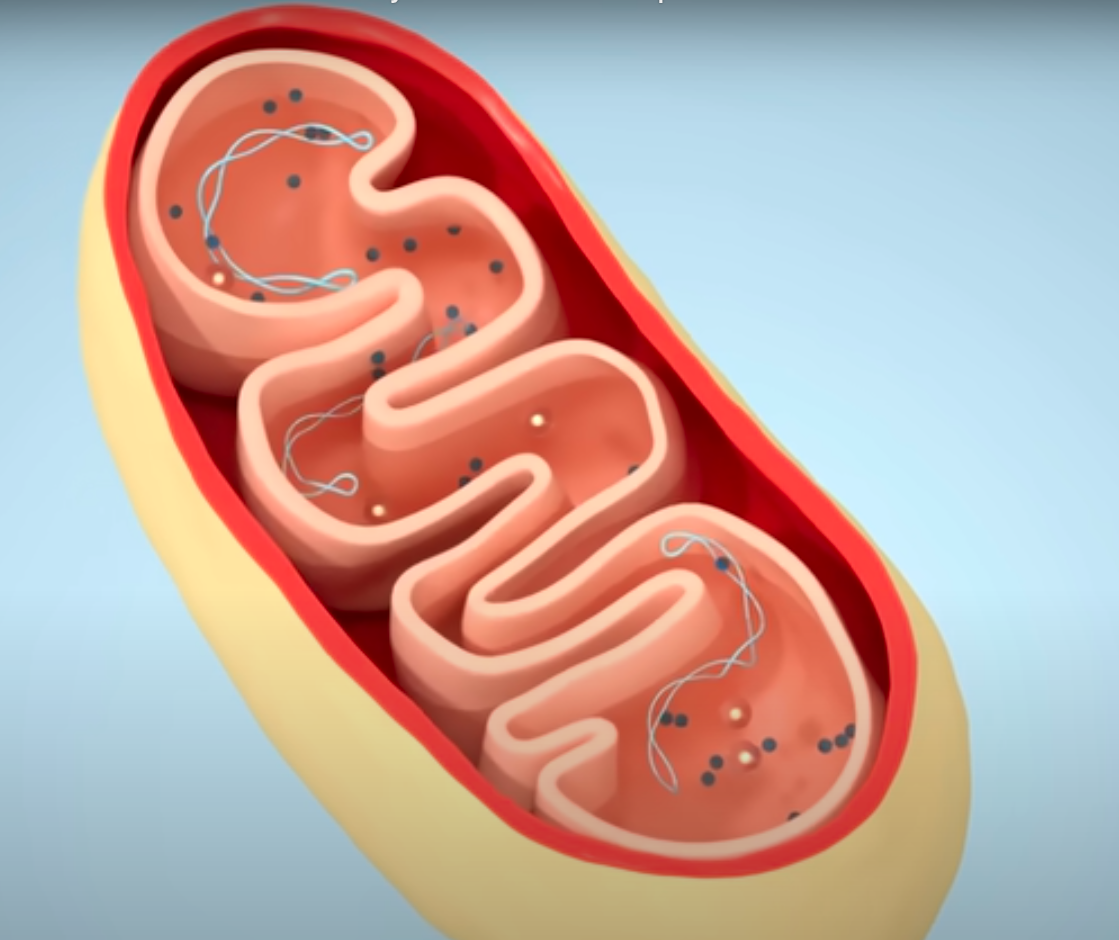 |
three minds | cell environment | communication | communal health | |
Russian Canadian podcaster Anton Petrov summarized research findings about mitochondria.
So this powerhouse analogy while catchy may not be entirely correct. Mitochondria are way more complex and one of their main functions is actually information processing inside the cell. But as we've discussed before, not just inside one cell, they can even interact and process information outside of the cell while then communicating with each other. And that's because they seem to be also equipped with a lot of different receptors on their surface that can easily sense what's happening inside a cell, can easily receive certain molecules used for communication, and then integrate all of this information. And here's the kicker. Then tell the
nucleus inside the cell on what to do.
Basically, mitochondria direct nucleus and other organelles in order to maintain the health of the cell and thus the health of the entire organism. So I guess here you can also see them as a kind of a brain or the mind of the cell itself. They seem to be controlling the whole show. And so a lot of the recent research describes mitochondria as dynamic sensing organelles able to perceive, able to integrate information and then to adapt in order to provide thriving conditions for the cell. Which of course does actually make sense because we know that billions of years ago this used to be an independent bacteria. So they very likely maintain a lot of functions and can still act independently, although in this case also seem to act as a kind of a communal organism.
Anton Petrov. Research on Mitochondria Provides Answers on Why We Have to Sleep.
Martin Picard, Carmen Sandi. The social nature of mitochondria: Implications for human health. #1508  |
-1850000000 |
 |
three minds | body ownership | point of view | free will and agency | |
Scientist, artist, cultural theorist David Glowacki, originally from Milwaukee, appealing to pathologies, distinguished five ways that collections of perceptions are associated with being a "self".
• Embodied Self - identification of emotions and moods with body ownership - [as indicated by] phantom limb syndrome... sensations of pain in missing limbs... rubber hand illusion...
• Perspectival Self - experiencing the world from a particular (often visual) point of view... Out of body experiences...
• Volitional Self - associated with free will & agency ... schizophrenia
• Narrative Self - the stories we tell ourselves about our history & future ... dementia ... amnesia
• Social Self - how we perceive others perceiving us ... dementia
David Glowacki. Numadelic Virtual Reality: An aesthetic paradigm for design beyond day-to-day phenomenology.
#1505  |
2025 |
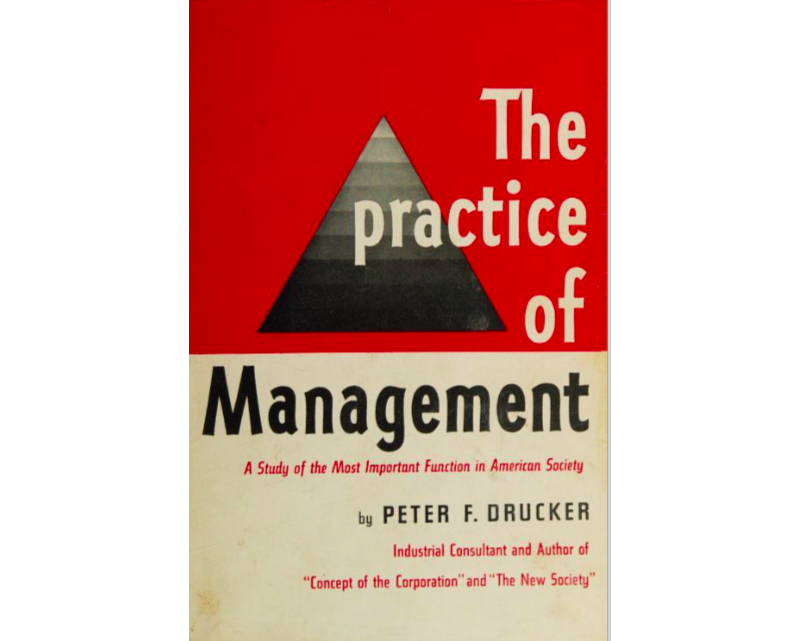 |
threesome | agree on objective | work | evaluate and reward | |
Austrian American management consultant Peter Drucker introduced Management by objectives. The purpose was to free managers from the "activity trap" and have them think through and agree with supervisors and subordinates on their objectives and responsibilities. The process consisted of 5 steps:
• review organizational goal
• set worker objective
• monitor progress
• evaluate
• give a reward
Wikipedia: Management by objectives.
Andrii Bas. A History of Objectives and Key Results (OKRs).
Peter Drucker. The Practice of Management. #1498  |
1954 |
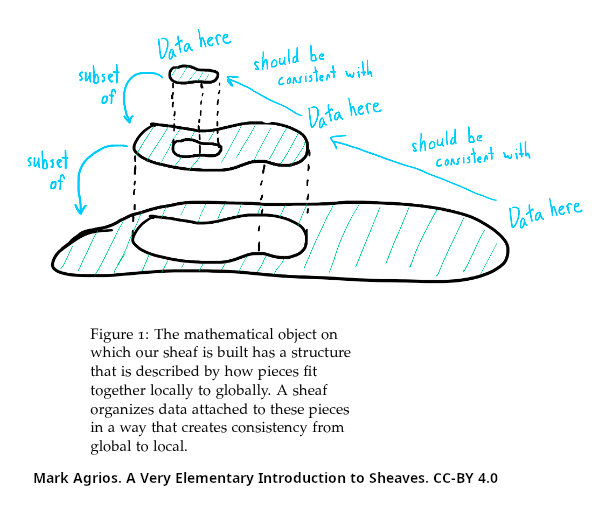 |
three minds | algebraic compatibility | topological compatibility | compatibility of compatibility | |
French mathematician Henri Cartan led the Cartan seminar which wrote up sheaf theory for the first time. Intuitively, a sheaf is a structural correspondence between algebraic data and spatial regions.
Technically, a sheaf F is a contravariant functor that maps open sets of a topological space X to some set F(x) such that for any open sets V ⊂ U there is a restriction morphism res(V,U):U → V for which
res(U,U):U → U is the identity morphism on F(U)
given W ⊂ V ⊂ U then res(W,V) res(V,U) = res(W,U)
and furthermore this presheaf, given any open cover of U by Uᵢ ⊂ U, must satisfy
locality: if sections s,t ∈ F(U) agree on Uᵢ, then they must be equal
gluing: if sᵢ ∈ F(U) is a family of sections, and if these sections all agree on their overlaps, then there exists a section S ∈ F(U) that glues them all together, so that s and sᵢ agree on Uᵢ.
Thus a sheaf establishes a compatibility between the compatibility of spatial regions, topologically, and the compatibility of set functions, algebraically.
Wikipedia: Sheaf (mathematics)
Mark Agrios. A Very Elementary Introduction to Sheaves. #1492  |
1948 |
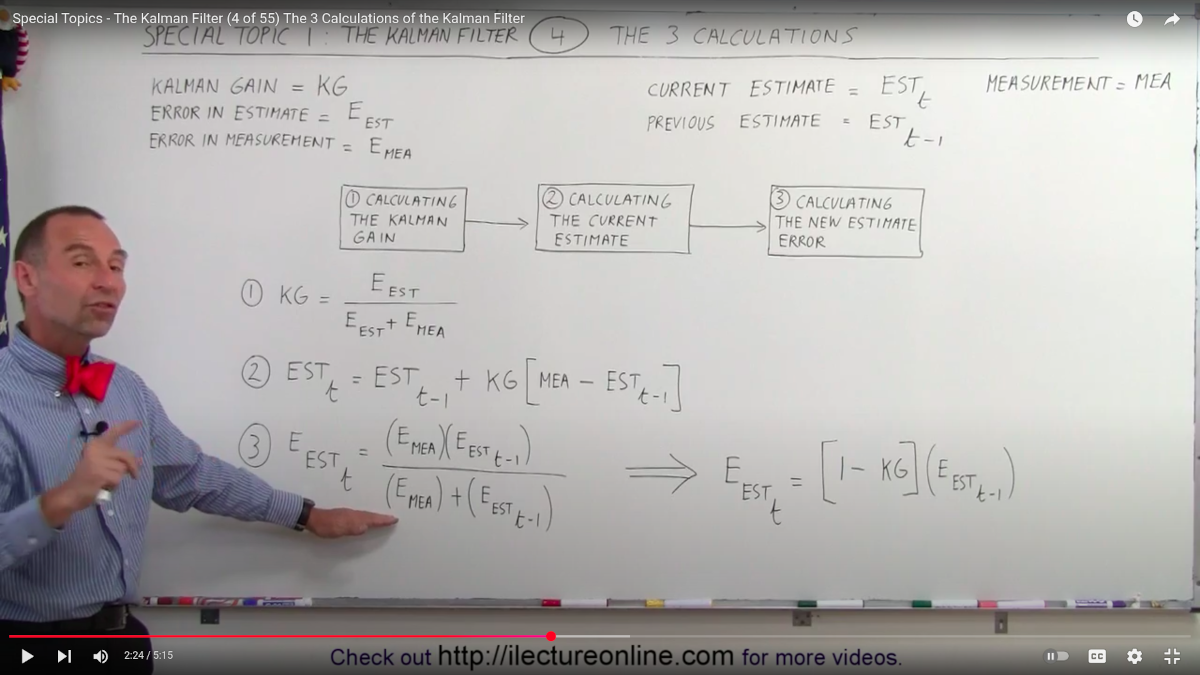 |
three minds | observed | inferred | integrated | |
Hungarian-American electrical engineer Rudolf E. Kálmán was one of the inventors of the Kalman filter, an algorithm which was used for navigation by the Apollo spacecraft, and found broad application.
We are given signal x₁(t) and noise x₂(t). Only the sum y(t) = x₁(t) + x₂(t) can be observed. Suppose we have observed and know exactly the values of y(t₀), ..., y(t). What can we infer from this knowledge in regard to the (unobservable) value of the signal at t = t₁, where t₁ may be less than, equal to, or greater than t?
The algorithm is recursive. At each step, it has us integrate what we know empirically from the measurements y and their errors, and what we know theoretically, as by the laws of motion, about the behavior of the underlying values x, and the errors we estimate for them. The Kalman filter is a ratio between 0 and 1 which combines the two sources of error and determines how much we should rely on the latest measurement y and how much we should rely on our understanding of the underlying value x. This gives us a new value for x and its estimated error.
Wikipedia: Kalman filter
R.E.Kalman. A New Approach to Linear Filtering
and Prediction Problems. #1490  |
1960 |
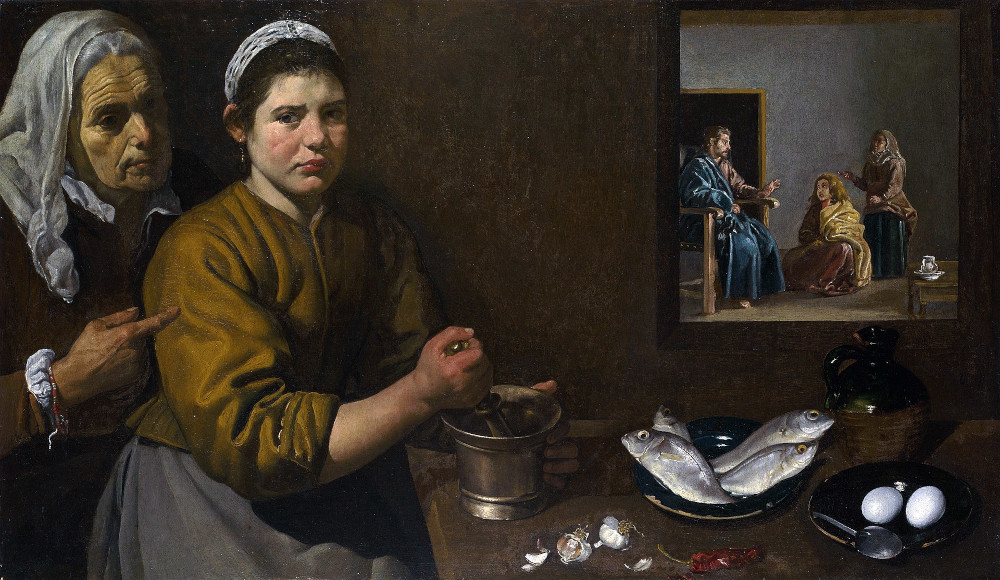 |
three minds | many things | the good part | | |
Jesus loved Martha and Mary.
...a certain woman named Martha received him into her house. She had a sister called Mary, who also sat at Jesus’s feet and heard his word. But Martha was distracted with much serving, and she came up to him, and said, “Lord, don’t you care that my sister left me to serve alone? Ask her therefore to help me.”
Jesus answered her, “Martha, Martha, you are anxious and troubled about many things, but one thing is needed. Mary has chosen the good part, which will not be taken away from her.”
Luke 10:38-42
Wikipedia: Jesus at the home of Martha and Mary #1484  |
85 |
 |
three minds | gradient | randomness | computation | |
Physicist Woodrow Shew shared his thoughts about Escherichia coli bacteria, which have receptors for chemical agents and also have flagella that they use to swim around.
So they have a motor system, they have a sensory system and they have a weird chemical network inside their single cell body that does some computation. It takes some sensory input and turns it into motor output. Like they swim up the gradient to get food and stuff like that. ... in the absence of a food gradient, what these things do is they swim around according to a path that has power law statistics. This is their tumbling. The random tumbling thing. ... So in a sense, their behavior is scale invariant and the computation that their simple little body is doing is actually another example of criticality.
Brain Inspired. Woodrow Shew and Keith Hengen: The Nature of Brain Criticality. #1468  |
-800000000 |
 |
three minds | unpredictability | predictability | marginal stability | |
Physicist Woodrow Shew and biologist Keith Hengen talked about the critical brain hypothesis.
Keith Hengen: If you're Caitlin Clark and you go up for your 10,000th jump shot, you don't want to be integrating all the scales of information across all the regions of your brain. You don't want to be remembering the fight you had with your mom 3 days ago. You don't need to be reflecting on where your car is or the emotional state of ... You just need to collapse onto a very, very simple manifold and repeat that thing, right?
... being near a critical bifurcation gives you a property called marginal stability. ... Marginal stability is the difference between a 747 and an F-16. Like the 747 is immensely stable, but you cannot change. It would take a huge amount of force to change direction. And an F-16 in contrast is on the on the limit of uncontrollable and unflyable. But by being one step back from that loss of control, you can flip that thing around on a dime.
And so when Caitlin Clark presumably gets to the line, she can shift that cognitive space and sort of tighten that space so that it is no longer scale-free and shift into this simple manifold, execute the three-pointer, and then back into this kind of more dynamic range.
...Paul Middlebrooks: So this seems directly related to the explore-exploit dichotomy.
Brain Inspired. Woodrow Shew and Keith Hengen: The Nature of Brain Criticality.
Keith B. Hengen, Woodrow L. Shew. Is criticality a unified setpoint of brain function? #1464  |
2025 |
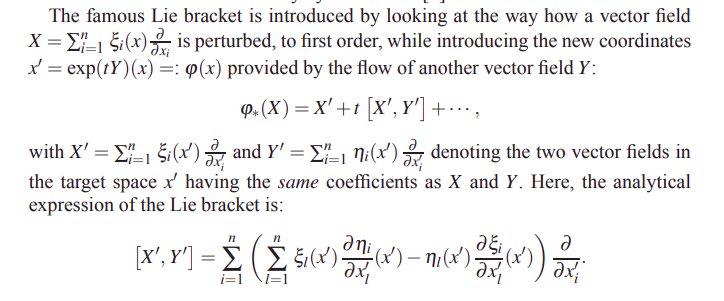 |
three minds | AB | BA | AB-BA | |
Norwegian mathematician Sophus Lie studied continuous transformation groups, now known as Lie groups, in terms of infinitesimal generators, the elements of a Lie algebra, structured by the commutator, the Lie bracket [A,B]=AB-BA, which indicates the lack of commutativity.
Joël Merker. Theory of Transformation Groups by Sophus Lie and Friedrich Engel. (Vol. I, 1888) #1462  |
1888 |
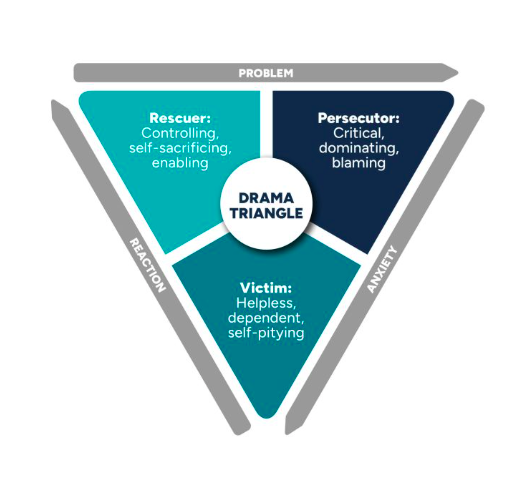 |
three minds | victim | persecutor | rescuer | |
American psychiatrist Stephen Karpman described the Drama Triangle of three roles that people play, sometimes shifting between roles.
• The Victim in this model is not intended to represent an actual victim, but rather someone feeling or acting like one. The Victim seeks to convince him or herself and others that he or she cannot do anything, nothing can be done, all attempts are futile, despite trying hard. One payoff for this stance is avoiding real change or acknowledgement of one's true feelings, which may bring anxiety and risk, while feeling one is doing all one can to escape it. As such, the Victim's stance is "Poor me!" ... The Victim will remain with a Persecutor or, if not being persecuted, will set someone else up in the role of Persecutor. The Victim will also seek help, creating one or more Rescuers to save the day, who will in reality perpetuate the Victim's negative feelings and leave the situation broadly unchanged.
• The Rescuer: The Rescuer's line is "Let me help you." A classic enabler, the Rescuer feels guilty if they do not go to the rescue, and ultimately becomes angry (and becomes a Persecutor) as their help fails to achieve change. Yet the Rescuer's rescuing has negative effects: it keeps the Victim dependent and doesn't allow the Victim permission to fail and experience the consequences of his or her choices. The rewards derived from this rescue role are that the focus is taken away from the Rescuer, who can also feel good for having tried, and justified in their negative feelings (to the other actor/s) upon failing. When one focuses one's energy on another, it enables one to ignore one's rown anxiety and troubles. This rescue role is also pivotal because one's actual primary interest is really an avoidance of one's own problems disguised as concern for the Victim's needs.
• The Persecutor: (a.k.a. Villain) The Persecutor insists, "It's all your fault." The Persecutor is controlling, blaming, critical, oppressive, angry, authoritarian, rigid and superior. But if blamed in turn, the Persecutor may become defensive and may switch roles to become a Victim if attacked forcefully by the Rescuer and/or Victim, in which case the Victim may also switch roles to become a Persecutor.
Wikipedia: Karpman drama triangle. #1446  |
1968 |
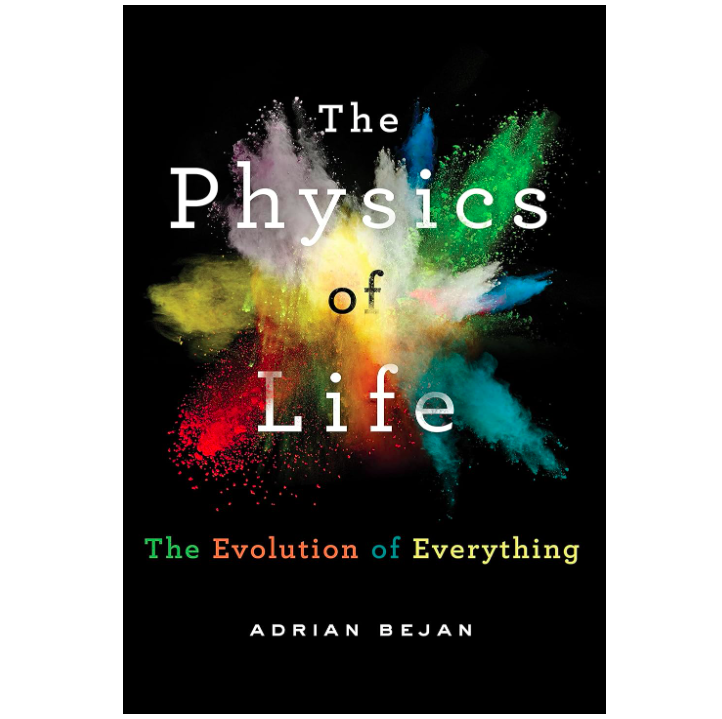 |
foursome | data | observations | designs | principles |
Romanian-American mechanical engineer Adrian Bejan, formulator of the constructal law, contemplated the better questions that lead to better science and better government.
Data is the plural of datum (a given), i.e., something that is "in hand", known or held, a fact on which anybody can rely. Data are the facts that we accumulate based on observations, measurements and surveillance. Making data available is pointless without the principle to understand, organize and put things in motion.
Knowledge (scientia, in Latin) is science, and science is observing, predicting, teaching and doing, which is the practical application of science. Observing is the mental condensing and streamlining of the flow of observations. What is condensed are the principles, and the most unifying among them are the first principles, the laws of physics.
Knowledge is the human capacity to effect design change that is useful to humans. Intelligence is to "see" a better design before it is put into words, tested and built. Knowledge is the fast-forwarding of the physics phenomenon of design generation, spread and evolution.
Adrian Bejan. The Physics of Life: The Evolution of Everything. #1445  |
2016 |
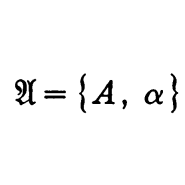 |
three minds | objects | mappings | correspondence of objects and identities | |
American mathematicians Samuel Eilenberg and Saunders MacLane founded category theory.
In order to deal in a general way with such situations, we introduce the concept of a category. Thus a category will consist of abstract elements of two types: the objects A (for example, vector spaces, groups) and the mappings a (for example, linear transformations, homomorphisms). For some pairs of mappings in the category there is defined a product (in the examples, the product is the usual composite of two transformations). Certain of these mappings act as identities with respect to this product, and there is a one-to-one correspondence between the objects of the category and these identities.
Samuel Eilenberg, Saunders MacLane. General Theory of Natural Equivalences.
Wikipedia: Category theory #1444  |
1945 |
 |
three minds | deeds | words | wisdom | |
Jesus ended his Sermon on the Mount with this parable.
Everyone therefore who hears these words of mine and does them, I will liken him to a wise man who built his house on the rock. The rain came down, the floods came, and the winds blew and beat on that house; and it didn’t fall, for it was founded on the rock. Everyone who hears these words of mine and doesn’t do them will be like a foolish man who built his house on the sand. The rain came down, the floods came, and the winds blew and beat on that house; and it fell - and its fall was great.
Matthew 7:24-27 #1443  |
88 |
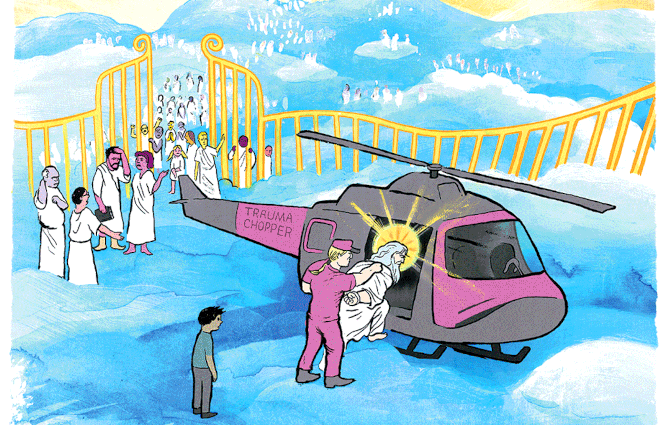 |
nullsome | insufferability | | | |
American cartoonist Nicholas Gurewitch, creator of the subversive webcomic, the Perry Bible Fellowship, has the Trauma Trooper arrest and interrogate God.
Trauma Trooper: The cycle started with someone. And I think I know who. So... why'd you do it?
God: I created reality to deal with the trauma of non-existence. Prior to existence, the emptiness was insufferable. After endless soul-searching, I found myself exploding. By becoming things, I was able to experience non-existence through sickness, death & disconnect.
Perry Bible Fellowship. Trauma Trooper. #1436  |
2023 |
 |
three minds | biofilm | cells | community | |
Swedish medical microbial physiologist Ute Römling argued that biofilms arose along with the most ancient life.
As previously hypothesized in this opinion paper, biofilms originated concomitantly with life. The most fundamental behaviour towards ancient solid electron donors and acceptors and the cellular prerequisites for direct most effective energy gain from solid mineral electron acceptors was therefore biofilm formation. With most ancient and most abundant iron and sulfur‐based respiration requiring solid surfaces, biofilm formation could be subsequently extended towards additional solid inorganic electron acceptors. Upon the availability of soluble inorganic and organic electron acceptors and other energy‐related signals, solid‐surface biofilm formation desisted to be mandatory for energy‐gain, but a multicellular microbal community in the form of cell aggregates (flocks) has still been a prerequisite for survival as even today, single planktonic microbial cells are rarely found in nature. With the presence of solid and soluble redox pairs, the biofilm response could subsequently further diversify.
Ute Römling. Is biofilm formation intrinsic to the origin of life? #1435  |
-3650000000 |
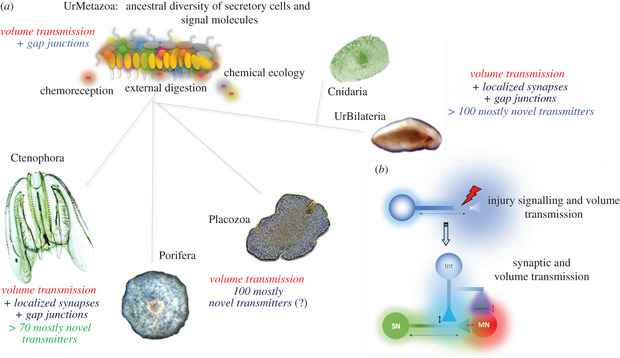 |
three minds | cells | signaling | | |
Evolutionary biologist Leonid L. Moroz, neurophysiologist Daria Y. Romanova and zoologist Andrea B. Kohn argued that neurotransmitters were secreted in response to injuries.
We explore the scenario that neurons arose from genetically different populations of secretory cells capable of volume chemical transmission and integration of behaviours without canonical synapses. The closest representation of this primordial organization is currently found in Placozoa, disk-like animals with the simplest known cell composition but complex behaviours. We propose that injury-related signalling was the evolutionary predecessor for integrative functions of early transmitters such as nitric oxide, ATP, protons, glutamate and small peptides.
The free radical, gaseous nitric oxide (NO) is one of the earliest and the most versatile transmitters: from archaea to plants, fungi and animals. NO is also the simplest signal molecule and produced by one of the most evolutionarily conservative and complex synthetic enzymes (figure 6a). Across all domains of life, NO is associated with a response to injury, innate immunity, repairing and differentiation, and acts as an intermediate of the nitrogen cycle.
Leonid L. Moroz, Daria Y. Romanova, Andrea B. Kohn. Neural versus alternative integrative systems: molecular insights into origins of neurotransmitters.
#1434  |
-560000000 |
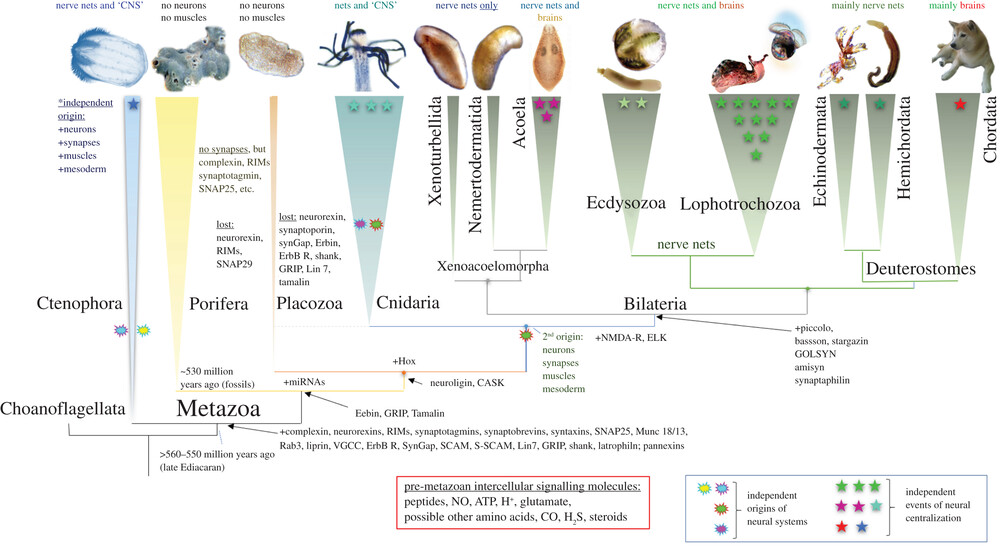 |
three minds | modules | platform | tuning | |
Neuroscientist Leonid L. Moroz, neurophysiologist Daria Y. Romanova and zoologist Andrea B. Kohn argued that neurotransmitters were key to the evolution of feeding.
The emergence of extracellular digestion and relevant elaborated secretion in metazoan ancestors was an important preadaptation to form intercellular regions with unique chemical microenvironments of signal molecules. Indeed, in a multicellular organism, such a biologically significant goal as feeding requires substantial integration of multiple effectors: ciliated, contractile and secretory cells. Feeding also includes innate immune protection against potential pathogens (e.g. using nitric oxide and toxins) and injury-induced regenerative responses.
Under this scenario, the genetic determinants providing immediate behavioural output could be mutations affecting putative signal molecules and their reception and inactivation systems. The molecular targets for natural selection would be secreted metabolites, proteins (including proteolytic digestive enzymes), small peptides and toxins with changeable three-dimensional structures, their interactions with orphan receptors, modulators, transporters, inactivation and uptake mechanisms, etc. The resulting sea of potential chemical messengers would be, in a direct sense, a hotspot for the selection of molecular modules capable of generating system innovations.
In contrast with highly stereotyped electrical signalling and wiring, these chemically and purely combinatorial transmitter innovations are more adaptable and simpler. The behavioural coordination of effectors can be easily tuned by dynamic changes of concentrations in a mixture of freely diffusible intercellular messengers. Such functional reconstruction provides a versatile platform for selecting and recruiting molecular modules at all levels of the biological organization with traceable mechanisms and measurable benefits for survival.
In summary, we suggest not that the nervous system evolved transmitters, but rather that transmitters made the nervous system by integrating ancestral populations of secretory cells for behavioural coordinations without synapses. The diversity of ancestral transmitters (signal molecules) may have been the most profound of pre-neuronal metazoan adaptations.
Leonid L. Moroz, Daria Y. Romanova, Andrea B. Kohn. Neural versus alternative integrative systems: molecular insights into origins of neurotransmitters.
#1433  |
-550000000 |
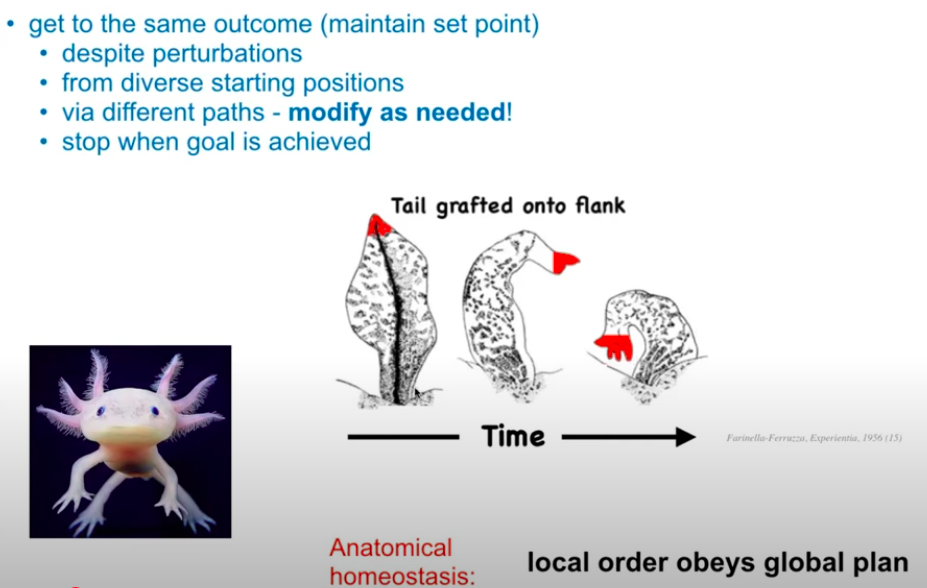 |
three minds | local order | global plan | collective | |
American biologist Michael Levin discussed an experiment from the 1950s where a tail was grafted onto the flank of an axolotl and it turned into a limb.
No individual cell knows what a finger is or what a tail is or how many you're supposed to have or where they're supposed to be. But the collective has a goal. The goal is a reasonably normal looking axolotl. And in order to meet that goal, it has to propagate downwards all of the control signals to its various parts. Notice the parallel of this in cognition. When I'm talking to you right now, I am not worried about having to adjust all your synaptic proteins so that you're able to remember what I said. You're going to do that yourself. The beauty of these kind of multiscale problem solving systems is that they basically hide the underlying molecular events and they take care of whatever needs to happen in order for the higher level system to meet its goal. Okay. And so that's why these tail tip cells start to become fingers. So it's not just about repairing damage. It's about harnessing local order to a global plan that belongs to the large scale collective.
Michael Levin. "Nothing in biology makes sense without teleology." #1432  |
2025 |
 |
three minds | components | glue | | |
American computer scientist John Ousterhout created Tcl (originally, the Tool Command Language) and distinguished it, as a scripting language, from applications languages.
System programming languages (or applications languages) usually have the following properties:
They are typed statically
They support creating complex data structures
Programs in them are compiled into machine code
Programs in them are meant to operate largely independently of other programs
System programming languages tend to be used for components and applications with large amounts of internal functionality such as operating systems, database servers, and Web browsers. ... Prototypical examples of system programming languages include C, OCaml and Modula-2.
By contrast, scripting languages (or glue languages) tend to have the following properties:
They are typed dynamically
They have little or no provision for complex data structures
Programs in them (scripts) are interpreted
Scripting languages tend to be used for applications where most of the functionality comes from other programs (often implemented in system programming languages); the scripts are used to glue together other programs or add additional layers of functionality on top of existing programs. ... Prototypical examples of scripting languages include Python, AppleScript, C shell, DOS batch files, and Tcl.
Ousterhout's dichotomy #1430  |
1988 |
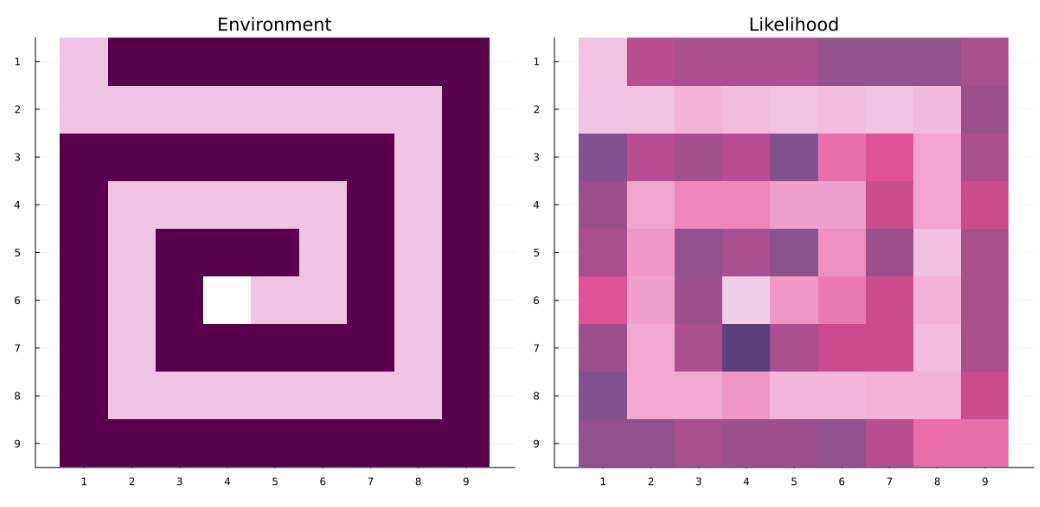 |
three minds | world | structure | interpretation | |
American interdisciplinary scholar Mel Andrews, grounded in AI ethics and philosophy of science, referred to Michael Weisberg in evaluating Karl Friston's Free Energy Principle.
According to Weisberg’s account of models, a model’s structure—whether mathematical, computational, or physical—does not inherently relate to a target system in an epistemically fruitful way, e.g., by representing features of that target system. It is only with the addition of a scientist’s interpretation or construal that we derive a mapping between a model structure and the world, and a model is born.
Mel Andrews. The Math is not the Territory: Navigating the Free Energy Principle. #1426  |
2021 |
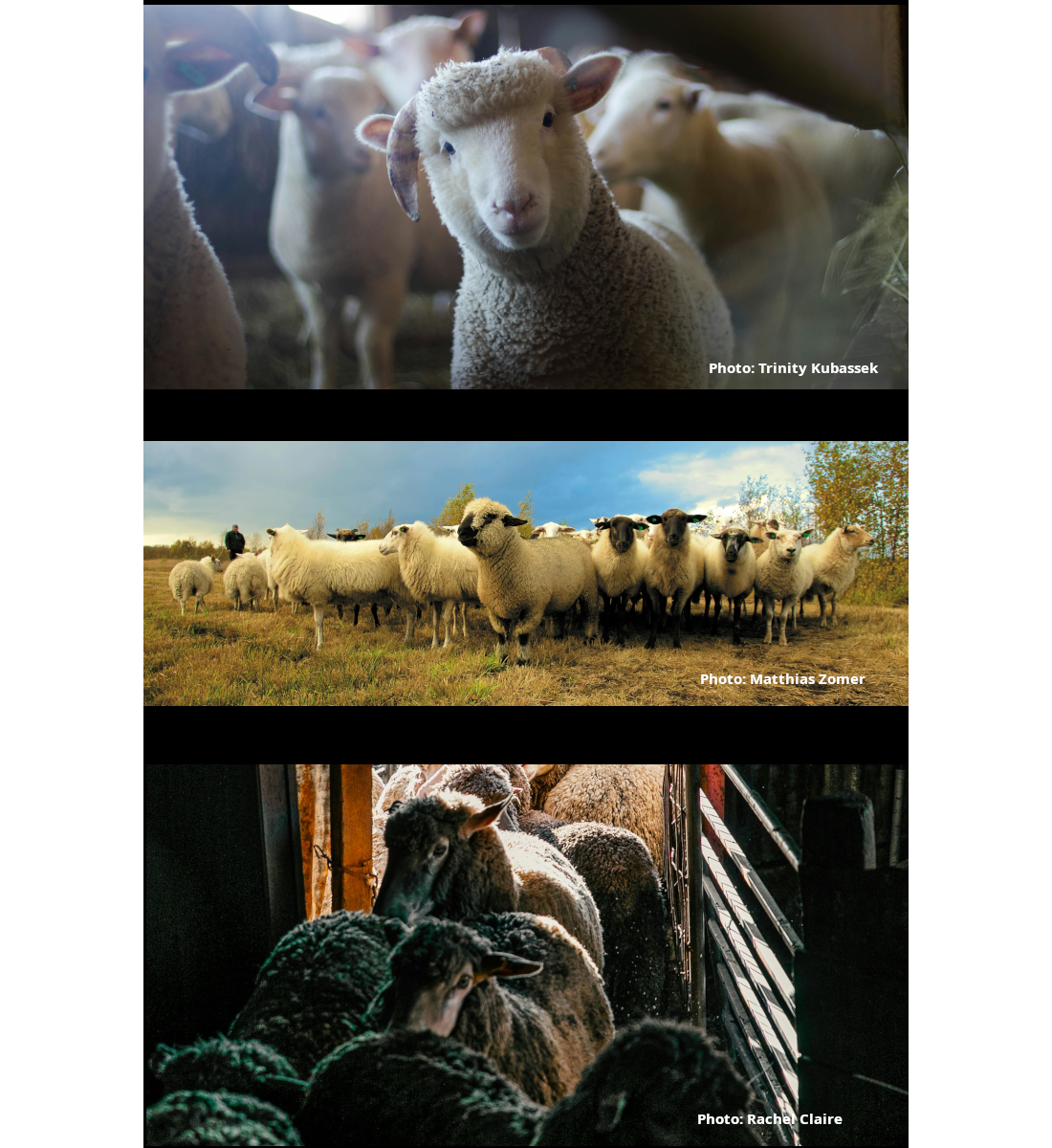 |
three minds | feed lambs | shepherd sheep | feed sheep | |
After his resurrection, Jesus appeared to his disciples at the Sea of Galilee.
So when they had eaten their breakfast, Jesus said to Simon Peter, “Simon, son of Jonah, do you love me more than these?” He said to him, “Yes, Lord; you know that I have affection for you.”
He said to him, “Feed my lambs.”
16 He said to him again a second time, “Simon, son of Jonah, do you love me?” He said to him, “Yes, Lord; you know that I have affection for you.” He said to him, “Tend my sheep.”
17 He said to him the third time, “Simon, son of Jonah, do you have affection for me?” Peter was grieved because he asked him the third time, “Do you have affection for me?” He said to him, “Lord, you know everything. You know that I have affection for you.” Jesus said to him, “Feed my sheep."
World English Bible. John 21.
Interlinear Bible. John 21. #1413  |
100 |
 |
three minds | passive | ingressive | congressive | |
British mathematician Eugenia Cheng, in discussing gender inequality, introduced two terms:
• Ingressive, etymologically, is about going into things. It means being an individual, individualistic, competitive in a zero-sum game where in order to succeed you have to make sure somebody else fails.
• Congressive, etymologically, is about bringing things together. It means taking into account the community. We're all part of a community and nobody is just an individual.
...I used to think there were only two possible, broadly speaking, responses: the ingressive one, where you escalate the ingressive situation - but that's the one way where you kind of have a pithy put down at them; or there's the passive one, where you don't really do anything and then the ingressive situation flourishes. But then I realized the congressive one is where you kind of defuse the ingressive energy and then you open up a congressive space where everyone can have a more sensible interaction.
Rethinking Gender – In conversation with Eugenia Cheng
Eugenia Cheng. x + y: A Mathematician’s Manifesto for Rethinking Gender. #1409  |
2020 |
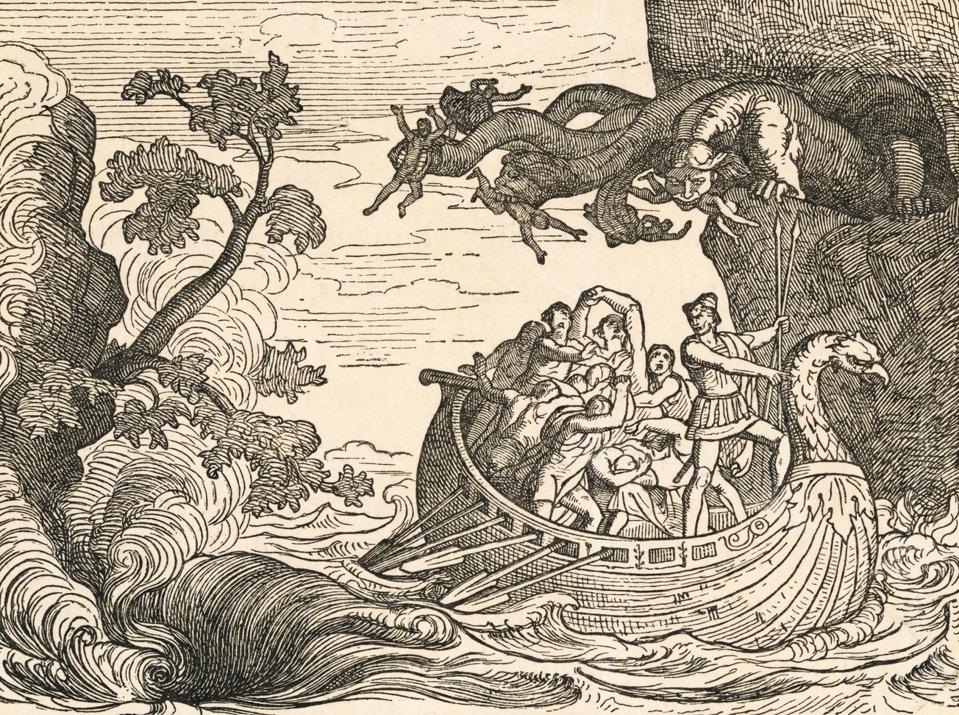 |
three minds | total | partial | | |
Greek bard Homer recounts how the enchantress Circè warned Ullyses that Scylla was terrible.
Twelve feet are hers, all shapeless; six long necks, a hideous head on each, and triple rows Of teeth, close set and many, threatening death. ...No mariner can boast that he has passed by Scylla with a crew unharmed; she snatches from the deck, and bears away in each grim mouth, a living man.
But he should fear Charybdis even more.
Below, Charybdis, of immortal birth, draws the dark water down; for thrice a day she gives it forth, and thrice with fearful whirl she draws it in. O, be it not thy lot to come while the dark water rushes down! Even Neptune could not then deliver thee. Then turn thy course with speed toward Scylla’s rock, and pass that way; ’twere better far that six should perish from the ship than all be lost’.
Homer. The Odyssey. Book XII.
Wikipedia: Between Scylla and Charybdis #1390  |
-700 |
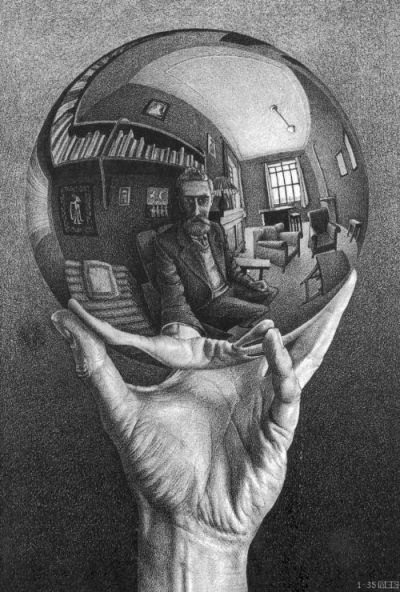 |
foursome | pure awareness | experiencing | narrative | witnessing |
Finnish Australian cognitive scientist Ruben Laukkonen described the meditative journey through four levels of the self that one can identify with.
• narrative self: The one that most of us spend our time absorbed in, believing to be real, and that's our story about ourselves. This is very abstract in the cortical hierarchy of processing. The brain is constructing these self models in layers of complexity and at the most complex abstract level is this narrative, our stories, our beliefs about who we are across time.
• experiencing self or embodied self: But if we slow down the mind a little bit ... if we come and tune into the now, and it's not really the now, but it's kind of closer to the now, we could say we encounter what's happening right here right now. So if I observe my hands and and my body and I look around what I'm engaging there ... that's sort of engaged in sensory processing
• witnessing self: We can even go a layer deeper because we can also recognize that not only can I engage in the present in the sense of recognizing that there is this body and all of this sensory experience that's happening I can also and you can as well recognize that I'm witnessing this experience ... this body ... the colors, the sounds ... I can mindfully observe my body ... my sensations ... my thoughts ... the narrative self ... the embodied self and that suggests that there's also this Observer
• pure awareness: as all of the contemplative traditions and wisdom traditions of old have told us, we can go beyond the subject-object distinction, we can even release this witnessing self ... and then there's you ... some sort of pure being, pure awareness, pure stillness, pure spaciousness, pure presence, all metaphors that point to this kind of
non-conceptual effortless peaceful or much less constructed self
Something else that can happen after that which is a kind of cessation of consciousness where even the identification with the pure awareness, the pure Consciousness is deconstructed or deified and then what we can say is that there's a kind of freedom
Meditation Expert: 4 Stages of Self-Transcendence. Ruben Laukkonen PhD. #1387  |
2025 |
 |
three minds | experiencing | narrative | witnessing | |
Finnish Australian cognitive scientist Ruben Laukkonen described the meditative journey through four levels of the self that one can identify with.
• narrative self: The one that most of us spend our time absorbed in, believing to be real, and that's our story about ourselves. This is very abstract in the cortical hierarchy of processing. The brain is constructing these self models in layers of complexity and at the most complex abstract level is this narrative, our stories, our beliefs about who we are across time.
• experiencing self or embodied self: But if we slow down the mind a little bit ... if we come and tune into the now, and it's not really the now, but it's kind of closer to the now, we could say we encounter what's happening right here right now. So if I observe my hands and and my body and I look around what I'm engaging there ... that's sort of engaged in sensory processing
• witnessing self: We can even go a layer deeper because we can also recognize that not only can I engage in the present in the sense of recognizing that there is this body and all of this sensory experience that's happening I can also and you can as well recognize that I'm witnessing this experience ... this body ... the colors, the sounds ... I can mindfully observe my body ... my sensations ... my thoughts ... the narrative self ... the embodied self and that suggests that there's also this Observer
• pure awareness: as all of the contemplative traditions and wisdom traditions of old have told us, we can go beyond the subject-object distinction, we can even release this witnessing self ... and then there's you ... some sort of pure being, pure awareness, pure stillness, pure spaciousness, pure presence, all metaphors that point to this kind of
non-conceptual effortless peaceful or much less constructed self
Something else that can happen after that which is a kind of cessation of consciousness where even the identification with the pure awareness, the pure Consciousness is deconstructed or deified and then what we can say is that there's a kind of freedom
Meditation Expert: 4 Stages of Self-Transcendence. Ruben Laukkonen PhD. #1386  |
2025 |
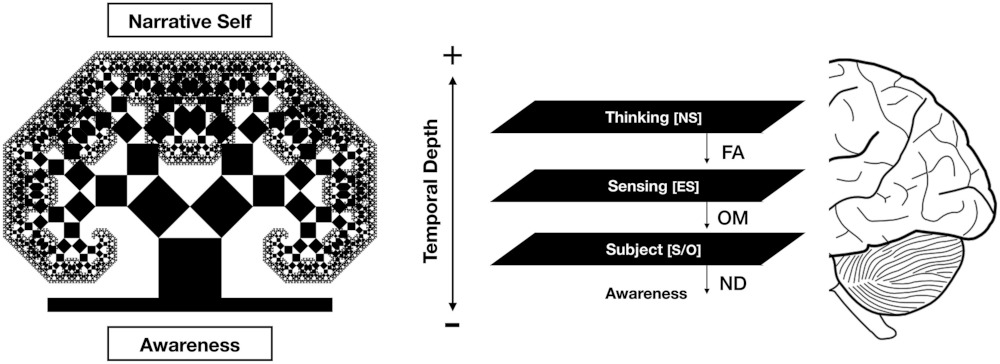 |
three minds | past | future | present | |
Cognitive neuroscientists Ruben Laukkonen and Heleen Slagter provided a theory to explain how different Buddhist meditative practices (focused attention, open monitoring, non-dual) cultivate being in the here and now, pure awareness, by reducing temporally deep, counterfactual, predictive processing.
Our main contention is that FA, OM and ND meditation gradually bring the practitioner more and more into the present moment, thereby progressively abating hierarchically (i.e., temporally) deep predictive processing in the brain. We contend that this not only reduces temporally extended processes, such as episodic future thinking and decision making, but can also explain more unusual kinds of experiences reported by meditators, including loss of self-other distinction and the cessation of time as in non-dual awareness.
Ruben Laukkonen, Heleen Slagter. From many to (n)one: Meditation and the plasticity of the predictive mind. #1380  |
2021 |
 |
three minds | violence | intelligence | fear and hate | |
American film director Franklin J. Schaffner's cult classic "Planet of the Apes", inspired by the French science fiction novel by Pierre Boulle, describes a caste system where gorillas are the military force and laborers, intellectual chimpanzees are mostly scientists and doctors, and orangutans oversee government and religion. The movie concludes with television producer Rod Serling's twist ending, which is foreshadowed by the orangutan Dr.Zaius, who explains why he fears and hates the human astronaut Taylor.
Because you're a man. And you're right. I have always known about man. From the evidence I believe his wisdom must go hand in hand with his idiocy. His emotions must rule his brain. He must be a warlike creature who gives battle to everything around him, even himself. ... The Forbidden Zone was once a paradise. Your breed made a desert of it ages ago.
Planet of the Apes. #1379  |
1968 |
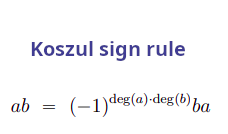 |
three minds | bosonic | fermionic | | |
Russian mathematician Mikhail Kapranov traced the foundations of supergeometry to the Koszul sign rule and the sphere spectrum, the suspension spectrum of S⁰, the zero-dimensional circle consisting of two points {-1,1}.
Supergeometry is a geometric tool which is supposed to describe supersymmetry (“symmetry between bosons and fermions”) in physics.
Indeed, the physical origin of supergeometry lies in the comparison of the Bose and Fermi
statistics for identical particles. So mathematically, supergeometry zooms in on our mental
habits related to questions of commutativity and identity.
[Homotopy theory] provides a systematic modern way to talk about the issues of identity: instead of saying that two things are “the same”, we say that they are “homotopic” ... From this point of view, the group {±1} of signs hovering over supergeometry, is nothing but ... the first homotopy group of the sphere spectrum S.
It is useful to represent observable quantities of immediate physical interest (real, positive, bosonic) as bilinear combinations of more fundamental quantities which can be complex, fermionic and not even observable by themselves.
In other words, it is useful to take “square roots” of familiar objects.
Mikhail Kapranov. Supergeometry in mathematics and physics #1373  |
2018 |
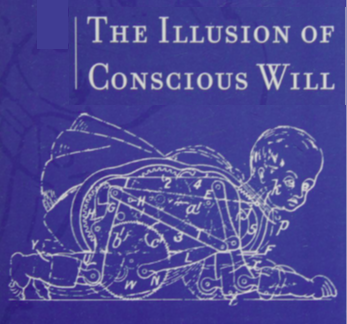 |
three minds | mechanical system | mental system | sense of authorship | |
American social psychologist Daniel Wegner referred to David Hume in arguing that conscious will is something we experience when we perform an action, but not actually a causal link between our minds and our actions.
We're now getting close to a basic principle about the illusion of conscious will. Think of it in terms of lenses. If each person has two general lenses through which to view causality - a mechanical causality lens for objects and a mental causality lens for agents - it is possible that the mental one blurs what the person might otherwise see with the mechanical one. The illusion of conscious will may be a misapprehension of the mechanistic causal relations underlying our own behavior that comes from looking at ourselves by means of a mental explanatory system. We don't see our own gears turning because we're busy reading our minds.
...Although the experience of conscious will is not evidence of mental causation, it does signal personal authorship of action to the individual and so influences both the sense of achievement and the acceptance of moral responsibility.
Daniel Wegner. The Illusion of Conscious Will. #1371  |
2002 |
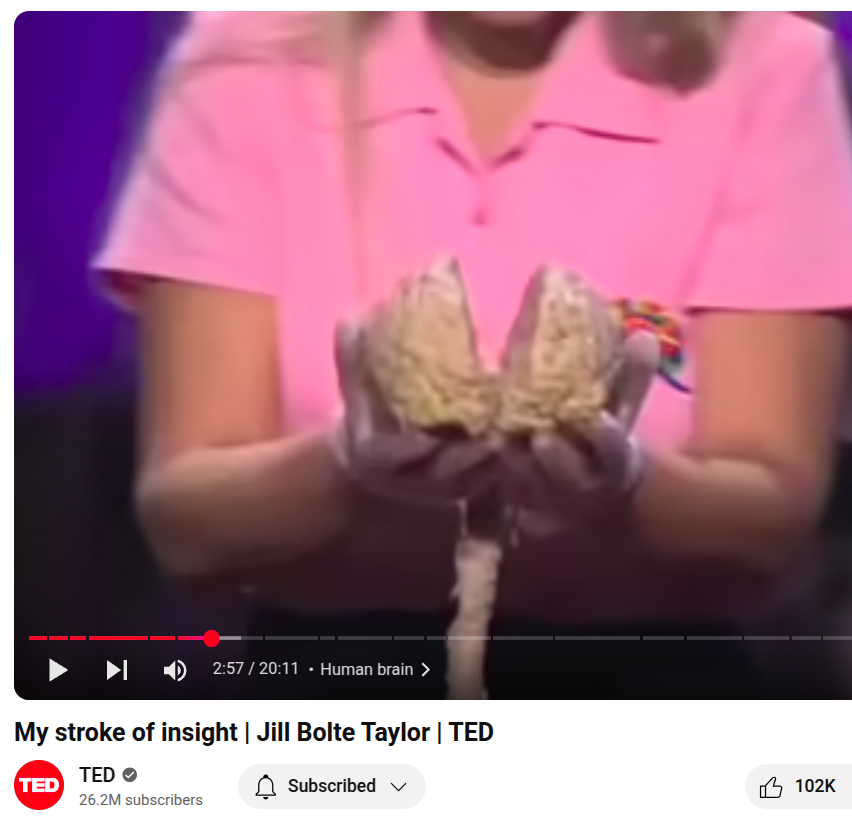 |
three minds | connected | separated | self-identity | |
American neuroanatomist Jill Bolte Taylor recounted her experience of a stroke to her left hemisphere.
So who are we? We are the life-force power of the universe, with manual dexterity and two cognitive minds. And we have the power to choose, moment by moment, who and how we want to be in the world.
Right here, right now, I can step into the consciousness of my right hemisphere, where we are. I am the life-force power of the universe. I am the life-force power of the 50 trillion beautiful molecular geniuses that make up my form, at one with all that is.
Or, I can choose to step into the consciousness of my left hemisphere, where I become a single individual, a solid. Separate from the flow, separate from you. I am Dr. Jill Bolte Taylor: intellectual, neuroanatomist.
These are the "we" inside of me. Which would you choose? Which do you choose? And when? Through the consciousness of my right hemisphere, we are energy-beings connected to one another, through the consciousness of our right hemispheres as one human family.
Jill Bolte Taylor. My stroke of insight.
Wikipedia: My Stroke of Insight #1369  |
2008 |
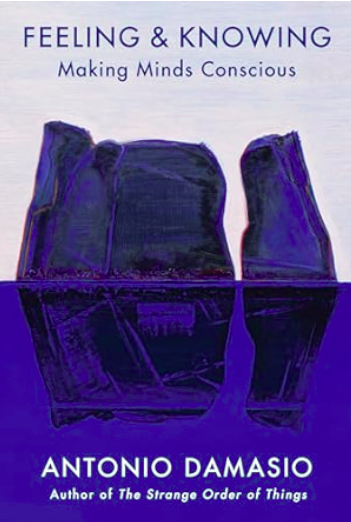 |
three minds | feeling | knowing | listening | |
Portuguese neuroscientist Antonio Damasio argued for the key role of feelings in the evolution of minds and consciousness.
emotion, as the term implies ... it's about movement projected to the outside, whereas feelings are internal, they're subjective. Feelings are my own and your own and I can tell you about my feelings but you cannot see my feelings you cannot hear my feelings you cannot detect them unless I tell you. So it's a big difference between subjective material that is private versus external theatrical material which is in the outside world which is really what emotions are about.
What is the function of feelings? ... the first kind of feelings that we had were feelings about our own body ... hunger, thirst, pain, discomfort, well-being, fatigue, desire. ... What those feelings are doing is informing your mind about the state of your body and this is really quite spectacular because it is feelings producing knowing.
Consciousness started when we started having feelings that told us that we were hungry or thirsty or that we were in pain because they were from the point of view of evolution a first arrival at a point of giving you information, giving you knowledge about the state of your body. ... So feelings and consciousness are sort of assistance to the process of life regulation within an organism.
many people are completely oblivious to the fact that they're feeling ... when you don't listen to what is actually happening in your organism ... not paying attention to your own feelings ... how can you pay much attention to the feelings of others
The FitMind Podcast. Antonio Damasio. Origins of the Mind.
Antonio Damasio. Feeling & Knowing: Making Minds Conscious. #1367  |
2021 |
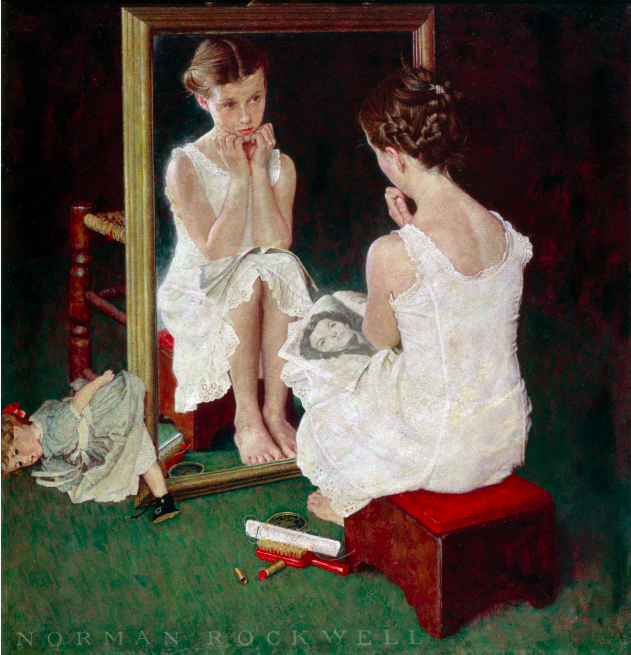 |
three minds | stimuli | causal theories | judgments | |
American social psychologists Richard E. Nisbett and Timothy D. Wilson reviewed evidence that people lack direct introspective access to their higher order cognitive processes.
Subjects are sometimes
(a) unaware of the existence of a stimulus that importantly influenced a response,
(b) unaware of the existence of the response, and
(c) unaware that the stimulus has affected the response.
It is proposed that when people attempt to report on their cognitive processes, that is, on the processes mediating the effects of a stimulus on a response, they do not do so on the basis of any true introspection. Instead, their reports are based on a priori, implicit causal theories, or judgments about the extent to which a particular stimulus is a plausible cause of a
given response. This suggests that though people may not be able to observe directly their cognitive processes, they will sometimes be able to report accurately about them. Accurate reports will occur when influential stimuli are salient and are plausible causes of the responses they produce, and will not occur when stimuli are not salient or are not plausible causes.
Richard E. Nisbett and Timothy DeCamp Wilson. Telling More Than We Can Know: Verbal Reports on Mental Processes
#1365  |
1977 |
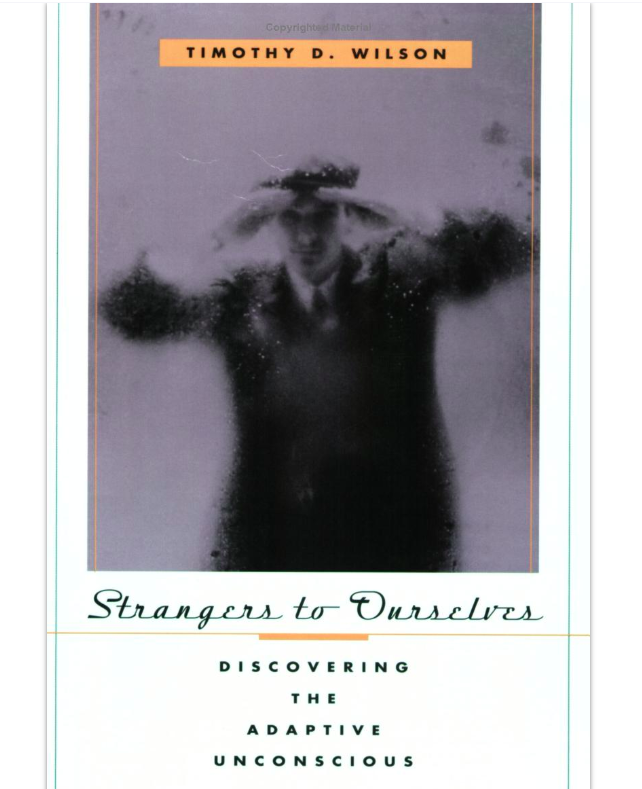 |
three minds | unconscious | conscious | self-reflection | |
American social psychologist Timothy D. Wilson helped introduce the concept of the "adaptive unconscious".
This is not your psychoanalyst's unconscious. The adaptive unconscious that empirical psychology has revealed, and that Wilson describes, is much more than a repository of primitive drives and conflict-ridden memories. It is a set of pervasive, sophisticated mental processes that size up our worlds, set goals, and initiate action, all while we are consciously thinking about something else.
If we don't know ourselves―our potentials, feelings, or motives ― it is most often, Wilson tells us, because we have developed a plausible story about ourselves that is out of touch with our adaptive unconscious. Citing evidence that too much introspection can actually do damage, Wilson makes the case for better ways of discovering our unconscious selves. If you want to know who you are or what you feel or what you're like, Wilson advises, pay attention to what you actually do and what other people think about you. Showing us an unconscious more powerful than Freud's, and even more pervasive in our daily life, Strangers to Ourselves marks a revolution in how we know ourselves.
Timothy D. Wilson. Strangers to Ourselves: Discovering the Adaptive Unconscious #1364 ❤️Marcus Petz  |
2002 |
 |
three minds | sensation | mind | | |
English philosopher John Cottingham interpreted Descartes' mind-body dualism as necessitating a third category, which includes sensations, passions, emotions. This cannot be reduced to thought nor extension but belongs to their union. Animals manifest this third category.
Wikipedia: John Cottingham
John Cottingham. Cartesian Trialism. #1359  |
1985 |
 |
nullsome | source | | | |
Broadway musical star Audra McDonald was asked, What is talent? She replied:
I think it’s an open channel connection to the divine, whatever the divine means to you. Something coming through, that energy, that source, God, whatever you call it. It’s an open channel connection to that. Just a turnpike, no roads in the way.
Charlotte Alter. Audra McDonald Is Our Greatest Living Stage Actor. #1356  |
2025 |
 |
three minds | minimize failure | maximize learning | select approach | |
Belgian neurosurgeon Dirk de Ridder related thermodynamic energy homeostasis, controlled by a balance between the sympathetic and parasympathetic nervous systems, with informational homeostasis, based on the free energy principle. He proposed the free energy principle should be understood not necessarily to minimize but rather to optimize and in some contexts maximize prediction errors.
...the Bayesian brain functions in an informationally homeostatic way based on balance between
• a ‘no guts no glory’ approach that maximizes learning conducive prediction errors in safe environments, associated with parasympathetic activation, and
• a ‘better safe than sorry’ approach that minimizes prediction errors in unsafe environments associated with sympathetic activation, to interact optimally with the environment.
Under high uncertainty (stress), the brain shifts from
• a slow, energetically expensive, but flexible and adaptive belief-based approach to
• a fast, low energy but non-flexible and thus non-adaptive belief-free approach.
Dirk de Ridder. The allostatic Bayesian brain: minimizing and maximizing prediction errors in a changing world. #1355  |
2025 |
 |
three minds | conscious experience | abstract relationship | | |
American software developer Ryan Williams reframed the mind-body problem in terms of quality and structure.
• Structure refers to aspects of the world that are amenable to being described completely
in abstract terms. Other terms for this notion include quantitative or relational. When
we describe the world with equations we are using a structural description. The structural
description of the world discards any intrinsic properties, instead classifying the state of the
world according to the abstract relationships that those states contain.
• Quality refers to the ineffable, intrinsic properties that we find through the window of our
experience. ... the notion includes what would often be described as qualia. ... it does not pretend to be an abstract, unanchored domain. It is entirely grounded in the qualitative properties of the world, of which we are familiar from our own conscious experience.
He considered 5 relationships whereby 1) quality is irrelevant, 2) structure determines quality, 3) quality determines structure, 4) a system is determined by both, 5) each independently determines a system.
Ryan Williams. Structure & Quality: Conceptual and Formal Foundations for the Mind-Body Problem #1354  |
2025 |
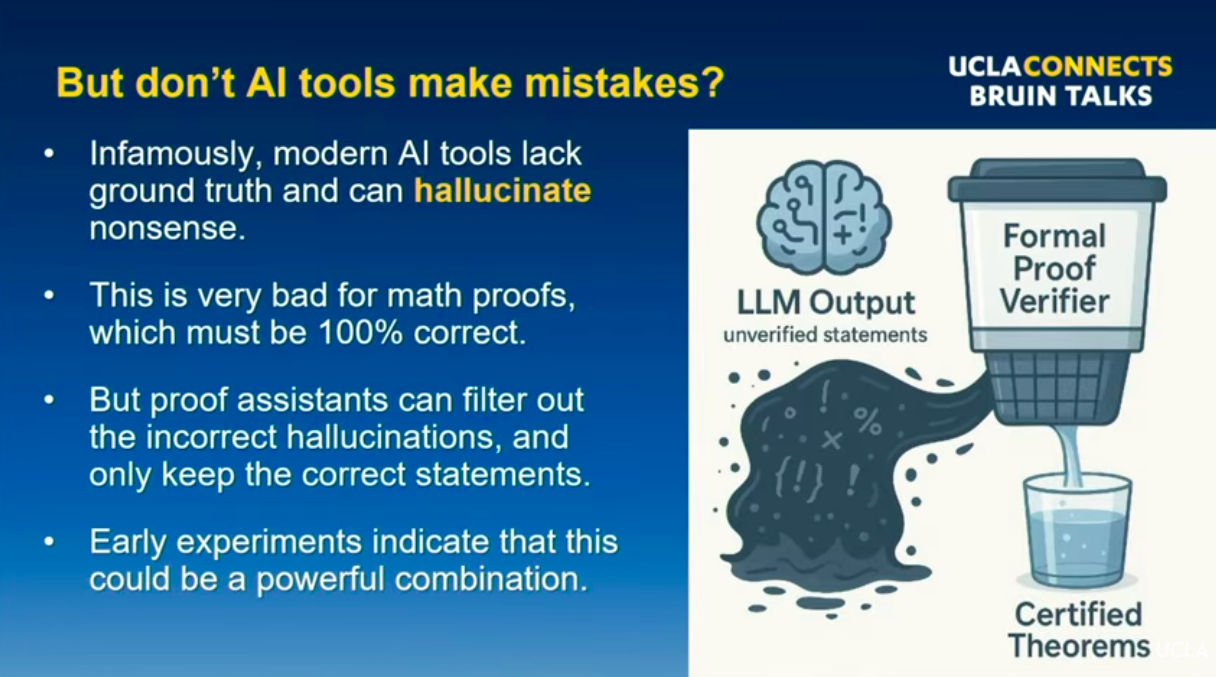 |
three minds | plausible | verified | | |
Australian-American mathematician Terrence Tao spoke about Artificial Intelligence experiments where
• Large language models (LLMs) generate plausible math proofs
• Automated proof assistants check the proofs and discard the erroneous ones.
Terrence Tao. UCLA Connects: Bruin Talks. June 11, 2025. #1350  |
2025 |
 |
three minds | same training | different architectures | universal meaning | |
Three computer science PhD students and one computer security professor at Cornell University demonstrated an unsupervised method for translating text embeddings from one vector space to another without any paired data, encoders or predefined sets of matches.
Our hope that unsupervised embedding translation is possible at all rests on the stronger version of the Platonic Representation Hypothesis. Our conjecture is as follows: neural networks trained with the same objective and modality, but with different data and model architectures, converge to a universal latent space such that a translation between their respective representations can learned without any pairwise correspondence.
Rishi Jha, Collin Zhang, Vitaly Shmatikov, John X. Morris. Harnessing the Universal Geometry of Embeddings. #1349  |
2025 |
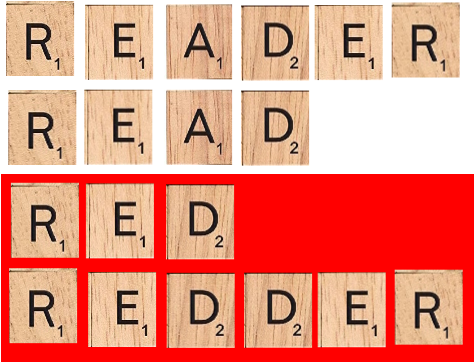 |
three minds | perceptual | linguistic | universal | |
American cognitive scientist Elan Barenholtz contemplated the implications of the success of Large Language Models.
• Language doesn't refer in and of itself. Language is an autonomous system. It's a self-contained system. It has the rules contained within it to generate itself, to carry on a conversation. A large language model don't know what they're talking about in any real sense.
• I do have a quality of perception. There is something called red that my sensory system is aware of. And then there's a token called red that is used in conjunction with, there's a sort of coherent mapping between my sensory perception of red and the linguistic red.
• The sensory perceptual system and the linguistic system are ultimately, we can think of them as essentially distinct and autonomous, but compatible. ... They're exchanging messages so that we can have a single organism that is successfully navigating the world and able, for example, to communicate. ... And then the idea that I'm very inspired by is that there can be this latent space that captures certain universals that are common across these different embeddings that make translation possible.
Curt Jaimungal. The Theory That Shatters Language Itself. #1348  |
2025 |
 |
three minds | visual | textual | executable | |
American researchers Jakub Smékal and Daniel Ari Friedman developed General Notation Notation to facilitate the use of the Active Inference framework by representing generative models in three different ways: as texts, as images and as programs.
GNN supports three complementary modalities for model representation, known as the "Triple Play":
• Text-Based Models: GNN files are plain text and can be rendered into mathematical notation, pseudocode, or natural language descriptions. This forms the core representation.
• Graphical Models: The structure defined in GNN (variables and their connections) can be visualized as graphical models (e.g., factor graphs), clarifying dependencies and model architecture.
• Executable Cognitive Models: GNN specifications can serve as a high-level blueprint or pseudocode for implementing executable simulations in various programming environments. This ensures consistency and aids in the translation from theory to practice.
Jakub Smékal, Daniel Ari Friedman. Generalized Notation Notation for Active Inference Models.
GitHub. Generalized Notation Notation. #1347  |
2023 |
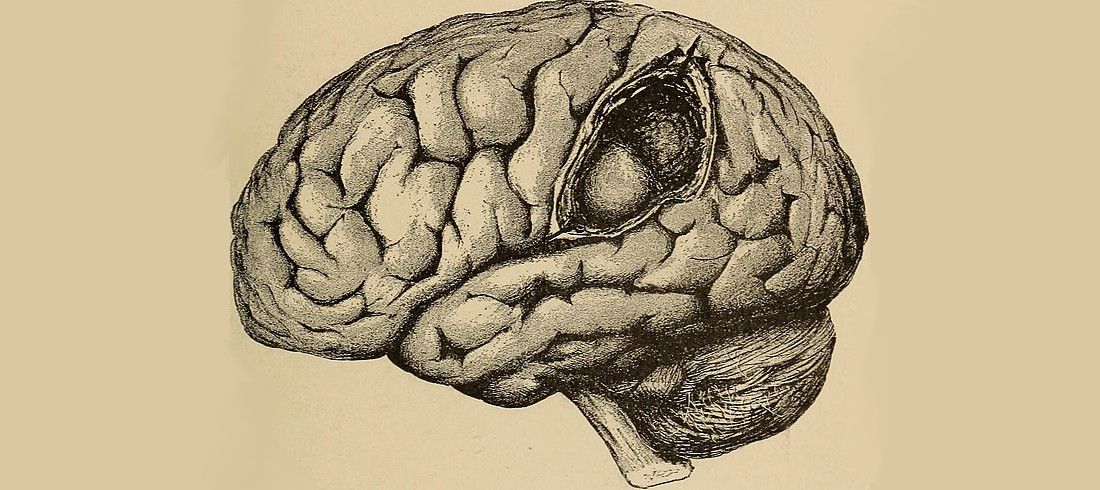 |
three minds | | speech | | |
French neurologist Marc Dax submitted to the French Academy of Sciences two papers titled "Observations tending to prove the constant coincidence of disturbances of speech with a lesion of the left hemisphere of the brain" and "Lesions of the left half of the encephalon coincident with the forgetting of signs of thinking".
Wikipedia: Marc Dax #1331  |
1836 |
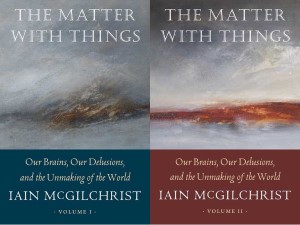 |
three minds | comprehend | apprehend | | |
British psychiatrist Iain McGilchrist considered the dialogue of the brain's two hemispheres in investigating the means to truth (attention, perception, judgement, apprehension, emotional and social intelligence, cognitive intelligence, and creativity), the paths to truth (science, reason, intuition, imagination) and what is truth.
...you could say, to sum up a vastly complex matter in a phrase, that the brain's left hemisphere is designed to help us ap-prehend – and thus manipulate – the world; the right hemisphere to com-prehend it – see it all for what it is.
Wikipedia: The Matter with Things.
Iain McGilchrist. The Matter with Things: Our Brains, Our Delusions, and the Unmaking of the World.
Jenny Mackness. The Matter With Things. Chapter 5. Apprehension. #1326  |
2021 |
 |
three minds | give | ask | | |
Jesus, in the Sermon of the Mount, taught
Ask, and it will be given you. Seek, and you will find. Knock, and it will be opened for you. For everyone who asks receives. He who seeks finds. To him who knocks it will be opened. Or who is there among you who, if his son asks him for bread, will give him a stone? Or if he asks for a fish, who will give him a serpent? If you then, being evil, know how to give good gifts to your children, how much more will your Father who is in heaven give good things to those who ask him!
Matthew 7:7-11 #1324  |
88 |
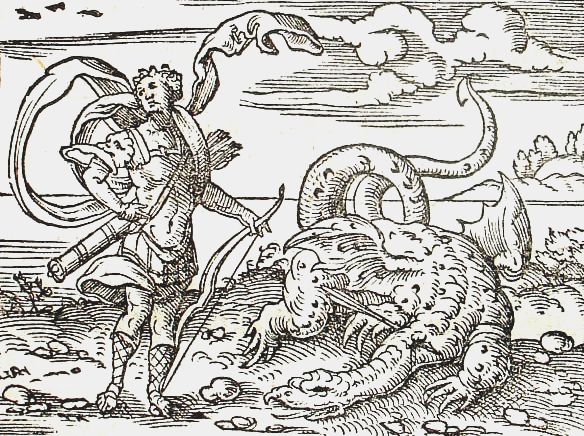 |
three minds | bad | good | counsel | |
The Homeric Hymn to Pythian Apollo tells how Zeus bore Athena of his own self, and then how his wife Hera, in anger, bore the serpent monster, who later Apollo slayed, in founding his temple for the oracles at Pythos.
Hear from me, all gods and goddesses, how cloud-gathering Zeus begins to dishonor me wantonly, when he has made me his true-hearted wife. See now, apart from me he has given birth to bright-eyed Athena who is foremost among all the blessed gods. ... How dared you by yourself give birth to bright-eyed Athena? Would not I have borne you a child —I, who was at least called your wife among the undying gods who hold wide heaven.
Beware now lest I devise some evil thing for you hereafter: yes, now I will contrive that a son be born me to be foremost among the undying gods —and that without casting shame on the holy bond of wedlock between you and me. ... she bare one neither like the gods nor mortal men, fell, cruel Typhaon, to be a plague to men. Straightway large-eyed queenly Hera took him and bringing one evil thing to another such, gave him to the dragoness; and she received him. And this Typhaon used to work great mischief among the famous tribes of men.
There the lord Phoebus Apollo resolved to make his lovely temple, and thus he said: “In this place I am minded to build a glorious temple to be an oracle for men, and here they will always bring perfect hecatombs, both they who dwell in rich Peloponnesus and the men of Europe and from all the wave-washed isles, coming to question me. And I will deliver to them all counsel that cannot fail, answering them in my rich temple.”
Homeric Hymns. Hymn 3 to Apollo. #1321  |
-600 |
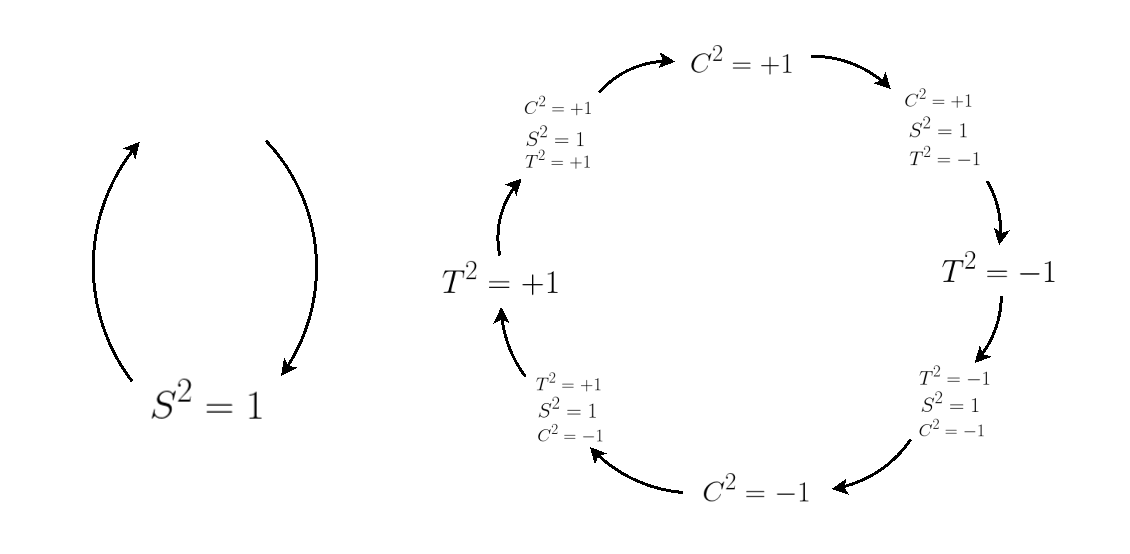 |
three minds | time reversal | charge conjugation | parity | |
The universe is invariant upon applying together all three fundamental symmetry operations: charge conjugation C (swapping matter and antimatter), parity P (reflecting in a mirror, swapping lefthandedness and righthandedness), and time reversal T (changing the direction in time, swapping forwards and backwards).
Wikipedia: CPT symmetry
Kulikauskas. An Allegory: The Solipsistic Self as the Hamiltonian of a Noninteracting Fermion. #1310  |
-13800000000 |
 |
three minds | impulsiveness | emptiness | self-understanding | |
Canadian singer-songwriter Gene MacLellan wrote "Snowbird" while walking on a beach in Prince Edward Island. Anne Murray's recording was a hit single in the United States.
When I was young my heart was young then, too
Anything that it would tell me, that's the thing that I would do
But now I feel such emptiness within
For the thing that I want most in life's the thing that I can't win
Spread your tiny wings and fly away
And take the snow back with you where it came from on that day
The one I love forever is untrue
And if I could you know that I would fly away with you
Snowbird. Lyrics.
Wikipedia: Snowbird (song) #1305  |
1969 |
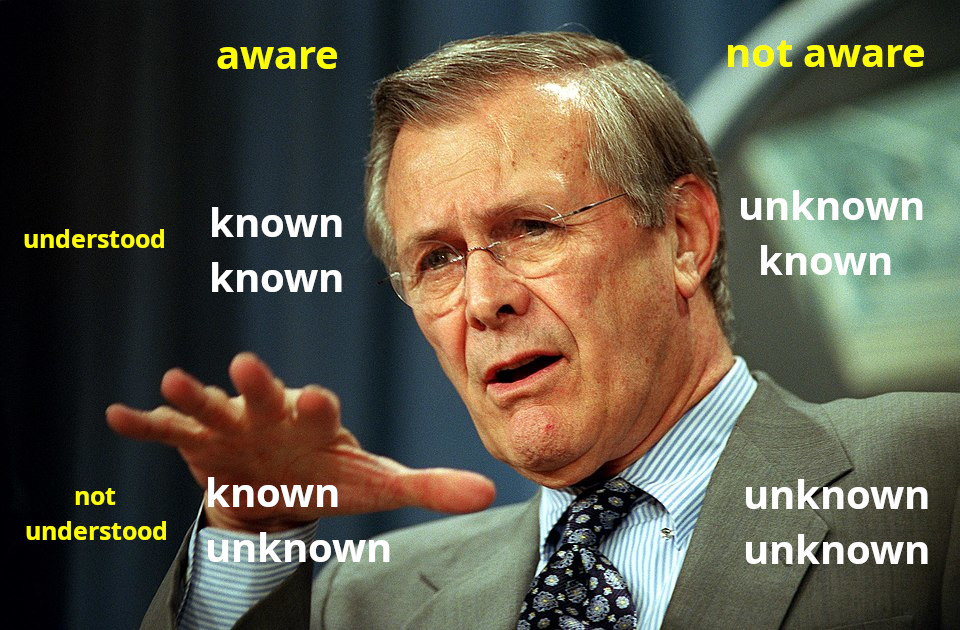 |
foursome | unknown known | known known | known unknown | unknown unknown |
United States Secretary of Defense Donald Rumsfeld responded to a question at a news briefing on February 12, 2002, regarding the lack of evidence linking the government of Iraq with the supply of weapons of mass destruction to terrorist groups.
Reports that say that something hasn't happened are always interesting to me, because as we know, there are known knowns; there are things we know we know. We also know there are known unknowns; that is to say we know there are some things we do not know. But there are also unknown unknowns—the ones we don't know we don't know. And if one looks throughout the history of our country and other free countries, it is the latter category that tends to be the difficult ones.
Wikipedia: There are unknown unknowns #1301  |
2002 |
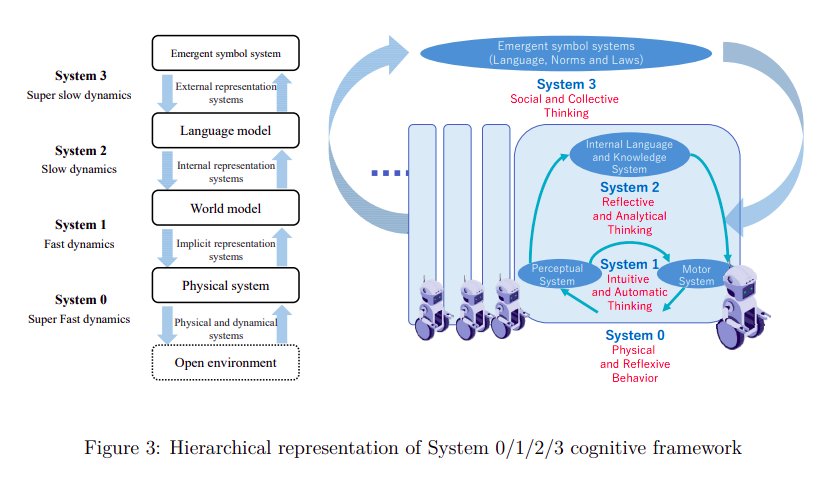 |
foursome | embodied processes | fast thinking | slow thinking | symbol system emergence |
Tadahiro Taniguchi and his colleagues, Japanese researchers of Artificial Intelligence and robotics, appealed to Henri Bergson's theory of multiple intrinsic time scales in expanding upon the fast-thinking System 1 and slow-thinking System 2 distinction popularized by experimental psychologists Daniel Kahneman and Amos Tversky.
This paper introduces the System 0/1/2/3 framework as an extension of dual-process theory, employing a quad-process model of cognition. Expanding upon System 1 (fast, intuitive thinking) and System 2 (slow, deliberative thinking), we incorporate System 0, which represents pre-cognitive embodied processes, and System 3, which encompasses collective intelligence and symbol emergence. We contextualize this model within Bergson's philosophy by adopting multi-scale time theory to unify the diverse temporal dynamics of cognition.
System 0 emphasizes morphological computation and passive dynamics, illustrating how physical embodiment enables adaptive behavior without explicit neural processing. Systems 1 and 2 are explained from a constructive perspective, incorporating neurodynamical and AI viewpoints. In System 3, we introduce collective predictive coding to explain how societal-level adaptation and symbol emergence operate over extended timescales. This comprehensive framework ranges from rapid embodied reactions to slow-evolving collective intelligence, offering a unified perspective on cognition across multiple timescales, levels of abstraction, and forms of human intelligence.
Tadahiro Taniguchi, Yasushi Hirai, Masahiro Suzuki, Shingo Murata, Takato Horii, Kazutoshi Tanaka. System 0/1/2/3: Quad-process theory for multi-timescale embodied collective cognitive systems
Tadahiro Taniguchi. Collective Predictive Coding and Active Inference. #1281 ❤️Daniel Friedman  |
2025 |
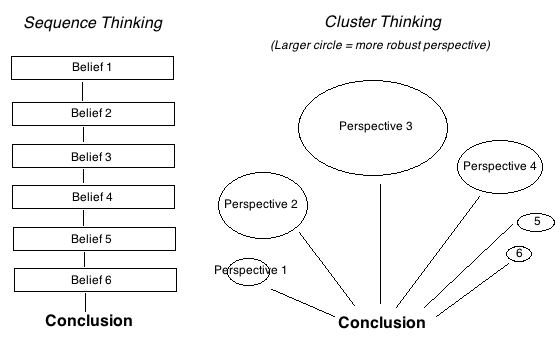 |
three minds | cluster | sequential | balance | |
Holden Karnofsky, American effective altruist, distinguished sequential thinking and cluster thinking.
• Sequence thinking involves making a decision based on a single model of the world: breaking down the decision into a set of key questions, taking one’s best guess on each question, and accepting the conclusion that is implied by the set of best guesses (an excellent example of this sort of thinking is Robin Hanson’s discussion of cryonics). It has the form: “A, and B, and C … and N; therefore X.” Sequence thinking has the advantage of making one’s assumptions and beliefs highly transparent, and as such it is often associated with finding ways to make counterintuitive comparisons.
• Cluster thinking – generally the more common kind of thinking – involves approaching a decision from multiple perspectives (which might also be called “mental models”), observing which decision would be implied by each perspective, and weighing the perspectives in order to arrive at a final decision. Cluster thinking has the form: “Perspective 1 implies X; perspective 2 implies not-X; perspective 3 implies X; … therefore, weighing these different perspectives and taking into account how much uncertainty I have about each, X.” Each perspective might represent a relatively crude or limited pattern-match (e.g., “This plan seems similar to other plans that have had bad results”), or a highly complex model; the different perspectives are combined by weighing their conclusions against each other, rather than by constructing a single unified model that tries to account for all available information.
The balance I try to strike. ... I believe sequence thinking is valuable for idea generation, reflection and discussion, while cluster thinking is best for making the final choice between options.
Holden. Sequence thinking vs. cluster thinking. #1265  |
2014 |
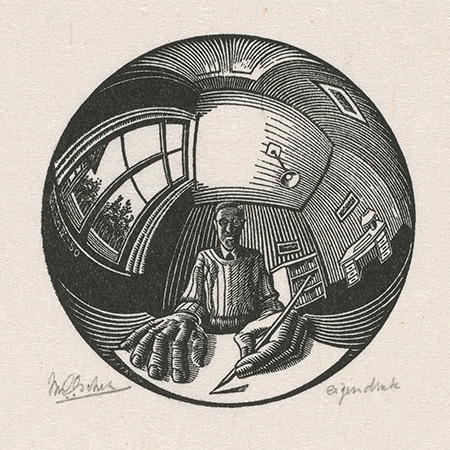 |
three minds | information | computation | interpretation | |
British polymath Robert Worden presented his thoughts on computation, meaning and consciousness at an Active Inference Institute live stream.
The physical events in a computer do not define what it computes. External information is required, to interpret those external events as a computation.
The brain is not only a computer. The brain could contain an Analogue Model of Reality.
A Model M is an analogue model of the physical situation P if:
M has the same topology as P
There is a point-to-point function from P to M: m=f(p)
f is a continuous function (a fibre bundle)
f preserves neighbourhoods of points, and spatial binding (e.g. borders)
The Information about P exists in M, with no encoding. M needs no encoding.
Robert Worden. Computers, Meaning and Consciousness. #1264  |
2025 |
 |
threesome | commit fully | copy a master | find your own voice | |
Philosophy expositor Jonny Thomson describes the Japanese aesthetic approach, geido, 芸道, as consisting of three steps to become a master of an art form.
• Commit fully.
• Copy a master.
• Find your own voice.
Jonny Thomson on Geido. #1260 ❤️MarcusPetz  |
2025 |
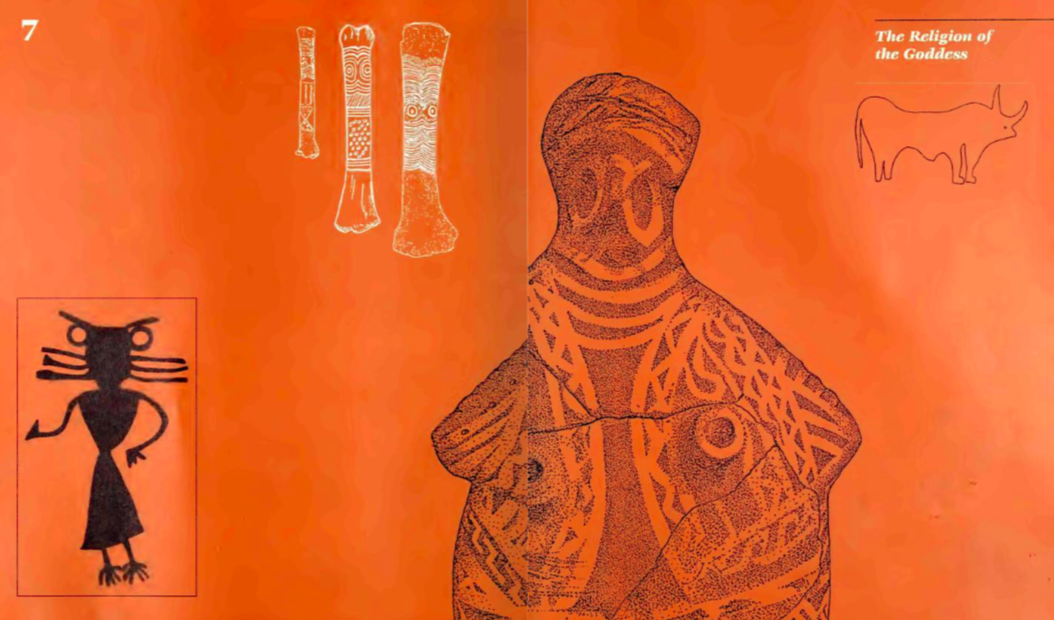 |
three minds | generative | destructive | regenerative | |
Lithuanian American archaeologist Marija Gimbutas argued, on the basis of iconography, that in pre-Indo European Old Europe, in the Neolithic and earlier periods, worship centered on a triple Goddess.
For the purpose of this study, these deities will be arranged in four main groups.
• First, the Goddess who personifies the generative forces of nature. To this category belong the various life propagating, birth-giving, life-maintaining, and life-stimulating aspects of the Goddess.
• Second, the Goddess who personifies the destructive forces of nature — the Death Goddess, rendered as a stiff nude, a poisonous snake, or bird of prey: vulture, owl, raven, or crow.
• Third, the Goddess of Regeneration; it is she who controls the life cycles of the entire natural world. Her manifestations are the various symbols of the uterus, pubic triangle, or fetus: toad, frog, hedgehog, bull head, triangle and double triangle. She also appears as an insect: bee, butterfly, moth. Death and regeneration are inseparably connected within the normal cycle of nature; therefore the Goddess of Death and Regeneration is depicted as one deity, in acknowledgment of the simultaneous function and cyclic continuum of these aspects.
• The fourth category focuses on the prehistoric male deities who make up only three to five percent of the corpus of Neolithic sculpture.
Marija Gimbutienė. The civilization of the Goddess.
Wikipedia: Triple Goddess (Neopaganism) #1248 ❤️Marcus Petz  |
1991 |
![]() |
threesome | cut up | reassemble | emerge | |
American beat poet William S. Burroughs and French poet Brion Gysin, in their book of collaborative fiction, The Third Mind, showcased the cut-up technique which Guisin discovered in 1957 and they popularized in the 1960s. The method consisted of three steps which they applied collaboratively.
1) Physically cutting up a written text into pieces.
2) Reassembling the pieces randomly, creating new combinations.
3) Grasping new meaning that emerges through juxtaposition.
Their theory suggests that when two people work together in harmony, they generate a third consciousness or mind that transcends their individual capabilities.
Perplexity AI. Burroughs & Gysin's Theory of the Third Mind between Two People
Wikipedia: Cut-up technique
Wikipedia: The Third Mind #1219 ❤️Daniel Friedman  |
1958 |
![]() |
foursome | | what is it? | how does it work? | why must it be? |
French cognitive scientist Avel Guénin-Carlut distinguished three kinds of scientific explanation.
• Nomological. What is it? Universal laws as described by Newtonian physics.
• Mechanical. How does it work? Contextual modelling as offered by the Hodgkin-Huxley model.
• Functional. Why must it be? Contextual modelling as yielded by the adaptive hypothesis.
Avel Guénin-Carlut. From Contextuality to Social Constraints: An Active Inference ontology for participatory realism and social change #1217 ❤️Daniel Friedman  |
2025 |
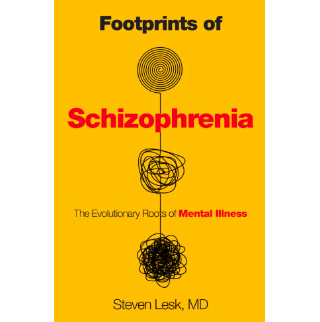 |
three minds | pre-language | language | | |
American psychiatrist Steven Lesk argues that schizophrenia and other mental illnesses are reversions to pre-linguistic lives, evolutionarily speaking, which take over when dopamine is no longer suppressed.
At this point, evolution's deputy, dopamine, could now be canned since we could engage in crystal-clear decision making of our own, and clarity of contemplation, a clear brain space, required dopamine's suppression.
Yes, all of that in our new operating system 2.0. What we see when dopamine un-suppresses is a return to OS 1.0. It's a loss of the ability to make a point, or apointilism, with linguistic deterioration and a tsunami of unwanted debris flooding the brain space, including hallucinations due to loss of the gating function and sensory deprivation.
So beyond a lack of words there is a lack of brain organization within. The ego organized our brains around language and vice versa, and the conductor of the symphony grand in doing so got a huge promotion. When the ego weakens (in concert with dopamine de-suppression), the whole framework of our mental apparatus melts, distorts, limps, and sputters, and the primitive organization gains strength again.
Steven Lesk. Footprints of Schizophrenia:
The Evolutionary Roots of Mental Illness #1216  |
2023 |
 |
three minds | heart | head | | |
American community organizer Richard Flyer engages his readers as he writes a manual for birthing a symbiotic culture.
Is it easier to teach someone primarily interested in building external structures and systems to come from their Heart, or is it easier for someone already coming from the Heart to learn how to make these Symbiotic systems?
So far, it’s been unanimous. Everyone I spoke with agrees that teaching this approach to someone already coming from the Heart with some grounding in the Transcendent is easier. That’s because they realize you can’t put new wine (Divine Love) into old wineskins (frameworks).
That’s why “the heart of the matter is the matter of the heart."
As I’ve seen, those already in the Heart are more prepared to build a Symbiotic Culture than those with a brilliant structure (from the mind) they want to impose. Heart-centered “weavers” are likelier to intuit a way forward and collaborate with reality than those who wish to mold reality to fit their concept. The latter is an “anti-life” approach; life is fluid and unpredictable, like those flowing waters.
Richard Flyer. Birthing the Symbiotic Age. The Heart-Centered Way of Symbiotic Culture. #1215 ❤️Marcus Petz  |
2025 |
![]() |
three minds | states | observables | expected values | |
American mathematical physicist John Baez remarked on the foundations of quantum mechanics.
A acts on its dual A*: given a∈A and a linear functional ⟨⋅⟩, we get a new linear functional ⟨a∘⋅⟩. This captures the idea, familiar in quantum theory, that observables are also ‘operators’: they act on states. And state-observable duality means we can get any state from the state of complete ignorance by acting on it with a suitable observable. After all, any state corresponds to some observable ρ, as follows:⟨a⟩=tr(ρ∘a). So, we can get this state by acting on the state of maximal ignorance, ⟨⋅⟩₀, by the observable tr(1)ρ
So, we see that the correspondence between states and special observables springs from two causes. First, there is a distinguished state, the state of maximal ignorance. Second, any other state can be obtained from the state of maximal ignorance by acting on it with a suitable observable.
John Baez. State-Observable Duality (Part 3).
John Baez. Division Algebras and Quantum Theory. #1182  |
2010 |
![]() |
three minds | identity | inversion | | |
Austrian theoretical physicist Adolf Smekal predicted and Indian physicists Chandrasekhara Venkata Raman and Kariamanikkam Srinivasa Krishnan experimentally discovered Raman scattering. A molecule has inversion symmetry when it has a center across which every atom has a pair on the opposite side. If modeled by a polyhedra, this is determined by it coordination number. A molecule with inversion symmetry has no dipole moment and can only interact via Raman scattering, where there is an exchange of energy. Whereas in Rayleigh scattering there can be reflection without exchange of energy.
Wikipedia: Point reflection
Raman scattering #1173  |
1923 |
 |
three minds | picturing | formulating | understanding | |
Michael Atiyah, whose contributions linked differential equations and algebraic topology and vector bundles, wanted to understand why formulas work.
People think mathematics begins when you write down a theorem followed by a proof. That’s not the beginning, that’s the end. For me the creative place in mathematics comes before you start to put things down on paper, before you try to write a formula. You picture various things, you turn them over in your mind. You are trying to create, just as a musician is trying to create music, or a poet. There are no rules laid down. You have to do it your own way. But at the end, just as a composer has to put it down on paper, you have to write things down. But the most important stage is understanding. A proof by itself doesn’t give you understanding. You can have a long proof and no idea at the end of why it works. But to understand why it works, you have to have a kind of gut reaction to the thing. You have got to feel it.
Siobhan Roberts. Michael Atiyah’s Imaginative State of Mind. #1172  |
2016 |
![]() |
three minds | identity | inversion | | |
French mathematician Élie Cartan classified Riemannian symmetric spaces. A connected Riemannian manifold M is a symmetric space if its geodesic symmetries can be extended to isometries on all of M. At any point p in M there exists an isometry by which the points x on one geodesic are mapped to the points -x, thus inverting the geodesic. A circle is a symmetric space for a circle can be reflected around any point.
Wikipedia: Symmetric space #1169  |
1926 |
 |
three minds | inspiration | rigour | | |
British-Lebanese geometer Michael Atiyah wrote one poem, Dreams.
In the broad light of day mathematicians check their equations and their proofs, leaving no stone unturned in their search for rigour. But, at night, under the full moon, they dream, they float among the stars and wonder at the miracle of the heavens. They are inspired. Without dreams there is no art, no mathematics, no life.
Sir Michael Atiyah. From Algebraic Geometry to Physics - a Personal Perspective
Alain Connes, Joseph Kouneiher. Sir Michael Atiyah, a Knight Mathematician. A tribute to Michael Atiyah, an inspiration and a friend. #1168  |
2008 |
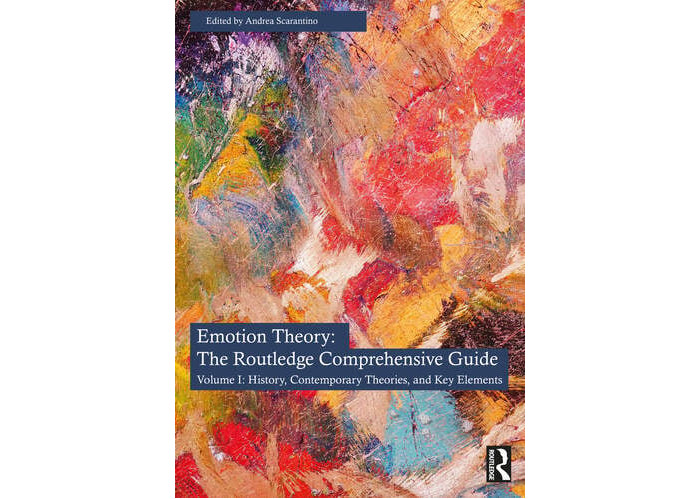 |
three minds | irrational | rational | | |
American philosopher Andrea Scarantino, as editor of Emotion Theory: The Routledge Comprehensive Guide, written by 101 contributors, overviewed the progress being made in psychology and philosophy.
We're also converging on the idea that there is no structural opposition between reason and passion. The Platonic idea of the charioteer of reasons and the horses of the passions in the Phaedrus is not helpful at this point. I think most people understand that emotions can be profoundly rational and can be profoundly irrational. So it's not the type that you need to worry about, it's the token, the instance, the circumstances, the ways in which you have the various emotions that tell you if its rational or irrational.
Carrie Figdor podcast 40:00 about Andrea Scarantino. Emotion Theory: The Routledge Comprehensive Guide. Volume I and Volume II #1165  |
2025 |
 |
three minds | confusion | harmony | cultivation | |
American gardener Alexandra Baez championed the formal garden as reflecting a well ordered mind.
And so I mused upon the human mind:
Its own mild garths and cool Augustan plots
Were laid for promenades—sedate, refined—
A genteel garden park, it seems, of thoughts.
Or so it might appear—yet gather close,
O marveling guest, round something slantwise spied:
An errant feature free of plan or pose—
A rankling thing you’d wish you hadn’t eyed!
Here, stark, the prankster stands—perhaps a spire
Of malice rising prideful in the air;
Perhaps a wild confusion of desire;
Perhaps a raw delusion, none too rare. [...]
Observe: my own best traits were raised by force
In soil hauled in from some more fertile strand.
My consciousness, when nature takes its course,
Still bristles, as if tended by no hand.
John Baez. The Formal Gardens, and Beyond.
#1139  |
2024 |
 |
three minds | | | intoxication | |
Primatologist Kimberley Hockings and her colleagues reported on wild chimpanzees pilfering and ingesting raffia palm sap containing large amounts of ethanol.
African apes and humans share a genetic mutation that enables them to effectively metabolize ethanol. ... However, Milton argued based on questionnaires on primate feeding behaviour directed at field primatologists that primates are not attracted to, and rarely eat, over-ripe fruit (which contain higher levels of ethanol than unripe or ripe fruit), and so intoxication in the wild is almost non-existent. ... ethanol consumption occurs in every modern human society that has access to fermentable raw materials.
The mutation increased the metabolization rate by 40-fold.
Kimberley J Hockings et al. Tools to tipple: ethanol ingestion by wild chimpanzees using leaf-sponges. #1134  |
-10000000 |
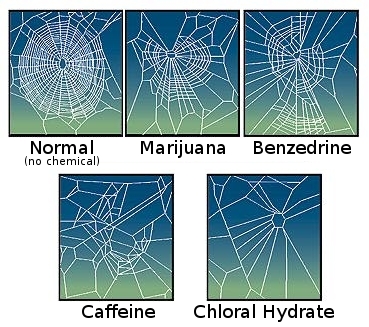 |
three minds | thread | web | | |
Swiss pharmacologist Peter N. Witt, in 1948, researched the effect of drugs on spiders.
Witt tested spiders with a range of psychoactive drugs, including amphetamine, mescaline, strychnine, LSD, and caffeine, and found that the drugs affect the size and shape of the web rather than the time when it is built. At small doses of caffeine (10 μg/spider), the webs were smaller; the radii were uneven, but the regularity of the circles was unaffected. At higher doses (100 μg/spider), the shape changed more, and the web design became irregular. All the drugs tested reduced web regularity except for small doses (0.1–0.3 μg) of LSD, which increased web regularity
Wikipedia: Effect of psychoactive drugs on animals #1133  |
-200000000 |
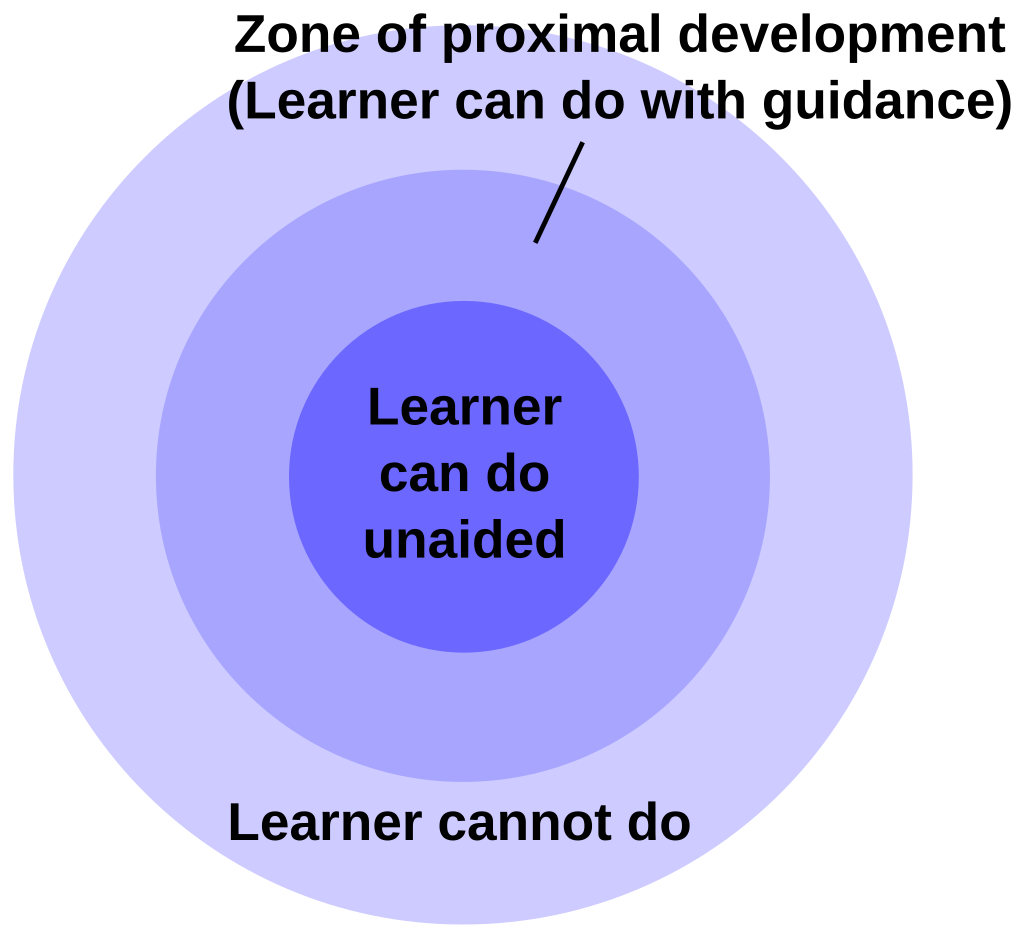 |
three minds | known | not known | teachable | |
Litvak Soviet developmental psychologist Lev Vygotsky introduced the zone of proximal development (ZPD), which educators Anne West, Janet Swanson, Lindsay Liscomb described as follows.
ZPD can also be described as the area between what a learner can do by himself and that which can be attained with the help of a ‘more knowledgeable other’ adult or peer. The ‘more knowledgeable other’, or MKO, shares knowledge with the student to bridge the gap between what is known and what is not known. Once the student has expanded his knowledge, the actual developmental level has been expanded and the ZPD has shifted. The ZPD is always changing as the student expands and gains knowledge, so scaffolded instruction must constantly be individualized to address the changing ZPD of each student.
Anne West, Janet Swanson, Lindsay Lipscomb. Scaffolding.
Wikipedia: Zone of proximal development
Wikipedia: Instructional scaffolding #1127 ❤️Marcus Petz  |
1931 |
 |
three minds | Go | No-go | 12 options | |
American visionary thinker Buckminster Fuller developed his metaphysical thinking, Synergetics, on a scaffolding of three-dimensional geometry.
537.52 It is clear to me that most humans tend to think in a linear, Go-or No-go, greenlight-redlight manner. To me, will is an optionally exercisable control by mind over brain - by wisdom over conditioned reflex - that becomes realizable
when mind is adequately convinced regarding which of the 12 alternatives will produce the most comprehensively considerate vital advantage for all.
537.53 In a lesser way will becomes operative when the individual finds himself in terminal peril and has only seconds to "pull out" of a tailspin, when he becomes "cool," that is, when he discovers swiftly which of the alternative moves can save him, and exercises his will to execute the survival procedures.
537.54 Will determines what we should do in all the special case circumstances. Will is not a muscle thing__not the clenched fist__at all. People say I have a strong will, but what I have is a fairly clear view of the options of humanity and the
commitments to their realization. It is thus that I determine what course to take in the special cases confronting us.
R. Buckminster Fuller. Synergetics: Explorations in the Geometry of Thinking. #1122  |
1979 |
 |
three minds | fiber | base space | total space | |
Algebraic topologists Herbert Seifert, Heinz Hopf, Jacques Feldbau, Whitney, Norman Steenrod, Charles Ehresmann, Jean-Pierre Serre and others developed the theory of fibered spaces. A total space (such as a cylinder) is understood as a collection of fibers (in this case, line segments) organized by a base space (a disc). Locally, the total space appears to be simply the product of the fibers and the base space (close up, the surface of the cylinder is flat). However, globally, the fibers may twist around in nontrivial ways that, yielding sophisticated structures which are not simply products. The line segments can be twisted uniformally to yield not a cylinder but rather a Mobius strip. The cylinder has two distinct sides (inside and outside) but the Mobius strip does not (it is not orientable).
Wikipedia: Fiber bundle. #1114  |
1935 |
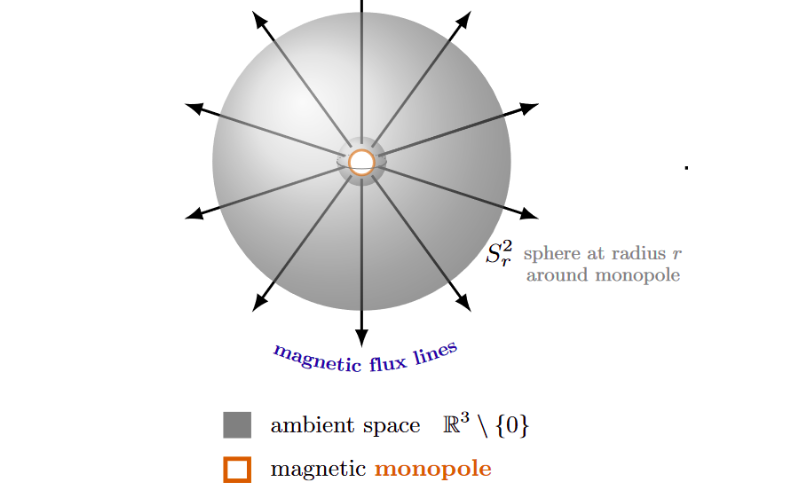 |
three minds | photons | monopole | field | |
Polish mathematical physicist Andrzej Trautman identified the Dirac monopole with the Hopf fibration, shocking both physicists and mathematicians.
John L. Friedman. Historical note on fiber bundles.
Andrzej Trautman. Solutions of the Maxwell and Yang-Mills equations associated with hopf fibrings.
#1111  |
1977 |
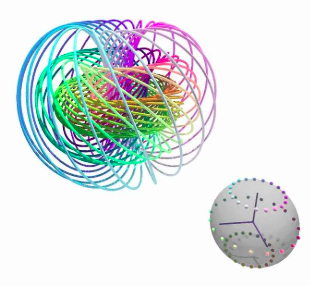 |
three minds | circle | sphere | hypersphere | |
German mathematician Heinz Hopf discovered the Hopf fibration S1↪S3↪S2 decomposing a hypersphere in four-dimensional space as a set of disjoint great circles such that each circle corresponds to a point on an ordinary sphere. Locally, S3 looks like the product of S2 and S1, however, globally it is not, which is to say, the Hopf fibration is a nontrivial fiber bundle.
Wikipedia: Hopf fibration
Hopf Fibration Explained Better than Eric Weinstein on Joe Rogan
Slicing bagels to learn gauge theory (Hopf fibration)
Niles Johnson. Hopf fibration -- fibers and base. (Animation) #1105  |
1931 |
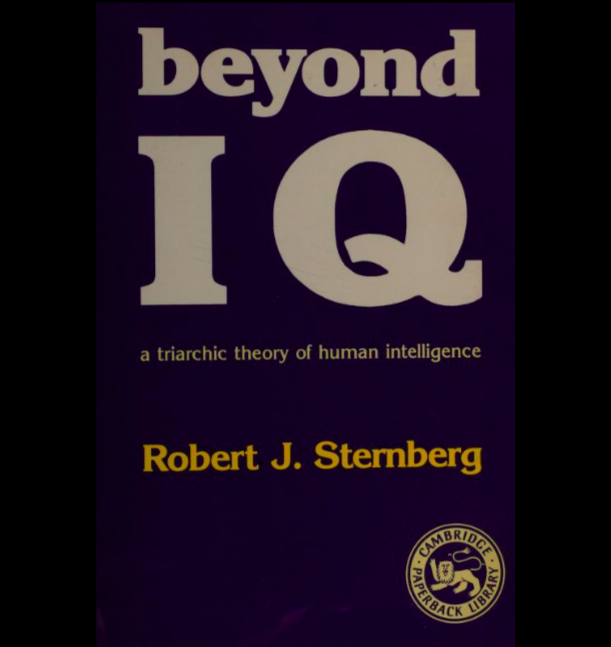 |
three minds | creative | analytical | contextual | |
American psychologist Robert Sternberg advanced a triarchic theory of intelligence. Intelligence is a "mental activity directed toward purposive adaptation to, selection and shaping of, real-world environments relevant to one's life". The mind has three kinds of intelligence.
• The componential – analytical subtheory focuses on the ability to take apart well-defined problems and find a unique solution.
• The experiential – creative subtheory focuses on the ability to reliably implement a standard procedure and then apply it flexibly, innovatively in new circumstances.
• The practical - contextual subtheory focuses on the ability of an individual to fit to their context, understanding the needs of their particular setting and adapting, selecting, shaping accordingly.
Wikipedia: Triarchic theory of intelligence
Wikipedia: Robert Sternberg
Sternberg, R. J. Beyond IQ: A Triarchic Theory of Intelligence #1100  |
1985 |
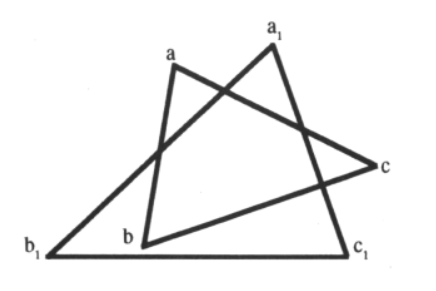 |
three minds | pictures | words | animations | |
Austrian free thinker Rudolf Steiner, founder of anthroposophy, lectured on contemplating the world from different standpoints.
• What did human souls experience previously? They experienced pictures; all their experience of the external world took the form of pictures. I have often spoken of this from certain points of view. This picture-experience is the last phase of the old clairvoyant experience.
• The development of thought leads to a stage of doubting the existence of what are called “universals”, general concepts, and thus to so-called Nominalism, the view that universals can be no more than “names”, nothing but words. ... The collective or general triangle must contain everything that a triangle can contain. But a triangle that is acute-angled cannot be at the same time right-angled and obtuse-angled. Hence there cannot be a collective triangle. ... There are only separate things; and beyond the separate things—so says the Nominalist—we have nothing but words that comprise the separate things.
• I will not only draw a triangle and let it stay as it is, but I will make certain demands on your imagination. You must think to yourself that the sides of the triangle are in continual motion. When they are in motion, then out of the form of the movements there can arise simultaneously a right-angled, or an obtuse-angled triangle, or any other. ... If we are to rise from the specific thought to the general thought, we have to bring the specific thought into motion; thus thought in movement becomes the “general thought” by passing constantly from one form into another.
Rudolf Steiner. Human and Cosmic Thought. Lecture I. #1097 ❤️Hans-Florian Hoyer  |
1914 |
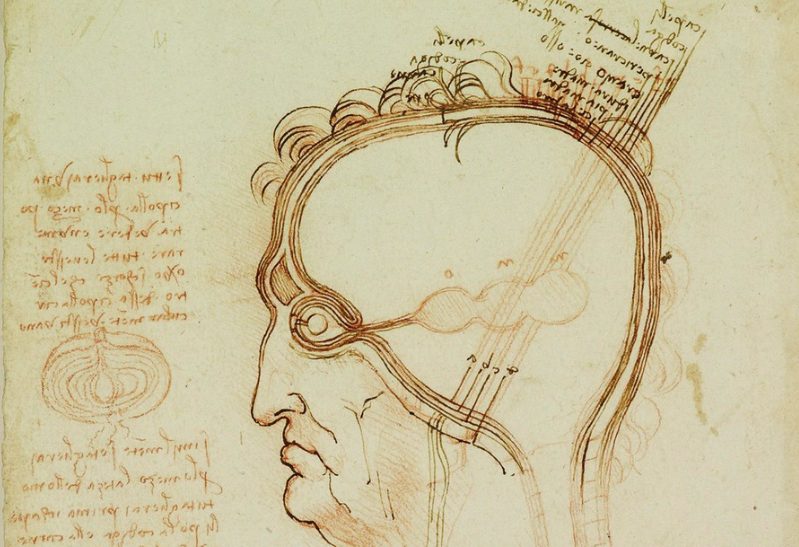 |
three minds | heart | brain | | |
Italian genius Leonardo da Vinci wrote in his notebook
Tears come from the heart not from the brain.
Leonardo Da Vinci S Note-Books Arranged And Rendered Into English #1095  |
1498 |
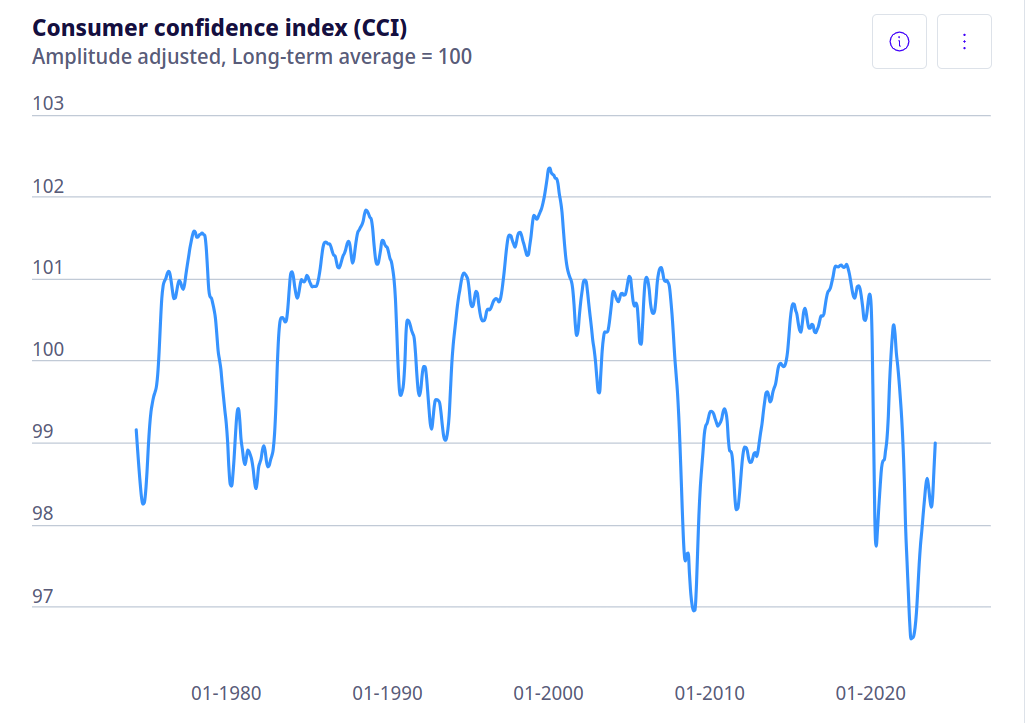 |
three minds | spontaneous urge to action | expected value of benefits | atmosphere | |
English economist John Maynard Keynes described consumer confidence in terms of "animal spirits", an expression used, in their own ways, by Traheron, Descartes, Newton, Wood, Marx, Defoe, Austen, Disraeli, Wodehouse and Doyle.
Even apart from the instability due to speculation, there is the instability due to the characteristic of human nature that a large proportion of our positive activities depend on spontaneous optimism rather than on a mathematical expectation, whether moral or hedonistic or economic. Most, probably, of our decisions to do something positive, the full consequences of which will be drawn out over many days to come, can only be taken as a result of animal spirits – of a spontaneous urge to action rather than inaction, and not as the outcome of a weighted average of quantitative benefits multiplied by quantitative probabilities.
This means, unfortunately, not only that slumps and depressions are exaggerated in degree, but that economic prosperity is excessively dependent on a political and social atmosphere which is congenial to the average business man. If the fear of a Labour Government or a New Deal depresses enterprise, this need not be the result either of a reasonable calculation or of a plot with political intent; - it is the mere consequence of upsetting the delicate balance of spontaneous optimism.
Wikipedia: Animal spirits (Keynes)
John Maynard Keynes. The General Theory of Employment, Interest and Money. #1094 ❤️Marcus Petz  |
1936 |
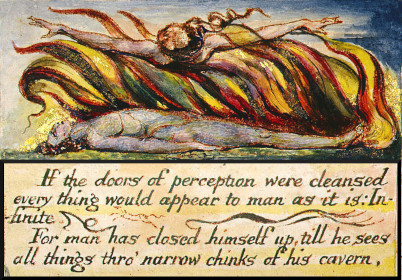 |
three minds | known | unknown | doors | |
American rock Ray Manzarek, co-founder of the Doors, explained to Newsweek the origin of the band's name.
“There are things you know about,” says 25-year-old Manzarek, whose specialty is playing the organ with one hand and the bass piano with the other, “and things you don’t, the known and the unknown, and in between are the doors–that’s us. We’re saying that you’re not only spirit, you’re also this very sensuous being. That’s not evil, that’s a really beautiful thing. Hell appears so much more fascinating and bizarre than heaven. You have to ‘break on through to the other side’ to become the whole being.”
The band's name is often understood to reference the title of Aldous Huxley's book about taking psychedelics, "The Doors of Perception", which itself is based on a phrase of William Blake.
Quote Origin: There Are Things Known, and Things Unknown, and In Between Are the Doors
#1093  |
1967 |
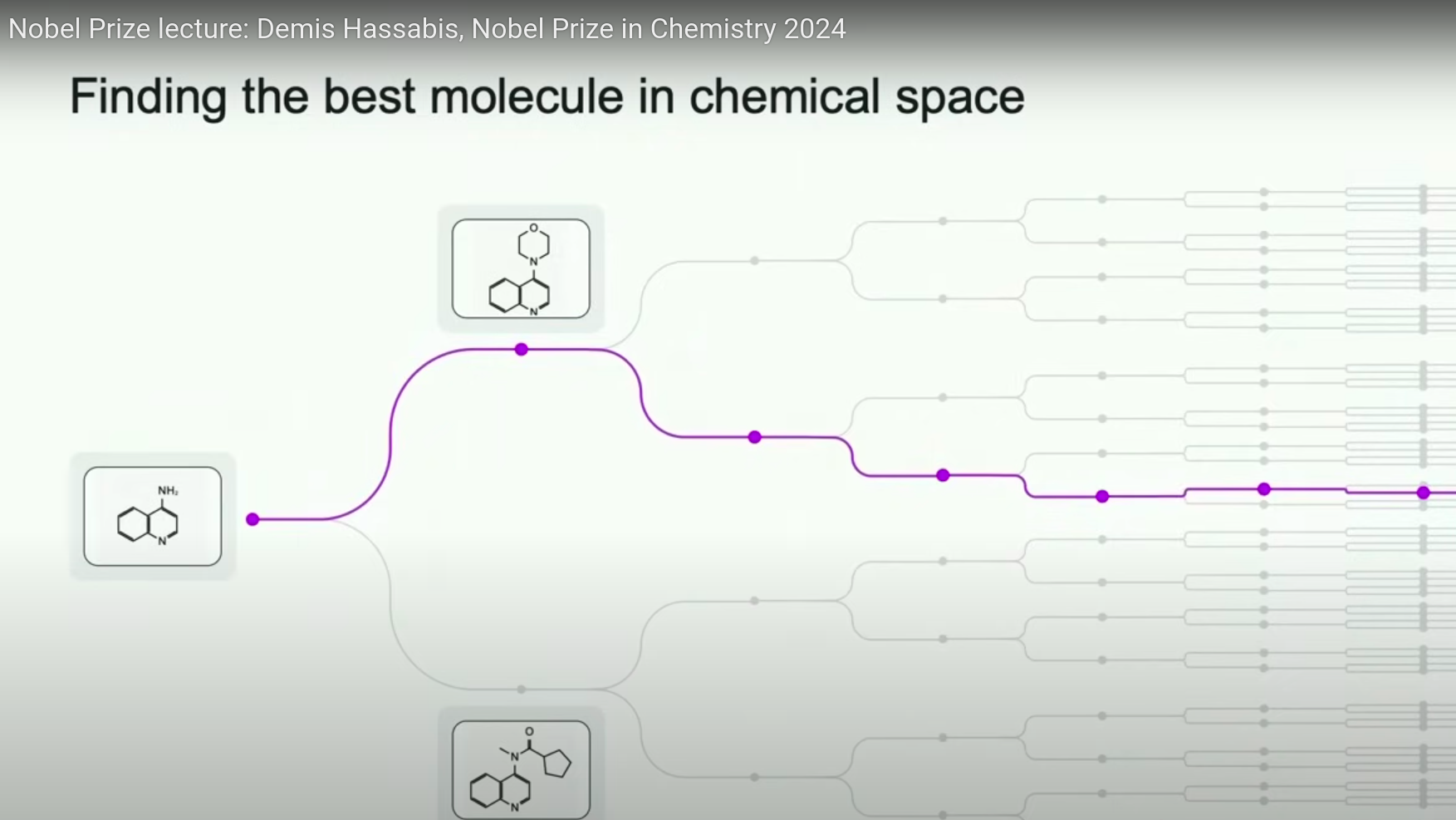 |
three minds | model | search | guide | |
British artificial intelligence researcher Demis Hassabis, CEO of Google DeepMind, won a Noble Prize for Chemistry, along with John M.Jumper, for applying AI to protein structure prediction.
So we take a step back and look at the essence of what our systems have been doing, both Alpha Go, Alpha Fold and some of the other systems that we have built. And really, we can describe them as finding the optimal solution in this enormous combinatorial search space. And we do that by learning a model of that environment, either from data or from simulation, and then using that model to guide a search process according to some kind of objective function that you are trying to optimize. And it turns out that this is a very general solution and that many problems can fit this approach.
Nobel Prize lecture: Demis Hassabis, Nobel Prize in Chemistry 2024 #1086  |
2024 |
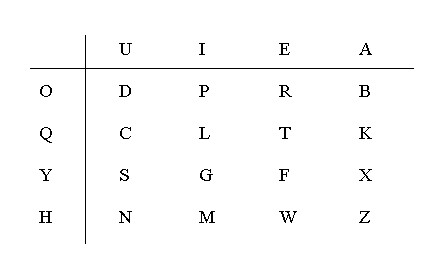 |
three minds | direct experience | language | hypothetical universal language | |
American ecotechnology pioneer Jere Northrop proposed the Relational Symmetry Paradigm to expand the existing scientific paradigm’s fundamental
foundations by including consciousness, language, and creativity.
Begin with what we know best, and where we have the most direct experience, how you and I interact with each other through language. Where do we agree with each other. How can we abstract this into a symbolic structure that can be used to extend and evolve our existing natural and created languages to approach a Hypothetical Universal Language, a language that is symmetrically consistent and useful in terms of understanding electrons, galaxies, and each other.
The Relational Symmetry Paradigm #1083  |
2023 |
![]() |
threesome | hypothesis | statistical model and calculation | economic sense | |
The International Monetary Fund explains the methodology of econometrics as follows.
The first step is to suggest a theory or hypothesis to explain the data being examined. The explanatory variables in the model are specified, and the sign and/or magnitude of the relationship between each explanatory variable and the dependent variable are clearly stated. At this stage of the analysis, applied econometricians rely heavily on economic theory to formulate the hypothesis
The second step is the specification of a statistical model that captures the essence of the theory the economist is testing. The model proposes a specific mathematical relationship between the dependent variable and the explanatory variables—on which, unfortunately, economic theory is usually silent. By far the most common approach is to assume linearity—meaning that any change in an explanatory variable will always produce the same change in the dependent variable (that is, a straight-line relationship).
The third step involves using an appropriate statistical procedure and an econometric software package to estimate the unknown parameters (coefficients) of the model using economic data. This is often the easiest part of the analysis thanks to readily available economic data and excellent econometric software. Still, the famous GIGO (garbage in, garbage out) principle of computing also applies to econometrics.
The fourth step is by far the most important: administering the smell test. Does the estimated model make economic sense—that is, yield meaningful economic predictions?
&ęmsp;If the estimated parameters do not make sense, how should the econometrician change the statistical model to yield sensible estimates?
Sam Ouliaris. What Is Econometrics? #1080 ❤️MP  |
2011 |
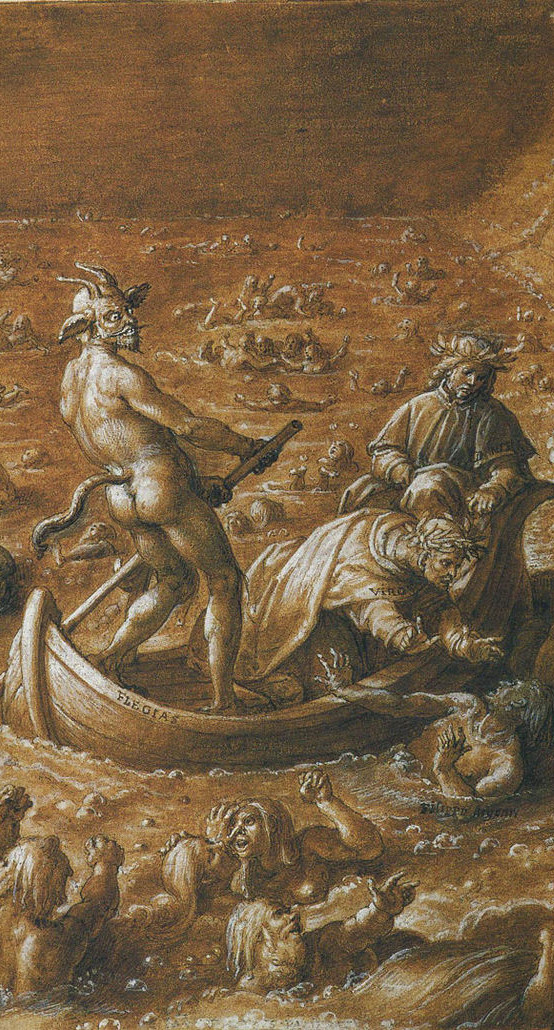 |
three minds | image | meaning | allegory | |
American English poet T.S.Eliot wrote a book about how he personally drew from Italian poet Dante Alighieri, a forerunner of the Renaissance.
I do not recommend, in first reading the first canto of the Inferno, worrying about the identity of the Leopard, the Lion, or the She-Wolf. It is really better, at the start, not to know or care what they do mean. What we should consider is not so much the meaning of the images, but the reverse process, that which led a man having an idea to express it in images. We have to consider the type of mind which by nature and practice tended to express itself in allegory: and for a competent poet, allegory means clear visual images. And clear visual images are given much more intensity by having a meaning—we do not need to know what that meaning is, but in our awareness of the image we must be aware that the meaning is there too. Allegory is only one poetic method, but it is a method which has very great advantages.
Dante’s is a visual imagination. It is a visual imagination in a different sense from that of a modern painter of still life: it is visual in the sense that he lived in an age in which men still saw visions. It was a psychological habit, the trick of which we have forgotten, but as good as any of our own. We have nothing but dreams, and we have forgotten that seeing visions—a practice now relegated to the aberrant and uneducated—was once a more significant, interesting, and disciplined kind of dreaming. We take it for granted that our dreams spring from below: possibly the quality of our dreams suffers in consequence.
All that I ask of the reader, at this point, is to clear his mind, if he can, of every prejudice against allegory, and to admit at least that it was not a device to enable the uninspired to write verses, but really a mental habit, which when raised to the point of genius can make a great poet as well as a great mystic or saint. And it is the allegory which makes it possible for the reader who is not even a good Italian scholar to enjoy Dante. Speech varies, but our eyes are all the same. And allegory was not a local Italian custom, but a universal European method.
T.S.Eliot. Dante. #1077  |
1929 |
![]() |
three minds | soul | mind | | |
French academic Anselme Polycarpe Batbie wrote in a public letter:
Several of my friends urged me to respond with Burke’s famous line:
“Anyone who is not a republican at twenty casts doubt on the generosity of his soul; but he who, after thirty years, perseveres, casts doubt on the soundness of his mind.”
Quote Origin: If You Are Not a Liberal at 25, You Have No Heart. If You Are Not a Conservative at 35 You Have No Brain #1065  |
1872 |
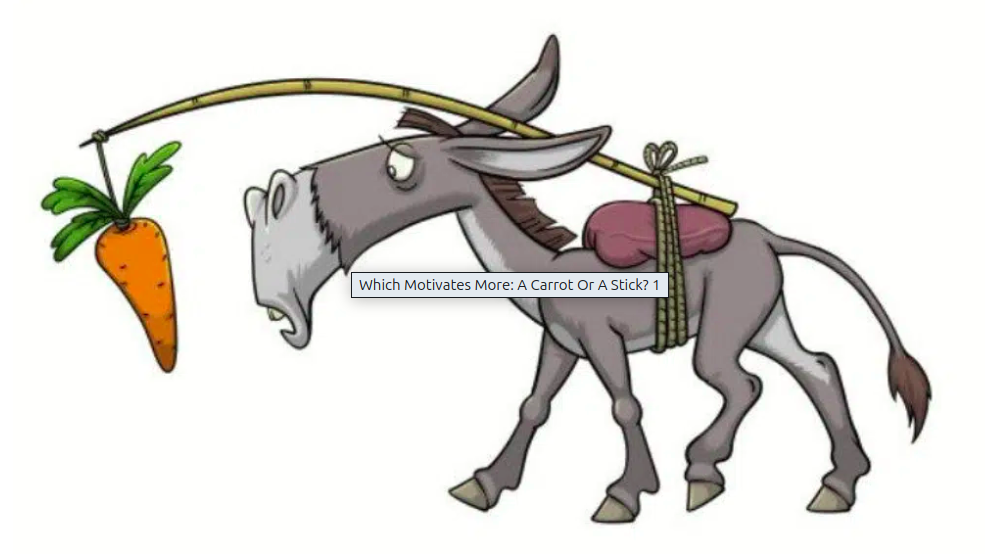 |
three minds | persuasion | force | competition | |
American traveler Edward P. Montague recounted:
I remember to have seen a caricature of a "donkey race", to illustrate the idea that persuasion is better than force: the riders brought their donkeys up to the stand, one having a bunch of famous carrots tied at the end of a stick, the other having a few strong blackthorn twigs. The race commences; the blackthorn twigs were brought into "abusive use", but the donkey wouldn't mend his pace: while the other was galloping along after the bunch of carrots, which were suspended "ahead of him," a little beyond his reach.
Edward P. Montague. Narrative of the Late Expedition to the Dead Sea: From a Diary by One of the Party.
Wikipedia: Carrot and stick #1040  |
1849 |
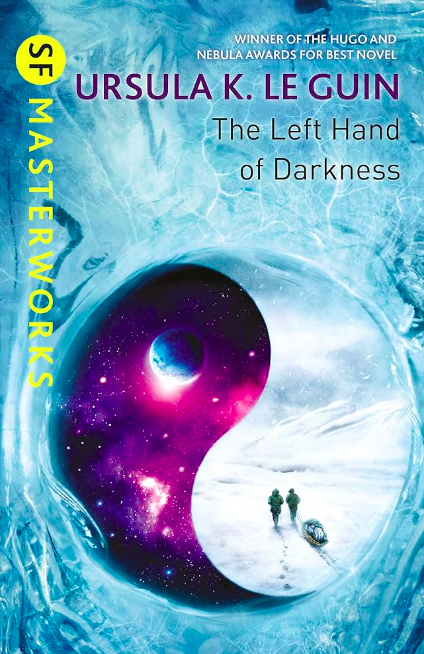 |
three minds | obtuseness | frankness | accommodation | |
American author Ursula K. Le Guin described how a human emissary had to make sense of the culture of another planet.
During the pause I began to think that an
inept and undefended alien should not demand reasons from the prime minister of a kingdom,
above all when he does not and perhaps never will understand the foundations of power and the
workings of government in that kingdom. No doubt this was all a matter of shifgrethor — prestige, face, place, the pride-relationship, the untranslatable and all-important principle of social authority in Karhide and all civilizations of Gethen.
I saw at last that I was missing another signal. Damning his effeminate deviousness, I said, "Are you trying to tell me, Lord Estraven, that you're out of favor with the king?"
I think he was angry then, but he said nothing that showed it, only, "I'm not trying to tell you anything, Mr. Ai."
Later, when they struggled together, as runaways crossing a snow field, the human reflected.
I was galled by his patronizing. He was a head shorter than I, and built more like a woman than a man, more fat than muscle; when we hauled together I had to shorten my pace to his, hold in my strength so as not to out-pull him: a stallion in harness with a mule-
He had not meant to patronize. He had thought me sick, and sick men take orders. He was frank, and expected a reciprocal frankness that I might not be able to supply. He, after all, had no standards of manliness, of virility, to complicate his pride.
On the other hand, if he could lower all his standards of shifgrethor, as I realized he had done with me, perhaps I could dispense with the more competitive elements of my masculine self-respect, which he certainly understood as little as I understood shifgrethor...
Wikipedia: The Left Hand of Darkness #1034  |
1969 |
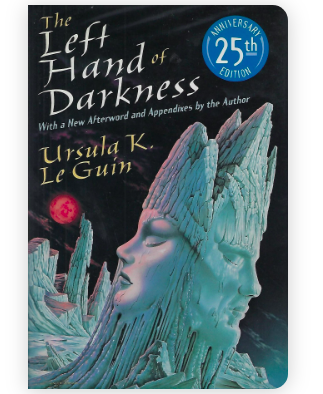 |
three minds | submissive | dominant | | |
American author Ursula K. Le Guin speculates about a world where individuals are all sexually the same, experiencing sexual attraction only once a month, at which time they randomly manifest male or female characteristics.
Consider: There is no division of humanity into strong and weak halves, protective/protected,
dominant/submissive, owner/chattel, active/passive. In fact the whole tendency to dualism that
pervades human thinking may be found to be lessened, or changed, on Winter.
Another guess concerning the hypothetical experiment's object: The elimination of war. Did
the Ancient Hainish postulate that continuous sexual capacity and organized social aggression,
neither of which are attributes of any mammal but man, are cause and effect? Or, like Tumass
Song Angot, did they consider war to be a purely masculine displacement-activity, a vast Rape,
and therefore in their experiment eliminate the masculinity that rapes and the femininity that is
raped?
The weather of Winter is so relentless, so
near the limit of tolerability even to them with all their cold-adaptations, that perhaps they use
up their fighting spirit fighting the cold. The marginal peoples, the races that just get by, are
rarely the warriors. And in the end, the dominant factor in Gethenian life is not sex or any other
human thing: it is their environment, their cold world. Here man has a crueler enemy even than
himself.
Wikipedia: The Left Hand of Darkness #1033  |
1969 |
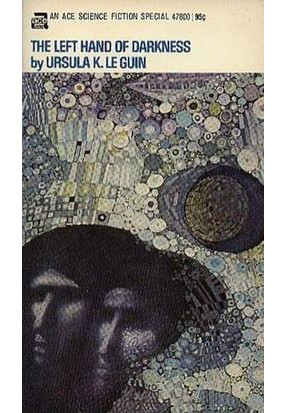 |
three minds | luck | preparation | intuition | |
American science fiction author Ursula K. Le Guin described the politician Estraven, on who her hero depended.
I never knew a person who reacted so wholly and rapidly to a changed situation as Estraven. ... He was never rash or hurried, but he was always ready.
Yet he considered himself a slow man, poor in emergencies.
Once he told me that, being so slow-thinking, he had to guide his acts by a general intuition of which way his "luck" was running, and that this intuition rarely failed him. He said it seriously; it may have been true. The Foretellers of the Fastnesses are not the only people on Winter who can see ahead. They have tamed and trained the hunch, but not increased its certainty. In this matter the Yomeshta also have a point: the gift is perhaps not strictly or simply one of foretelling, but is rather the power of seeing (if only for a flash) everything at once: seeing whole.
Wikipedia: The Left Hand of Darkness #1032  |
1969 |
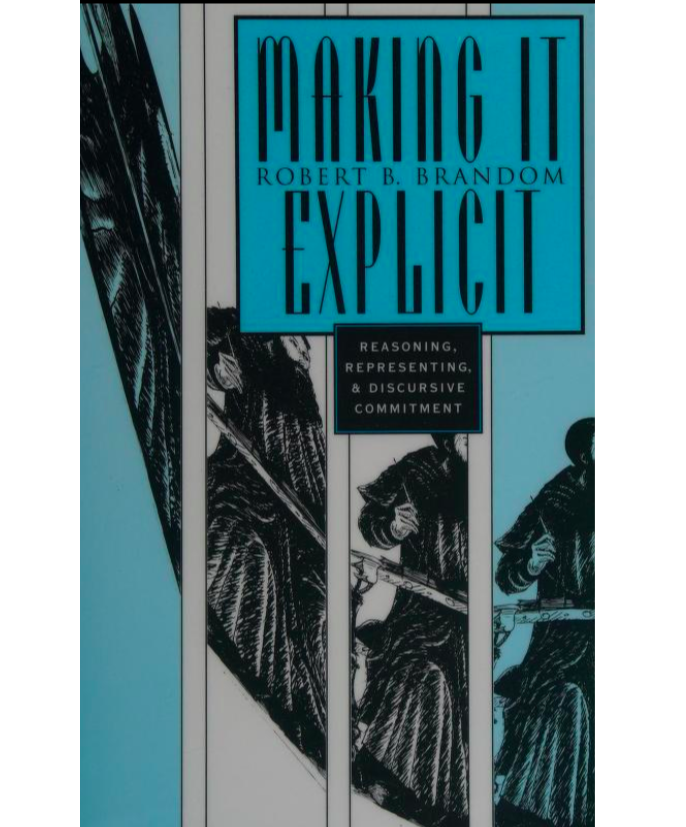 |
three minds | implicit | explicit | | |
American philosopher Robert Brandom advocated that the meaning of an expression is determined by how it is used in inferences.
Making It Explicit is an investigation into the nature of language--the social practices that distinguish us as rational, logical creatures--that revises the very terms of this inquiry. Where accounts of the relation between language and mind have traditionally rested on the concept of representation, this book sets out an alternate approach based on inference, and on a conception of certain kinds of implicit assessment that become explicit in language. Making It Explicit is the first attempt to work out in detail a theory that renders linguistic meaning in terms of use--in short, to explain how semantic content can be conferred on expressions and attitudes that are suitably caught up in social practices.
At the center of this enterprise is a notion of discursive commitment. Being able to talk--and so in the fullest sense being able to think--is a matter of mastering the practices that govern such commitments, being able to keep track of one’s own commitments and those of others. Assessing the pragmatic significance of speech acts is a matter of explaining the explicit in terms of the implicit. As he traces the inferential structure of the social practices within which things can be made conceptually explicit, the author defines the distinctively expressive role of logical vocabulary. This expressive account of language, mind, and logic is, finally, an account of who we are.
Robert Brandom. Making It Explicit: Reasoning, Representing, and Discursive Commitment. (Abstract)
Wikipedia: Inferential role semantics
#1029  |
1994 |
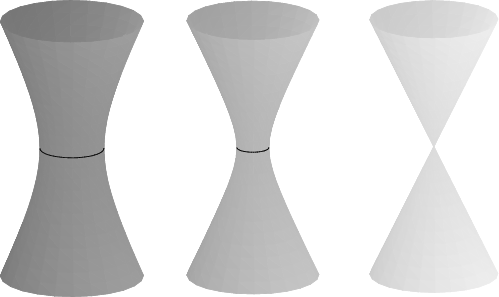 |
three minds | magnitude | number | geometry | |
French mathematician Alexander Grothendieck, reflecting on his life work and its unifying vision.
• One might say that "Number" is what is appropriate for grasping the structure of "discontinuous" or "discrete" aggregates. These systems, often finite, are formed from "elements", or "objects" conceived of as isolated with respect to one another.
• "Magnitude" on the other hand is the quality, above all, susceptible to "continuous variation", and is most appropriate for grasping continous structures and phenomena: motion, space, varieties in all their forms, force fields, etc. Thereby , Arithmetic appears to be ( overall) the science of discrete structures while Analysis is the science of continuous structures.
• As for Geometry, one can say that in the two thousand years in which it has existed as a science in the modern sense of the word, it has "straddled" these two kinds of structure, "discrete" and "continuous".
For some time in fact one can say that the two geometries considered to be distinct species, the discrete and the continuous, weren't really "divorced". They were rather two different ways of investigating the same class of geometric objects: one of them accentuated the "discrete" properties ( notably computational and combinatorial) while the other concerned itself with the "continuous" properties ( such as location in an ambient space, or the measurement of "magnitude" in terms of the distances between points, etc.)
It was at the end of the last century that a divorce became immanent, with the arrival and development of what came to be called" Abstract (Algebraic) Geometry". Roughly speaking, this consisted of introducing, for every prime number p, an algebraic geometry "of characteristic p", founded on the model (continous) of the Geometry ( algebraic) inherited from previous centuries, however in a context which appeared to be resolutely "discontinuous", or "discrete".
Alexander Grothendieck. The New Geometry: or the Marriage of Number and Magnitude. #1027  |
1986 |
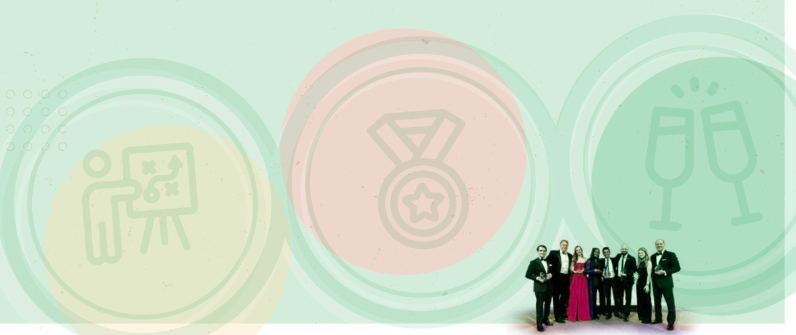 |
threesome | coach | compete | celebrate | |
Atlas Network has three departments that execute their Coach, Compete, Celebrate!™ model by which they cultivate a global network of think tank leaders advancing a shared vision of a free, prosperous, and peaceful world where the principles of individual liberty, property rights, limited government, and free markets are secured by the rule of law.
• The Coach Department trains leaders and provides consulting services.
• The Compete Department awards grants on a competitive basis.
• The Celebrate Department runs events that foster camaraderie and collaboration and provide visibility and validation.Steven Green. Coach, Compete, Celebrate!™
Atlas Network. Our Model: It’s time to change the way we view development. #1024  |
2022 |
 |
threesome | documentation requirement | action taken | documentation fulfillment | |
Amanda Andrews and Bernie St Aubyn, Senior Lecturers in Nursing at Birmingham City University in the UK, discuss the medical and legal significance of documentation as dictated by the Nursing and Midwifery Council Code of Conduct.
Amanda Andrews, Bernie St Aubyn. If it’s not written down; it didn’t happen... #1023  |
2015 |
 |
threesome | plan | do | stop - think - observe | |
Hunters are taught the acronym S.T.O.P. for dealing with an emergency so that they don't make a bad situation worse.
S: Stop and sit down. Keep a positive mental attitude.
&ęmsp;T: Think about your surroundings. Could you find your way out, or are you going to spend the night?
O: Observe what is around you. Can you hear vehicles? Can you hear farm animals or farm machinery? Can you see radio towers or logging roads? Use your senses to find out where you are, and always refer to your hunting maps.
P: Plan what you do. The time of day and the weather will influence how the plan will be set in motion and what you will do first.
hunter-ed. S.T.O.P.: stop, think, observe, plan #1011  |
2023 |
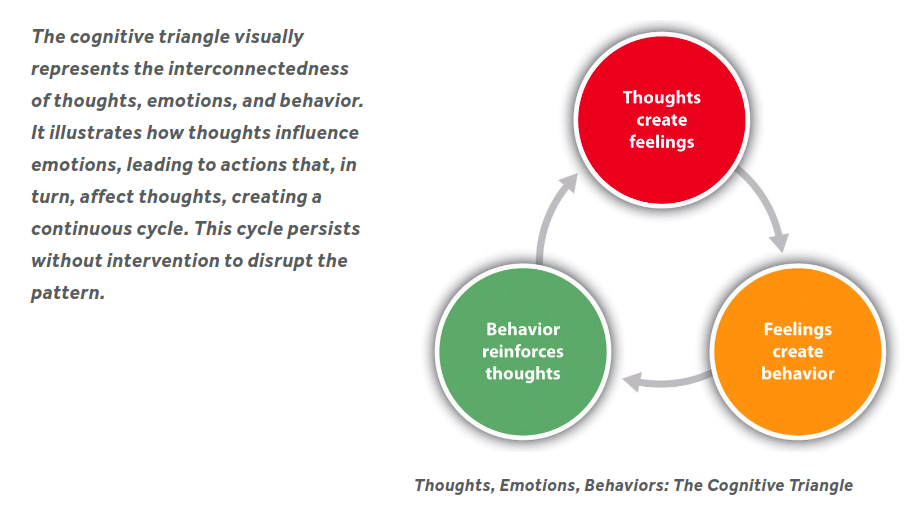 |
threesome | feelings | behaviors | thoughts | |
Californian Cognitive behaviorial therapists Albert Bonfil and Suraji Wagage describe a basic model of emotional experience in terms of thoughts, feelings, and behaviors:
• Thoughts refer to the ways that we make sense of situations. Thoughts can take a number of forms, including verbal forms such as words, sentences, and explicit ideas, as well as non-verbal forms such as mental images. Thoughts are the running commentary we hear in our minds throughout our lives.
• The term feelings here doesn’t refer to emotion, but the physiological changes that occur as a result of emotion. For instance, when we feel the emotion of anger, we have the feeling of our face flushing. When we feel the emotion of anxiety, we have the feelings of our heart pounding and muscles tensing. Feelings are the hard-wired physical manifestation of emotion.
• Behaviors are simply the things we do. Importantly, behaviors are also the things we don’t do. For instance, we might bow out of a speaking engagement if we feel overwhelming anxiety. On the other hand, if instead we feel confident, we might actually seek out those sorts of engagements.
Albert Bonfil, Suraji Wagage. A Course in CBT Techniques: A Free Online CBT Workbook. Part 3: Applying the CBT Model of Emotions #1007 ❤️William Pahl  |
2021 |
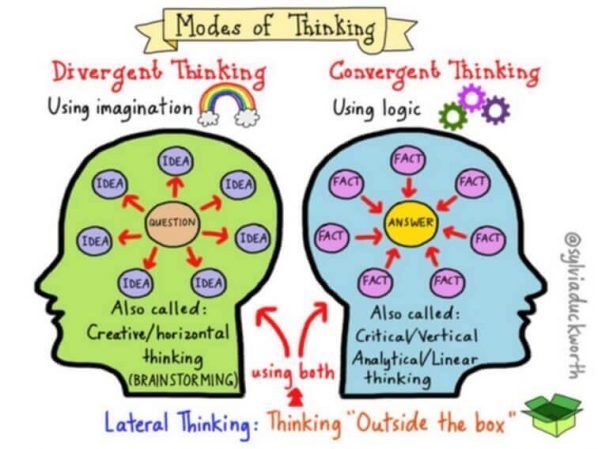 |
three minds | divergent | convergent | lateral | |
American educator Allison Green emphasizes
Our ability and tendency to think critically and carefully takes precedence over content knowledge, not only in the classroom but in the wider world around us. There are thought to be three different modes of thinking: lateral, divergent, and convergent thought.
• Convergent thinking (using logic). This type of thinking is also called critical, vertical, analytical, or linear thinking. It generally refers to the ability to give the “correct” answer to standard questions that do not require significant creativity. This includes most tasks in school and on standardized tests. Convergent thinking is the type of thinking that focuses on coming up with the single, well-established answer to a problem. When an individual is using convergent thinking to solve a problem, they consciously use standards or probabilities to make judgments.
• Divergent thinking (using imagination). This type of thinking is also called creative or horizontal thinking. It is a thought process or method used to generate creative ideas by exploring many possible solutions. When a student uses divergent thinking, thoughts typically occur in a spontaneous, free-flowing way. Many possible solutions are explored in a short amount of time, and unexpected connections are more easily drawn. After the process of divergent thinking has been completed, ideas and information are organized and structured using convergent thinking.
• Lateral thinking (using both logic and imagination). This type of thinking is commonly referred to as “thinking outside the box.” It involves solving problems through an indirect and creative approach, using reasoning that is not immediately obvious and involving ideas that may not be obtainable by using only traditional step-by-step logic. To understand lateral thinking, it is necessary to compare convergent and divergent thinking and build a working relationship between the two types.
Allison Green. Boston Tutoring Services. The Three Modes Of Thinking. #1004 ❤️William Pahl  |
2019 |
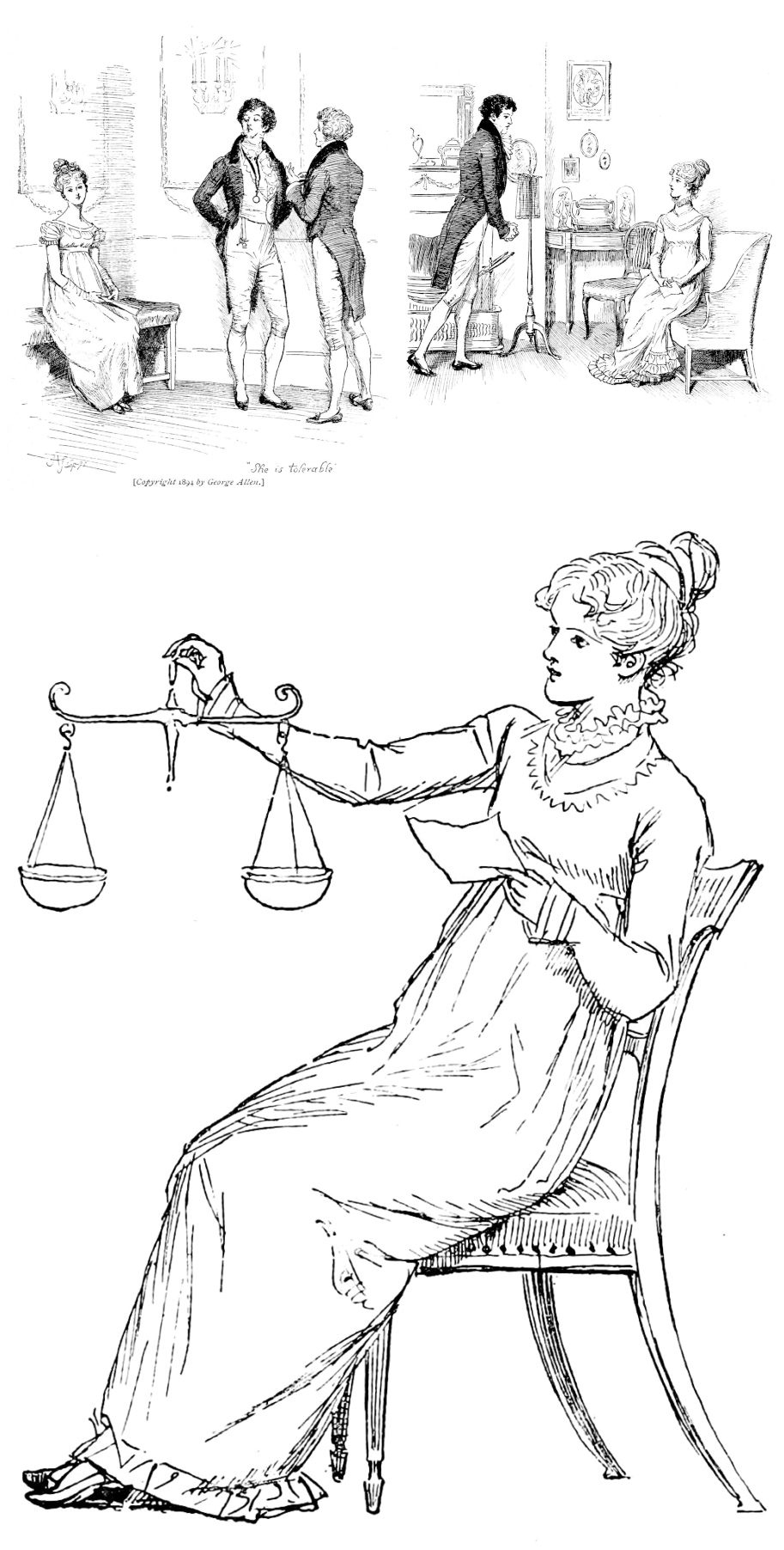 |
three minds | prejudice | pride | | |
English novelist Jane Austen's novel Pride and Prejudice shows how Elizabeth and her sisters come to see Darcy in a new light.
One cannot wonder that so very fine a young man, with family, fortune, everything in his favour, should think highly of himself. If I may so express it, he has a right to be proud.
I could easily forgive his pride, if he had not mortified mine.
A person may be proud without being vain. Pride relates more to our opinion of ourselves; vanity to what we would have others think of us.
He spoke well; but there were feelings besides those of the heart to be detailed, and he was not more eloquent on the subject of tenderness than of pride. His sense of her inferiority, of its being a degradation, of the family obstacles which judgment had always opposed to inclination, were dwelt on with a warmth which seemed due to the consequence he was wounding, but was very unlikely to recommend his suit.
She began now to comprehend that he was exactly the man who, in disposition and talents, would most suit her. His understanding and temper, though unlike her own, would have answered all her wishes. It was an union that must have been to the advantage of both: by her ease and liveliness, his mind might have been softened, his manners improved; and from his judgment, information, and knowledge of the world, she must have received benefit of greater importance.
Darcy mentioned his letter. “Did it,” said he,—“did it soon make you think better of me? Did you, on reading it, give any credit to its contents?” She explained what its effects on her had been, and how gradually all her former prejudices had been removed.
Jane Austen. Pride and Prejudice. #997  |
1813 |
 |
three minds | vibe | facts | | |
British fashion journalist Jess Cartner-Morley sketched out the history of vibe.
Facts are dead, and the vibe is king. ...The story of vibes begins with the release of the Beach Boys’ Good Vibrations in 1966. That was where the vibe chilled, for decades: West-Coast-specific, surf-adjacent, self-consciously laid-back. Quincy Jones launched Vibe magazine in 1993, when hip-hop was still a subculture, and the meaning of vibe began to expand. A graph of the word ‘vibes’ on Google Trends shows it begins to move from the alternative to the mainstream around 2016. Having hummed around the edges of culture for half a century, vibes began to gather steam. Louise Yems, strategy director of creative agency The Digital Fairy, believes the rise of vibes “speaks to how our reduced attention spans have led to a shortening of language. We use fewer words to capture something bigger than the words themselves.” Sometime around the early 2010s, the media started talking about places, bands, hotels having “a cool vibe”, or “an uptown vibe”.
Jess Cartner-Morley. ‘It’s game over for facts’: how vibes came to rule everything from pop to politics #995  |
2024 |
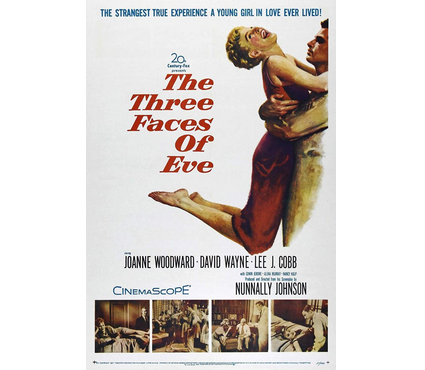 |
three minds | self-imposing | self-effacing | healing | |
The American dramatic movie Three Faces of Eve was based on the book by psychiatrists Corbett H. Thigpen and Hervey M. Cleckley about the life of Chris Costner Sizemore, who exhibited multiple personalities, now known as dissociative identity disorder.
• Eve White, a wife and mother, timid and self-effacing, who suffers severe and blinding headaches and occasional blackouts.
• Eve Black is wild, fun-loving, vicious and cold-blooded. She knows everything about Eve White, but Eve White is unaware of Eve Black.
• Jane emerges through hypnosis, recalls her childhood trauma, remembers her past, and replaces Eve White and Eve Black.
Wikipedia: The Three Faces of Eve
Wikipedia: Chris Costner Sizemore #982  |
1957 |
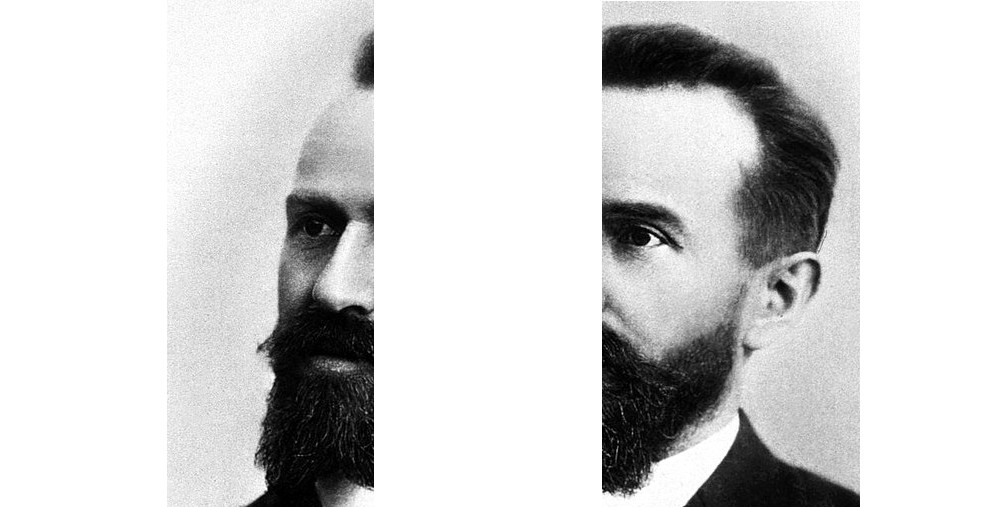 |
three minds | emotional | intellectual | | |
Swiss psychiatrist Eugen Bleuler introduced the term schizophrenia, which means "splitting of the mind". He believed the disease's central characteristics resulted from a splitting between the emotional and the intellectual functions of the personality.
Wikipedia: Eugen Bleuler #981  |
1907 |
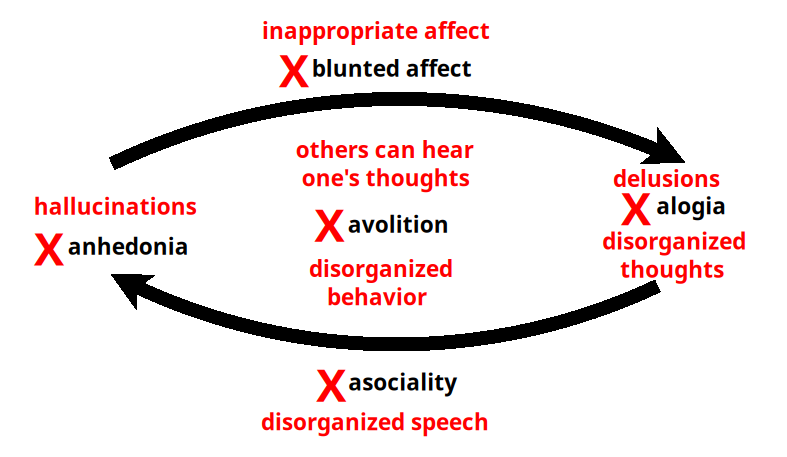 |
three minds | anhedonia | alogia | avolition | |
Schizophrenia is diagnosed from positive symptoms and negative symptoms. The negative symptoms of schizophrenia fall into five domains.
The negative symptoms of schizophrenia include volitional (motivational) impairment manifesting as avolition, anhedonia, social withdrawal, and emotional disorders such as alogia and affective flattening.
Wikipedia: Schizophrenia
Sergey N Mosolov, Polina A Yaltonskaya. Primary and Secondary Negative Symptoms in Schizophrenia.
#980  |
2022 |
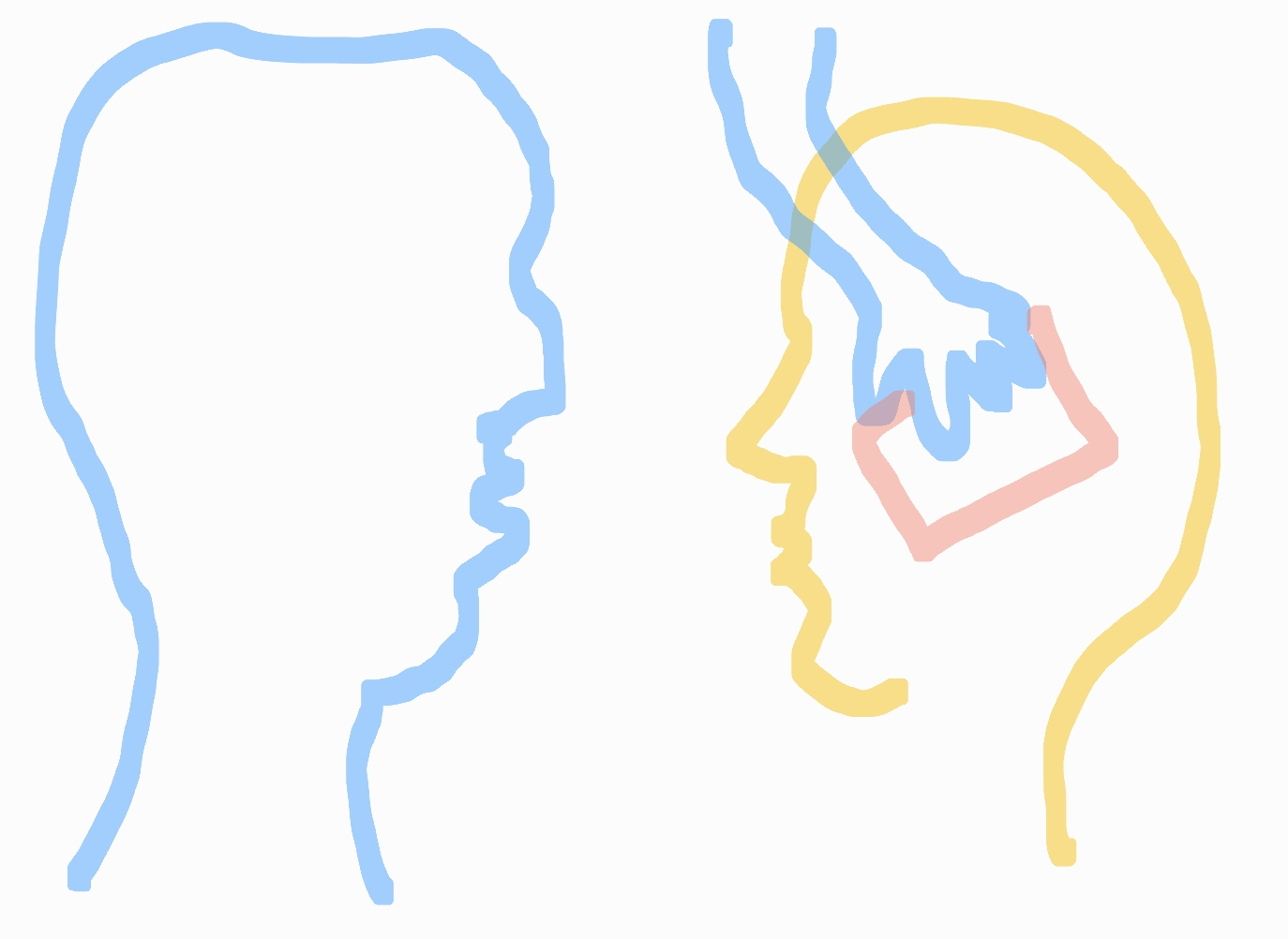 |
three minds | hallucinations | delusions | | |
German psychiatrist Kurt Schneider championed the diagnosis of schizophrenia not on the content of a symptom but on its form. He distinguished hallucinations and delusions.
• Auditory hallucinations of voices repeating the subject's thoughts out loud, discussing the subject, discussing the subject's thoughts as or before they occur, or commenting on the subject's thoughts or behavior.
• Delusional experiences that normal perception has special significance or meaning, that ideas are entering the subject's thinking, that the subject's thinking is not private but accessible to others, external agents are inserting unusual thoughts into the subject's mind, removing thoughts from it, or taking over their will as regards their actions, sensations, bodily movements, emotions or thought processes.
Wikipedia: Kurt Schneider #979  |
1939 |
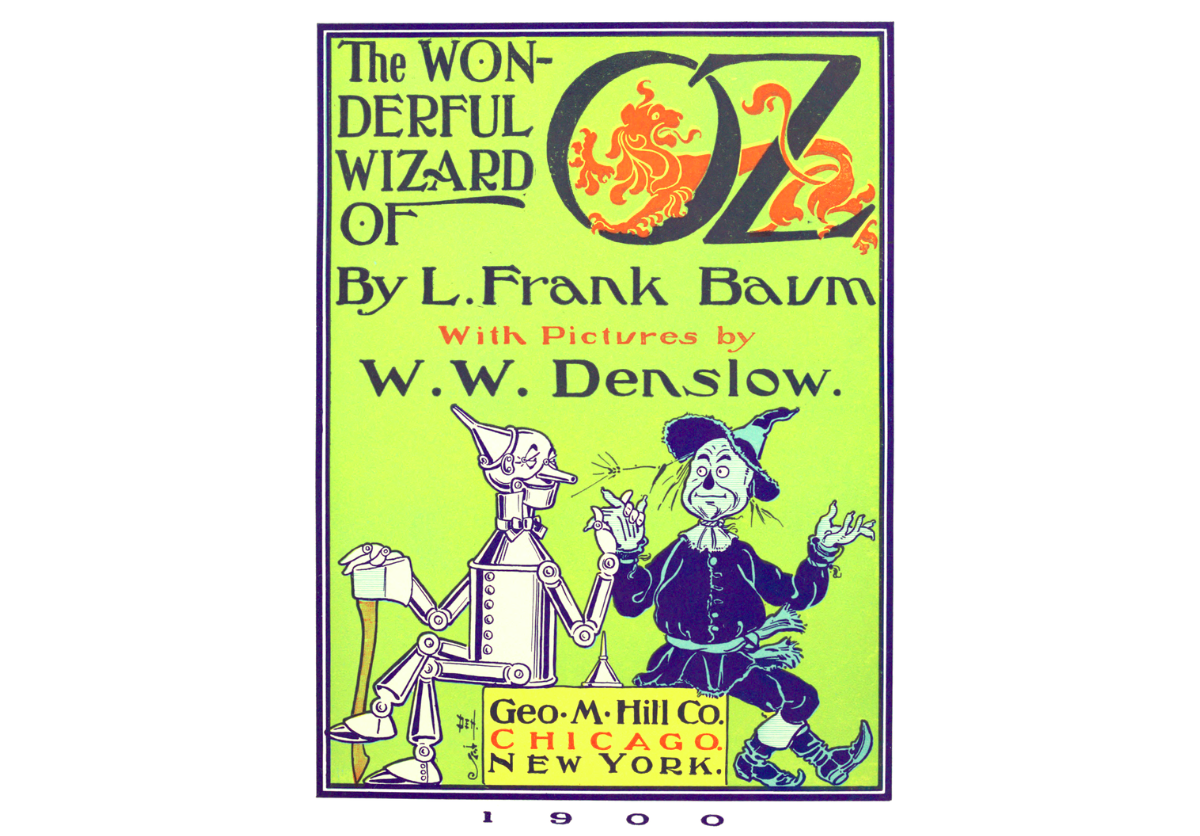 |
three minds | heart | brain | courage | |
American children's fantasy author L. Frank Baum wrote "The Wonderful Wizard of Oz". The hero, a Kansas farm girl Dorothy, is assisted by the Scarecrow, who wants a brain, the Tin Woodman, who wants a heart, and the Cowardly Lion, who wants courage.
Wikipedia: The Wonderful Wizard of Oz
L. Frank Baum. The Wonderful Wizard of Oz #978  |
1900 |
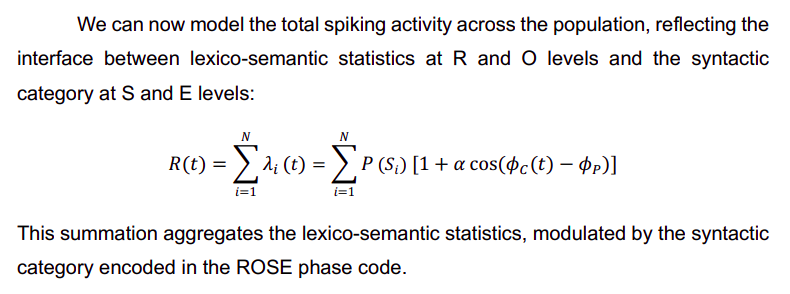 |
three minds | statistically-driven neural mechanisms for vertical syntax | low-frequency phase code for horizontal semantics | plausible interplay | |
Texan neuroscientist Elliot Murphy described a model relating connectionist and symbolic representations.
Natural language syntax can serve as a major test for how to integrate two
infamously distinct frameworks: symbolic representations and connectionist neural
networks. Building on a recent neurocomputational architecture for syntax (ROSE), I discuss the prospects of reconciling the neural code for hierarchical ‘vertical’ syntax with linear and predictive ‘horizontal’ processes via a hybrid neurosymbolic model.
It is my intention that the mathematical models provided here demonstrate a plausible interplay between a low-frequency phase code and statistically-driven neural mechanisms that can offer a framework where symbolic and connectionist representations can interface dynamically, leveraging the strengths of both paradigms.
Elliot Murphy. Shadow of the (Hierarchical) Tree: Reconciling Symbolic and Predictive Components of the Neural Code for Syntax.
#976 ❤️🐜  |
2024 |
 |
three minds | serenity | courage | insight | |
American Reformed theologian Reinhold Niebuhr gave a prayer. American YWCA official Winnifred Wygal cited a portion in her diary.
The victorious man in the day of crisis is the man who has the serenity to accept what he cannot help and the courage to change what must be altered.
She then published an early version of the Serenity prayer.
Oh, God, give us courage to change what must be altered, serenity to accept what can not be helped, and insight to know the one from the other.
Wikipedia: Serenity Prayer
AA. Origin of the Serenity Prayer: A Historical Paper #971  |
1932 |
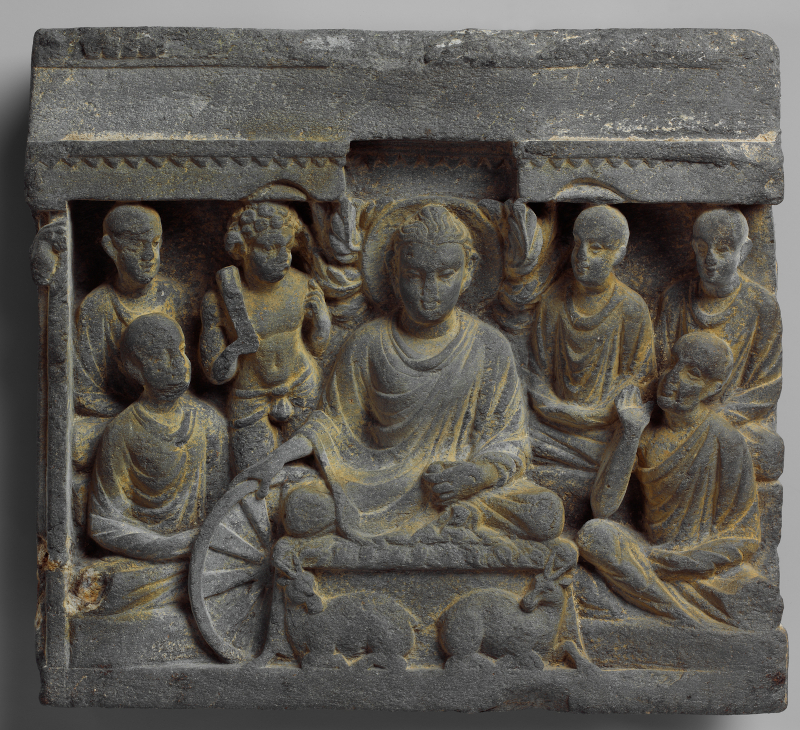 |
three minds | self-indulgence | self-mortification | rightness | |
Siddhartha Gautama, the Buddha, after his awakening, in roughly 520 BCE, gave his first sermon at Sarnath, near the Ganges and Varuna rivers.
Monks, these two extremes ought not to be practiced by one who has gone forth from the household life.
• There is an addiction to indulgence of sense-pleasures, which is low, coarse, the way of ordinary people, unworthy, and unprofitable;
• and there is an addiction to self-mortification, which is painful, unworthy, and unprofitable.
• Avoiding both these extremes, the Perfect One has realized the Middle Path; it gives vision, gives knowledge, and leads to calm, to insight, to enlightenment and to Nibbana. And what is that Middle Path realized by the Tathagata...? It is the Noble Eightfold Path, and nothing else, namely: right understanding, right thought, right speech, right action, right livelihood, right effort, right mindfulness and right concentration.
Wikipedia: Middle Way
#966  |
-300 |
 |
three minds | flight | fight | or | |
American physiologist Walter Bradford Cannon coined the term fight-or-flight response. Animals respond to threats with hyperarousal, a general discharge of the sympathetic nervous system, readying the animal to flee or to fight. Animals also exhibit freezing, fainting, fawning and being frightened.
Wikipedia: Fight-or-flight response
Walter Bradford Cannon. Bodily changes in pain, hunger, fear, and rage; an account of recent researches into the function of emotional excitement #963  |
1915 |
 |
three minds | conditioned | entangled | free | |
Indian-American meditator Deepak Chopra distinguishes three minds.
• Conditioned mind is karma, samskara and vasana. ... Conditioning simply means the modification of consciousness into predictable patterns of thought, feeling, behavior, speech, habits. So this is a recycling of experience and the interpretation of experience.
• The entangled mind is synchronicity, meaningful coincidence, and spontaneous fulfillment of desire. ... a mind that is expressed through non-local correlation or synchronicity. It is a deeper knowing in this submanifest order being also that that we are all entangled with each other ... Our collective desires, our collective fears, but also our collective archetypes, and, our collective aspirations, our collective longings, all of which influence the ecosystem of relationship.
• The free mind is spontaneous creativity and liberation from all suffering. ... The free mind is the source of all experience, without any conditioning, even before the entanglement. And this source of experience, as I have said, is always a field of infinite possibilities, a field of unpredictability connected to the uncertainty principle, a field of pure creativity, a field of pure evolution, a field of pure self-regulation. That field, which is without cause, spaceless, timeless, incomprehensible, unimaginable, fundamental, infinite, borderless and fundamental.
Now, the conditioned mind can be overcome through conscious choice-making. And so before you make any choice, ask yourself the consequences of the choice.
Deepak Chopra. What are the three minds? #961  |
2023 |
![]() |
three minds | emotional | rational | awareness | |
Indian American physician Deepak Chopra appealed to the triune brain in teaching the need to consciously, integratively, holistically balance our emotional and rational sides.
The classic division of the brain divides it into three parts. The lower or reptilian brain goes back hundreds of millions of years to our animal ancestors. Next in evolutionary time appeared the emotional brain, and finally, the higher brain or neocortex.
Studies have shown that decision-making is never completely rational and cannot be turned into a completely rational process. So the real question is whether you are aware of your emotional tendencies – lack of self-awareness has caused more bad decisions than any lapse of rational logic, because without emotion a decision is being made in a vacuum. The human element is mostly emotional and intuitive – it tells us how others feel, how we ourselves feel, where our level of discomfort lies, how well or badly we are communicating, and more.
There is no reason to hold a prejudice against any aspect of consciousness, not when you are expanded enough in your awareness to see the bigger picture. art, beauty, truth, love, morality, philosophy, music, invention, curiosity, and creativity are not rational, and it's deeply unwise to dismiss them as irrational as if that must be a derogatory term. If you value insight, if you aspire to wisdom, if you want to make better choices and seek lifelong fulfillment, the starting point is awareness and the holistic brain that supports it.
Deepak Chopra. Why Do You Need Three Brains? #960  |
2014 |
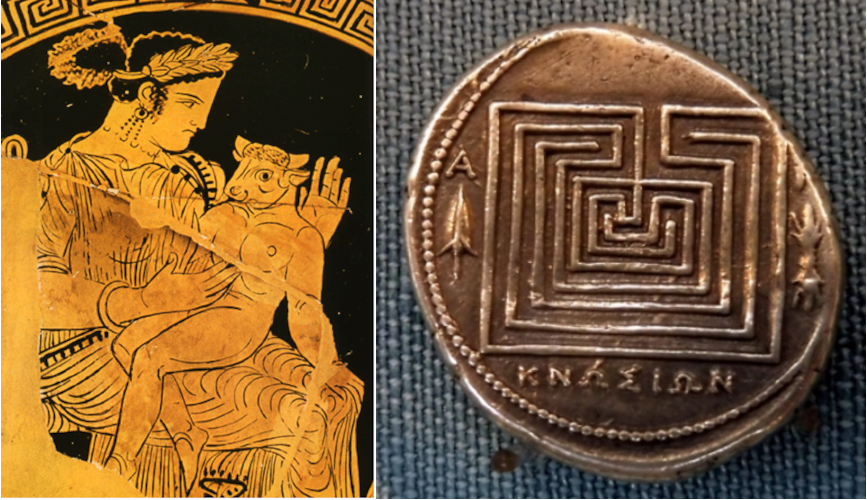 |
three minds | lust | power | labyrinth | |
The Bibliotheca of Pseudo-Apollodorus, a compendium of Greek myths and heroic legends, assembled roughly 100 CE, tells of the Minotaur and the Labyrinth.
Pasiphaë gave birth to Asterius, who was called the Minotaur. He had the face of a bull, but the rest of him was human; and Minos, in compliance with certain oracles, shut him up and guarded him in the Labyrinth.
The Minotaur and the Labyrinth appear on Cretan coins and pottery from 400 BCE.
Wikipedia: Labyrinth
Wikipedia: Minotaur
Erwin Reißmann. The Labyrinth on the Silver Coins of Knossos, Part 1.
A Mythical Monday: The Minotaur's Origin. #958  |
-400 |
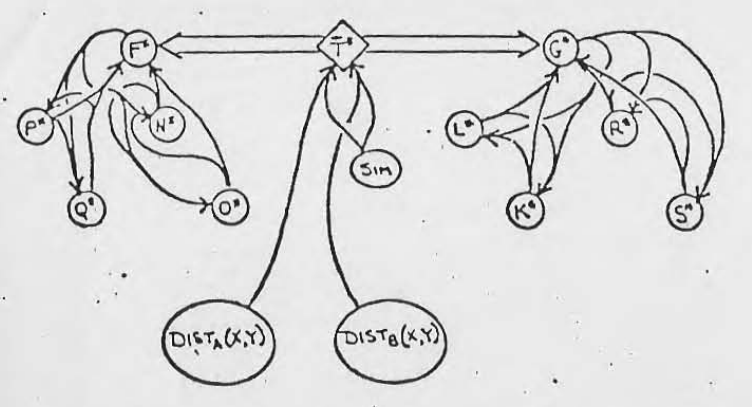 |
three minds | stable organizationally closed units | shared informationally open processes | local synchronicity and conditional dependence | |
British cybernetician Gordon Pask overviewed nonclassical versions of cybernetics and general systems theory in presenting his theory of what it means for A and B to agree in understanding.
1.1 Organizational Closure as a Stability
All of these (mostly independent) formulations replace the classical canons of deterministic or probabilistic stability by organizational closure of a process that is productive and, incidentally, also reproduces the medium, or processor, in which it is executed; most critically, by establishing, or maintaining the distinctions (in biology, the bounding surfaces) required for its coherent execution.
1.2 Informationally Open, Organizationally Closed, Processes
Another distinctive feature of the nonclassical formulations is that they are generally reflective and relativistic in character, because organizationally closed systems are often informationally open. This point is especially germane to conversation theory, where stable (as a result of organizational closure) units are participants in a conversation that involves information transfer (for example, between A and B) implicating process sharing.
1.3 Fundamental Information
The word information is used in its most fundamental sense ... to mean either "emergence of local synchronicity between otherwise asynchronous systems," or (equisignificantly) "emergence of dependency between otherwise independent systems." Conversely, essential synchronicities in the ongoing process make it necessary to predicate, or to compute, distinctions that render parts of the medium independent; these distinctions being needed if the process is to take place.
Gordon Pask. Consciousness. #956  |
1979 |
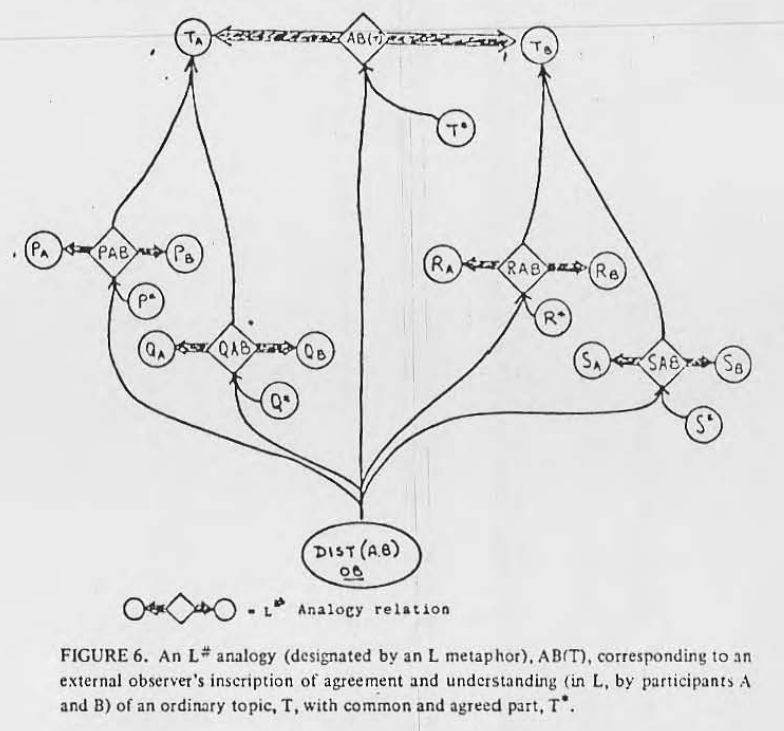 |
three minds | content | agreement | doubt | |
British cybernetician Gordon Pask defined consciousness as a conversation with others or oneself.
It will be argued that fundamental information transfer between participants A and B is their consciousness (A's consciousness with B of whatever they discuss), the emerging synchronicity, or dependency, being a correlate of coherent process sharing, or agreement, between the participants. The degree of consciousness is their doubt, which is many-faceted (doubt about focus of attention, doubt about outcomes, doubt about methods), but it may be quantified by fairly sophisticated confidence estimation techniques. The content of consciousness is whatever processes are shared by the participants.
Gordon Pask. Consciousness. #954  |
1979 |
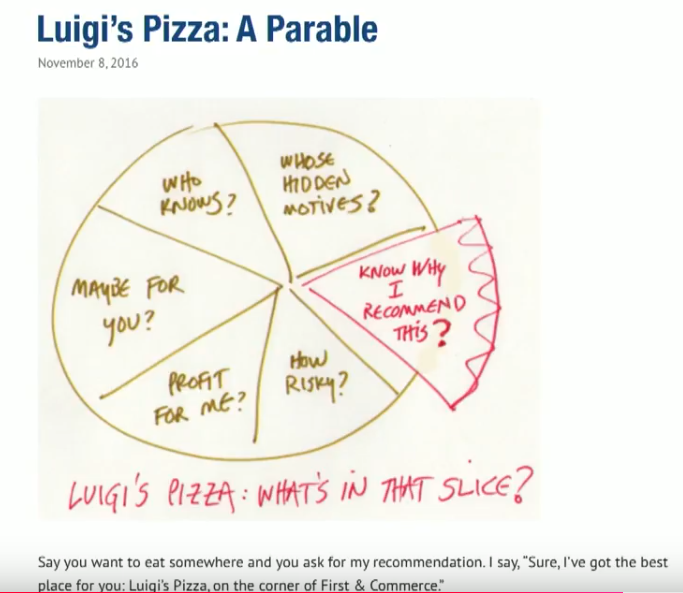 |
three minds | untransparent | transparent | interface | |
American cyberneticist Paul Pangaro spoke at a festival on the future.
...Google doesn't tell you why it makes the decisions it makes. So I'm here to propose that
Axiom #1 Conversation is the minimal ethical interface where conversation means reliable transparency of action & intent - what & why across the interface.
Axiom #2 Conversation is the minimal humane interface growing the understanding & informing the action of one or more willing & active participants.
Paul Pangaro. The Future of Cybernetics.
Paul Pangaro. Luigi's Pizza: A Parable #953  |
2018 |
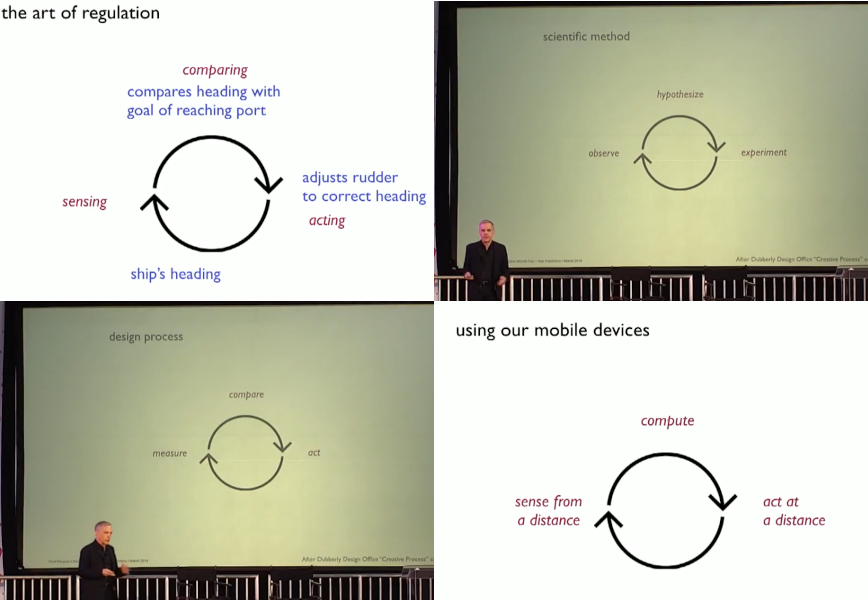 |
threesome | comparing | acting | sensing | |
American cyberneticist Paul Pangaro describes cybernetics.
Cybernetics is the art of getting what you want. It's the art of steering, of having a goal, aiming toward your goal and using feedback to get back. So it's this circular progress. In the case of a boat, it's seeing where you are compared to getting into the port, and adjusting the rudder to go in the right direction. But it's really everywhere and it's this general idea of sensing the world, comparing what you want to what you have, and then acting to get what you want. And it's this circular loop. So for the first time it's a science, it's a discipline, or maybe even an art which is about achieving goals and getting purpose. And this is where it began. But it's everywhere. Clinical practice in medicine, it's the same loop. In management. The scientific method is this. The design process: you measure something, you compare whether you're getting to what you want and then you act to design better.
Paul Pangaro. The Future of Cybernetics. #952  |
2018 |
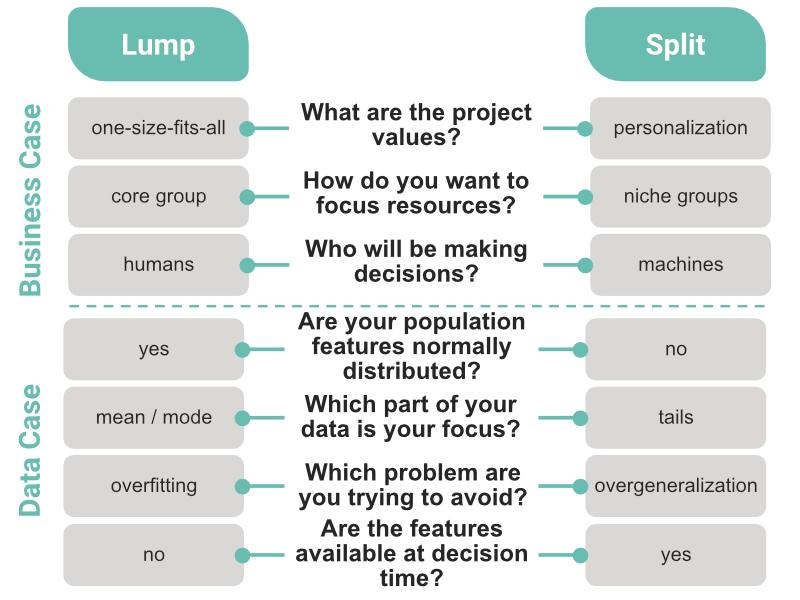 |
three minds | data signals | project needs | boundaries for decisions | |
Californian data scientists Anna Schneider and Alex Smolyanskaya blogged about lumpers and splitters, as relevant in their work for Stitch Fix, a personal styling service.
In the same way that genomics has dramatically changed biologists’ ability to identify narrow species and group them into complex hierarchies, a bounty of rich individual-level data has enabled data scientists to create increasingly fine taxonomies for clients, behaviors, and products. Yet, in both worlds, it can sometimes be more productive to focus on fewer, larger groups to streamline decision-making. The approach for drawing the boundaries therefore needs to take into account signals from the data while maintaining sharp focus on the project needs.
On one hand, fewer segments enable clarity and speed of execution, especially when the decisions are made by humans. On the other hand, the finest splits can help us understand the true diversity, reveal blind spots, and highlight promising opportunities.
If your use case requires cohesive, well-separated clusters, the silhouette coefficient can measure this; if clusters should be stable, bootstrapped evaluation of the Jaccard coefficient can measure this; if fit of individuals to their segments is important, log likelihood can measure this.
Anna Schneider, Alex Smolyanskaya. Lumpers and Splitters: Tensions in Taxonomies #951  |
2018 |
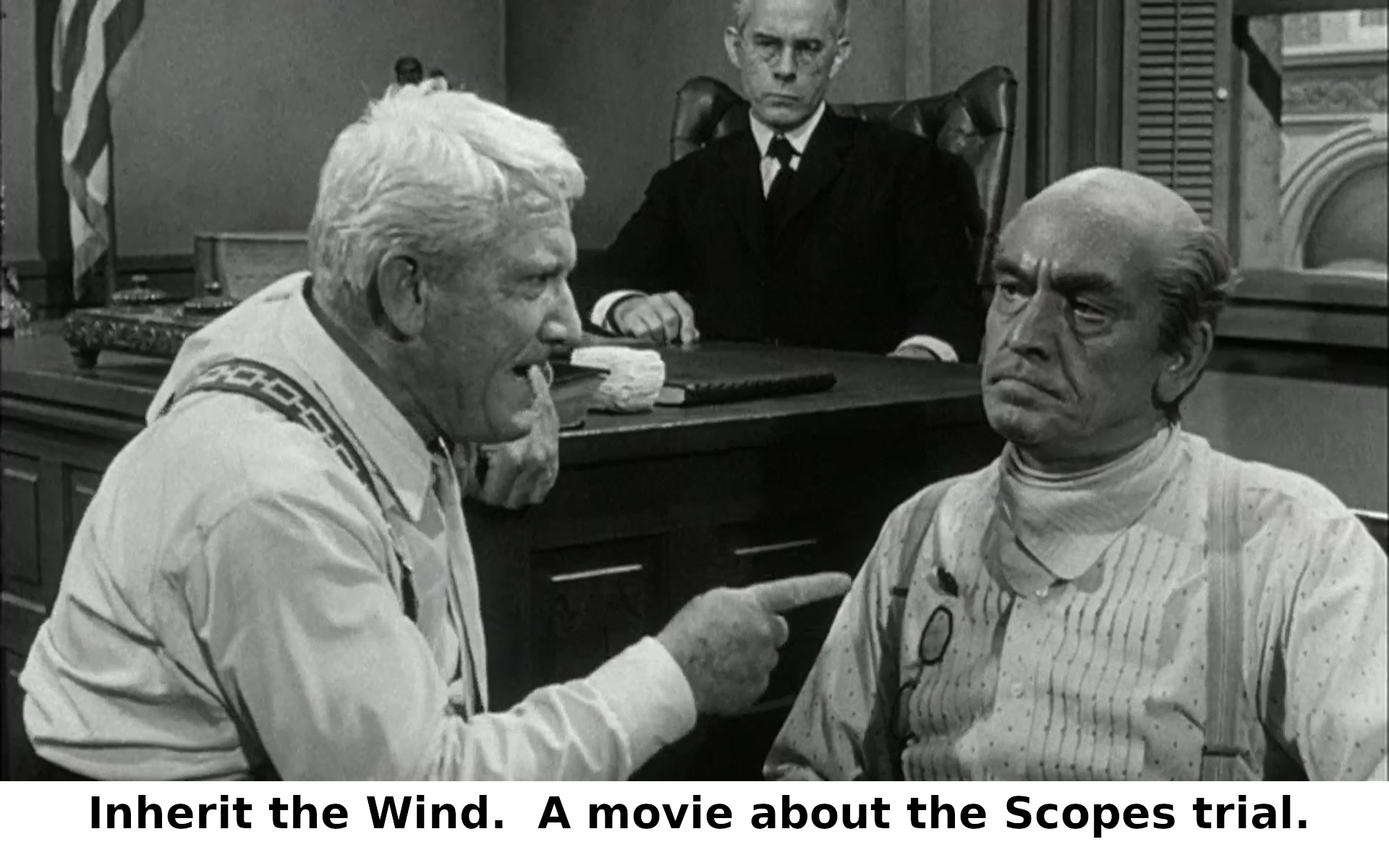 |
three minds | splitters | lumpers | | |
American Catholic priest George Barry O’Toole argued in The Case Against Evolution
In practice, however, the classifications of systematists are often very arbitrary, and we find the latter divided into two factions, the ‘lumpers’ who wish to reduce the number of systematic groups and the ‘splitters’ who have a passion for breaking up larger groups into smaller ones on the basis of tenuous differences.
Glenn Branch. Whence Lumpers and Splitters?
George Barry O’Toole. The Case Against Evolution. #950  |
1925 |
 |
three minds | splitters | lumpers | evolution | |
English evolutionary biologist Charles Darwin wrote to Joseph Dalton Hooker of the disagreement between splitters (who treat varieties as distinct species) and lumpers (who lump several varieties into one species) as evidence predicted by the hypothesis of evolution.
I am got extremely interested in tabulating according to mere size of genera, the species having any varieties marked by greek letters or otherwise: the result (as far as I have yet gone) seems to me one of the most important arguments I have yet met with, that varieties are only small species—or species only strongly marked varieties. The subject is in many ways so very important for me; I wish much you would think of any well-worked Floras with from 1000–2000 species, with the varieties marked. It is good to have hair-splitters & lumpers.
Glenn Branch. Whence Lumpers and Splitters? #949  |
1857 |
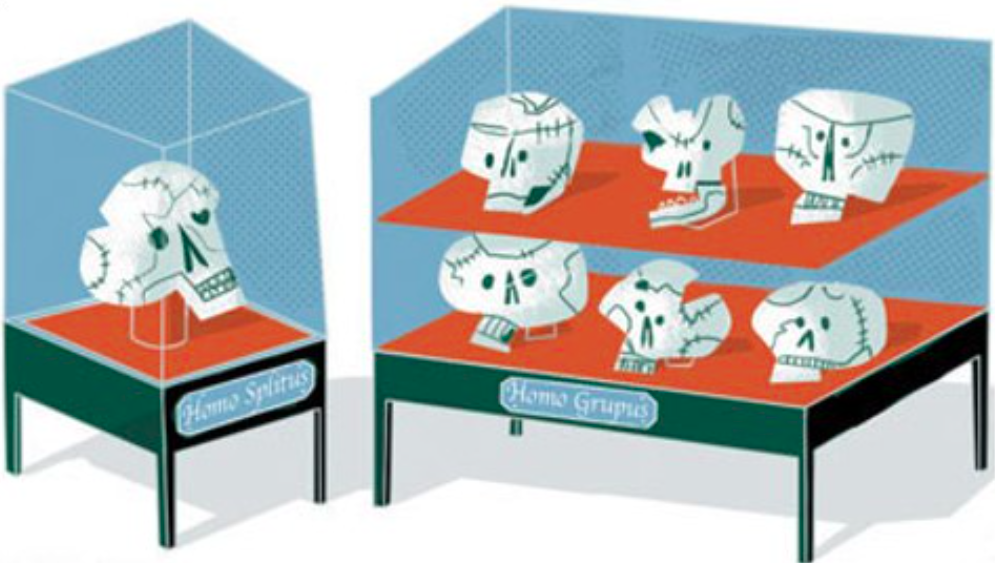 |
three minds | splitter | lumper | truth | |
English entomologist Edward Newman wrote in The Phytologist
The time has arrived for discarding imaginary species, and the duty of doing this is as imperative as the admission of new ones when such are really discovered. The talents described under the respective names of 'hair-splitting' and 'lumping' are unquestionably yielding their power to the mightier power of Truth.
Wikipedia: Lumpers and splitters
Glenn Branch. Whence Lumpers and Splitters? #945 ❤️MP  |
1845 |
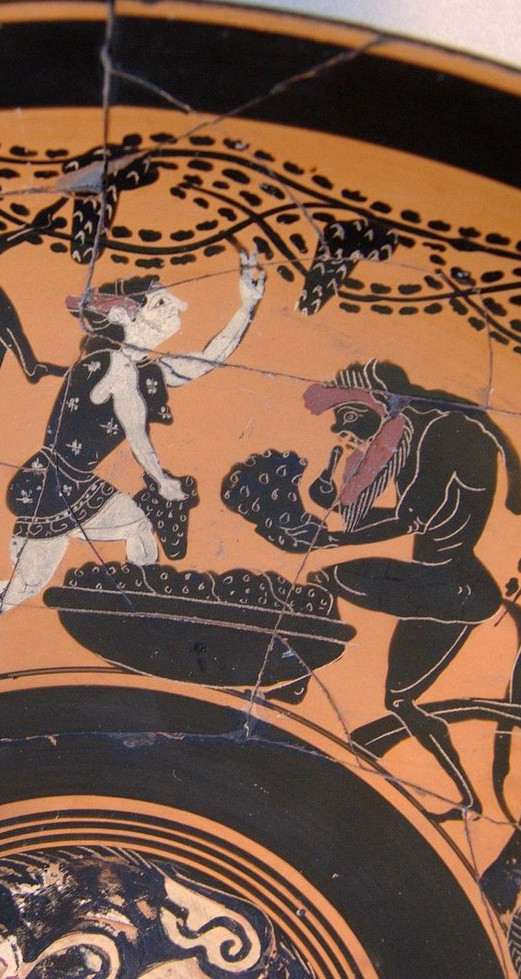 |
three minds | pleasure | self-control | wisdom | |
Greek philosopher Heraclitus of Ephesus, in the Persian empire, believed that fire was the noble part of the soul and water the ignoble part.
It is pleasure to souls to become moist.
A man, when he gets drunk, is led by a beardless lad, tripping, knowing not where he steps, having his soul moist.
For what thought or wisdom have they? They follow the poets and take the crowd as their teacher, knowing not that there are many bad and few good.
It is hard to fight with one's heart's desire. Whatever it wishes to get, it purchases at the cost of soul.
The dry soul is the wisest and best.
So we must follow the common, yet though my Word is common, the many live as if they had a wisdom of their own.
It pertains to all men to know themselves and to learn self-control.
Self-control is the highest virtue, and wisdom is to speak truth and consciously to act according to nature
The wisest man is an ape compared to God, just as the most beautiful ape is ugly compared to man.
The way of man has no wisdom, but that of God has.
To God all things are fair and good and right, but men hold some things wrong and some right.
It is not good for men to get all they wish to get. It is sickness that makes health pleasant; evil, good; hunger, plenty; weariness, rest.
It is wise to hearken, not to me, but to my Word, and to confess that all things are one.
Wisdom is one thing. It is to know the thought by which all things are steered through all things.
Fragments of Heraclitus
Wikipedia: Heraclitus
#944  |
-500 |
 |
three minds | visual | verbal | humor | |
American architecture critic Herbert Muschamp reviewed for the New York Times the show, "Mixing Messages: Graphic Design in Contemporary Culture".
But in 1966, McLuhan did collaborate with a noted graphic designer, Quentin Fiore, on The Medium Is the Massage a mass-market paperback intended to popularize McLuhan's ideas. And that book, unrepresented in this show, is nonetheless the seed from which its underlying idea has sprouted: that consciousness can be affected by the knowing collision of verbal and visual information. [...]
Here, we see graphic designers deeply engaged in dual, even hypocritical roles. They are at once decorators, compelled to misrepresent, gloss over or lend a dubious sheen of authority to the identities of their clients. At the same time, many of them are artists, creatures of conscience, who wish to punch through the veneer of the status quo that they themselves have helped to create. [...]
The solution to this ethical quandary, for many designers, has been to treat graphic design as a medium of humor. From Beaumarchais to Joe Orton, there's ample historical precedent for regarding humor, even the darkest, as an instrument of social change, as a technique for invading the mainstream with radical ideas.
Herbert Muschamp. A Reopening And a Carnival Of Graphics.
Ellen Lupton. Mixing messages : graphic design in contemporary culture. #941  |
1996 |
 |
three minds | recent past | new situation | | |
Canadian media theorist Marshall McLuhan and American graphic designer Quentin Fiore collaborated in a visual portrayal of the effects of various media on the human sensorium, the whole of human perception.
The past went that a-way. When faced with a totally new situation, we tend always to attach ourselves to the objects, to the flavor of the most recent past. We look at the present through a rear-view mirror. We march backwards into the future. Suburbia lives imaginatively in Bonanza-land.
Marshall McLuhan, Questin Fiore. The Medium Is the Massage: An Inventory of Effects. #940  |
1967 |
 |
three minds | lucky | unlucky | interpretation | |
The remnants of the Royal Library of Ashurbanipal, found at the site of the Assyrian capital Nineveh, include a clay tablet by the Babylonians of the Cassite period, with interpretations of dreams. In taking auguries, one usually faced north, with the right hand toward the lucky east, and the left hand toward the unlucky west. It remains unclear if this was related to the hemispheres of the brain, keeping in mind that a hemisphere is linked to its own side of the head but the opposite arm. In analyzing births and also the liver, defects on the unlucky side signaled luck, and vice versa.
If he gaze toward the right his adversary will die.
If he gaze toward the left his adversary will overcome him.
If he look backward he will not attain his desire.
If his right eye flow, sickness will appear.
If his left eye flow, his heart will be glad.
Stephen Langdon. A Babylonian Dream Tablet on the Interpretation of Dreams. #933  |
-1450 |
 |
three minds | less wise | equally wise | more wise | |
The Maxims of Ptahhotep are attributed to the Egyptian vizier Ptahhotep (2400 BCE) but were likely composed during the Twelth Dynasty (1991-1802 BCE). They are wisdom literature that teaches living by Maat, encompassing truth, balance, order, harmony, law, morality, and justice.
• If thou find an arguer talking, one that is well disposed and wiser than thou, let thine arms fall, bend thy back, be not angry with him if he agree (?) not with thee. Refrain from speaking evilly; oppose him not at any time when he speaketh. If he address thee as one ignorant of the matter, thine humbleness shall bear away his contentions.
• If thou find an arguer talking, thy fellow, one that is within thy reach, keep not silence when he saith aught that is evil; so shalt thou be wiser than he. Great will be the applause on the part of the listeners, and thy name shall be good in the knowledge of princes.
• If thou find an arguer talking, a poor man, that is to say not thine equal, be not scornful toward him because he is lowly. Let him alone; then shall he confound himself. Question him not to please thine heart, neither pour out thy wrath upon him that is before thee; it is shameful to confuse a mean mind. If thou be about to do that which is in thine heart, overcome it as a thing rejected of princes.
The Instruction of Ptah-Hotep and the Instruction of Ke'Gemni
Wikipedia: The Maxims of Ptahhotep #931 ❤️WP  |
-1900 |
![]() |
three minds | necessity | freedom | | |
German Jewish American philosopher Hans Jonas recognized in all forms of life the qualities that Plato and Aristotle reserved for humans.
The great contradiction that man discovers in itself - freedom and necessity, autonomy and dependence, ego and world, connectedness and isolation, creativity and mortality - are present in nuce in life most primitive forms, each of which maintains a precarious balance between being and nonbeing and from the very beginning harbors within itself an inner horizon of “transcendence.” [...] we maintain that metabolism, the basic substratum of all organic existence, already display freedom - indeed that it is the first form freedom takes.
Hans Jonas. The Phenomenon of Life: Towards a Philosophical Biology.
Stefano Franchi. General Homeostasis, Passive Life, and the Challenge to Autonomy. #909  |
1966 |
![]() |
three minds | heteronomous receptivity | autonomous spontaneity | | |
Immanuel Kant opposed the passive receptivity of the body with active rational subjectivity.
It is not from receptivity, but from the spontaneity of the subject that the aggregate of perception becomes a system, thus from that which the understanding makes out of this simple
material, hence autonomously not heteronomously.
Immanuel Kant. Opus Postumum.
Stefano Franchi. General Homeostasis, Passive Life, and the Challenge to Autonomy. #908  |
1804 |
 |
three minds | excess feeling | excess intellect | excess ambition | |
18-year old Mary Shelley conceived the novel Frankenstein, in which she juxtaposes the lonely inner lives of Victor Frankenstein, the monster he creates, and the captain who hears their story.
• Victor Frankenstein is sentimental but secludes himself in his laboratory, obsessed with his work.
• His monster reads and reflects on Milton, Goethe and Plutarch, but seethes with emotions he has no one to share with.
• Captain R.Walton longs for a friend who would understand, appreciate, encourage, share and revel in his ambitions.
Mary Wollstonecraft (Godwin) Shelley. Frankenstein; or, the Modern Prometheus. #906  |
1818 |
 |
three minds | conception | execution | dedication | |
Mary Shelley's hero Victor Frankenstein reflects, at the end of his life.
I believed myself destined for some great enterprise. My feelings are profound, but I possessed a coolness of judgment that fitted me for illustrious achievements. This sentiment of the worth of my nature supported me when others would have been oppressed, for I deemed it criminal to throw away in useless grief those talents that might be useful to my fellow creatures. When I reflected on the work I had completed, no less a one than the creation of a sensitive and rational animal, I could not rank myself with the herd of common projectors.
My imagination was vivid, yet my powers of analysis and application were intense; by the union of these qualities I conceived the idea and executed the creation of a man.
Mary Wollstonecraft (Godwin) Shelley. Frankenstein; or, the Modern Prometheus. #904  |
1818 |
 |
three minds | facts | thoughts | truth | |
Austrian philosopher Ludwig Wittgenstein, in his Tractatus Logico-Philosophicus, elucidated seven theses comprising clear thinking.
The book deals with the problems of philosophy and shows, as I believe, that the method of formulating these problems rests on the misunderstanding of the logic of our language. Its whole meaning could be summed up somewhat as follows: What can be said at all can be said
clearly; and whereof one cannot speak thereof one must be silent.
• 1. The world is all that is the case.
• 2. What is the case—a fact—is the existence of states of affairs.
• 3. A logical picture of facts is a thought.
• 4. A thought is a proposition with sense.
• 5. A proposition is a truth-function of elementary propositions. (An elementary proposition is a truth function of itself.)
• 6. The general form of a truth-function is  This is the general form of a proposition. This is the general form of a proposition.
• 7. Whereof one cannot speak, thereof one must be silent. What we cannot speak about we must pass over in silence.
Stanford. Ludwig Wittgenstein.
Ludwig Wittgenstein. Tractatus Logico-Philosophicus. #902  |
1921 |
 |
three minds | literal | critical | empathetic | |
Chinese Zen Buddhist Shi Daoyuan attributed to Qingyuan Xingsi this saying:
老僧三十年前未參禪時、見山是山、見水是水、及至後夾親見知識、有箇入處、見山不是山、見水不是水、而今得箇體歇處、依然見山秪是山、見水秪是水
Before I had studied Zen for thirty years, I saw mountains as mountains, and waters as waters. When I arrived at a more intimate knowledge, I came to the point where I saw that mountains are not mountains, and waters are not waters. But now that I have got its very substance I am at rest. For it's just that I see mountains once again as mountains, and waters once again as waters.
Sacred Texts. Zen Sayings.
Wikipedia: Qingyuan Xingsi
Wikipedia: The Jingde Record of the Transmission of the Lamp #901  |
1002 |
 |
onesome | universe | | | |
Evolutionary cosmologist Brian Swimme offers a grand view of the cosmos, including meaning, purpose and value.
If you look at the disasters happening on our planet, it's because the cosmos is not understood as sacred ... a way out of our difficulty is a journey into the universe as sacred.
This is the greatest discovery of the scientific enterprise: You take hydrogen gas, and you leave it alone, and it turns into rosebushes, giraffes, and humans.
Wikipedia: Brian Swimme
Susan Bridle. Comprehensive Compassion: An Interview with Brian Swimme. #898 ❤️KZ  |
1990 |
 |
three minds | affine spaces | sets | singletons | |
Californian logician Steven Givant classified nontrivial free varieties. Their models are:
• affine spaces over D
• pointed affine spaces over D
• sets
• pointed sets
where D is a chosen division ring. Pointed affine spaces are the same as vector spaces.
The trivial varieties are:
• singletons (sets with one element)
• the empty set and singletons
John Baez. Re: Open problems in category theory.
John Baez. Total Freedom.
Tom Leinster. Re: Total Freedom.
Steve Givant. Universal Horn Classes Categorical Or Free In Power.
Keith A. Kearnes, Emil W. Kiss and Agnes Szendrei, Varieties whose finitely generated members are free.
Ivan Di Liberti. Givant, Morley, Zilber. #894  |
1979 |
 |
three minds | sensory evidence | prior beliefs | control of balance | |
British neuroscientist Karl Friston spoke in a podcast of relaxing maladaptive prior beliefs.
This key balance between the precision afforded sensory evidence and the precision afforded your accumulated knowledge and wisdom and prior beliefs and narratives about how that sensory evidence should evolve, getting that balance right is absolutely crucial in health and in disease. And it may be the right control of that balance that undergirds all creative thinking and all artistic endeavors, just lateral thinking or seeing the world in a different way that allows somebody else to explore the hypotheses that entails a dissolution to a certain extent of the precision of your prior convictions.
Mitch Belkin, Daniel Belkin. Karl Friston: Schizophrenia, Autism, and the Free Energy Principle #892  |
2022 |
 |
three minds | faint | attack | hear out | |
English author Mary Shelley, in her science fiction novel "Frankenstein; or, The Modern Prometheus", has her monster place his hopes in a lovely family, which has persisted through injustice, hardship and poverty.
• The blind father hears him out, impartially, understandingly, compassionately.
• The daughter faints at the sight of him.
• The son attacks him, boldly, mercilessly.
Mary Wollstonecraft (Godwin) Shelley. Frankenstein; or, the Modern Prometheus. #891  |
1818 |
 |
three minds | | singing | | |
Pscyholinguist Peter Macneilage and neurobiologists Lesley Rogers and Giorgio Vallortigara overviewed evidence for the evolution of brain lateralization.
In birds, for instance, studies have shown that the left hemisphere controls singing. In sea lions, dogs and monkeys, the left hemisphere controls the perception of calls by other members of the same species.
Macneilage, Rogers, Vallortigara. Evolutionary Origins of Your Right and Left Brain.
#887  |
-85000000 |
 |
three minds | environmentally motivated | self-motivated | | |
Pscyholinguist Peter Macneilage and neurobiologists Lesley Rogers and Giorgio Vallortigara overviewed the evolution of brain lateralization in vertebrates.
...we propose, the right hemisphere took primary control in potentially dangerous circumstances that called for a rapid reaction from the animal—detecting a predator nearby, for instance. Otherwise, control passed to the left hemisphere. In other words, the left hemisphere became the seat of self-motivated behavior, sometimes called top-down control. (We stress that self-motivated behavior need not be innate; in fact, it is often learned.) The right hemisphere became the seat of environmentally motivated behavior, or bottom-up control.
Macneilage, Rogers, Vallortigara. Evolutionary Origins of Your Right and Left Brain.
#886  |
-500000000 |
 |
three minds | | gestures | | |
Pscyholinguist Peter Macneilage and neurobiologists Lesley Rogers and Giorgio Vallortigara overviewed the handedness of primates.
The evolutionary significance of all this becomes clear as soon as one notes that humans also tend to make communicative gestures with the right hand. The lateralized behavior we share with baboons suggests that right-handed communications arose with the first appearance of the monkeylike ancestor we share with baboons.
Macneilage, Rogers, Vallortigara. Evolutionary Origins of Your Right and Left Brain.
#885  |
-40000000 |
![]() |
three minds | unexpected emotional aruosal | routine behavior | | |
Pscyholinguist Peter Macneilage and neurobiologists Lesley Rogers and Giorgio Vallortigara overviewed evidence that distinctions between right and left brain hemispheres run across vertebrate species.
The specialization of each hemisphere in the human brain, we argue, was already present in its basic form when vertebrates emerged about 500 million years ago. ... Our hypothesis holds that
• the left hemisphere of the vertebrate brain was originally specialized for the control of well-established patterns of behavior under ordinary and familiar circumstances. In contrast,
• the right hemisphere, the primary seat of emotional arousal, was at first specialized for detecting and responding to unexpected stimuli in the environment.
Macneilage, Rogers, Vallortigara. Evolutionary Origins of Your Right and Left Brain. #884  |
2009 |
![]() |
three minds | monitor | distinguish | | |
Neuroscientists Lesley Rogers and Giorgio Vallortigara exploited the fact that light exposure in embryo determines visual lateralization in the avian brain. Light exposed chicks are strongly lateralized.
Chicks had to tell apart grains of food and pebbles scattered on a floor and the same time monitor overhead for a flying model of an aerial
predator. Strongly lateralized chicks performed well in this dual task, whereas weakly lateralized chicks performed poorly. The lateralized ones could attain this outcome by simultaneously attending to the feeding task with one eye and monitoring the predator with the other eye.
Vallortigara, Rogers. A function for the bicameral mind.
Rogers, Zucca, Vallortigara. Advantages of having a lateralized brain. #883  |
2004 |
 |
three minds | silhouette of foe | lights of friend | | |
Jewel squids are covered with "jewels", bioluminscent photophores.
...histioteuthids were predicted to orient in a tail-up posture with the body axis at a 45° angle and the head twisted so that
• the large left eye orients upward to view objects silhouetted against the dim downwelling sunlight, while
• the smaller eye orients slightly downward to optimally detect flashes of bioluminescence
When did this evolve? We can only guess...
Thomas, Robison, Johnsen. Two eyes for two purposes: in situ evidence for asymmetric vision in the cockeyed squids Histioteuthis heteropsis and Stigmatoteuthis dofleini #881  |
-100000000 |
 |
three minds | novel | routine | | |
Octopuses and cuttlefish have bicameral brains, which they evolved independently of vertebrates. Scientists study their lateralization.
It was originally argued that lateralization of function separated responses to social stimuli from those to non-social, but this division was not inclusive, as solitary animals also have lateral preferences. A second suggestion was the separation of control of different cognitive tasks, so that each could be more efficiently carried out by one brain half. Yet a third suggestion was that there was an evolutionary advantage to being able to use one eye and brain half for routine tasks and foraging, while the other was keeping track of novel stimuli, such as predators and perhaps conspecifics and social situations. Both octopuses and cuttlefish have been studied for such a division, the second with more success.
Jennifer Mather. The Case for Octopus Consciousness: Unity.
Caroline B Albertin et al. The octopus genome and the evolution of cephalopod neural and morphological novelties #880  |
-410000000 |
 |
three minds | innate | adaptive | | |
A jawed fish originated the acquired immune system that is found in vertebrates.
• Innate immune system preconfigures a response to general situations and stimuli.
• Adaptive immune system learns to recognize molecules it has previously encountered, and tailors a response accordingly.
Novel jaw structures and a predatory life style may have increased localized injuries and infections.
Wikipedia: Immune system
Wikipedia: Adaptive immune system: Evolution
T Matsunaga, A Rahman. What brought the adaptive immune system to vertebrates?--The jaw hypothesis and the seahorse.
#877  |
-420000000 |
 |
three minds | properties | name | renaming | |
English playwright William Shakespeare, in "Romeo and Juliet", has Romeo hear Juliet, unaware of him, declare from her balcony:
O Romeo, Romeo! wherefore art thou Romeo?
Deny thy father and refuse thy name;
... ... O, be some other name!
What's in a name? That which we call a rose
By any other name would smell as sweet;
Wikipedia: A rose by any other name would smell as sweet
#875  |
1595 |
 |
three minds | step out | step into | step over | |
Borland Turbo Debugger supported single-stepping, also known as program animation, which offered options for running portions of the code being debugged. These options are relevant when subroutines are being called. These commands have come to be known as:
• Step out. This allows all subsequent lines of a subroutine to be run, without further inspection, until control is returned to the routine that called it.
• Step into. This runs the following line but, if it calls a subroutine, it will descend into it but pause for permission to proceed further, so the lines can be inspected one-by-one, as the interpreter sees them.
• Step over. This runs the following line, allowing any subroutine it calls to proceed to completion, uninspected along the way, yet possibly evoking and revealing a violation.
What is step into, step out and step over in Firebug?
Stack Overflow. What is difference between trace into (F7) and step over (F8) in Turbo c++?
Wikipedia: Debugger #873  |
1989 |
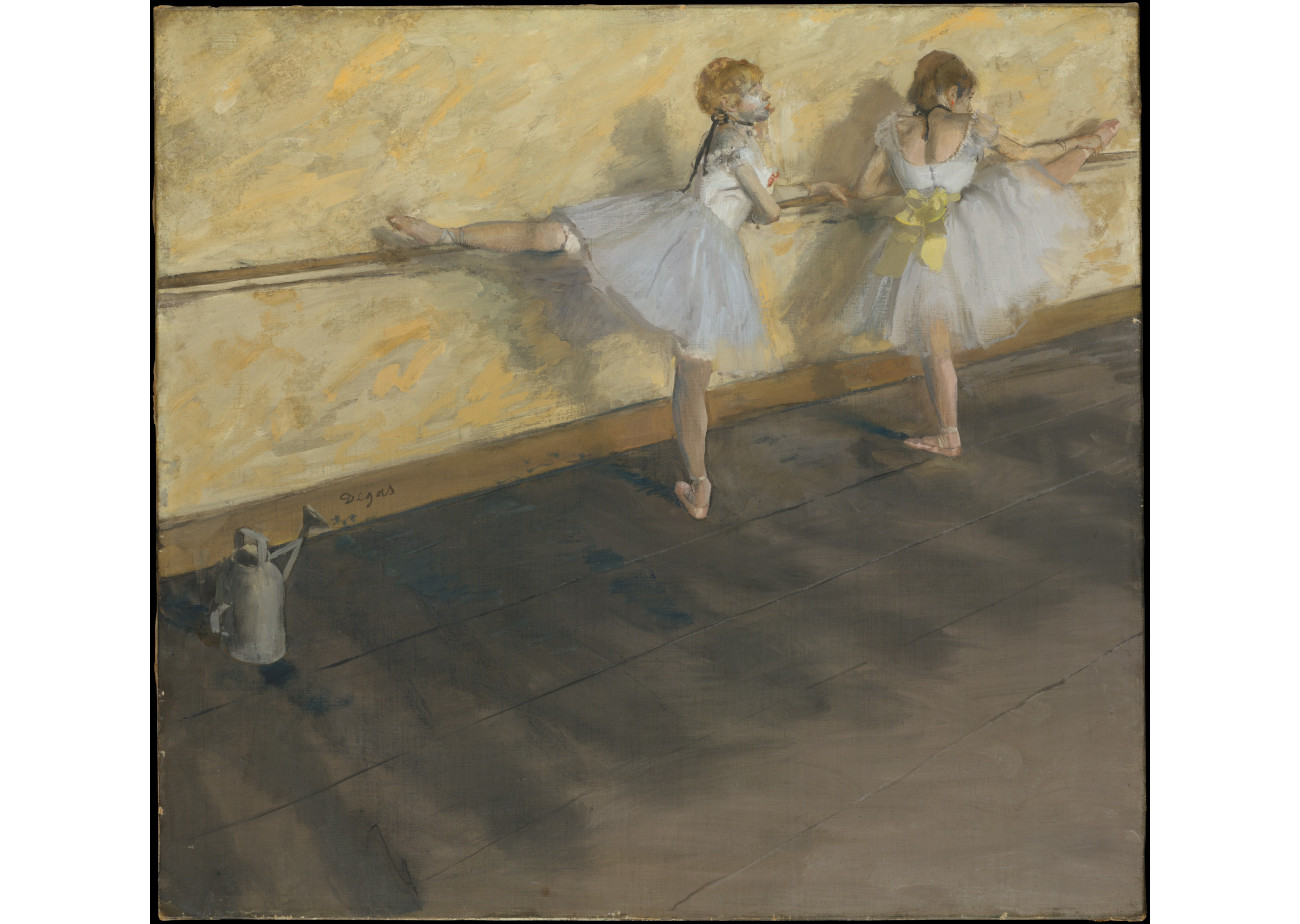 |
three minds | step in | step out | step back | |
Project PZ Connect, a collaboration between Harvard University and Independent Schools Victoria in Australia, developed a thinking tool for being responsible in taking a perspective by asking three questions.
• Step In: What do you think this person might feel, believe, know, or experience?
• Step Out: What would you like or need to learn to understand this person’s perspective better?
• Step Back: What do you notice about your own perspective and what it takes to take
somebody else’s?
PZ's Thinking Routines Toolbox
Project Zero. Step In - Step Out - Step Back
#867  |
2019 |
 |
three minds | Hebbian learning | | | |
Canadian psychologist Donald O. Hebb articulated a neuroscientific explanation of associative learning, known also as Hebbian learning.
Let us assume that the persistence or repetition of a reverberatory activity (or "trace") tends to induce lasting cellular changes that add to its stability. ... When an axon of cell A is near enough to excite a cell B and repeatedly or persistently takes part in firing it, some growth process or metabolic change takes place in one or both cells such that A’s efficiency, as one of the cells firing B, is increased.
Wikipedia: Hebbian theory
Donald Hebb. The Organization of Behavior. #862  |
1949 |
 |
three minds | sensibility | volition | reason | |
French philosopher Victor Cousin, founder of eclecticism, combined German Idealism with Scottish Common Sense Realism. From psychological observation, he derived three kinds of fact, all present in consciousness:
• The facts of sensibility, sensations, impressions, are necessary.
• The facts of volition, our self-activity, our liberty, are those which are voluntary, imputable and personal, directing attention, that alone which is Me, the center by which consciousness is possible.
• The facts of reason, the light, the source of all apprehension of not-me, identifying sensation with an objective impersonal world of forces (external causes) and volition with personal beings (substances), are universal, necessary.
We find ourselves between two orders of phenomena that do not belong to us, and that we apprehend upon distinguishing ourselves from them.
Wikipedia: Victor Cousin
Victor Cousin. Lectures on the True, the Beautiful, and the Good. #851  |
1853 |
 |
three minds | determined by nature | separate from nature | harmony with nature | |
German historian Wilhelm Dilthey developed a typology of three typical, fundamental, conflicting world-views, Weltanschauungen, for conceiving humanity's relation to nature.
• Naturalism. Humans see themselves as determined by nature. Championed by Epicureans.
• Subjective Idealism, the Idealism of Freedom. Humans are conscious of their separation from nature by their free will. Articulated by Schiller and Kant.
• Objective Idealism. Humans are conscious of their harmony with nature. Represented by Hegel, Spinoza, and Bruno.
Wikipedia: Wilhelm Dilthey #847  |
1911 |
![]() |
onesome | lifeworld | | | |
Edmund Husserl, founder of phenomenology, introduced the concept of lifeworld as the consciousness of the universe, individually and collectively, that we share, the ground for all shared human experience, the dynamic background on which all things appear as themselves and meaningful, the horizon in which we live, and which lives with us, and within which all is possible only as being lived.
In whatever way we may be conscious of the world as universal horizon, as coherent universe of existing objects, we, each "I-the-man" and all of us together, belong to the world as living with one another in the world; and the world is our world, valid for our consciousness as existing precisely through this 'living together.' We, as living in wakeful world-consciousness, are constantly active on the basis of our passive having of the world... Obviously this is true not only for me, the individual ego; rather we, in living together, have the world pre-given in this together, belong, the world as world for all, pre-given with this ontic meaning... The we-subjectivity... [is] constantly functioning.
Wikipedia: Lifeworld
Edmund Husserl. The crisis of European sciences and transcendental phenomenology; an introduction to phenomenological philosophy. #844  |
1936 |
![]() |
three minds | will | representation | consciousness | |
German philosopher Arthur Schopenhauer agreed with Kant that we know objects only as phenomena, by their appearances, yet argued, by analogy with one's own body, that we can identify the underlying thing-in-itself with will - a blind, unconscious, aimless striving, devoid of knowledge, outside of space and time, free of all multiplicity. This will objectifies the world as representation.
The double knowledge which we have of the nature and action of our own body, and which is given in two completely different ways, ... we shall use further as a key to the inner being of every phenomenon in nature. We shall judge all objects which are not our own body, and therefore are given to our consciousness not in the double way, but only as representation, according to the analogy of this body. We shall therefore assume that as, on the one hand, they are representations, just like our body, and are in this respect homogeneous with it, so on the other hand, if we set aside their existence in the subject's representation, what still remains over must be, according to its inner nature, the same as what in ourselves we call will.
John Cutting. Principles of psychopathology: two worlds, two minds, two hemispheres
Wikipedia: The World as Will and Representation #836  |
1818 |
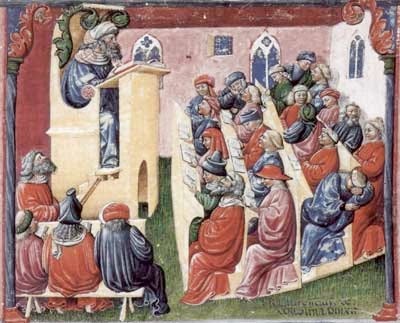 |
three minds | determine facts | formulate charges and present evidence for and against | ensure neutrality throughout procedures | |
The Magna Carta in England enshrined the right to a jury trial, where decision making is divided among
• Prosecutors, who bring criminal charges, alleging a crime was committed, and present their evidence, which is countered by defense attorneys, who represent the defendant.
• Jury, typically consisting of twelve peers, representing a cross-section of the public, which is a finder of fact, collectively evaluating the accuracy and completeness of testimony of witnesses and experts, comparing it with their personal knowledge and experience, determining the truth or falsity of factual allegations, and arriving at a unanimous verdict of innocent or guilty.
• Judge, a neutral referee of the adversarial process, who rules on questions of law, determines what law applies to a particular set of facts, and decides the sentence.
Wikipedia: Jury
American Bar Association. How Courts Work. #828  |
1215 |
 |
three minds | emotions | conceptions | daily master routine | |
American neuroscientist Paul D. MacLean proposed the theory of the triune brain consisting of the reptilian R-complex (basal ganglia), the paleomammalian complex (limbic system), and the neomammalian complex (neocortex), each added in the course of evolution.
The human forebrain evolved to its great size while retaining features of three basic formations that reflect an ancestral relationship to reptiles, early mammals, and recent mammals. The three neural assemblies… are radically different in structure and chemistry, and in an evolutionary sense, countless generations apart. Psychological and behavioral functions depend on the interplay of three quite different mentalities. The three evolutionary formations might be popularly regarded as three interconnected biological computers, each having its own special intelligence, its own subjectivity, its own sense of time and space, and its own memory, motor, and other functions. ... If the three main evolutionary assemblies were pictured as intermeshing and functioning together as a triune brain, they could hardly be completely autonomous, but
would be able to operate somewhat independently.
The basal ganglia was crucial for carrying out one's daily master routine. A dentist with Huntington's disease was no longer able to perform the familiar step-by-step sequence of filling a tooth.
The lymbic system is needed to derive information in terms of affective feelings that guide behavior required for self-preservation and preservation of the species and also for a sense of self, of reality, and the memory of ongoing experience, but also a feeling of conviction as to what is true or false.
The neocortex deals with ideas, concepts, theories, language, logic and play.
The History of Neuroscience in Autobiography. Volume 2.
Wikipedia: Triune brain
A.B. Butler. Triune Brain Concept: A Comparative Evolutionary Perspective. #821 ❤️William Pahl  |
1969 |
![]() |
three minds | imagination | ignorance | | |
American physicist E. T. Jaynes described two versions of the mind projection fallacy.
• positive - thinking the way one sees the world (personal perceptions) is the way the world actually is (inherent properties)
• negative - supposing one's own lack of knowledge (their ignorant state of mind) indicates the issue is not understandable (a fact about reality)
The error occurs in two complementary forms, which we might indicate thus:
(A) (My own imagination) → (Real property of Nature)
(B) (My own ignorance) → (Nature is indeterminate)
Wikipedia: Mind projection fallacy
E. T. Jaynes. Probability Theory as Logic. #814  |
1990 |
 |
foursome | self | linear | relational | interrelational |
American social architect John Ray Hamann formulated relationalism, which postulates that there are only four possible types of relations and they constitute four relational orders.
• self relation - a relation by which a system is related to itself
• linear relation - a relation connecting two systems
• relational relation - a relation relating a system with a relation
• interrelational relation - a relation interrelating two other relations
Jere Northrop. The Relational Symmetry Paradigm #813  |
1968 |
 |
three minds | evidence | hypothesis | belief | |
English statistician Thomas Bayes stated Bayes Theorem for inverting conditional probabilities. Its use was called inverse probability because it infers backwards from observations to parameters, or from effects to causes. The theorem appears symmetrical yet is typically interpreted to relate
• hypothesis H that can be affected by data
• evidence E, new data not yet used in computing the prior probability of the hypothesis.
Probability indicates degree of belief.
Wikipedia: Bayesian inference
Wikipedia: Bayes' theorem #808  |
1763 |
 |
three minds | nature | culture | reconfiguration | |
French feminist Luce Irigaray argued that since ancient times
• women have been associated with nature, unthinking matter, the role of mother, supportive, non-subjective, sacrificed
• men have been associated with culture, subjectivity, excluding women
• reconfiguration of subjectivity by both men and women is required so that both understand themselves as belonging equally to nature and culture. Women must attain subjectivity, men must become more embodied. Means for this include mimesis (imitation - creatively appropriating existing models), novel language, utopian ideals, strengthening mother daughter relationships, exposing and demystifying negative views.
Internet Encyclopedia of Philosophy: Luce Irigaray #796  |
1974 |
 |
three minds | mother | virgin | prostitute | |
Luce Irigaray, in Women on the Market, Chapter VIII of This Sex Which Is Not One, argues that Western society is based on men exchanging women (daughters become wives, mistresses, objects of desire). Women's natural qualities are their use value and society determines their exchange value, yielding three types of women.
• mothers are all use value
• virgins are all exchange value
• prostitutes embody both use and exchange value
Wikipedia: Luc Irigaray
Luce Irigaray. This Sex Which Is Not One #795  |
1977 |
 |
three minds | imaginary | symbolic | real | |
French psychoanalyst Jacques Lacan considered psychic functions to occur within a universal matrix of three registers.
• The Imaginary is the field of images and imagination, the signified and signification, generating illusions: synthesis, autonomy, duality and resemblance. It is rooted in one's relationship with their own body, alienation from conflict between one's emotional experience and one's imagine in a mirror, captivation with this image of "me", yielding sexual display and courtship love. Its fixations are disabling. It inverts and distorts discourse with a wall of language.
• The Symbolic structures the Imaginary order, and is where the analyst produces changes in one's subjective position. It is the world of words (signifiers) that creates the world of things, the discourse of the Other, where elements exist by their mutual differences, the domain of culture, the basis for law which regulate desire, where the drives of death and lack, through repetition, leverage the pleasure principle.
• The Real is all that is impossible to imagine or symbolize or attain, for which all words or categories fail, thus traumatic, the essential object that is thus not an object, never missing, always present, positive, in its place.
To these he adds:
• The Sinthome (symptom) is the sign of neurosis which the subject, guided by the analyst, learns to creatively embrace, knotting together the Real, Imaginary and Symbolic.
Wikipedia: Jacques Lacan
Stanford: Jacques Lacan #793  |
1959 |
 |
foursome | spirit | know | not know | truth |
In the Gospel of John, Jesus tells the Samaritan woman at the well
You worship that which you don’t know. We worship that which we know; for salvation is from the Jews. But the hour comes, and now is, when the true worshipers will worship the Father in spirit and truth, for the Father seeks such to be his worshipers. God is spirit, and those who worship him must worship in spirit and truth.
John 4:22-24 #789  |
100 |
 |
three minds | know | not know | truth | |
In the Gospel of John, Jesus tells the Samaritan woman at the well
You worship that which you don’t know. We worship that which we know; for salvation is from the Jews. But the hour comes, and now is, when the true worshipers will worship the Father in spirit and truth, for the Father seeks such to be his worshipers. God is spirit, and those who worship him must worship in spirit and truth.
John 4:22-24 #787  |
100 |
 |
three minds | sausages | hanging from nose | removed from nose | |
Charles Perrault of France, teller of classic fairy tales such as "Little Red Riding Hood" and "Cinderella", published "The Ridiculous Wishes", wherein...
A woodcutter complained of his poor lot. Jupiter granted him three wishes. The woodcutter went home, and his wife persuaded him to put off the wishing until the next day, after he had thought, but while sitting by the fire, he wished for sausages. His wife taxed him for his folly, and angry, he wished for the sausages to hang from her nose. Finally, they agreed to use the last wish to take the sausages off her nose, leaving them no better off than before.
Wikipedia: The Ridiculous Wishes
Charles Perrault. Les_Souhaits_ridicules.
The Fairy Tales of Charles Perrault. #783  |
1697 |
![]() |
three minds | freight | groove | proportion | |
American poet Emily Dickinson mused
That Love is all there is,
Is all we know of Love;
It is enough, the freight should be
Proportioned to the groove.
Wikisource: That Love is all there is #781  |
1863 |
 |
three minds | sensation | reflection | education | |
English philosopher John Locke explained how the mind derives all ideas from experience.
• Sensation - direct sensory information from external objects
• Reflection - the perception of the operations of our own mind within us, as it is employed about the ideas it has got ... This source of ideas every man has wholly within himself; and though it be not sense, as having nothing to do with external objects, yet it is very like it, and might properly enough be called 'internal sense.'
Ideas form through such associations. education influences those associations. Education influences the associations which result, for the mind as such is an empty cabinet. Furthemore, consciousness is the basis of personal identity, and it travels freely into the past.
And as far as this consciousness can be extended backwards to any past Action or Thought, so far reaches the Identity of that Person; it is the same self now it was then; and 'tis by the same self with this present one that now reflects on it, that that Action was done.
Wikipedia: An Essay Concerning Human Understanding
Wikipedia: John Locke
John Locke. An Essay Concering Human Understanding. #777  |
1689 |
 |
three minds | confused feelings | clear understanding | student of Nature | |
French modern philosopher René Descartes related mind and body.
Nature also teaches me by these sensations of pain, hunger, thirst, etc., that I am not only lodged in my body as a pilot in a vessel, but that I am very closely united to it, and so to speak so intermingled with it that I seem to compose with it one whole. For if that were not the case, when my body is hurt, I, who am merely a thinking thing, should not feel pain, for I should perceive this wound by the understanding only, just as the sailor perceives by sight when something is damaged in his vessel; and when my body has need of drink or food, I should clearly understand the fact without being warned of it by confused feelings of hunger and thirst. For all these sensations of hunger, thirst, pain, etc. are in truth none other than certain confused modes of thought which are produced by the union and apparent intermingling of mind and body.
Wikipedia: René Descartes
René Descartes. Meditations on First Philosophy. #776  |
1641 |
 |
three minds | sense perception | personal intellectual activity | reason | |
African bishop Augustine, a Church Father, described how God illuminates the mind.
• sense perception through first-hand acquaintance yields knowledge of sensible objects
• personal intellectual activity yields intellectual insights into mathematical and logical truths and fundamental moral intuitions because we see them for ourselves
• reason sees the truth regarding intellectual objects when God illuminates them
Stanford: Augustine of Hippo
Saint Augustine. The Soliloquies. #774  |
387 |
![]() |
foursome | | know basic assumptions | know what actions to perform | know the significance of basic assumptions |
American ethicist John Kekes observed that knowledge involved in wisdom concerns means to good ends.
• knowledge of means is knowing what actions to perform, which is relatively simple
• knowledge of good ends is knowledge of the significance of the most basic assumptions of human experience, which mark off the limits to human possibility
• basic assumption include that I have a body with limbs and head, there exist other people and many familiar material objects, I was born, have matured, am aging, will die, I perceive the world through my senses, I am capable of thought, feeling, imagination, will, I can learn from the past and plan for the future.
John Kekes. Wisdom. American Philosophical Quarterly.
Wikiversity: Wisdom: Defining Wisdom #771 ❤️LB  |
1983 |
![]() |
three minds | wants of human situation | ideals of good life | modification of wants with regard to ideals | |
American ethicist John Kekes argued
What a wise man knows, therefore, is how to construct a pattern that, given the human situation, is likely to lead to a good life. This knowledge is not esoteric, for it is within everyone's reach; nor does it require a special skill or talent, for it concerns the recognition of possibilities and limitations that are the same for everyone. But it does take self control, enabling a person to modify his wants in accordance with his ideals; self-knowledge, for knowing what his wants and ideals are; breadth and depth; constancy, so that adversity will not deflect him from his commitments; and the hierarchical ranking of his commitments, for judging what is important to him.
John Kekes. Wisdom. American Philosophical Quarterly.
Wikiversity: Wisdom: Defining Wisdom #770 ❤️LB  |
1983 |
![]() |
threesome | judgment | action | knowledge | |
American philosopher John Kekes organized his essay on wisdom in three parts.
In good judgment, a person brings his knowledge to bear on his actions. To understand wisdom, we have to understand its connection with knowledge, action, and judgment.
John Kekes. Wisdom. American Philosophical Quarterly. #769  |
1983 |
 |
three minds | yes | no | truthfulness | |
Jesus taught in the Sermon on the Mount
Again you have heard that it was said to the ancient ones, ‘You shall not make false vows, but shall perform to the Lord your vows,’but I tell you, don’t swear at all: neither by heaven, for it is the throne of God; nor by the earth, for it is the footstool of his feet; nor by Jerusalem, for it is the city of the great King. Neither shall you swear by your head, for you can’t make one hair white or black. But let your ‘Yes’ be ‘Yes’ and your ‘No’ be ‘No.’ Whatever is more than these is of the evil one.
Matthew 5: 33-37 #768  |
88 |
 |
three minds | knowing | not knowing | admitting whether you know or not | |
Chinese thinker Confucius, in the Analects, teaches
The Master said, "You, shall I teach you what knowledge is? When you know a thing, to hold that you know it; and when you do not know a thing, to allow that you do not know it - this is knowledge.
子曰:「由!誨女知之乎?知之為知之,不知為不知,是知也。」
Confucius. Analects. Wei Zheng 17.
Wikiversity: Wisdom: Defining Wisdom #765 ❤️LB  |
-350 |
 |
three minds | body | soul | spirit | |
Valentinian Gnostics, as criticized by Irenaeus in Against Heresies, thought there were three kinds of human beings.
• Carnal humans, who may have faith but do not have special knowledge, who live by their material body, cannot be saved and will return to the grossness of matter, then be consumed by fire.
• Psychic humans, who live by their soul, which resides in their body, are strengthened by works and faith, belong to the church, and together with the Demiurge (worldly Creator) as their master, will enter a middle state, neither heaven nor hell.
• Spiritual humans will be liberated from the world and the Demiurge, and along with the Savior and his spouse Achamoth, will enter heaven without body or soul.
Wikipedia: Irenaeus
Wikipedia: Valentinianism #764  |
181 |
 |
three minds | disobedience | obedience | incorruptibility | |
Greek bishop Irenaeus taught in Against Heresies that
• Adam disobeyed God, eating the fruit of the tree of knowledge of good and evil, thus suffered death and corruption
• Jesus obeyed God, even to his death on the wood of a tree, thus saved humankind, giving us his qualities
• God bestowed his incorruptibility through Jesus's incarnation, spreading his qualities across humanity.
Wikipedia: Irenaeus #763  |
181 |
![]() |
nullsome | incorruption | | | |
Apocryphon of John, a Gnostic text attributed to John the Apostle, describes the Monad.
The Monad is a monarchy with nothing above it. It is he who exists as God and Father of everything, the invisible One who is above everything, who exists as incorruption, which is in the pure light into which no eye can look. "He is the invisible Spirit, of whom it is not right to think of him as a god, or something similar. For he is more than a god, since there is nothing above him, for no one lords it over him. For he does not exist in something inferior to him, since everything exists in him. For it is he who establishes himself. He is eternal, since he does not need anything. For he is total perfection.
Wikipedia: Monad (Gnosticism) #762  |
180 |
 |
three minds | squander | serve | forgive | |
Jesus, in the Gospel of Luke, tells a parable of a man with two sons.
• The younger son asked his father for his inheritance ahead of time, squandered it, and being hungry, asked his father for forgiveness, and received it.
• The older son, who served his father devotedly, obediently, without reward, grew angry and would not celebrate.
• The father had compassion, and forgave the younger son, and explained to the older son, why they should celebrate, for his brother was lost and found.
Wikipedia: Parable of the Prodigal Son
World English Bible. Luke 15. #761  |
85 |
 |
three minds | comfort | social service | self-reflection | |
English feminist Florence Nightingale in 1850 at Thebes, Egypt, wrote in her diary, God called me in the morning and asked me would I do good for him alone without reputation. The next two years she struggled with her vision for her life, writing an 829 page, three-volume work, "Suggestions for Thought to Searchers after Religious Truth", rejecting helplessness and thoughtless comfort, choosing social service.
Wikipedia: Florence Nightingale #753  |
1852 |
 |
three minds | frequency | letter | analysis | |
Abū Yūsuf Yaʻqūb ibn ʼIsḥāq aṣ-Ṣabbāḥ al-Kindī, father of Arab philosophy, developed a method of cryptanalysis which compared the frequency of each symbol in an encrypted text with the typical frequency of each letter in a text.
Wikipedia: Al-Kindi #752  |
850 |
![]() |
three minds | exiles | protectors | self | |
American family therapist Richard C. Schwartz developed the Internal Family Systems branch of therapy. Clients learn to think of their Self as consisting of a parts that act independently but can be integrated into a whole.
• Exiles are parts that carry pain, fear, shame or hurt because of trauma, that have become isolated from the other parts and polarize the system.
• Protectors are parts that keep the pain from coming to awareness. They can be Managers, which preemptively steer one away from emotional triggers, or Firefighters, which divert attention from negative feelings by steering into activities, which may overdo them, thus overeating, overworking, overdrinking, acting impulsively or violently.
• Self is the natural leader but it needs to recognize and assert itself, get to know the Protectors and gain their trust and permission, and through them, access the Exiles and help them release their burdens.
Wikipedia: Internal Family Systems Model
Allison Aubrey. Ever felt so stressed you didn’t know what to do next? Try talking to your 'parts'
#748  |
1985 |
 |
three minds | unjust | just | intellectual | |
Scottish author Robert Louis Stevenson wrote a horror story about the inner conflict of a distinguished physician who concocts a potion that allows him to live two separate lives as
• Mr.Hyde - the unjust might go his way, delivered from the aspirations and remorse of his more upright twin
• Dr. Jekyll - the just could walk steadfastly and securely on his upward path, doing the good things in which he found his pleasure
Hyde thought not of Jekyll, whereas Jekyll shared in the adventures of Hyde. But there is also a third, intellectual point of view. Between these two, I now felt I had to choose.
Strange Case of Dr Jekyll and Mr Hyde
Robert Louis Stevenson. The Strange Case of Dr.Jekyll and Mr.Hyde.
#745  |
1886 |
![]() |
three minds | organic | mechanical | dramatic | |
English lecturer Alan Watts spoke of three theories of nature.
• 1) Western Mechanical theory: ...nature is a machine or an artifact. We inherit this from the Hebrews who believed that nature was made by God in somewhat the same way as a potter makes a pot out of clay, or a carpenter makes a table out of wood.
• 2) Hindu Dramatic theory: the world is māyā (माया) ... magic, illusion, art, play. All the world’s a stage. ... all sense experiences are vibrations of the Self—not just your self, but the Self—and all of us share this Self in common because it is pretending to be all of us.
• 3) Chinese Organic theory: zìrán (自然) ... what happens of itself ... the principle of the Tao is spontaneity ... There is no principle that forces things to behave the way they do. It is a completely democratic theory of nature. ... not interfering with the course of events ... if you can’t trust yourself, you can’t trust anybody
Man In Nature. The Tao of Philosophy. #733 ❤️WP  |
1965 |
 |
three minds | I know | I know that I know | I know that I know that I know | |
English philosophical entertainer Alan Watts mused
There was a young man who said,“Though
It seems that I know that I know.
What I would like to see
Is the I that knows me
When I know that I know that I know.”
Man In Nature. The Tao of Philosophy. #732 ❤️WP  |
1965 |
 |
three minds | animal | machine | | |
The anonymous blogger of "The Animal and the Machine" appeals to evolution as explaining psychology.
Emotions are in the limbic system first appearing in mammals 150 million years ago. It is the animal.
Thoughts are in the cerebrum. Although also very old the variant that splits from chimps is only 7 million years ago (myo) and apes 14myo. These are the machine parts.
Our purpose comes from emotions. They drive us. People will vote for hate over logic. Logic loses. But hope is closer to happiness so people will vote for hope over hate. Love wins.
It’s like whenever you find a truth. A theory that matches reality. You keep seeing it be proved again and again because it’s just true.
The machine is the calculator you, the traditional ‘head’ but the ‘real’ you is the animal, the ‘heart’. Of course both are you but the animal feels like the real you because the animal feels, the machine does not. Please the animal.
There are two mes and I need to please them both. There is the parent and there is person. Parent duties comes first. I try to take every moment, stopping to look at birds with my child rather than yanking forward to putting them in nursery.
The Animal and the Machine. Mathstodon. 2024.10.25
01 The Animal and the Machine #727  |
2023 |
![]() |
three minds | habit | notice discrepancy | reduce discrepancy by updating cognition or altering action | |
American social psychologist Leon Festinger in A Theory of Cognitive Dissonance described how people feel mental unease when their habits or routines are disturbed. For example, a person may discover somebody else has taken the seat where they usually sit. The person alleviates this discomfort by adjusting either their actions or their beliefs to restore consistency.
Wikipedia: Cognitive dissonance #722 ❤️LB  |
1957 |
![]() |
three minds | relationships | nodes | diagrams | |
American educator Joseph D. Novak developed concept mapping, the drawing of diagrams of concepts and their relationships. Concept maps allow new concepts to be placed, considered and understood within explicit structures of familiar relationships (such as "causes", "depends on", "belongs to", "opposes").
Wikipedia: Concept map
Wikipedia: Joseph D. Novak #715  |
1972 |
![]() |
three minds | knowledge they already have | concepts they will learn | | |
American educational psychologist David Ausubel encouraged teachers to start their lessons with "advanced organizers" that help students organize new incoming information.
• comparative organizers activate existing schemas, reminding students of what they already know
• expository organizers provide new knowledge that students need to understand the concepts they will learn
The most important single factor influencing learning is what the learner already knows.
Wikipedia: David Asubel
David Ausubel. Educational Psychology: A Cognitive View. #714  |
1968 |
![]() |
three minds | divergent | convergent | rethinking | |
English educational consultant Tony Buzan developed mind mapping, whereby a single concept, drawn as an image at the center of a page, is elaborated with branches in all directions, presenting associated words and images, yielding a global presentation of related concept. The map supports both divergent thinking and convergent thinking as well as rethinking.
Wikipedia: Mind map #713  |
1974 |
 |
three minds | | adversarial thinking | parallel thinking | |
Maltese creative thinking consultant Edward de Bono contrasted
• adversarial thinking - proving or disproving statements put forward by two parties, as exemplified by Socrates, Plato and Aristotle
• parallel thinking - exploring a subject by splitting focus in several parallel tracks, contributing knowledge, facts, feelings to support each track, working together on them as a group.
Wikipedia: Edward de Bono
Edward de Bono. Parallel thinking: from Socratic thinking to de Bono thinking. #712  |
1994 |
 |
three minds | lateral thinking | vertical thinking | | |
Maltese psychologist Edward de Bono introduced the terms
• lateral thinking - fresh angles on problems, sideways, indirect, unexpected, creative, nonlinear, imaginative, even humorous, open-ended, divergent discovery of new ideas and patterns, applying breadth of knowledge to yield a variety of solutions for the same problem.
• vertical thinking - critical thinking, consciously solving problems by assessing rationally, being selective, analytic and sequential, step-by-step, linear, relying on external facts to avoid failure, appealing to depth of knowledge in generating a single right or best answer.
Wikipedia: Lateral thinking
Wikipedia: Vertical thinking
Edward de Bono. The Use of Lateral Thinking.
#711  |
1967 |
 |
three minds | knowledge | reason | virtue | |
British activist Mary Wollstonecraft appealed to reason in arguing for the education of women as rational companions to men.
• In what does man's pre-eminence over the brute creation consist? The answer is as clear as that a half is less than the whole; in Reason.
• What acquirement exalts one being above another? Virtue; we spontaneously reply.
• For what purpose were the passions implanted? That man by struggling with them might attain a degree of knowledge denied to the brutes: whispers Experience.
Consequently the perfection of our nature and capability of happiness, must be estimated by the degree of reason, virtue, and knowledge, that distinguish the individual, and direct the laws which bind society: and that from the exercise of reason, knowledge and virtue naturally flow, is equally undeniable, if mankind be viewed collectively.
...yet such deeply rooted prejudices have clouded reason, and such spurious qualities have assumed the name of virtues, that it is necessary to pursue the course of reason as it has been perplexed and involved in error...
Contending for the rights of women, my main argument is built on this simple principle, that if she be not prepared by education to become the companion of man, she will stop the progress of knowledge, for truth must be common to all, or it will be inefficacious with respect to its influence on general practice. And how can woman be expected to co-operate, unless she know why she ought to be virtuous? Unless freedom strengthen her reason till she comprehend her duty, and see in what manner it is connected with her real good? If children are to be educated to understand the true principle of patriotism, their mother must be a patriot; and the love of mankind, from which an orderly train of virtues spring, can only be produced by considering the moral and civil interest of mankind; but the education and situation of woman, at present, shuts her out from such investigations.
Mary Wollstonecraft. A Vindication of the Rights of Woman: with Strictures on Political and Moral Subjects.
Wikipedia: A Vindication of the Rights of Woman #705  |
1792 |
 |
three minds | weakness | strength | | |
British author Mary Wollstonecraft, active in public discourse inspired by the French Revolution, championed the education of women.
My own sex, I hope, will excuse me, if I treat them like rational creatures, instead of flattering their FASCINATING graces, and viewing them as if they were in a state of perpetual childhood, unable to stand alone. I earnestly wish to point out in what true dignity and human happiness consists—I wish to persuade women to endeavour to acquire strength, both of mind and body, and to convince them, that the soft phrases, susceptibility of heart, delicacy of sentiment, and refinement of taste, are almost synonymous with epithets of weakness, and that those beings who are only the objects of pity and that kind of love, which has been termed its sister, will soon become objects of contempt.
Mary Wollstonecraft. A Vindication of the Rights of Woman: with Strictures on Political and Moral Subjects.
Wikipedia: A Vindication of the Rights of Woman #704  |
1792 |
 |
three minds | life | way | truth | |
Jesus, in the Gospel of John, at the Last Supper, says to his disciples, "I am the way, the truth, and the life". [Jesus is the way to a place in God, and God is the life in that place and that way, and the truth (the Spirit) is the accordance of the words of Jesus and the living God, as complements.]
"Don’t let your heart be troubled. Believe in God. Believe also in me. In my Father’s house are many homes. If it weren’t so, I would have told you. I am going to prepare a place for you. If I go and prepare a place for you, I will come again and will receive you to myself; that where I am, you may be there also. You know where I go, and you know the way."
Thomas said to him, "Lord, we don’t know where you are going. How can we know the way?”
Jesus said to him, “I am the way, the truth, and the life. No one comes to the Father, except through me. If you had known me, you would have known my Father also. From now on, you know him and have seen him."
Philip said to him, “Lord, show us the Father, and that will be enough for us."
Jesus said to him, "Have I been with you such a long time, and do you not know me, Philip? He who has seen me has seen the Father. How do you say, ‘Show us the Father’? Don’t you believe that I am in the Father, and the Father in me? The words that I tell you, I speak not from myself; but the Father who lives in me does his works."
Gospel of John. Chapter 14. #691  |
100 |
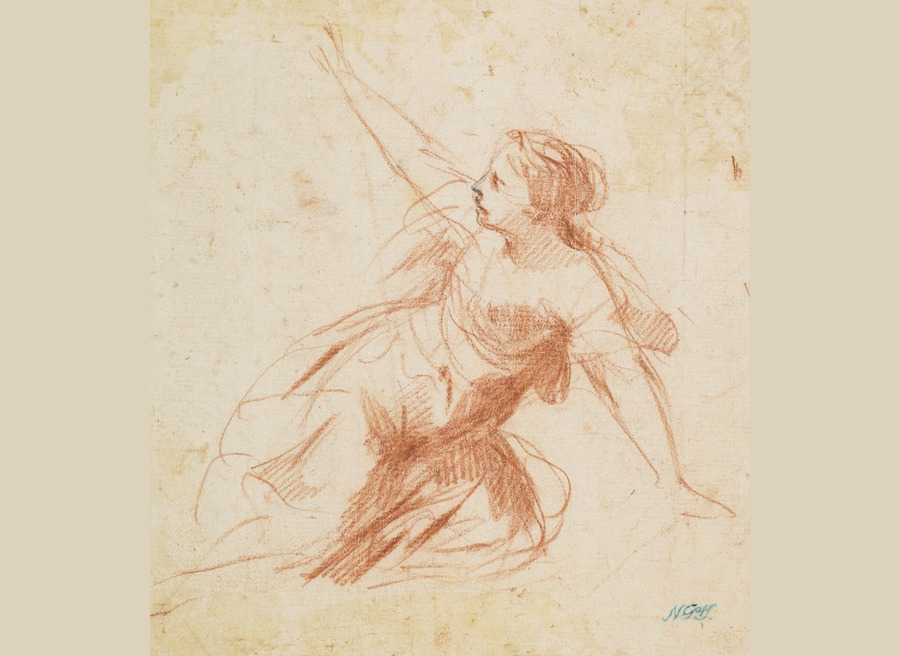 |
three minds | carrying | universal | joyful | |
Indian yogi poet K.V.Raghupathi describes the
• carrying mind, operating within the world, in time and space, heavy with mental impressions (samskaras), anxieties, aspirations, conflicts, playing havoc with our bodies
• universal mind, beyond duality, time and space, filled with compassion, maintaining ecological balance, attaining inner peace and happiness, comprehending and transcending the carrying mind
• joyful mind, a blissful state that arises as one lives in the universal mind, as the other side of the same coin
K.V.Raghupathi. The Three Minds. #689  |
2024 |
 |
three minds | nonidentity | identity | shared identity | |
Emergency physician Anoop Kumar addresses destructive behaviors with a call for a medicine based on three minds.
• First Mind: the mind is felt to be localized in or near the head or body of the individual. The mind is felt to be a subtle, internal, subjective phenomenon, in comparison to the more solid, palpable feel of the body and surrounding objects in the external, apparently objective environment. Here, mind and matter feel, and therefore are imagined to be, fundamentally different. Most essentially, the First Mind is characterized by boundedness (‘me’ in here and ‘world’ out there), and as a result, dichotomy.
• Second Mind: there are billions of individual minds like you and me on Earth, all of which exist as subsets of a single, experienceable Second Mind, which is simply another configuration of our identity. In between these First and Second Minds are the varied ranges of extended identities we describe as family, friendship, community, profession, race, and nation, often with deep meaning.
• Third Mind: the undifferentiated potential state of the world, prior to interpretation as discrete experiences across any subject-object interface. Therefore, the Third Mind can also be referred to as no mind, since in the absence of difference all concepts fail.
Anoop Kumar. The three minds: A framework beyond biopsychosocial medicine. #688  |
2021 |
 |
three minds | concreteness | concreteness | emptiness | |
Indian Buddhist monk Nāgārjuna, founder of the Mādhyamaka school of Mahāyāna Buddhism, distinguished two levels of satya (truth or reality).
• Provisional, conventional truth describes our daily experience of a concrete world. (Sanskrit saṁvṛti-satya, Pāli sammuti sacca, Tibetan kun-rdzob bden-pa)
• Ultimate truth describes ultimate reality as empty of concrete and inherent characteristics. (Sanskrit paramārtha-satya, Pāli paramattha sacca, Tibetan: don-dam bden-pa)
Wikipedia: Two truths doctrine #685  |
-200 |
 |
three minds | existence | emptiness | middle | |
Zhiyi, developer of the first Chinese Buddhist system, contemplated Nāgārjuna's Madhyamaka philosophy, notably its doctrine of two truths, and consequently discerned the Threefold Truth:
• All phenomena are empty (śūnya, 空 kong) of any independent self-nature or essence (svabhava).
• Phenomena exist (假, jia) provisionally, they conventionally arise through causes and conditions (i.e. dependent origination).
• The middle truth (中, zhong): phenomena are both empty of existence and exist provisionally. In the words of Zhiyi, wondrous being is identical to true emptiness.
Wikipedia: Tiantai: The Threefold Truth #684  |
580 |
 |
three minds | emotional | reasonable | wise | |
American pscyhologist Marsha M. Linehan developed Dialectical behavior therapy for personality disorders and interpersonal conflicts by integrating two concepts important for happy and meaningful lives: "accept things as they are" and "change is necessary". The goal is to achieve a wise mind (knowledge, experience, common sense) which synthesizes the rational mind (facts and logic are in control without emotions, such as love) and the emotional mind (emotions control thinking and behavior without reason).
Wikipedia: Marsha M. Linehan
Wikipedia: Dialectical behavior therapy
Marsha M. Linehan. Building a Life Worth Living #682  |
1986 |
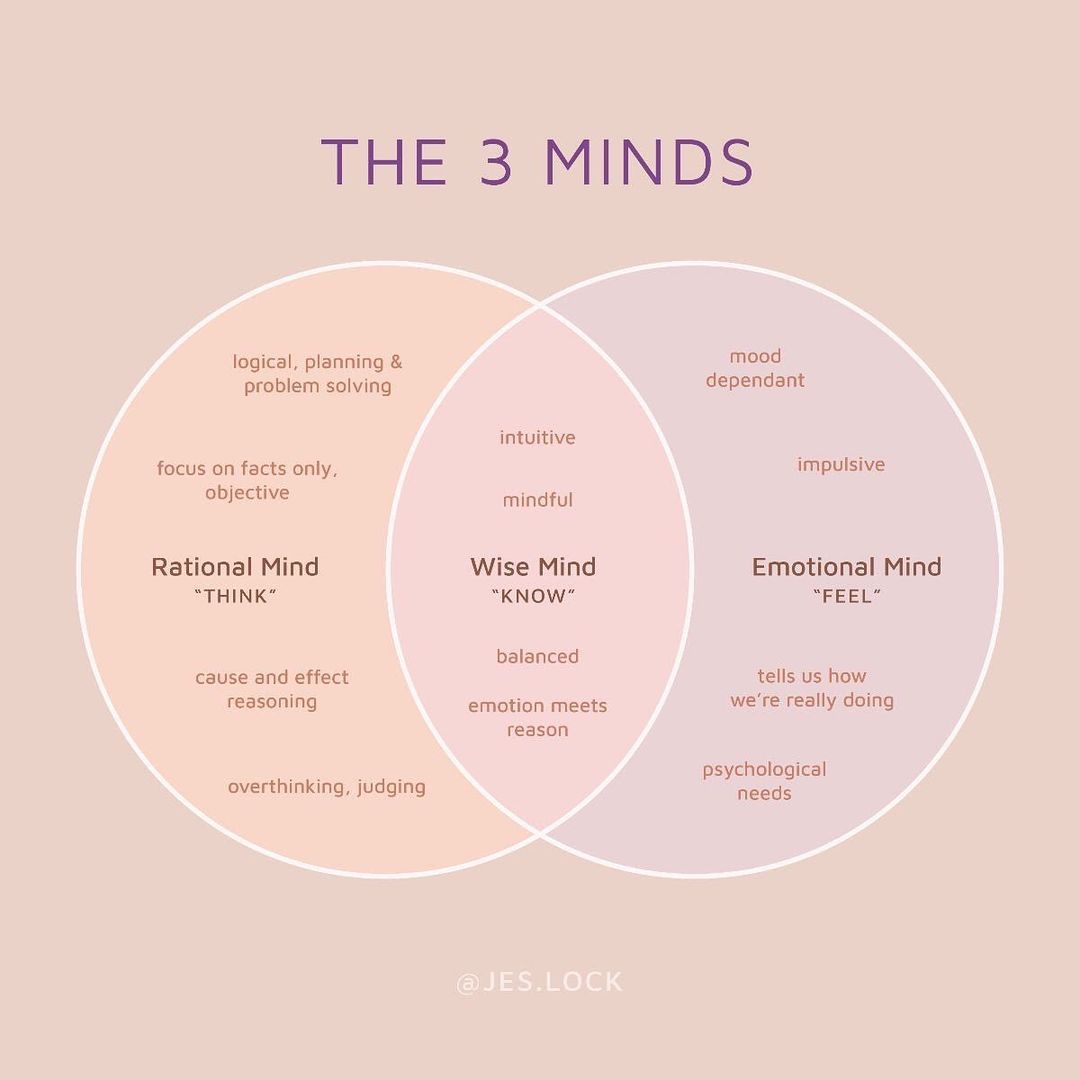 |
three minds | emotional | rational | wise | |
Chinese Peruvian Canadian mindset coach Jessica Lock learned from her therapist that our minds have three states.
• The Reasonable Mind is used when a person approaches a situation through logic. They plan and make decisions based on facts. It’s more objective.
• The Emotional Mind is used when feelings control a person’s thoughts and behavior. They might act impulsively with little to no regards to the consequences. Emotions let us know when boundaries have been crossed.
• The Wise Mind is the balance between the reasonable and emotional mind. The ideal state to be. They are able to recognize and respect their feelings. While responding to them in a rational matter. It’s also known as intuitive thinking.
Jessica Lock. Whole and Unleashed. The 3 Minds. #679  |
2019 |
 |
three minds | lust | hate | delusion | |
The Buddha, in the Fire Sermon, spoke of three fires which lead to all negative states.
The mind is burning, ideas are burning, mind-consciousness is burning, mind-contact is burning ... Burning with what? Burning with the fire of lust, with the fire of hate, with the fire of delusion.
In the Mahayana tradition they are known as the three poisons (kleshas), and in the Theravada tradition as the three unwholesome roots. They are symbolized by the rooster, snake, pig, respectively, at the center of the wheel of life. They feed on each other as a three-cycle. Their opposites, essential for liberation, are generosity (non-attachment), loving-kindness (non-hatred), wisdom (non-delusion).
Adittapariyaya Sutta: The Fire Sermon
Wikipedia: Ādittapariyāya Sutta
Wikipedia: Three poisons
Tricycle. What are the three poisons? (Greed, hatred and delusion) #676  |
-250 |
 |
three minds | motherly | joyful | vast | |
Japanese Zen Buddhist monk Dōgen Zenji taught in Instructions for the Cook:
When we train in any of the offices of the monastery we should do so with a joyful heart (kishin), a motherly heart (roshin), a vast heart (daishin).
• A "joyful heart" rejoices and recognizes meaning. It is grateful for what is. Feeding and serving others is not simply a job but an unconditional vow, independent of success or failure, an opportunity, using this body which is the fruition of thousands of lifetimes and births to create limitless benefit for numberless beings.
• A "motherly heart" [an old heart] is a heart which maintains the Three Jewels as a parent cares for a child. A parent raises a child with deep love, regardless of poverty or difficulties. Their hearts cannot be understood by another; only a parent can understand it. A parent protects their child from heat or cold before worrying about whether they themselves are hot or cold. This kind of care can only be understood by those who have given rise to it and realized only by those who practice it. This, brought to its fullest, is how you must care for water and rice, as though they were your own children.
• "Vast heart" is like a great expanse of ocean or a towering mountain. It views everything from the most inclusive and broadest perspective. This vast heart does not regard a gram as too light or five kilos as too heavy. It does not follow the sounds of spring or try to nest in a spring garden; it does not darken with the colours of autumn. See the changes of the seasons as all one movement, understand light and heavy in relation to each other within a view which includes both. ... Thus they lived as a great shout of freedom through presenting the Great Matter, penetrating the Great Question, training great disciples and in this way bringing it all forth to us.
Eihei Dogen zenji. Tenzo kyokun: Instructions for the Tenzo
Lion's Roar. What Are the Three Minds? #675  |
1237 |
 |
three minds | overflow of feelings | simple language | recollection in tranquility | |
English Romantic poet William Wordsworth explained his novel style.
... I believe that my habits of meditation have so formed my feelings, as that my descriptions of such objects as strongly excite those feelings, will be found to carry along with them a purpose...
... to illustrate the manner in which we associate ideas in a state of excitement. Low and rustic life was generally chosen because in that situation the essential passions of the heart find a better soil...
... being less under the action of social vanity they convey their feelings and notions in simple and unelaborated expressions. Accordingly such a language arising out of repeated experience and regular feelings is a more permanent and a far more philosophical language ...
... Poetry is the spontaneous overflow of powerful feelings: it takes its origin from emotion recollected in tranquillity...
Lyrical Ballads, with Other Poems, 1800, Volume 1. Preface. #674  |
1800 |
 |
three minds | innate free natural instinct | narrow limits of an antiquated world | | |
German author Johann Wolfgang von Goethe, at the age of 24, wrote the classic of the Sturm and Drang proto-romantic movement, The Sorrows of Young Werther. Fifty years later, he reflected
...it does not belong to the course of universal culture, but to the career of life in every individual, who, with an innate free natural instinct, must accommodate himself to the narrow limits of an antiquated world. Obstructed fortune, restrained activity, unfulfilled wishes, are not the calamities of any particular time, but those of every individual man; and it would be bad, indeed, if every one had not, once in his life, known a time when ‘Werther’ seemed as if it had been written for him alone.
Wikipedia: The Sorrows of Young Werther #673  |
1774 |
 |
three minds | emotionality | rationality | | |
Sturm und Drang was a proto-Romantic movement in German literature, music and art that reacted to rationalism by exalting character, subjectivity, emotional turbulence and extremes. The movement was named after Friedrich Maximilian Klinger's play, which presented temperamental characters inspired by Shakespeare on a background of the tumult of the American Revolutionary War.
Wikipedia: Sturm und Drang #672  |
1776 |
 |
three minds | forgetful functor | free functor | | |
Dutch mathematician Daniel Kan introduced the concept of adjunction F⊣G. Adjoint functors F:X→Y, G:Y→X express a natural equivalence α:Hom(F(X),Y)→Hom(X,G(Y)), and thereby create an analogy between two categories X and Y, establishing a window, sharing the same information, objects and morphisms, back and forth across it. An important example is when
• G is a forgetful functor, ignoring some aspect of structure (for example, reducing a vector space to the underlying set of its elements) but retaining the characteristic network of morphisms.
• F is a free functor, freely generating, constructing, filling in the structure required by the target category (for example, generating a vector space from a basis given by the underlying set).
Daniel Kan. Adjoint functors.
Wikipedia: Forgetful functor #671  |
1958 |
![]() |
three minds | inner voice creates | external voice reflects | | |
Isaiah Berlin, historian of ideas, in his lecture series, "The Roots of Romanticism", described its aesthetics.
the notion of eternal models, a Platonic vision of ideal beauty, which the artist seeks to convey, however imperfectly, on canvas or in sound, is replaced by a passionate belief in spiritual freedom, individual creativity. The painter, the poet, the composer do not hold up a mirror to nature, however ideal, but invent; they do not imitate (the doctrine of mimesis), but create not merely the means but the goals that they pursue; these goals represent the self-expression of the artist's own unique, inner vision, to set aside which in response to the demands of some "external" voice—church, state, public opinion, family friends, arbiters of taste—is an act of betrayal of what alone justifies their existence for those who are in any sense creative.
Wikipedia: Romanticism #670  |
1965 |
 |
three minds | wide variety of experiences | single defining idea | | |
Latvian-Jewish-British thinker Isaiah Berlin authored a popular essay which was received as an intellectual cocktail-party game. He divided thinkers into two categories:
• hedgehogs (Plato, Lucretius, Blaise Pascal, Marcel Proust, Fernand Braudel) view the world through the lens of a single defining idea
• foxes (Aristotle, Desiderius Erasmus, Johann Wolfgang Goethe) draw on a wide variety of experiences and do not distill a single idea
He perceived a conflict in Leo Tolstoy, who he described as a fox by nature but a hedgehog by conviction.
Wikipedia: The Hedgehog and the Fox #669  |
1953 |
 |
three minds | know many things | know one big thing | | |
Greek lyric poet Archilochus, according to Aristotle, contemplated
a fox knows many things, but a hedgehog knows one big thing
Wikipedia: The Hedgehog and the Fox #668  |
-650 |
![]() |
three minds | sensations | relations | previous truths | |
American pragmatist William James noted three parts of reality that control the formation of our beliefs.
• Sensations are forced upon us, coming we know not whence. Over their nature, order, and quantity we have as good as no control. THEY are neither true nor false; they simply ARE. It is only what we say about them, only the names we give them, our theories of their source and nature and remote relations, that may be true or not.
• RELATIONS that obtain between our sensations or between their copies in our minds. This part falls into two sub-parts: 1) the relations that are mutable and accidental, as those of date and place; and 2) those that are fixed and essential because they are grounded on the inner natures of their terms—such as likeness and unlikeness. Both sorts of relation are matters of immediate perception. Both are 'facts.' But it is the latter kind of fact that forms the more important sub-part of reality for our theories of knowledge. Inner relations namely are 'eternal,' are perceived whenever their sensible terms are compared; and of them our thought—mathematical and logical thought, so-called—must eternally take account.
• PREVIOUS TRUTHS of which every new inquiry takes account. This third part is a much less obdurately resisting factor: it often ends by giving way.
William James. Pragmatism: A New Name for Some Old Ways of Thinking #667  |
1907 |
 |
three minds | preaching | prosecuting | politicking | |
American organization psychologist Adam Grant authored a book on individual, interpersonal and collective rethinking. He attributed to Phil Tetlock the following three mindsets we take up in thinking and talking.
The risk is that we become so wrapped up in preaching that we're right, prosecuting others who are wrong, and politicking for support that we don't bother to rethink our own views.
An alternative is a fourth way of thinking, scientific, based on the scientific method, focused on rethinking, on knowing what we don't know.
Adam Grant. Think Again: The Power of Knowing What You Don't Know. #666  |
2021 |
![]() |
three minds | irrational | rational | education | |
American psychotherapist Albert Ellis developed rational emotive behavior theory. Faced with adversity, people choose between innate responses:
• rational (self-helping, socially helping, constructive) making themselves feel sorry, disappointed, frustrated, or annoyed, which is healthy and self-helping.
• irrational (self-defeating, socially defeating, unhelpful) making themselves feel horrified, terrified, panicked, depressed, self-hating, self-pitying, which is healthy and self-defeating. Responding to adversity irrationally leads to emotional difficulties (self-blame, self-pity, clinical anger, hurt, guilt, shame, depression, anxiety) and unhealthy behavior (procrastination, compulsiveness, avoidance, addiction, withdrawal).
An alternative is:
• education, whereby the therapist teaches the client to identify irrational, self-defeating, rigid, extreme, unrealistic, illogical, absolutist outlooks, to actively question them and replace them with rational, self-helping ones.
Wikipedia: Rational emotive behavior therapy #661  |
1955 |
 |
three minds | intuition | rationalization | discussion | |
American moral psychologist Jonathan Haidt, the founder of social intuitionism, argues that moral positions primarily arise from intuitions, are then rationalized and justified, are taken mainly to influence others, but are often influenced and sometimes changed through discussions with others.
Wikipedia: Social intuitionism
Jonathan Haidt. The emotional dog and its rational tail: A social intuitionist approach to moral judgment.
#658  |
2001 |
 |
three minds | automatic | controlled | | |
American social pscyhologist Jonathan Haidt, in The Happiness Hypothesis, presents a metaphor of the two sides of a person.
• The elephant is their automatic, implicit processes, which provide the power for their journey.
• The rider is their controlled, reasoned processes, which see the path ahead.
Self-improvement depends on training the elephant.
Wikipedia: The Happiness Hypothesis: Ch.1: The divided self #657  |
2006 |
 |
three minds | think one knows | know nothing | be conscious | |
In Plato's Apology, Socrates, at his trial in Athens for impiety and corrupting the youth, said
...although I do not suppose that either of us knows anything really beautiful and good, I am better off than he is - for he knows nothing, and thinks that he knows. I neither know nor think that I know.
...I was conscious that I knew nothing at all...
Wikipedia: I know that I know nothing
Plato. Apology. #655  |
-399 |
 |
threesome | choosing | living | examining | |
Socrates, in Plato's Apology, in his own defense at his trial for impiety and corrupting the youth, explained why he chose death over exile as a punishment, for to be exiled from the elenchus (Socratic discourse) in Athens, would keep him from examining his life, thus from loving wisdom. In short,
...the life which is unexamined is not worth living...
Wikipedia: The unexamined life is not worth living
Plato. Apology. #654  |
-399 |
![]() |
three minds | consumption | distribution and exchange | production | |
German political economist Karl Marx, in Critique of Political Economy, distinguished the parts of a syllogism
• production - the social point of departure, the general case, determined by laws of nature, whereby individual within and with the help of a definite social organisation appropriate nature, according to human requirements, with the mode of production giving rise to legal relations and political forms, whereby persons become objective, are themselves consumed as are the means of production
• consumption - the ultimate goal, the individual case, where products become direct objects of use, subjective, serving individual needs, falling outside economy, except to stimulate production
• distribution - the middle, the particular case, determined by random social factors, the portion of products accruing to the individual, actuated by society, mediated by social laws
• exchange - the middle, the particular case, determined by a formal movement in society, the products which the individual claims, actuated by individuals
Karl Marx: A Contribution to the Critique of Political Economy. #652  |
1857 |
 |
three minds | disorder | order | | |
German classical scholar Friedrich Nietzsche, in The Birth of Tragedy, argued that classic Athenian tragedies fused two artistic impulses.
• Apollonian (named after Apollo, the god of archery, music and dance, truth and prophecy, healing and diseases, Sun and light, poetry), expressed by dialogue - a dreaming state, full of illusions, valuing mind, order, harmony, progress, clarity, logic and affirming individuation.
• Dionysian (named after Dionysus, the god of wine-making, orchards and fruit, vegetation, fertility, festivity, insanity, ritual madness, religious ecstasy, and theatre), expressed by the music of the chorus - a state of intoxication, knowledge that actions are powerless, the liberation of instinct and dissolution of boundaries, manifesting disorder, passion, chaos, emotion, ecstasy and unity, the destruction of individuation.
The protagonist of a tragedy struggles but fails to impose Apollonian order on his, unjust, chaotic, Dionysian fate. The audience thus senses the Primordial Unity, experiences the fullness and plentitude of frenzy.
Wikipedia: Friedrich Nietzsche #651  |
1872 |
 |
three minds | exception | rule | | |
"The exception proves the rule" is a saying that derives from the medieval Latin legal principle exceptio probat regulam in casibus non exceptis ("the exception tests the rule in the cases not excepted").
Wiktionary: Exception that proves the rule #649  |
1050 |
![]() |
onesome | love | | | |
Massachusetts poet Emily Dickinson contemplated
That Love is all there is,
Is all we know of Love;
It is enough, the freight should be
Proportioned to the groove.
Wikisource: That Love is all there is #648  |
1863 |
![]() |
three minds | tacit knowledge | explicit knowledge | | |
Hungarian-British chemist and social scientist Michael Polanyi, in "Personal Knowledge", distinguished
• tacit knowledge, which may be skills, ideas and experiences, that animals and people possess - such as knowing how to ride a bicycle, play a piano, or solve a math puzzle - which they themselves may not even be aware of, or be able to explain, but may transmit by interacting with others, and be gained through practical experience, thus is always personal and contextual - and indeed all knowledge at its root is tacit
• explicit knowledge, that which humans articulate and codify, and transfer independently of the knower
Wikipedia: Tacit knowledge #642  |
1958 |
 |
three minds | pain of past | tormentor of future | joy of present moment | |
German-born self-help author Eckhart Tolle taught in "The Power of Now: A Guide to Spiritual Enlightenment" that
• only the present moment is real and matters, and the ever present "I am" is the source of joy
• an individual's past and future are products of their minds, illusions created by their thoughts, which bring pain that can feed only on pain, converting the personal ego into a tormentor
Wikipedia: Eckhart Tolle #641  |
1997 |
 |
three minds | machine | ghost | | |
British philosopher Gilbert Ryle, in "The Concept of Mind", critiqued Cartesian rationalism, the notion that the mind is distinct from the body, referring to it as "the ghost in the machine". He argued that both idealist and materialst philosophers make the category mistake of analyzing "mind" and "body" as if they belonged to the same category, reducing physical reality and mental reality to the same status.
Wikipedia: Ghost in the machine
Gilbert Ryle. The Concept of Mind. #629  |
1949 |
![]() |
foursome | neuropsychology | metaphysics | epistemology | |
Author Iain McGilchrist introduces his book "The Matter With Things":
This book is what would conventionally be called a single argument. That is why I have chosen not to publish it as three separate books: one on neuropsychology - how our brains shape reality; one on epistemology - how we can come to know anything at all; and one on metaphysics - the nature of what we find in the cosmos.
Iain McGilchrist.The Matter With Things: Our Brains, Our Delusions and the Unmaking of the World. #625  |
2021 |
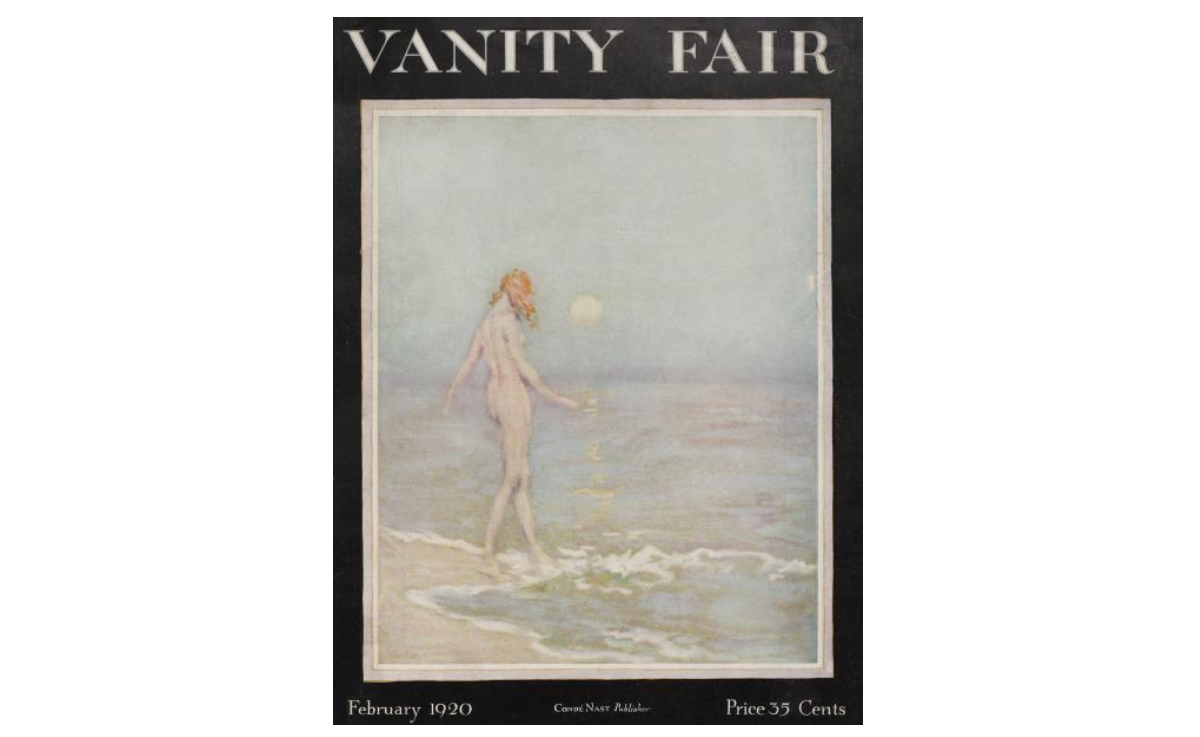 |
twosome | not dividing people into two classes | dividing people into two classes | | |
American humorist Robert Benchley quipped, in an "extremely literary review" of The New York City Telephone Directory.
There may be said to be two classes of people in the world; those who constantly divide the people of the world into two classes, and those who do not. Both classes are extremely unpleasant to meet socially, leaving practically no one in the world whom one cares very much to know.
Quote Investigator #624  |
1920 |
![]() |
foursome | psychomotor | cognitive | affective | |
A committee of educators chaired by Benjamin Bloom developed Bloom's taxonomy as a framework for categorizing educational goals. Learning objectives are divided into three broad domains.
• cognitive (knowledge-based) with six levels: Knowledge, Comprehension, Application, Analysis, Synthesis, Evaluation
• affective (emotion-based) with five levels: Receiving, Responding, Valuing, Organizing, Characterizing
• psychomotor (action-based), categorized in 1972 by Elizabeth Simpson with seven levels: Perception, Set, Guided response, Mechanism, Complex overt response, Adaptation, Origination
Wikipedia: Bloom's taxonomy #623 ❤️MP  |
1956 |
 |
three minds | animal | tracks | guess | |
The Lithuanian verb minti means to think, and specifically, to guess a riddle, but also to tread or to step, for example, into mud. This suggests that hunters guessed an animal from its tracks by stepping into the tracks with their minds. This "stepping into" may have served as the metaphor for thinking. The Proto-Indo-European root men- (to think) persisted in English as mind and mental, Latin as mens, Greek as menos and mathema and Sanskrit as mantra.
Wikipedia: Indo-European vocabulary #621  |
-2500 |
 |
three minds | verbal hallucinations | obeying | consciousness | |
American psychologist Julian Jaynes explained consciousness as a learned behavior that arose from language and, specifically, metaphor. He argued from ancient texts and archaeology that consciousness arose during the 2nd millenium BCE and that prior to that there existed a non-conscious mentality, the bicameral mind, based on the brain's two hemispheres. Ancient people (much like schizophrenics today) hallucinated voices (from their right brain), which they experienced as commands from external gods, reflecting their own desires, which they were obliged to hear and obey (with their left brain). They did not have meta-reflection, metaconsciousness, self-awareness, any conception of why they did what they did, or any notion of mind.
Wikipedia: Bicameral mentality
Wikipedia: The Origin of Consciousness in the Breakdown of the Bicameral Mind
Wikipedia: Julian Jaynes #620  |
1976 |
![]() |
three minds | sense perception | metaphors | introspection | |
American psychologist Julian Jaynes researched animal learning, natural animal behavior, comparative psychology. He spoke on consciousness at the annual meeting of the American Psychological Association, noting that 20th century thinkers could distinguish sense perception from introspection, though they doubted the latter but not the former. He explained introspection as dependent more on culture and language, especially metaphors, rather than physiology.
Wikipedia: Julian Jaynes #619  |
1969 |
![]() |
three minds | parallel processing | serial processing | | |
Gillian Cohen conducted an experiment on the response times of 6 right-handed undergraduates as to judge whether items in a set were all the same or whether one was different. In the left visual field, increasing the size of the set did not increase response time, indicating parallel processing. In the right visual field, it did increase response time, indicating serial processing.
Gillian Cohen. Hemispheric differences in serial versus parallel processing.
Open University. Gillian Cohen.
John Cutting. Principles of psychopathology: two worlds, two minds, two hemispheres #618  |
1973 |
![]() |
three minds | judge difference | judge sameness | | |
Experimental psychologists Howard Egeth and J.Epstein conducted an experiment on the response times of 20 right-handed men as to whether two letters were the same or different. When the letters were in the left visual field, then response times were faster for difference, whereas in the right visual field, response time were faster for sameness.
Differential specialization of the cerebral hemispheres for the perception of sameness and difference.
John Cutting. Principles of psychopathology: two worlds, two minds, two hemispheres #617  |
1972 |
![]() |
three minds | analogue codes | symbolic codes | | |
Canadian psychologist Allan Paivio characterized the brain's left hemisphere as specialized for abstraction and the right hemisphere as specialized for imagery. He developed dual-coding theory, which asserts that memories are stored by two different systems, which together make for more robust memories, helpful in learning.
• Analogue codes mentally represent images. They retain the main perceptual features of what is remembered.
• Symbolic codes form representations of words, conceptually, perhaps arbitrarily.
Wikipedia: Dual-coding theory
Wikipedia: Allan Paivio
John Cutting. Principles of psychopathology: two worlds, two minds, two hemispheres #616  |
1971 |
![]() |
three minds | adjacency | proposition | | |
American neurophysiologist Joseph Bogen characterized the brain's left hemisphere as propositional and the right hemisphere as appositional (thinking in terms of adjacencies).
John Cutting. Principles of psychopathology: two worlds, two minds, two hemispheres #615  |
1969 |
![]() |
three minds | | language | | |
Japanese neurologist Juhn Atsushi Wada applied local anesthesia to a single brain hemisphere of his patients to determine if they used that hemisphere for representing language. This is known as the Wada test.
David W. Loring, Kimford J. Meador. History of the Wada Test
#614  |
1949 |
![]() |
three minds | | language | | |
American neurosurgeon W.James Gardner applied local anesthesia to a single brain hemisphere of his patients to determine if they used that hemisphere for representing language.
David W. Loring, Kimford J. Meador. History of the Wada Test
#613  |
1941 |
![]() |
three minds | pictorial | verbal | | |
British-Canadian neuropsychologist Brenda Milner found that psychological tests had predictive value in predicting which temporal lobe had a pathogenic lesion. She concluded
The left temporal lobe contributes to the rapid understanding and subsequent retention of verbally expressed ideas ... the right minor temporal lobe on the other hand appears to be more critically involved in perceptual than in verbal skills ... the right temporal lobe facilitates rapid visual identification and in this way it enters into the comprehension of pictorially expressed ideas ... these differences relate to the functional asymmetry of the two hemispheres, the left being primarily concerned with verbal, the right with non-verbal skils.
John Cutting. Principles of psychopathology: two worlds, two minds, two hemispheres #612  |
1958 |
![]() |
three minds | emotional speech | intellectual speech | | |
English neurologist John Hughlings Jackson, in discussing Broca's aphasia resulting from disease of the left frontal lobe, noted that the disease affected all forms of intellectual speech, whether by words, writings or signs, but not emotional speech. He also documented evidence of a mental disorder experienced by patients whose right hemisphere was damaged: they had problems expressing emotional speech (swear words, exclamations), recognizing objects, persons, places, summating sensory information from all parts of the body, and becoming objectively conscious of visual objects in the outside world.
An Introduction to the Life and Work of John Hughlings Jackson
John Cutting. Principles of psychopathology: two worlds, two minds, two hemispheres #611  |
1866 |
![]() |
nullsome | the Absolute | | | |
German idealist Friedrich Wilhelm Joseph von Schelling contemplated how God, the Absolute, relates to its own ground, endlessly beginning, a devouring ferocity of purity.
Now if the appearance of freedom is necessarily infinite, the total evolution of the Absolute is also an infinite process, and history itself a never wholly completed revelation of that Absolute which, for the sake of consciousness, and thus merely for the sake of appearance, separates itself into conscious and unconscious, the free and the intuitant; but which itself, however, in the inaccessible light wherein it dwells, is Eternal Identity and the everlasting ground of harmony between the two. (System of Transcendental Idealism)
Wikipedia: Friedrich Wilhelm Joseph Schelling #607  |
1800 |
![]() |
onesome | Unconscious | | | |
German philosopher Eduard von Hartmann, author of Philosophy of the Unconscious, conceived the Unconscious as the absolute all-embracing ground of all existence, including both primal Will and latent Reason.
Wikipedia: Eduard von Hartmann #606  |
1869 |
![]() |
three minds | beautiful and ugly | right and wrong | true and false | |
German philosopher Max Scheler, in "Formalism in Ethics and Non-Formal Ethics of Values", stratified human emotional life. He matched feelings with values, and ranked them on four levels, from lowest to highest:
• sensual values of the agreeable and the disagreeable
• vital values of the noble and vulgar, strength and weakness, healthiness and unhealthiness
• mental (psychic) values of the beautiful and ugly, right and wrong and truth and falsehood
• values of the Holy and Unholy of the Divine and Idols.
Wikipedia: Stratification of emotional life (Scheler)
Wikipedia: Max Scheler #601  |
1916 |
 |
three minds | water | stone | | |
Lithuanian painter Gabrielė Aleksė, inspired by Iain McGilchrist's book "The Master and the Emissary", exhibited a series of paintings "Water and Stone" at the Antanas Mončys art gallery in Palanga, Lithuania.
• Water symbolizes the right hemisphere. Water represents intuition, holistic understanding, the flow of life, the ability to see and feel the world through peace, a grasp of the moment, a feeling of eternity, religious experience, appreciating religious texts and myths, the world of childhood, full of miracles and spirituality.
• Stone symbolizes the left hemisphere. Stone is the solid foundation for the unfolding of Western civilization, which she presents through architectural compositions, the construction of an unchanging, eternal, safe environment, a composition of units, which can be controlled and governed, a transformation of the environment, a sign of progress and expansion, accompanied with cold doubt and skepticism.
Visit Palanga. Gabrielės Aleksės tapybos paroda "Vanduo ir Akmuo" #594  |
2024 |
![]() |
three minds | individual things | classes of things | | |
British psychiatrist John Cutting studied philosophy (Kant, Schopenhauer, Bergson, Sartre, Merleau-Ponty, Arendt) to understand psychopathology. He analyzed hallucination, illusion, anomalous experience, agnosia and delusion in terms of distinctions in brain hemispheres.
• the right hemisphere considered individual things
• the left hemisphere considered classes of things
John Cutting. Principles of psychopathology : two worlds, two minds, two hemispheres. #593  |
1997 |
 |
foursome | insertion | injection | surjection | collapse |
French mathematician Évariste Galois developed the notions of normal group N, quotient group Q, solvable group and with them, the extension problem of what groups G are extensions of N by Q. In modern terminology, the extension problem is described by a short exact sequence, consisting of four group homomorphisms, where the image of one homomorphism is the kernel of the next homomorphism.
• e:1→N is the insertion of the trivial group 1 into N
• f:N→G is an injection from N into G
• g:G→Q is a surjection from G into Q
• h:Q→1 is the collapse of Q into the trivial group 1
Wikipedia: Group extension
Wikipedia: Évariste Galois #592  |
1832 |
 |
three minds | self-acquaintance | self-explanation | self-consciousness | |
Johann Gottlieb Fichte, expounder of transcendental idealism, in his "Attempt at a New Presentation of the Science of Knowledge", examined the conditions for consciousness of the self.
• the self, prior to reflection, acting freely, has acquaintance with itself, by which it discovers its own limitations
• the self posits the not-I in order to explain to itself its limitations
• the self posits and grows conscious of others and itself as rational subjects by taking up the call to exercise freedom respectfully
Wikipedia: Johann Gottlieb Fichte #591  |
1797 |
 |
three minds | inward light | ministry | silence | |
George Fox, founder of the Religious Society of Friends, who first called themselves Children of the Light, Friends of Truth, and are widely known as the Quakers, taught that if people would be silent, waiting on God, the Light within them would teach them how to conduct their lives, teach them about Christ. Friends also listen to the wisdom of other Friends, in their ministry, as the Spirit moves them to speak from their experience about the inward Light.
I was glad that I was commanded to turn people to that inward light, spirit, and grace, by which all might know their salvation, and their way to God; even that divine Spirit which would lead them into all Truth, and which I infallibly knew would never deceive any.
Wikipedia: Inward light #589  |
1650 |
![]() |
twosome | real content | ideal content | | |
Austrian-German philosopher Edmund Husserl distinguished for an intentional act, an act of consciousness, such as judging, perceiving, loving, hating, accepting, rejecting:
• noesis - real content, which gives it a particular sense or character, which is actually part of what takes place in the consciousness of the subject.
• noema - ideal content, the ideal meaning of the act, which may be complex.
Wikipedia: Phenomenology (philosophy): Noesis and noema
Ideas: General Introduction to Pure Phenomenology #587  |
1913 |
![]() |
foursome | eidetic variation | époche | phenomeno-logical reduction | intersubjective corroboration |
Philosophers Shaun Gallagher and Dan Zahavi describe four steps of the phenomenological method.
• époche: Suspend all theoretical and common sense assumptions about reality so as to attend anew to what is directly given in experience.
• phenomenological reduction: Analyze the correlations between what is given in experience and specific structures of subjectivity shaping and enabling this givenness. This "leads back" (Latin: re-ducere) to the world.
• eidetic variation: Imaginatively strip away the properties of things to determine their essense (eidos), their characteristics which make them what they are.
• intersubjective corroboration: Share results with the larger research community, sort out what idiosyncratic to an individual researcher and what is structurally essential for experience.
Wikipedia: Phenomenology (philosophy)
Shaun Gallagher, Dan Zahavi. The Phenomenological Mind. 2nd edition. #586  |
2007 |
![]() |
three minds | sensory consciousness | noetic consciousness | | |
German philosopher, psychologist and former priest Franz Brentano revived the medieval notion of intentional object. In "Psychology from an Empirical Standpoint", he distinguished
• sensory consciousness of sensory objects or intuitions, arising from physical phenomena, manifesting derived intentionality
• noetic consciousness of concepts, psychological phenomena, containing within themselves original intentionality
Every mental phenomenon is characterized by what the Scholastics of the Middle Ages called the intentional (or mental) inexistence of an object, and what we might call, though not wholly unambiguously, reference to a content, direction towards an object (which is not to be understood here as meaning a thing), or immanent objectivity. Every mental phenomenon includes something as object within itself, although they do not all do so in the same way. In presentation something is presented, in judgement something is affirmed or denied, in love loved, in hate hated, in desire desired and so on. This intentional in-existence is characteristic exclusively of mental phenomena. No physical phenomenon exhibits anything like it. We could, therefore, define mental phenomena by saying that they are those phenomena which contain an object intentionally within themselves.
Wikipedia: Franz Brentano #585  |
1873 |
 |
three minds | gesture | speech | | |
American psycholinguist David McNeill argues that speaking while thinking, as an activity, depends on psychological units, pulses - growth points - where gesture and speech are coordinated, providing grounds for unfolding speech and thought further. Gesture manifests the speaker's existence and is always supposed but can be emphasized more or less.
• Gesture is top down, global (the meaning of the parts - hand shapes, space, direction, articulation - all depend on the whole), and synthetic (several meanings are bundled into a single gesture).
• Speech is bottom up, combinatoric, analytic - the pieces have independent meaning.
Wikipedia: David McNeill
David McNeill. Hand and Mind: What Gestures Reveal About Thought. #582  |
1992 |
 |
three minds | pinball wizard | engaging the mirror | deaf, dumb, blind | |
The English rock band The Who, and specifically, guitarist Pete Townshend, created the rock opera Tommy, inspired by the teachings of Meher Baba. As a child, traumatized by his parents, Tommy is deaf, dumb and blind to the outside world; becomes a champion pinball player; engages himself in the mirror; starts a religious movement based on eliminating sensory input.
Wikipedia: Tommy (The Who album) #580  |
1969 |
 |
three minds | subconscious | conscious | superconscious | |
Monk, yogi and guru Paramahansa Yogananda, in his Autobiography of a Yogi, distinguished three intensities of awareness:
• subconscious - remembered experiences, their impressions, resulting tendencies, a flow of ideas, unfulfilled desires, the stuff of dreams, open to intuitions.
• conscious - rational awareness, analyzing facts, solving problems, thinking in categories, guiding decisions, seeing all possibilities, unable to select the best, thus perpetually uncertain, influenced by others.
• superconscious - unitive, sees all things as part of the whole, seeing a solution as an outgrowth of a problem, understanding that the world is a delusion, not attaching oneself to one's body or external relaties or what others think.
Paramahansa Yogananda. Autobiography of a Yogi.
Ananda. The Three Levels of Consciousness.
#577  |
1946 |
![]() |
three minds | body | mind | soul | |
Indian American Hindu monk Paramahansa Yogananda, in his Autobiography of a Yogi, taught the superiority of mind over body and soul over mind. Man should be liberated from threefold suffering: physical disease, mental inharmonies, and spiritual ignorance.
Wikipedia: Paramahansa Yogananda
Paramahansa Yogananda. Autobiography of a Yogi. #576  |
1946 |
![]() |
foursome | storehouse of karma | sensory integration | abstract inner thoughts | pure coexistence |
Japanese Buddhist priest Nichiren (1222-1282) referred to the ninth consciousness (amala in Sanskrit) as the palace of the body, which can be accessed by chanting Namu-myoho-renge-kyo. In Buddhism, the first five consciousnessess are the senses: touch, taste, sight, hearing, smell.
• Sixth consciousness is the processing and integration of the sensory input, identifying what it communicates, enabling judgments, yielding the sentient mind.
• Seventh consciousness (mano) is directed towards one's inner thoughts, without sensory input, deals with the abstract, distinguishes good and evil, ourselves and others, is aware of the self, can attach or detach, be assertive of one's identity.
• Eighth consciousness (alaya) is the storehouse which accumulates all of one's karmic energy from interacting with others, the causes and effects of one's actions, a lifetime's thoughts, words and deeds, which persists into one's subsequent lives, flowing onward.
• Ninth consciousness (amala) is pure, the Buddha nature, which karma cannot tarnish, the core of all energy, the source for all mental and spiritual activity, coexisting peacefully with all life.
Wikipedia: The Nine Consciousness
Nichiren. The Real Aspect of the Gohonzon.
Nichiren Buddhism Library. Nine Consciousnesses #574  |
1270 |
 |
three minds | matter | energy | | |
British leadership theorist Richard Barrett, in his book What My Soul Told Me, distinguishes:
• ego - conscious awareness that identifies with one's physical body, which thinks that it inhabits in a material world, can die, and has needs of survival, safety, security, thus fears its needs will not be met. It its the one who one thinks one is, and the personality mask one wears to get one's needs met.
• soul - individuation of the universal energy field from which everything arises, which identifies with that field, lives in a state of oneness, gives and receives, desires to express its unique talents, connect with others unconditionally, contribute to well-being, thus creates whatever it desires through thoughts, knows it cannot die, has no needs, yet creates an ego to buffer itself from the pain of separation it experiences in the material world.
Barrett Academy for the Advancement of Human Values: Ego-Soul Dynamics #573  |
2012 |
 |
three minds | see | talk | | |
Tibetan Buddhist scholar Sakya Pandita (1182–1251) declared in his Treasury of Valid Reasoning:
The sense consciousnesses are like a dumb person who can see.
And conceptual mind is like a blind person who can talk.
Rigpa Shedra Wiki: Six Consciousnesses
#570  |
1240 |
![]() |
foursome | phenomenal quality | semantic abstraction | physiological complexity | functional usefulness |
Jonkisz, Wierzchoń and Binder describe consciousness as varying along four dimensions:
• phenomenal quality - the experiential, non-relational aspect of individuated, subjective consciousness - ‘what it is like’ to see something, feel pain, move, talk, think
• semantic abstraction - aboutness - referential, transitive, intentional content, conveying meaning, the relational aspect
• physiological complexity - structural, physical, embedded processes, bodily mechanisms, vehicles of consciousness in an organism
• functional usefulness - pragmatically, for survival, ‘what conscious information affords’ a creature’s actions
Jakub Jonkisz, Michał Wierzchoń, Marek Binder. Four-Dimensional Graded Consciousness. #569  |
2017 |
 |
three minds | radiating vibration | floating form | | |
British theosophists Annie Bessant and Charles Webster Leadbeater taught that each definite thought produces a double effect:
• radiating vibration, which resonates with a particular mental body, and more strongly, the more clear it is.
• floating form, which is collected by the thought from the strange half-intelligent life which surrounds us, and given a particular shape, and which may hover by its creator, or whichever person it is about, or may otherwise float detached.
Annie Bessant, C.W. Leadbeater. Thought-Forms. #562  |
1905 |
 |
three minds | color | form | clarity of outline | |
British theosophists Annie Bessant and Charles Webster Leadbeater, in their book "Thought-Forms: A Record of Clairvoyant Investigation", proclaimed that thoughts are things which the mind extrudes into the world. The production of all thought-forms is based on three major principles:
• Quality of thought (the emotional state) determines colour.
• Nature of thought (the juxtaposition of states) determines form.
• Definiteness of thought (the clarity of representation) determines clearness of outline.
Wikipedia: Thought-Forms
Annie Bessant, C.W. Leadbeater. Thought-Forms. #561  |
1905 |
 |
foursome | likelihood | evidence | hypothesis | posterior probability |
Reverend Thomas Bayes stated Bayes Theorem for inverting conditional probabilities. The theorem appears symmetrical yet is typically interpreted to relate a causal hypothesis H and sensory evidence E
• H is a hypothesis that can be affected by data. P(H) is the prior probability, the estimate of the probability of H before the evidence is observed.
• E is the evidence, new data not used to compute the prior probability. P(E) is the overall probability of observing E, the marginal likelihood.
• P(H | E) is the posterior probability, the probability of H after E has been observed. It is a function of the hypothesis. It is a belief why.
• P(E | H) is the likelihood, the probability of observing E given H, thus the compatibility of the evidence with the hypothesis. It is a function of the evidence. It is a belief whether.
Wikipedia: Bayesian inference
Wikipedia: Bayes' theorem #516  |
1763 |
![]() |
nullsome | the First and the Last | | | |
The Book of Isaiah includes a clear statement of monotheism.
Thus saith the Lord, the King of Israel,
And his Redeemer, the Lord of hosts:
I am the First and I am the Last;
and beside Me there is no God.
Wikipedia: Isaiah 44: Verse 6 #515  |
-540 |
![]() |
onesome | correlation | | | |
Austrian scientist Josef Loschmidt objected to Ludwig Boltzmann's H-theorem because it supposed that velocities of molecules in a gas were uncorrelated. This supposition had allowed Boltzmann to derive time-asymmetric conclusions (the Second Law of Thermodynamics) from time-symmetric Newtonian dynamics, by which colliding particles were correlated.
Wikipedia: Loschmidt's paradox #513  |
1876 |
![]() |
nullsome | molecular chaos | | | |
Scottish physicist James Clerk Maxwell supposed the molecular chaos hypothesis that, in the kinetic theory of gases, velocities of colliding particles are uncorrelated, and independent of position. This hypothesis was later shown by Josef Loschmidt to introduce time asymmetry (the inevitable increase of entropy) in a time-symmetric theory.
Wikipedia: Molecular chaos #511  |
1860 |
![]() |
onesome | canonical ensemble | | | |
Ludwig Boltzmann, developer of statistical mechanics, described the holode, now known as the canonical ensemble, which represents the possible states of a mechanical system in thermal equilibrium with a heat bath at a fixed temperature. The states of the system differ in total energy because the system can exchange energy with the heat bath. The canonical ensemble assigns to each distinct microstate the probability P=e(F-E)/(kT), where E is the total energy of the microstate, F is its Helmholtz free energy, k is the Boltzmann constant and T is absolute temperature.
Wikipedia: Canonical ensemble #510  |
1884 |
 |
nullsome | single microstate | | | |
Austrian physicist and materialist philosopher Ludwig Boltzmann defined entropy as S=kB log Ω, the product of the Boltzmann constant and the logarithm of the number of microstates that have a system's energy. Zero entropy occurs when there is a single microstate, thus absolute certainty.
Wikipedia: Ludwig Boltzmann #509  |
1877 |
![]() |
nullsome | zero entropy | | | |
American physical chemists Gilbert N. Lewis and Merle Randall, coauthors of "Thermodynamics and the Free Energy of Chemical Substances", stated a version of the Third Law of Thermodynamics.
If the entropy of each element in some (perfect) crystalline state be taken as zero at the absolute zero of temperature, every substance has a finite positive entropy; but at the absolute zero of temperature the entropy may become zero, and does so become in the case of perfect crystalline substances.
Wikipedia: Third law of thermodynamics #508  |
1923 |
![]() |
nullsome | isotherm T=0 | | | |
German physical chemist Walther Nernst developed the Third Law of Thermodynamics during the years 1906 to 1912.
It is impossible for any procedure to lead to the isotherm T=0 in a finite number of steps.
Wikipedia: Third law of thermodynamics #507  |
1912 |
![]() |
nullsome | supremely cold body | | | |
Anglo-Irish scientist Robert Boyle, in his New Experiments and Observations touching Cold, discussed primum frigidum, the question of which classical element (earth, water, air or possibly nitre) was the source of coldness, manifesting the absolute minimum temperature.
There is some body or other that is of its own nature supremely cold and by participation of which all other bodies obtain that quality.
Wikipedia: Absolute zero #505  |
1655 |
![]() |
three minds | natural states and processes | mental states and processes | products of thought | |
British philosopher Karl Popper lectured on the interactions of three realms
• World 1: the realm of states and processes as studied by the natural sciences.
• World 2: the realm of mental states and processes, human and animal, including sensations and thoughts, both conscious and unconscious.
• World 3: the realm of the 'products of thought' when considered as objects in their own right, whether scientific theories, works of art, stories, myths, laws or institutions.
World 3 has a life of its own. Its objects are embodied in World 1 but interact with it only through World 2 as abstractions.
Wikipedia: Popper's three worlds
Karl Popper. Three Worlds. #495  |
1967 |
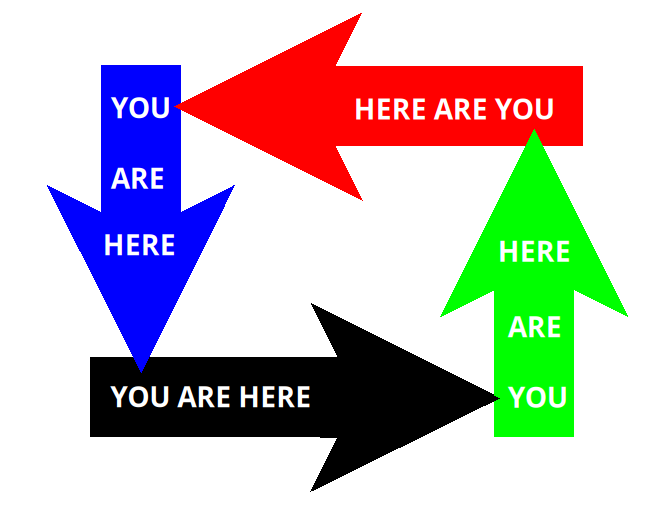 |
three minds | territory | map | self-reflexiveness | |
Polish-American philosopher Alfred Korzybski, originator of general semantics, coined the phrase "The map is not the territory."
A) A map may have a structure similar or dissimilar to the structure of the territory.
B) Two similar structures have similar ‘logical’ characteristics. Thus, if in a correct map, Dresden is given as between Paris and Warsaw, a similar relation is found in the actual territory.
C) A map is not the territory.
D) An ideal map would contain the map of the map, the map of the map of the map., endlessly. This characteristic was first discovered by Royce. We may call it self-reflexiveness.
Languages share with the map the above four characteristics. ... Words are not the things they represent.
Alfred Korzybski. A Non-Aristotelian System and Its Necessity for Rigour in Mathematics and Physics.
Wikipedia: Map-territory relation. #493  |
1931 |
 |
three minds | truth | word | free | |
Jesus, in the Gospel of John, told the Pharisees that he was the light of the world. (Those who keep God's word will see God's truth and be free to live by the word or by the truth.)
If you remain in my word, then you are truly my disciples. You will know the truth, and the truth will make you free.
...If you were Abraham's children, you would do the works of Abraham. But now you seek to kill me, a man who has told you the truth, which I heard from God.
...Why don't you understand my speech? Because you can't hear my word.
...If I tell the truth, why do you not believe me? He who is of God hears the words of God. For this cause you don't hear, because you are not of God.
John 8:31-47 #485  |
100 |
![]() |
foursome | primordial | constructive | instrumental | |
Sociologists have developed competing theories about ethnic identity.
• Primordialism. Cultural differences are real and identities are fixed. (Clifford Geertz. Primordial and Civic Ties. 1963)
• Constructivism. Identities are subjective and constructed from social interactions. (Hugh Seton-Watson. Nations and States: An Inquiry Into the Origins of Nations and the Politics of Nationalism. 1977)
• Instrumentalism. Identities result from leaders who emphasize traditions, fabricate myths and manipulate narratives for economic and political advantage. (The Invention of Tradition. 1983.)
Adeed Dawisha. Nation and Nationalism: Historical Antecedents to Contemporary Debates
#484  |
1983 |
![]() |
foursome | | primordial | constructive | instrumental |
Study of the ethnic conflicts arising at the end of the Cold War led to three theories about their causes.
• Primordialism. Ethnic conflicts are the natural result of cultural differences that are real and identities that are fixed.
• Constructivism. Ethnic conflicts are made possible by political systems and cultural scripts based on social interactions that can change and identities that are subjective.
• Instrumentalism. Ethnic conflicts are caused by instigators who fabricate myths and manipulate identity to mobilize their ethnic group for the sake of their own personal economic and political interests and those of their group.
Laura Yeghiazaryan. Which of the three main ethnic conflict theories best explains the ethnic violence in the post-soviet states of Azerbaijan, Georgia, and Moldova?
Adeed Dawisha. Nation and Nationalism: Historical Antecedents to Contemporary Debates
#483  |
2002 |
![]() |
foursome | | iconic | enactive | symbolic |
American educational cognitive psychologist Jerome Seymour Bruner introduced enaction as learning by doing:
Any domain of knowledge (or any problem within that domain of knowledge) can be represented in three ways:
• by a set of actions appropriate for achieving a certain result (enactive representation);
• by a set of summary images or graphics that stand for a concept without defining it fully (iconic representation);
• and by a set of symbolic or logical propositions drawn from a symbolic system that is governed by rules or laws for forming and transforming propositions (symbolic representation)
Wikipedia: Enactivism
Jerome Seymour Bruner. Toward a Theory of Instruction #476  |
1966 |
![]() |
three minds | personally | objectively | universally | |
English author Aldous Huxley advised:
The most richly satisfying essays are those which make the best not of one, not of two, but of all the three worlds in which it is possible for the essay to exist.
• the personal and the autobiographical (through the keyhole of anecdote and description)
• the objective, the factual, the concrete-particular (from relevant data to general conclusions)
• the abstract-universal (high abstractions)
Wikipedia: Essay: Definitions
Aldous Huxley. Collected Essays. Preface. #475  |
1960 |
 |
three minds | instincts | moral virtues | understanding | |
The Kabbalah posits that the human soul has three elements, which are referred to in Genesis and discussed in the Zohar.
• Nefesh (נֶפֶשׁ), the lower soul, the animal part, life-force of the body, aware of the body, given at birth, and dying with the body, the fount of instincts and bodily cravings, which can yet be fully obedient to God
• Ruach (רוּחַ), the middle soul, the spirit, which contains the moral virtues and the ability to distinguish between good and evil, by which God is loved with all one's heart, one's emotions
• Neshamah (נְשָׁמָה), the higher soul, the super-soul, the intellect, which understands, conceptual grasps, pierces through the ephemeral to the essential, by which the senses are temporarily nullified, making way for love and awe, which separates humans from all other life-forms, which allows humans to enjoy and benefit from the afterlife, which gives humans some awareness of the existence and presence of God
Two further parts of the soul are considered.
• Chayyah (חיה) provides awareness of the divine life force itself, by which one loves God with all one's being
• Yehidah (יחידה) is the highest plane of the soul, in which one can achieve the fullest union with God that is possible
Wikipedia: Kabbalah
Kabbalah Online. Neshamah: Levels of Soul Consciousness
Rabbi David Cooper. Five Dimensions Of The Soul. #470  |
1283 |
 |
three minds | fast | good | cheap | |
American film director Francis Ford Coppola, before the release of his film "Tucker", was visited by journalist who noticed
There’s a hand-drawn sign tacked up: a triangle with its points labeled “Good,” “Fast” and “Cheap” and a caption that says, “Pick Any Two.”
Such a sign had been noticed on Coppola's trailer as he filmed "Apocalypse Now".
Charles Champlin, Jack Smith. Bad Times Behind, Coppola Dances to a Different Tune #456  |
1979 |
 |
three minds | too few assumptions | too many assumptions | the required assumptions | |
Italian philosopher Antonio Rosmini, in A New Essay concerning the Origin of Ideas, observed
• sensationalists cannot explain the origins of ideas
• idealists posit more ideas or forms than are necessary.
He concluded: In explaining facts connected with the human spirit, we must not make fewer assumptions than are required to explain them... [nor must we] make more assumptions than are needed to explain the facts
Stanford: Antonio Rosmini #435  |
1830 |
![]() |
three minds | neuro | linguistic | programming | |
Richard Bandler and John Grinder, founders of neuro-linguistic programming (NLP), introduced it in "The Structure of Magic I: A Book about Language and Therapy". Our mind-body (neuro) and what we say (language) interact to form our perceptions of the world, which we use to create (program) our own internal maps of the world, which determine our feelings and behavior. We can recognize unhelpful or destructive patterns of thinking based on impoverished maps, and modify or replace these patterns with more useful or helpful ones, increasing our behavioral flexibility.
Wikipedia: Methods of neuro-linguistic programming
Wikipedia: Neuro-linguistic programming
Wikipedia: The Structure of Magic. #427  |
1975 |
![]() |
three minds | fixed concept | engendered opposite | revealed unity | |
German idealist Georg Wilhelm Friedrich Hegel described his dialectical method in his Encyclopedia of the Philosophical Sciences as consisting of three moments. These are three sides of every concept and of everything true in general.
• the moment of understanding, of fixity, is the first moment, in which concepts or forms have a seemingly stable definition or determination.
• the dialectical moment, the negatively rational moment, of instability, is the second moment, in which the first moment cancels and preserves itself, in other words, sublates (aufheben) itself, in that its one-sidedness or restrictedness destabilizes its definition and leads it to pass into its opposite.
• the speculative moment, the positively rational moment, grasps the unity of the opposition of the first two, or is the positive result of the dissolution or transition, which is left from the contradiction, more than simply nothing.
Stanford: Hegel's Dialectics #363  |
1817 |
![]() |
nullsome | energy dissipation | | | |
Lucy Weir, instructor of philosophy, yoga and meditation, considers the good as driving systems from behind rather than pulling them forwards.
...consider the image of systems being driven from behind, pushed to avoid their own annihilation, as a metaphor that better fits our current understanding of evolution and the laws of thermodynamics. ... energy dissipation across the universe, from a narrow base at a higher concentration to a less concentrated, much broader set of potential outcomes ... In universal terms, the dissipation of energy through graduated flows is neither beneficial nor harmful. Yet the universe would not exist at all if it were not for the activity that slows or reverses the second law of thermodynamics, albeit temporarily, by creating flux in the flow. In the local, planetary sense, this gradual dissipation of energy is ‘good for’ us, in the sense that it forms the foundation for our survival, giving us time to develop as a culturally sophisticated species with language, technology, and the ability to decide what to value.
Lucy Weir. Beginning with the Good of Systems, Philosophy as Practice in the Ecological Emergency. #362  |
2023 |
![]() |
onesome | evolutionary matrix | | | |
Lucy Weir, addressing the ecological emergency, treasures, within the universe, our planet's evolutionary matrix.
There are conditions that are good for other organisms, just as there are conditions that are good for us, because they allow us to maintain the pattern of our existence. This pattern is inevitably temporary for any one individual, and no vortex is permanent, yet the continuance of the pattern forms the matrix within which we have evolved and survive. Our existence takes place within larger systems that self-maintain, and that therefore create and sustain the conditions upon which our own survival, personally, and as a species, depends. If we are the species that threatens to unravel the threads of this matrix of co-existence, it behoves us to at the very least become aware of what we are implicated in.
Lucy Weir. Beginning with the Good of Systems, Philosophy as Practice in the Ecological Emergency. #361  |
2023 |
![]() |
twosome | external situation | attitude | | |
Philosopher Lucy Weir in Ireland highlights self-reflection in addressing the ecological emergency.
The effort of becoming aware of what is going on, in and around us, while it is going on, changes not the external situation, but our own approach to the situation, but it is through shifting our own attitude that our interactions and impact shift.
Lucy Weir. Beginning with the Good of Systems, Philosophy as Practice in the Ecological Emergency. #360  |
2023 |
 |
three minds | self | context | observer | |
Environmental philosopher Lucy Weir relates our language about ecological systems (whether they tend towards an ideal or whether they are propelled by a challenge) with how we relate to what goes on in and around us, how we perceive and respond. She concludes:
The capacity to step back and observe oneself in context is also the capacity to attune to the cooperative flow of energetic dissipation. One can come to a realisation that one’s sense of agency is illusory, but that one can nevertheless do what needs to be done, or, perhaps more accurately, one can take this observational stance to its logical conclusion and let love do what needs to be done.
Lucy Weir. Beginning with the Good of Systems, Philosophy as Practice in the Ecological Emergency. #359  |
2023 |
![]() |
foursome | | what and how many? | how? | for whom? |
Nobel Prize winning economist Paul Samuelson authored the "canonical" American economics textbook, first published in 1948 and most recently in 2019. He wrote in the first edition:
Any society... must somehow meet three economic problems.
1. What commodities shall be produced and in what quantities? That is, how much and which of many alternative goods and services shall be produced?
2. How shall they be produced? That is, by whom and with what resources and in what technological manner are they to be produced?
3. For whom are they to be produced? That is, who is to enjoy and get the benefit of the goods and services provided?
Paul Samuelson. Economics: An Introductory Analysis
Wikipedia: Economic problem #355  |
1948 |
![]() |
threesome | judging | willing | thinking | |
Hannah Arendt, after analyzing the active life (vita activa) in The Human Condition, turned to the contemplative life (vita contemplativa) in The Life of the Mind. She intended to write three volumes, on Thinking, Willing and Judging, but she completed only the first two before her death from a heart attack. she distinguishes the thinking ego, willing ego and judging ego.
• thinking is the product of Reason, leading beyond knowledge, the inner dialogue, the habit of examining whatever happens or whatever attracts attention, regardless of import, thus dissolving established rules of conduct and habits of thought, and opening up conscience. It takes place in the medium of words and is constrained by non-self-contradiction. It focuses on what is not given by the senses as being more real, truthful, meaningful, aims at contemplation and ends in it.
• willing is the product of Freedom, the spring of action, the power of spontaneously beginning a series of successive things or states, bringing about something new, changing the world.
• judging is the product of Intellect, formulating the truth, considering particulars without appealing to pre-established universals, allowing one to judge for oneself, yet mindful of all others, sensitive to conscience, rooted in common sense, noncoercive, persuasive, communicable, appraising past actions and establishing future objectives.
Hannah Arendt. The Life of the Mind. Volume One. Thinking.
Hannah Arendt. The Life of the Mind. Volume Two. Willing.
Stanford: Hannah Arendt #352  |
1978 |
![]() |
three minds | labor | work | action | |
German Jewish American political theorist Hannah Arendt, in The Human Condition, differentiated
• labor is directed at maintaining and reproducing human life, whose fruits are quickly consumed, satisfying neverending needs, was in ancient times performed in private households by women and slaves
• work has a clearly defined beginning and end, results in a durable object, such as a tool, which is crafted, created and not consumed, yet leads to instrumental thinking and involves violence against nature, obtaining and shaping raw materials
• action, including speech as action, is how individuals show that they are unique and unexchangeable, doing great deeds, they manifest their freedom in the public sphere, and can come together as free people
Wikipedia: The Human Condition (Arendt book) #335  |
1958 |
 |
three minds | whole-oriented | detail-oriented | | |
British psychiatrist Iain McGilchrist, "The Master and His Emissary: The Divided Brain and the Making of the Western World", influenced by psychiatrist John Cutting and psychologist David McNeill, distinguished how the brain hemispheres pay attention.
• The Master (right hemisphere) is whole-oriented, closely related to physical bodies, one's own and others', and external reality given by the senses, thus the mediator of all experience, the source of thought, and also it reintegrates and understands meaning processed by the left hemisphere, thus is the first stop and last stop.
• The Emissary (left hemisphere) is detail-oriented, processes speech, and has detrimentally become increasingly dominant in Western culture.
Wikipedia: The Master and His Emissary
Iain McGilchrist. The Master and his Emissary: The Divided Brain and the Making of the Western World #328  |
2009 |
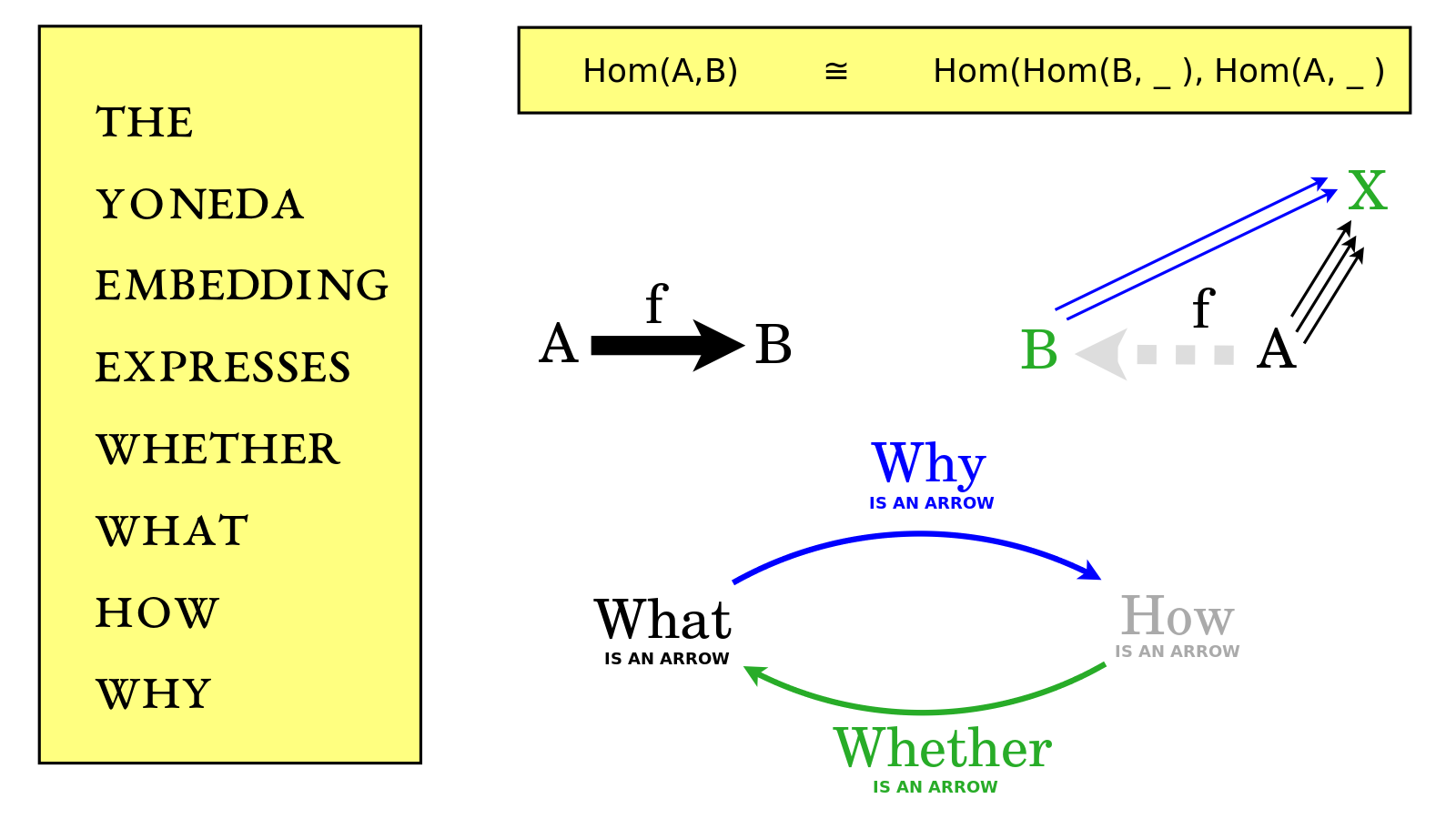 |
foursome | postpending identity arrow | arrow | prepending arrow | extracting arrow |
Japanese mathematician Nobuo Yoneda is known for the Yoneda lemma, the fundamental theorem of category theory. A special case is the Yoneda embedding Hom(A,B) ≅ Hom(Hom(B,_),Hom(A,_)) which relates
• Hom(A,B) arrows from object A to object B
• Hom(Hom(B,_),Hom(A,_)) ways of transforming an arrow from B to X into an arrow from A to X by prepending an arrow from A to B
• the trivial postpending of an identity arrow from B to B, yielding the arrow from A to B
• the extracting of an arrow from A to B from all arrows that extend it from A to X by way of all relationships from B to X, which is to say, A to B is known by all of its friends A to B to X
Andrius Kulikauskas. The Yoneda Embedding Expresses Whether, What, How, Why. #325  |
1955 |
![]() |
three minds | facts | principles | consequences | |
American psychologist William James, a founder of pragmatism, distinguished two philosophical temperaments:
• The Tender-Minded: Rationalistic (going by 'principles'), Intellectualistic, Idealistic, Optimistic, Religious, Free-willist, Monistic, Dogmatical.
• The Tough-Minded: Empiricist (going by 'facts'), Sensationalistic, Materialistic, Pessimistic, Irreligious, Fatalistic, Pluralistic, Sceptical.
In manners we find formalists and free-and-easy persons. In government, authoritarians and anarchists. In literature, purists or academicals, and realists. In art, classics and romantics. You recognize these contrasts as familiar; well, in philosophy we have a very similar contrast expressed in the pair of terms 'rationalist' and 'empiricist,' 'empiricist' meaning your lover of facts in all their crude variety, 'rationalist' meaning your devotee to abstract and eternal principles. No one can live an hour without both facts and principles, so it is a difference rather of emphasis; yet it breeds antipathies of the most pungent character between those who lay the emphasis differently; and we shall find it extraordinarily convenient to express a certain contrast in men's ways of taking their universe, by talking of the 'empiricist' and of the 'rationalist' temper.
Pragmatism offers a third temperament that mediates between the other two.
• The pragmatic method in such cases is to try to interpret each notion by tracing its respective practical consequences. What difference would it practically make to anyone if this notion rather than that notion were true?
William James. Pragmatism: A New Name for Some Old Ways of Thinking #324  |
1907 |
![]() |
threesome | planning | action | fact-finding | |
German Jewish American psychologist Kurt Lewin, the founder of social psychology, coined the term "action research", a comparative research on the conditions and effects of various forms of social action and research leading to social action. Action research uses the Lewinian spiral:
...a spiral of steps, each of which is composed of a circle of planning, action, and fact-finding about the result of the action
Wikipedia: Kurt Lewin
Kurt Lewin. Action Research and Minority Problems. #256  |
1946 |
 |
three minds | Eve | Adam | God | |
In the Book of Genesis, the story of Adam and Eve and God can be interpreted as an allegory about the three minds.
The man gave names to all livestock, and to the birds of the sky, and to every animal of the field; but for man there was not found a helper comparable to him.
When the woman saw that the tree was good for food, and that it was a delight to the eyes, and that the tree was to be desired to make one wise, she took some of its fruit, and ate.
God said, “Who told you that you were naked? Have you eaten from the tree that I commanded you not to eat from?”
World English Bible: Genesis 2 and Genesis 3
#203  |
-250 |
 |
three minds | gentleness | economy | shrinking from taking precedence of others | |
The Daoist "Three Treasures" 三寶 originally referred to this quote in the Daodejing:
But I have three precious things which I prize and hold fast. The first is gentleness; the second is economy; and the third is not daring to be the first in the world (shrinking from taking precedence of others). With that gentleness I can be bold; with that economy I can be liberal; not daring to be the first in the world, I can become a vessel of the highest honour.
Wikipedia: Three Treasures (traditional Chinese medicine)
Daodejing Chapter 67 #166  |
-325 |
 |
three minds | half monster | half human | his creator | |
British poet Robert Browning imagined the inner life of Caliban, a character from Shakespeare's The Tempest, who is half monster, half human, notably how Caliban reflects on his god, Setebos, who created him.
• half monster, reveling in the senses: Flat on his belly in the pit's much mire, With elbows wide, fists clenched to prop his chin. And, while he kicks both feet in the cool slush, And feels about his spine small eft-things course, Run in and out each arm, and make him laugh
• half human, thinking conspiratorially: And talks to his own self, howe'er he please, Touching that other, whom his dam called God. Because to talk about Him, vexes—ha, Could He but know! and time to vex is now, When talk is safer than in winter-time
• his god Setebos, as he imagines him, creative and conflicted: Made all we see, and us, in spite: how else? He could not, Himself, make a second self To be His mate; as well have made Himself ... Make what Himself would fain, in a manner, be— Weaker in most points, stronger in a few, Worthy, and yet mere playthings all the while, Things He admires and mocks too,—that is it.
Robert Browning. Caliban upon Setebos.
Wikipedia: Caliban upon Setebos #164  |
1864 |
 |
three minds | beauty | immortal work | love of principle | |
English romantic poet John Keats wrote to his beloved Fanny Brawne
I have left no immortal work behind me—nothing to make my friends proud of my memory—but I have lov’d the principle of beauty in all things, and if I had had time I would have made myself remember’d.
Michelle Stacey. Writ in Water. #162  |
1820 |
![]() |
three minds | revert to instincts | sacrifice personal interests | follow excitable leaders | |
French polymath Gustave Le Bon, author of The Crowd: A Study of the Popular Mind, detailed three processes that create the psychological crowd, where individuals give way to a group mind, a collective unconsciouness.
• Anonymity lets individuals revert to their instincts, shun personal responsibility, be primitive, unreasoning, emotional, feel invincible.
• Contagion is the spread of behaviors through the crowd, where individuals sacrifice their personal interest for the collective interest.
• Suggestibility is the increasing homogeneity and malleability of the crowd to suggestions by excitable, half-deranged leaders.
Wikipedia: Gustave Le Bon
#148  |
1895 |
![]() |
three minds | slaves of appetite and sloth | subduers and cultivators of the earth | God who decrees, grants, eradicates | |
Influential American newspaper editor and politician Horace Greeley supported pacifism, feminism and free laborers, but authored this screed against Native Americans:
To the prosaic observer, the average Indian of the woods and prairies is a being who does little credit to human nature — a slave of appetite and sloth, never emancipated from the tyranny of one animal passion, save by the more ravenous demands of another.
As I passed over those magnificent bottoms of the Kansas, which form the reservations of the Delawares, Potawatamies, etc., constituting the very best corn-lands on Earth, and saw their owners sitting around the doors of their lodges at the height of the planting season, and in as good, bright planting weather as sun and soil ever made, I could not help saying: "These people must die out — there is no help for them. God has given this earth to those who will subdue and cultivate it, and it is vain to struggle against His righteous decree."
Wikipedia: Myth of the Noble Savage
Horace Greeley. An Overland Journey from New York to San Francisco in the Summer of 1859. XIV. “LO! THE POOR INDIAN!” #147  |
1860 |
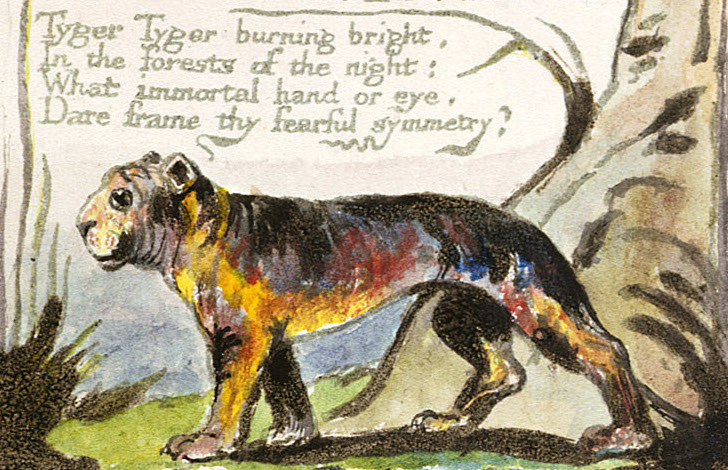 |
nullsome | creator of the Tyger and the Lamb | | | |
Creative, romantic English poet, painter, printmaker William Blake ponders God's intent.
Tyger Tyger, burning bright,
In the forests of the night;
What immortal hand or eye,
Could frame thy fearful symmetry? ...
Did he smile his work to see?
Did he who made the Lamb make thee?
William Blake. The Tyger. #146  |
1794 |
 |
three minds | counting units | measuring sums | | |
American relationship counselor John Gray controversially describes gender differences, how women and men respond to stress and stressful situations, and how they are acclimated to their own gender's society and customs, leading to conflicts in communications.
• Women credit points for all acts of love, large or small, the same. Women respond to stress by talking with someone close about it. Women give to others in stable waves, but when they don't receive love and attention in return, they crest and crash.
• Men credit points for large acts of love more than small acts of love. Men respond to stress by temporarily withdrawing.
Men Are from Mars, Women Are from Venus #145  |
1992 |
 |
three minds | experience | innocence | solidarity | |
English artist and poet William Blake authored and illustrated two volumes of poems which he combined as "Songs of Innocence and of Experience Shewing the Two Contrary States of the Human Soul".
• Songs of Innocence show children's natural, happy, innocent, naïve, vulnerable outlook. They are reassuring and place hope in the spirit. Though the morning was cold, Tom was happy & warm; So if all do their duty, they need not fear harm.
• Songs of Experience show the reality, cruelty, severity, abandonment of the world, learned from living in it. Is this a holy thing to see In a rich and fruitful land, Babes reduced to misery, Fed with cold and usurous hand?
• In both collections there is a call to solidarity, brotherhood and sisterhood, to respond, make good and right. For where’er the sun does shine, And where’er the rain does fall, Babe can never hunger there, Nor poverty the mind appall.
Wikipedia: Songs of Innocence and Experience
William Blake's Songs of Innocence and Experience #144 ❤️DAF  |
1794 |
 |
three minds | enactive | predictive | cybernetic | |
The Active Inference textbook explains that this theoretical framework unites and extends three apparently disconnected theoretical perspectives:
• enactive theories, emphasizing an organism's autopoietic interactions with its environment, statistically separating internal states from external environment with a Markov blanket, protecting the organism's integrity, self-organizing behavior, keeping its parameters within acceptable bounds, affording reciprocal exchanges between organism and environment.
• cybernetic theories, treating behavior as purposive and teleological, regulated by an internal mechanism that continuously tests whether goals are achieved, consequently updating perceptions and steering corrective actions, minimizing the discrepancy between preferred and sensed states, notably the variational free energy, corresponding to prediction error.
• predictive theories, emphasizing the development of a good (generative) model of the environment (per the good regulator theorem) used to construct predictions that guide perception and action, evaluate future and counterfactual possibilities, approaching control as a prospective process, established in terms of (approximate) Bayesian inference and (variational and expected) free energy minimization, grounding action in imagination, triggering actions with predictive representations, temporarily attenuating sensory evidence.
Thomas Parr, Giovanni Pezzulo, Karl Friston. Active Inference: The Free Energy Principle in Mind, Brain and Behavior. 3.7 Reconciliation of Enactive, Cybernetic, and Predictive Theories under Active Inference #142  |
2022 |
![]() |
three minds | child | parent | adult | |
Canadian American psychiatrist Eric Berne, founder of transactional analysis, transformed Freudian psychotherapy (id, superego, ego) by focusing on the transpersonal interactions (transactions) between people. He identified three ego-states - Parent, Adult, Child - and referred to patterns of transactions as "games".
• Parent (exteropsyche) is a state in which people mimick their parental figures.
• Adult (neopsyche) is a desirable state in which a person resemble an artificially intelligent system, processing information and making predictions how emotions can affect operations, objectively appraising reality.
• Child (archaeopsyche) is a state which brings one back to childhood, the source of emotions, creation, recreation, spontaneity, intimacy.
Wikipedia: Transactional Analysis
Eric Berne. Ego States in Psychotherapy. American Journal of Psychotherapy. Volume 11, Number 2. 1957. #141  |
1957 |
 |
three minds | child | parent | adult | |
Canadian American psychiatrist Eric Berne presented his theory of transactional analysis with the popular book "Games People Play", describing functional and dysfunctional interactions. He distinguished three ego states, coherent systems of feelings and behavior patterns, which a person switches between:
• Parent - ego states which resemble those of parental figures. Parent functions in raising children and also makes trivial decisions automatic. Parent looks down on Child.
• Adult - ego states which are autonomously directed towards objective appraisal of reality. Adult processes data and computes probabilities for complex navigation of the outside world, and also mediates objectively between Parent and Child.
• Child - ego states which represent archaic relics, still-active ego states which were fixated in early childhood. Here resides intuition, creativity, spontaneous drive and enjoyment. Child looks up to Parent.
Wikipedia: Games People Play (book)
Eric Berne. Games People Play. #140  |
1964 |
 |
three minds | child | parent | adult | |
American psychiatrist Thomas Anthony Harris's self-help manual, "I'm OK – You're OK", based on transactional analysis, distinguishes three modes that a person switches between:
• Parent is a collection of "tape recordings" of external influences, a long list of admonitions that a child observed adults doing and saying, and carries with them, such as "never run out in traffic" or "keep smiling"
• Child is a collection of "tape recordings" of internal events, vivid experiences dating back to childhood, touchstones of how life felt, which a person continues to refer back to
• Adult is the set of opinions formed as a child explores and examines the world, starting as a child learns how to walk, testing the assertions of Parent and Child, updating or suppressing them, though sometimes succumbing to them in stressful situations
Wikipedia: I'm OK, You're OK
Thomas A. Harris. I'm OK - You're OK #139  |
1967 |
![]() |
onesome | all statements are true | | | |
Euthydemus, in Plato's dialogue by the same name, argues that all statements which are spoken are factual, for non factual statements do not exist and thus could not be the objects of speech. Thus falsehood cannot exist.
Wikipedia: Euthydemus (dialogue) #138  |
-384 |
![]() |
twosome | A implies A | not A implies A | | |
Greek mathematician Euclid applied proof by contradiction in proving Euclid's theorem that there are infinitely many prime numbers. In proving statement A, one supposes not A, then show this implies A. There is also the assumption that A implies A. Taken together, A or not A implies A.
Wikipedia: Proof by contradiction #137  |
-300 |
![]() |
onesome | all statements are true | | | |
French logician Guillaume de Soissons developed the principle of explosion. He proved that given a contradiction, any assertion can be inferred as true, including its negation. All statements are true.
Wikipedia: Principle of explosion
#136  |
1150 |
![]() |
nullsome | contradiction | | | |
French logician Guillaume de Soissons developed the principle of explosion. He proved that given a contradiction, any assertion can be inferred as true, including its negation. All things are true.
Wikipedia: Principle of explosion
#135  |
1150 |
![]() |
nullsome | set of all sets that are not members of themselves | | | |
British philosopher Bertrand Russell's paradox considers a set R which is the set of all sets that are not members of themselves. Is R∈R? If R∈R, then R∉R. But if R∉R, then R∈R. Thus we have a contradiction.
Wikipedia: Russell's paradox #134  |
1901 |
![]() |
onesome | set of all sets | | | |
Russell's paradox was published by British philosopher Betrand Russell in 1901. It was also discovered independently by German mathematician Ernst Zermelo. It implies that there cannot be a set of all sets.
Wikipedia: Russell's paradox #133  |
1901 |
![]() |
twosome | Fermi–Dirac statistics | Bose-Einstein statistics | | |
In physics, there are two fundamental types of quantum statistics for noninteracting, identical particles.
• bosons obey Bose-Einstein statistics, where the particles may be in the same physical state, as with photons in a laser. They commute and have integer spin. Bosons carry forces.
• fermions obey Fermi-Dirac statistics, where the particles must all be in different physical states, as with electrons in a field. They anticommute and have half-integer spin. Fermions constitute matter.
Wikipedia: Bose-Einstein statistics
Wikipedia: Fermi-Dirac statistics #132  |
1926 |
![]() |
three minds | Bose-Einstein statistics | Fermi–Dirac statistics | | |
In physics, there are two fundamental types of quantum statistics for noninteracting, identical particles.
• bosons obey Bose-Einstein statistics, where the particles may be in the same physical state, as with photons in a laser. They commute and have integer spin. Bosons carry forces.
• fermions obey Fermi-Dirac statistics, where the particles must all be in different physical states, as with electrons in a field. They anticommute and have half-integer spin. Fermions constitute matter.
Wikipedia: Bose-Einstein statistics
Wikipedia: Fermi-Dirac statistics #131  |
1926 |
![]() |
three minds | bosons | fermions | | |
Theoretical physicists J.L.Gervais and B.Sakita, Yu.A.Golfand and E.P.Likhtman, and D.V.Volkov and V.P.Akulov independently discovered supersymmetry in the context of quantum field theory, relating bosons and fermions, and uniting spacetime with internal microscopic symmetries. In particular, the Poincaré group, the 10-dimensional isometry group of Minkowski spacetime, was extended to the Super-Poincaré algebra, where bosons are the even elements and fermions are the odd elements. Bosons commute and fermions anticommute.
Wikipedia: Supersymmetry #130  |
1971 |
![]() |
three minds | even part A of superalgebra | odd part eA of superalgebra | induced R-automorphism a→a' | |
American mathematician Todd Trimble, in classifying real division superalgebras A + eA, where A is the even part and eA is the odd part, focused on the automorphism a→a' defined by ae=ea'.
Todd Trimble. The Super Brauer Group and Super Division Algebras. #129  |
2005 |
 |
foursome | constitution
精 | natural energy
气 | mental agency
神 | alignment
无为 |
Traditional Chinese medicine identifies three energy centers (丹田 dāntián) that function as cauldrons for transmuting Three Treasures by internal alchemy (neidan):
精 jīng is one's essence, one's favorable constitution, composed of congenital, prenatal Yin and postnatal, acquired Yang, manifest in good facial structure, teeth, hair, strong adrenals or kidneys
气 qi is one's vapor, breath, vital force, the natural energy of the universe, which is purified from jing in the Lower Dantian, "the golden stove", the root of the tree of life, the foundation of rooted standing, grounding, breathing and body awareness
神 shén is one's vigor, enthusiasm, vitality of mind, one's power of agency, divine spirit, which is purified from qi in the Middle Dantian, "the crimson palace", at the level of the heart, associated with the health of the internal organs, notably the thymus gland
无为 wúwéi is inaction, effortless action, emptiness, staying aligned and fully realized, which is purified from shen in the Upper Dantian, "the muddy pellet", at the forehead between the eyebrows, at the third eye, associated with the pineal gland
Wikipedia: Dantian
Wikipedia: Three Treasures (traditional Chinese medicine)
Wikipedia: Neidan #128  |
559 |
![]() |
three minds | rhetoric as process | logic as product | dialectic as procedure | |
American scholar Joseph Wenzel, in analyzing argumentation, distinguished the rhetorical process, dialectical procedure and logical product.
• Rhetoric helps us to understand and evaluate arguing as a natural process of persuasive communications
• Logic helps us to understand and evaluate arguments as products people create when they argue.
• Dialectic is a method, a system or a procedure for regulating discussions among people.
Joseph Wenzel. Three Perspectives on Argument.
Ralph H. Johnson. Revisiting the Logical/Dialectical/Rhetorical Triumvirate. #127  |
1990 |
![]() |
three minds | rhetoric | logic | dialectic | |
Belgian-Polish-Jewish philosopher Chaïm Perelman, in his The Realm of Rhetoric, compared rhetoric with logic and dialectic.
• rhetoric is focused on the audience, so as to win them over
• logic develops a series of valid and compelling inferences
• dialectic advances arguments from theses that are generally accepted towards those that are more controversial
Ralph H. Johnson. Revisiting the Logical/Dialectical/Rhetorical Triumvirate.
Wikipedia: Chaïm Perelman
#126  |
1982 |
![]() |
foursome | speak | see | hear | deliberate |
Confucianist philosopher Xun Kuang (c.310-c.238), in his Xunzi, teaches:
[The gentleman] makes his eyes not want to see what is not right,
makes his ears not want to hear what is not right,
makes his mouth not want to speak what is not right,
and makes his heart not want to deliberate over what is not right
使目非是無欲見也,使耳非是無欲聞也,使口非是無欲言也,使心非是無欲慮也
Wikipedia: Three wise monkeys #125  |
-250 |
 |
three minds | rhetoric | logic | dialectic | |
Aristotle, in his Rhetoric, distinguishes between rhetoric and dialectic. He also was a founder of classical logic, although the term "logic" came later. All three have the function of providing arguments. We can infer a distinction.
• Rhetoric considers what arguments are persuasive or not.
• Logic considers what arguments are, of themselves, valid or not.
• Dialectic considers what arguments are illuminating in arguing for and against.
Stanford: Aristotle's Rhetoric #124  |
-357 |
![]() |
foursome | conjecture | belief | thought | understanding |
Plato, in his Republic, in the Analogy of the divided line, distinguishes both the visible (what become) and the intelligible (what is) into two parts:
• conjecture or illusion (εἰκασία eikasia) perceives shadows or reflections, as with unexamined ordinary experience, subject to guessing
• belief (πίστις pistis) regarding what is visible, probable, predictable
• thought (διάνοια dianoia) is knowledge which considers the visible world, as a reflection of the ideal world, and proceeds by mathematical, abstract reasoning to contemplate the ideal world
• understanding (νόησις noesis) is knowledge that is focused entirely on ideal forms, exploring the ideal realm dialectically, philosophically
Wikipedia: Analogy of the divided line #123  |
-375 |
![]() |
foursome | ignorance | false opinion | true opinion | wisdom |
Greek philosopher Plato, in his Republic, distinguished four levels of knowledge:
• Wisdom is the knowledge which advises, not about any particular thing in the State, but about the whole, and considers how a State can best deal with itself and with other States
• True opinion is instilled. ...we were contriving influences which would prepare them to take the dye of the laws in perfection, and the colour of their opinion about dangers and of every other opinion was to be indelibly fixed by their nature and training, not to be washed away by such potent lyes as pleasure... or by sorrow, fear and desire... and this sort of universal adhering power of true opinion in conformity with about real and false dangers I call and maintain to be courage
• False opinion is popular opinion, simply doing and thinking as others do, or as one fancies.
• Ignorance is that which is concerned with non-being.
Plato. The Republic. #122  |
-375 |
 |
three minds | irrational appetite | moral impulse | reason | |
Greek philosopher Plato, in the Phaedrus, presents the Allegory of the Chariot. The charioteer drives a chariot pulled by two winged horses.
First the charioteer of the human soul drives a pair, and secondly one of the horses is noble and of noble breed, but the other quite the opposite in breed and character. Therefore in our case the driving is necessarily difficult and troublesome.
The charioteer represents reason, which guides the soul to truth. The noble horse is the positive passion, the rational and moral impulse. The ignoble horse is the negative, irrational passion, the appetites.
Wikipedia: Phaedrus (dialogue) #121  |
-370 |
 |
three minds | meandering mind | fixated mind | empty mind | |
Chinese philosopher Xun Kuang, in his writings, Xunzi, chapter "Undoing Fixation", opposes Mencius, criticizes obsession, when a person focus so intently on one thing that their mind is divided, walled off from new information, making for ineptitude. Understanding, approving, abiding by the Way (道 Dào) has one empty the mind, allowing it to wander, perceiving interconnections, thinking holistically, thus keeping empty, unified, still, living by non-action (无为wúwéi)
Wikipedia: Xunzi (book)
解蔽篇第二十一 Chapter 21: Dispelling Obsession #120  |
-250 |
 |
three minds | naturally selfish | conscious effort to do good | conscious development of proper standards | |
Chinese philosopher Xun Kuang (c.310-c.238 BCE), in his writings, Xunzi, chapter "Human Dispositions are Detestable", opposes Mencius, arguing that humans are naturally bad, wayward, selfish, drawn to profit and beauty, susceptible to jealousy and hate. They need to follow right teachings and consciously practice doing good. Then they can be one with the Way, dedicated to morality, and consciously create rituals and regulations to be followed.
Wikipedia: Xunzi (book)
性惡篇第二十三 Chapter 23: Human Nature is Evil #119  |
-250 |
![]() |
nullsome | heaven | | | |
Chinese philosopher Xun Kuang (c.310-c.238 BCE), revisioner of Confucianism, in his writings, Xunzi, chapter "Discourse on Heaven", emphasizes that heaven is constant, impartial to humans, going its own way. However, humans can respond to it with order, preparing for disaster, or with disorder, inviting disaster.
Wikipedia: Xunzi (book)
天論篇第十七 Chapter 17: Discussion on Heaven #118  |
-250 |
 |
three minds | duty and sense of shame | laws and punishments | virtue and propriety | |
Chinese sage Confucius (c.551-c.479 BCE) taught in his Analects that the best government rules by rites (lǐ 禮) and not incentive or coercion.
If the people be led by laws, and uniformity sought to be given them by punishments, they will try to avoid the punishment, but have no sense of shame.
If they be led by virtue, and uniformity sought to be given them by the rules of propriety, they will have the sense of the shame, and moreover will become good.
Wikipedia: Confucius #117  |
-350 |
![]() |
foursome | move | look | listen | speak |
Chinese paragon Confucius (c.551-c.479 BCE), in his Analects, says
Look not at what is contrary to propriety;
listen not to what is contrary to propriety;
speak not what is contrary to propriety;
make no movement which is contrary to propriety
非禮勿視,非禮勿聽,非禮勿言,非禮勿動
Wikipedia: Three wise monkeys #116  |
-350 |
![]() |
three minds | instinctual behavior | learned behavior | aptitude for learning behavior | |
American philosopher and psychologist James Mark Baldwin proposed in "A New Factor in Evolution" an evolutionary mechanism now known as the Baldwin effect. Learned behavior can prove advantageous, and while the behavior itself may not be inheritable, yet the tendency to discover that behavior may well be. Over generations, learned behavior may transform into instinctual behavior.
Wikipedia: Baldwin effect #115  |
1896 |
 |
three minds | imprinting | | | |
English statesman Thomas More noted, in his Utopia, that domestic chicks, upon birth, imprinted on their parents, following them around.
Wikipedia: Imprinting (psychology) #114  |
1516 |
 |
three minds | unconscious | conscious | attending to inner experience | |
American cognitive scientist Lois Isenman authored "Understanding Intuition: A Journey In and Out of Science". She relates biological and cognitive mechanisms with first-person experience. She describes a fluid exchange between unconscious and conscious minds, where unconscious holistic intuition can be enhanced by attending to the subtleties of inner experience.
Lois Isenman with Matt Marble. The Hidden Present. The Blink of the Eye. #113  |
2018 |
![]() |
three minds | holism | | | |
Cellular biologist Lois Isenman responded to Malcolm Gladwell's book Blink by arguing that the unconscious and its intuition result from its holism, drawing on all experience, rather than thin-slicing, its ability to focus on particularly relevant experience.
Lois Isenman. Understanding Unconscious
Intelligence and Intuition: “Blink” and beyond #112  |
2013 |
 |
three minds | thin-slice | analysis paralysis | | |
Canadian journalist Malcolm Gladwell wrote a popular book, Blink, about the adaptive unconscious and its ability to thin-slice, to rapidly, automatically, spontaneously yield conclusions based on scarce information, as occurs with expert judgment but also with prejudice and stereotyping. He compares this with conscious analysis, which can end up including extraneous information, leading to analysis paralysis.
Wikipedia: Blink: The Power of Thinking Without Thinking
#111  |
2005 |
![]() |
threesome | commit | do | learn | |
American self-help author Stephen Covey taught an upward spiral model in developing habits. The spiral consists of three parts: learn, commit, do.
Wikipedia: The 7 Habits of Highly Effective People #109  |
1989 |
 |
three minds | victims | workers | winners | |
Life coach Jaemin Frazer identifies three common approaches to get ahead in life:
• Victims proceed Have, Do, Be. Since they do not have what they need, they wait and complain.
• Workers proceed Do, Have, Be. They end up doing ever more, having ever more, but never being happy.
• Winners proceed Be, Do, Have. They focus on being the kind of person who has the outcomes they want to have. Having takes care of itself.
Jaemin Frazer. A simple explanation of the BE DO HAVE model. #108  |
2023 |
![]() |
threesome | be | embody & do | have & vision | |
Life coach Nona Djavid extends Stephen Covey's Be, Do, Have model:
• Vision - Write down your vision: Who do you want to be? How will you feel when you achieve your goal? Who will be a part of your journey?
• Be - Be the authentic personality that aligns with the behaviors needed to reach your goal.
• Embody - Embody, with simple acts, the emotions you described in your vision.
• Do - Do the actions that move you towards your goal.
• Have - Have the desired result.
Nona Djavid. Two Missing Pieces of the Be, Do, Have Model #107  |
2023 |
 |
threesome | serve | act | infer | |
The logo of the Active Inference institute includes the motto:
• act
• serve
• infer
Active Inference Institute
#105  |
2022 |
 |
three minds | see | hear | speak | |
Hidari Jingoro carved three wise monkeys on a panel at the Tōshō-gū Shrine stable.
• Mizaru (見ざる) covers his eyes, thus does not see
• Kikazaru (聞かざる) covers his ears, thus does not hear
• Iwazaru (言わざる) covers his mouth, thus does not speak
They are believed to represent Confucius's Code of Conduct.
Wikipedia: Three wise monkeys #104  |
1650 |
![]() |
nullsome | Brahman (thrust) | | | |
In Hinduism, Brahman (thrust) is an impersonal (gender neutral) principle, the unchanging reality amidst and beyond the world, the cause of all changes, the nonphysical, infinite, eternal, pervasive truth, consciousness and bliss, the unity behind all diversity. Brahman is present in the oldest Vedas, the Vedic Samhitas, as in this verse from Taittiriya Samhita VII.3.1.4, translated by Barbara Holdrege:
The Ṛcs are limited (parimita),
The Samans are limited,
And the Yajuses are limited,
But of the Word Brahman, there is no end.
Wikipedia: Brahman #103  |
-1300 |
![]() |
threesome | Brahma (creator) | Vishnu (preserver) | Shiva (destroyer) | |
In synthetic Hinduism, the Trimurti is the trinity of supreme divinity:
• Brahma is the creator
• Vishnu is the preserver
• Shiva is the destroyer
The corresponding phonemes A, U, M together constitute the symbolic word Aum, representing Brahman, the ultimate reality. The three are attested in the verse from the Vishnu Purana (1.2.66)
In this way, the one supreme entity divides itself into three forms — Brahma, Vishnu, and Mahesh [Shiva] — taking on different aspects. It creates, preserves, and destroys the universe in various ages.
Wikipedia: Trimurti #102  |
650 |
 |
foursome | | Nirmanakaya (Transformation body) | Sambhogakaya (Enjoyment body) | Dharmakaya (Reality body) |
The Trikāya (three body) doctrine, त्रिकाय, 三身, posits that a Buddha has three distinct bodies, aspects, facets of enlightenment, in which they simultaneously dwell:
• Dharmakaya (Reality body) is the ultimate reality, the essence of enlightenment itself, including emptiness, Buddha nature, and pure existence beyond material and spiritual forms
• Sambhogakaya (Enjoyment body) is the bliss and reward of Buddhahood, lived by the divine Buddhas of the Buddha realms, the result of spiritual practice in their spiritual journey, fulfilling vows and commitments
• Nirmanakaya (Transformation body) is the physical appearance of a Buddha in historical world, allowing them to bridge divine and human, make accesible the teachings, interact with and guide sentient beings on their path to enlightenment
The Yogacara school formally systematized these distinct ideas.
Wikipedia: Trikaya #101  |
300 |
![]() |
threesome | vacha (word) | karmana (deed) | manasa (thought) | |
In Sanskrit, trikaranaśuddhi refers to the purity, unity, harmony and congruence of
• manasa (thought)
• vacha (word or speech)
• karmana (deed)
The Indian saying Manassekam, Vachassekam, Karmanyekam Mahaatmanam speaks of this congruence in Mahatma (a great person), that they are centered on unity in all three ways, and themselves have this unity.
Wikipedia: Manasa, vacha, karmana
#100  |
100 |
![]() |
threesome | word | deed | thought | |
The confession, at the start of the Divine Service of the Lutheran church, includes the phrase
We have sinned against you in thought, word, and deed, by what we have done and by what we have left undone.
Wikipedia: Confiteor #99  |
2010 |
![]() |
threesome | words | deeds | thoughts | |
The core maxim of Zoroastrianism is the Threefold Path of Asha:
• Humata - Good Thoughts
• Huxta - Good Words
• Huvarshta - Good Deeds
This is the path of aligning oneself back to Asha, the cosmic order.
Wikipedia: Zoroastrianism
#98  |
-560 |
 |
three minds | pathos | logos | ethos | |
Greek philosopher Aristotle, in his Rhetoric, distinguished three modes of persuasion - grounds on which speakers appeal to their audiences:
• pathos (suffering or experience) evokes emotions, appeals to what is familiar to the audience, their ideals
• ethos (character) appeals to the speaker's authority and credibility, their qualifications, their character, how they balance passion and caution
• logos (word, discourse or reason) is an appeal to logic, facts and figures, derivations
Wikipedia: Modes of persuasion #97  |
-357 |
![]() |
onesome | Asha (order) | | | |
In the Gathas, attributed to the Ancient Iranian sage Zoroaster, Asha (Aša) is the cosmic order. Asha is the main spiritual force which comes from Ahura Mazda (Wise Lord). Asha and is the antithesis of chaos, which manifests as druj, falsehood and disorder, and comes from Ahura Mazda's opponent Angra Mainyu.
Wikipedia: Zoroastrianism #96  |
-560 |
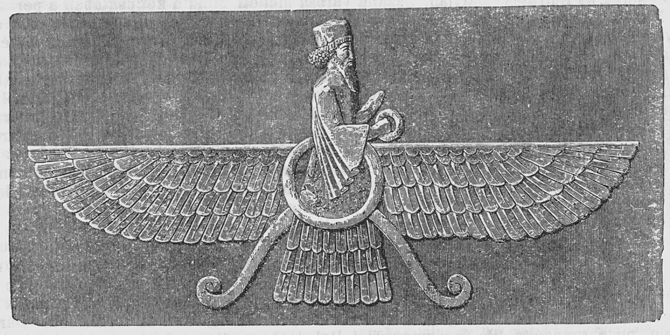 |
nullsome | Ahura Mazda (Wise Lord) | | | |
In the Gathas, attributed to the Ancient Iranian sage Zoroaster, there is one universal, transcendent, all-good, uncreated, omniscient but not omnipotent creator Ahura Mazda (Wise Lord), existing in light and goodness above. Ahura Mazda is opposed by destructive Angra Mainyu, existing in ignorance and darkness below.
Wikipedia: Ahura Mazda #95  |
-560 |
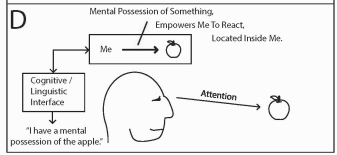 |
three minds | attention | awareness | | |
American neuroscientist Michael Graziano proposed the Attention Schema Theory, which distinguishes:
• attention, which is the selective focus of processing resources, whether on a particular range of sensory signals or internal information
• awareness, which is attention to an internal model of attention, allowing for one's own subjective experience and also for modeling another being's attention
Wikipedia: Attention schema theory
Michael S.A. Graziano. Consciousness Engineered. #94  |
2013 |
 |
three minds | images | words | shapes | |
American political scientist Robert E. Horn, upon encountering the Macintosh computer in 1984, recognized how it allowed drawing to be included in communication. Over the next few years he saw that graphic computer users were developing visual language. He investigated how they integrated:
• words, which name, define, classify, are conceptual, discuss abstractions
• images, which excel at showing who, what (appearance), which (labels), examples, drawing in what "can't be seen"
• shapes, which are abstract, the basis for diagrams, excellent at showing where (maps) and which (definitions)
Robert E. Horn. Visual Language: Global Communication for the 21st Century #93  |
1998 |
![]() |
onesome | world soul (anima mundi) | | | |
Greek philosopher Plato argued in his dialogue Sophist that all things participate in the form of Being, which must have a  psyche (mind and soul). In his dialogues Philebus and Timaeus, he argues that the world is a living being containing all other living beings. The world is endowed with a soul and intelligence (anima mundi). psyche (mind and soul). In his dialogues Philebus and Timaeus, he argues that the world is a living being containing all other living beings. The world is endowed with a soul and intelligence (anima mundi).
Wikipedia: Panpsychism #92  |
-360 |
![]() |
foursome | human | bread | teeth | God |
Lithuanian and Sanskrit share an old saying which means "God gave us teeth, God will give us bread."
• Lithuanian: Dievas dave dantis, Dievas duos duonos
• Sanskrit: Devas adat datas, Devas dasyati dhanas
This saying, which may well date back to Proto-Indo-European, relates God and human, teeth and bread.
The Baltic Languages
#91  |
-3000 |
 |
foursome | S₂ | ¬S₁ | ¬S₂ | S₁ |
Lithuanian-French semiotician Algirdas Greimas, in "Semantique Structurale", applied Aristotle's logical square of opposition to cultural concepts, yielding the semiotic square.
• S₁ is a positive seme, such as "everything"
• S₂ is a negative seme, the opposite of S₁, such as "nothing"
• ¬S₁ is not S₁, not positive, such as "something"
• ¬S₂ is not S₂, not negative, such as "anything"
Wikipedia: Semiotic square
#90  |
1966 |
![]() |
onesome | intermixture | | | |
Greek philosopher Anaxagoras believed that the world is an intermixture of imperishable ingredients, which do not change in the absolute sense, but do change in the relative sense. For the cosmic Mind segregates like from unlike, and so the original completely confused chaotic mixture of infinitely small fragments gradually takes on meaningful forms, which have properties based on the preponderance of their ingredients.
Wikipedia: Anaxagoras #89  |
-450 |
![]() |
nullsome | cosmic mind (nous) | | | |
Greek philosopher Anaxagoras believed that nous (νοῦς), a cosmic Mind or Reason, segregated like from unlike and arranged them. Mind is pure and independent, everywhere the same, manifesting the same. Mind is of finer texture than the mixture that is the universe. Mind is all knowing, all powerful and rules all life forms.
Wikipedia: Anaxagoras #88  |
-450 |
 |
three minds | society | government | | |
American revolutionary Thomas Paine, in his pamphlet Common Sense, distinguished between
• society, into which people are drawn together to live easily and happily
• government, which is a necessary evil, as society grows, to restrain the natural evil inherent in people
Society is produced by our wants, and government by our wickedness; the former promotes our happiness positively by uniting our affections, the latter negatively by restraining our vices. The one encourages intercourse, the other creates distinctions. The first a patron, the last a punisher.
Wikipedia: Common Sense #87  |
1776 |
![]() |
nullsome | love | | | |
In one of the earliest Upanishads, Brihadaranyaka Upanishad 2.4.2–5, Vedic sage Yajnavalkya explains to his wife Maitreyi that love is the connection of one's soul with the universal Self:
Lo, verily, not for love of a husband is a husband dear, but for the love of the Self a husband is dear.
Not for the love of the wife is a wife dear, but for love of the Self a wife is dear.
The gods (Devas) are not dear to one out of love for gods, but because one may love the Self (Atman) that the gods are dear.
Wikipedia: Maitreyi #86  |
-700 |
 |
onesome | Self (Atman) | | | |
In one of the earliest Upanishads, Brihadaranyaka Upanishad 2.4.2–5, Vedic sage Yajnavalkya explains to his wife Maitreyi:
Lo, verily, not for love of a husband is a husband dear, but for the love of the Self a husband is dear.
Not for the love of the wife is a wife dear, but for love of the Self a wife is dear.
The gods (Devas) are not dear to one out of love for gods, but because one may love the Self (Atman) that the gods are dear.
One should indeed see, hear, understand and meditate over the Self, O Maitreyi; indeed, he who has seen, heard, reflected and understood the Self – by him alone the whole world comes to be known.
Renunciation is a means to the knowledge of Self (Atman) and ultimate reality (Brahman), that they are equivalent. Maitreyi's questioning indicates she is a seeker of ultimate knowledge and a lover of Self.
Wikipedia: Maitreyi #85  |
-700 |
![]() |
nullsome | God | | | |
Xenophanes of Colophon, in modern day Türkiye, argued against traditional Greek polytheism. He believed that there is one greatest God, supreme among gods and men, not like mortals in form, body or mind. God is spherical, eternal, comprehends all things within himself, is absolute mind and thought, moves not but moves all things. God is beyond human morality, and apart from human affairs. There is no divine hierarchy.
Wikipedia: Xenophanes #84  |
-520 |
![]() |
onesome | the indivisible | | | |
Zeno of Elea used reductio ad absurdum to defend his teacher's, Parmenides', views that reality is one single indivisible object. Zeno argued against plurality by noting that the process of division implied both finitude and infinitude. He argued against motion and time by noting that distances could always be halved, thus never completed.
Wikipedia: Zeno of Elea #83  |
-450 |
![]() |
nullsome | LORD (Yahweh) | | | |
In Deuteronomy 6:4-5, Moses declares:
Hear, Israel: The LORD is our God. The LORD is one. You shall love the LORD your God with all your heart, with all your soul, and with all your might. #82  |
-560 |
![]() |
nullsome | LORD God | | | |
In Deuteronomy 5:6-10, the LORD God uttered to Moses:
I am the LORD your God, who brought you out of the land of Egypt, out of the house of bondage.
You shall have no other gods before me.
You shall not make a carved image for yourself—any likeness of what is in heaven above, or what is in the earth beneath, or that is in the water under the earth. You shall not bow yourself down to them, nor serve them, for I, the LORD your God, am a jealous God, visiting the iniquity of the fathers on the children and on the third and on the fourth generation of those who hate me and showing loving kindness to thousands of those who love me and keep my commandments. #81  |
-560 |
![]() |
onesome | the One | | | |
Melissus of Samos was a student of Parmenides. He thought of being as the One: ungenerated, indestructible, indivisible, changeless, motionless and the same. He argued, with flawed logic, that the One does not have a beginning, for whatever comes to be must have a beginning, and the One did not come to be. Moreover, the One does not have an end, for whatever has a beginning must have an end, but the One does not have a beginning.
Wikipedia: Melissus of Samos #80  |
-450 |
![]() |
onesome | being | | | |
Parmenides of Elea, according to Aristotle, thought of everything that is as being a substance or essence, and that all such essence is identical, although there may be distinct entities. Any differences, however, are accidental. There is only one moment in time, there is no fundamental change.
Stanford: Parmenides 3.4 The Aspectual Interpretation Prevailing in Antiquity #79  |
-475 |
![]() |
threesome | be | do | think | |
The Institute of Relational Being practices collective imagination. They organized a Think Do Be Nature Camp at the Gathering of Tribes.
Our desire is to make this an inclusive and welcome space where we can come together with curiosity and a willingness to live in more relational ways along with our more-than-human and multispecies communities. #78  |
2024 |
![]() |
onesome | fire - energy - change - theory | | | |
Greek philosopher Heraclitus of Ephesus believed that fire (heat or energy) was the arche, the original principle, which constituted the cosmos by manifesting in different degrees, being kindled or being quenched. He thought logos (theory) gave structure to the world. He viewed the world as always becoming, ever in flux, never simply being.
Wikipedia: Heraclitus #76  |
-500 |
![]() |
onesome | air | | | |
Anaximenes of Miletus, a student of Anaximander, believed that air is the arche, the basic element from which the universe is created. Air could change into other forms by becoming more dense (condensation), yielding wind, clouds, water, earth and stone, or less dense (rarefaction), yielding fire. The Earth floated in air, as did the Sun and stars.
Wikipedia: Anaximenes of Miletus #75  |
-535 |
![]() |
twosome | primordial matter | universe | | |
The Greek philosopher Anaximander taught that the universe originated from the infinite, the unlimited, the apeiron, a primal chaos, through the separation of opposites - hot and cold, wet and dry - distinguishing the four elements. The infinite is indestructible, and from it all things come and all things return.
Wikipedia: Anaximander #74  |
-560 |
![]() |
onesome | the infinite | | | |
Anaximander, a student of Thales, asserted that the original principle was ἄπειρον (apeiron), the infinite, the boundless. He understood this temporally and spatially. It could give birth to whatever will be. Thus the Earth did not float in an ocean but rather floated in the infinite, as in free space.
Wikipedia: Anaximander #73  |
-560 |
![]() |
onesome | water | | | |
Thales of Miletus, in Ionia, Asia Minor, theorized that all of nature was based on water. He thought the Earth floated on water, the ocean, which gave birth to everything.
Wikipedia: Thales of Miletus #72  |
-575 |
![]() |
nullsome | demiurge | | | |
Greek philosopher Plato, through Timaeus, describes the creation of the universe by the demiurge, a divine craftsman, an Intellect. The demiurge brings order out of substance by imitating a paradigm, an unchanging and eternal model, the perfect world of ideal forms. The demiurge is the cause, the father and the maker of the universe. The demiurge, being supremely good, makes the universe supremely beautiful.
Wikipedia: Timaeus (dialogue)
Stanford: Plato's Timaeus
Plato. Timaeus.
Wikipedia: Timaeus (dialogue) #71  |
-360 |
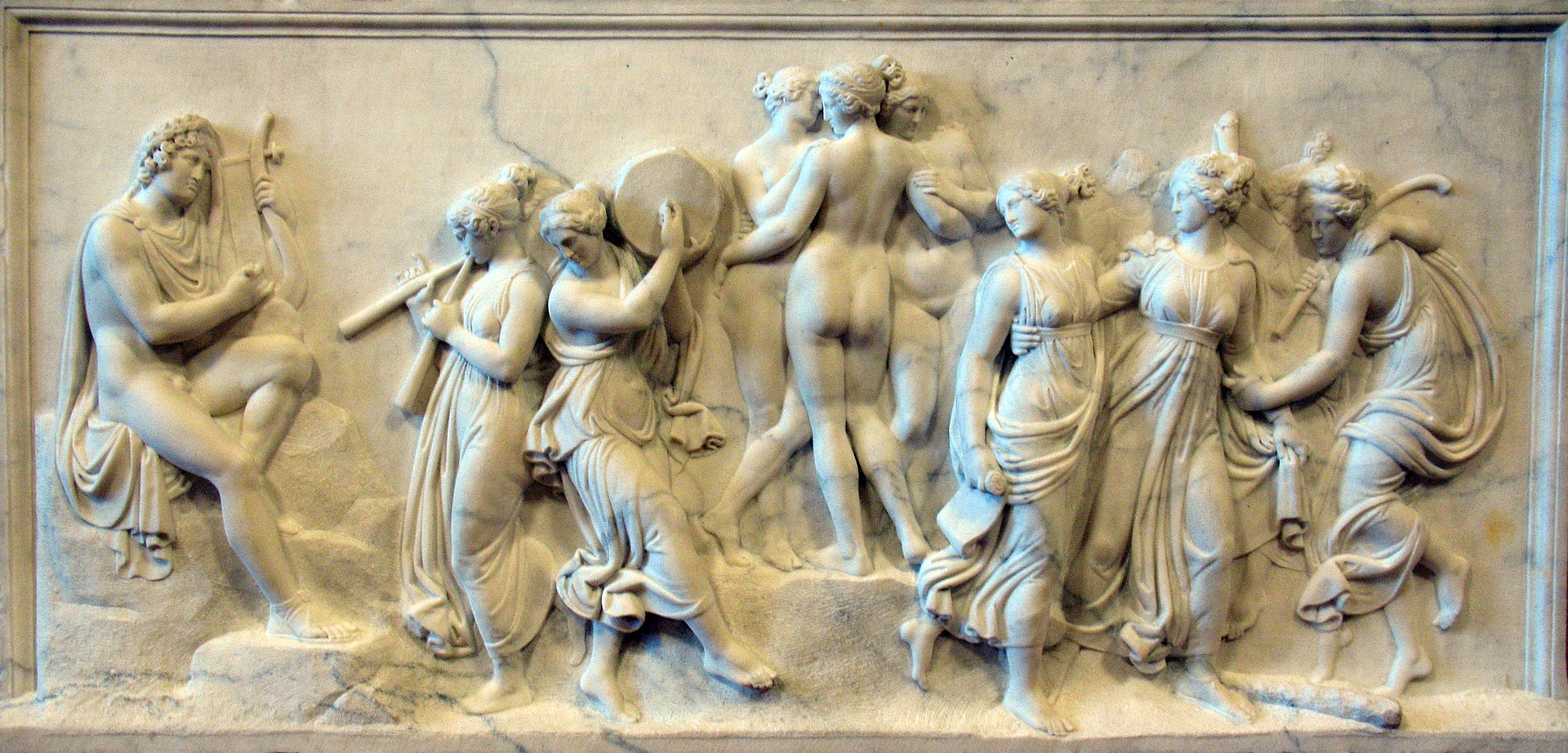 |
nullsome | the Muses | | | |
Hesiod, while shepherding, was taught by the Muses.
...we know how to speak many false things as though they were true; but we know, when we will, to utter true things...
...[they] breathed into me a divine voice to celebrate things that shall be and things there were aforetime; and they bade me sing of the race of the blessed gods that are eternally, but ever to sing of themselves both first and last.
And they, uttering through their lips a lovely voice, sing the laws of all and the goodly ways of the immortals
Hesiod. Theogony.
#70  |
-715 |
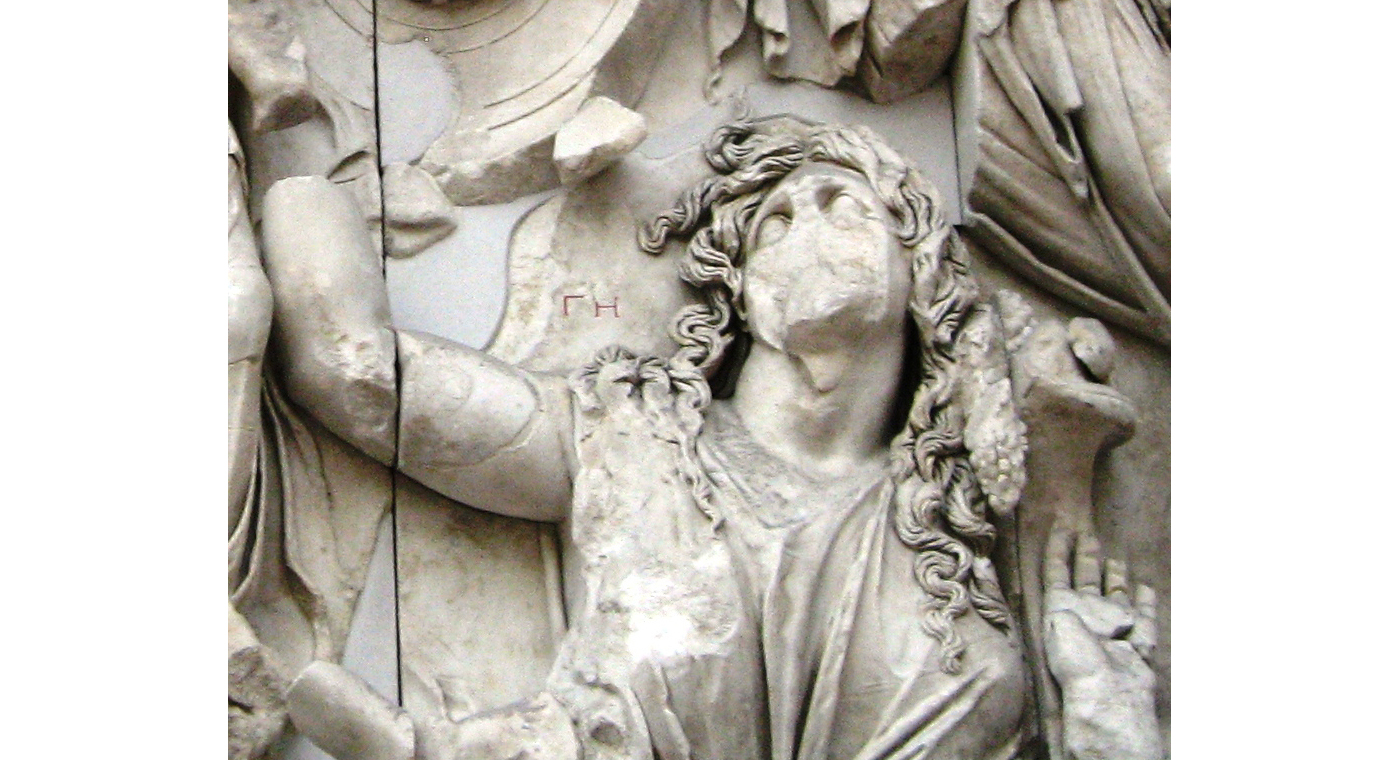 |
twosome | Gaia | the deathless gods of Olympus | | |
Hesiod's Theogony sings of
the wide-bosomed Gaia (Earth), the ever-sure foundations of all the deathless ones who hold the peaks of snowy Olympus #69  |
-715 |
![]() |
onesome | chaos | | | |
Hesiod's Theogony, on the origin of the ancient Greek gods, asserts that chaos was the first thing to be. Chaos is the dark, infinite void that precedes Gaia (earth), Tartarus (the hellish underworld) and Eros (love). Chaos gives birth to Erebus (darkness, gloom) and Nyx (night), which are the father and mother of Aether (bright sky) and Hemera (day). #68  |
-715 |
![]() |
nullsome | fundamental existential challenge of existence | | | |
The normative aspect of Active Inference is that living organisms must face their fundamental existential challenges. The fundamental challenge is existence, in other words, survival and adaptation. Organisms face this by developing adaptive strategies, namely, minimizing their free energy. Active inference researchers similarly face the challenge of creating good models of themselves and other systems.
Unlike many other approaches to computational neuroscience, the challenge is not to emulate a brain, piece by piece, but to find the generative model that describes the problem the brain is trying to solve. Once the problem is appropriately formalized in terms of a generative model, the solution to the problem emerges under Active Inference — with accompanying predictions about
brains and minds. In other words, the generative model provides a complete description of a system of interest. The resulting behavior, inference, and neural dynamics can all be derived from a model by minimizing free energy.
Getting the generative model right — as an apt explanation for the sentient behavior of any experimental subject or creature — is the big challenge.
Thomas Parr, Giovanni Pezzulo, Karl Friston. Active Inference: The Free Energy Principle in Mind, Brain and Behavior
#67  |
2022 |
![]() |
onesome | self-evidencing | | | |
...everything that we perceive, do, or
plan is in the compass of one existential imperative — self-evidencing.
Thomas Parr, Giovanni Pezzulo, Karl Friston. Active Inference: The Free Energy Principle in Mind, Brain and Behavior, Preface #66  |
2022 |
![]() |
threesome | plan | do | perceive | |
Active inference recognizes that making sense of our sensations is an active process of self-evidencing, which manifests in all we plan, do and perceive.
To illustrate the simplicity of Active Inference—and what we are trying to explain—place your fingertips gently on your leg. Keep them there motionless for a second or two. Now, does your leg feel rough or smooth? If you had to move your fingers to evince a feeling of roughness or smoothness, you have discovered a fundament of Active Inference. To feel is to palpate. To see is to look. To hear is to listen. This palpation does not necessarily have to be overt—we can act covertly by directing our attention to this or that. In short, we are not simply trying to make sense of our sensations; we have to actively create our sensorium. In what follows, we will see why this has to be the case and why everything that we perceive, do, or plan is in the compass of one existential imperative—self-evidencing.
Thomas Parr, Giovanni Pezzulo, Karl Friston. Active Inference: The Free Energy Principle in Mind, Brain and Behavior, Preface. #65  |
2022 |
 |
twosome | low road | high road | | |
In the active inference community, pedagogically, there are two roads to active inference.
• The low road develops active inference as a process theory, a biologically plausible mechanistic explanation how a neural system, a Bayesian brain, infers and represents, optimally and approximately, probable causes of whatever it senses.
• The high road motivates active inference as a normative solution for the problem of a living system to persist and act adaptively in a changing environment. Minimizing free energy is what living organisms must do, and minimizing surprise is why they do it.
Thomas Parr, Giovanni Pezzulo, Karl Friston. Active Inference: The Free Energy Principle in Mind, Brain and Behavior, 1.4.1 Part 1: Active Inference in Theory #64  |
2022 |
![]() |
nullsome | free energy principle | | | |
The free energy principle is the minimization of (variational) free energy. It equates existence, self-evidencing and enactive inference. It is the "first principle" of active inference, and ranges far beyond it, beyond neural information processing to ground all of biology, including evolutionary, cellular and cultural.
Thomas Parr, Giovanni Pezzulo, Karl Friston. Active Inference: The Free Energy Principle in Mind, Brain and Behavior #63  |
2006 |
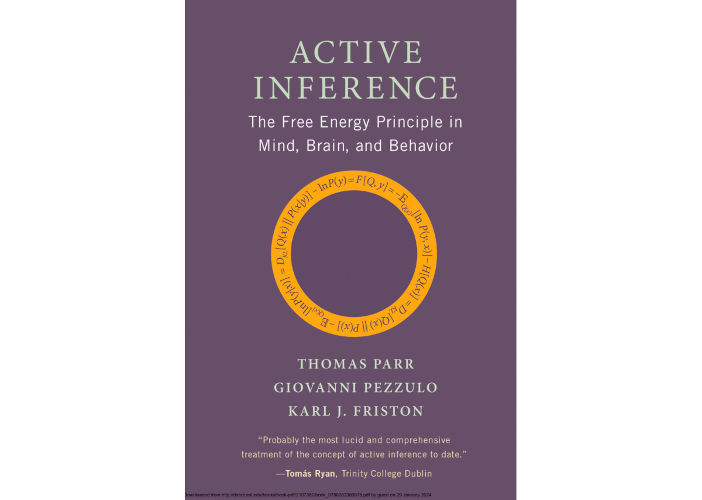 |
threesome | mind | behavior | brain | |
The title of this active inference textbook refers to three domains: mind, brain and behavior.
Thomas Parr, Giovanni Pezzulo, Karl Friston. Active Inference: The Free Energy Principle in Mind, Brain and Behavior #61  |
2022 |
![]() |
twosome | environment | system | | |
Active inference uses Markov blankets to disambiguate
• system - an adaptive system, such as a living organism, which exerts active control over its states to keep them within acceptable ranges, thus is capable of being surprised
• environment - that which a system can be surprised about, which manifests environmental dynamics
Thomas Parr, Giovanni Pezzulo, Karl Friston. Active Inference: The Free Energy Principle in Mind, Brain and Behavior 3.2 Markov Blankets
#60  |
2006 |
![]() |
foursome | data | information | knowledge & understanding | wisdom |
American organizational theorist Russell Ackoff, in his address to the International Society for General Systems Research, distinguished
• data - symbols resulting from sensory observation, representing properties of objects, events and their environments
• information - descriptions extracted and distilled from data by analysis, yielding answers to questions such as who, what, where, when and how many
• knowledge - know-how, how a system works, acquired by learning from others or from experience, making possible control of a system to make it work efficiently, thus exercising intelligence, by transforming information into instructions, increasing the probability of the desired outcome or decreasing the resources likely required
• understanding - knowing why errors are made and how to correct them
• wisdom - the ability to foster effectiveness, development and potential, rather than efficiency, growth and attainment. Development cannot be given or imposed for it is a process increasing desire and ability to satisfy one's own needs, as well as those of others
Russell Ackoff. From Data to Wisdom. Presidential Address to ISGSR, June 1988. Journal of Applied Systems Analysis, Volume 16, 1989. #59  |
1988 |
![]() |
foursome | know-nothing | know-what | know-how | know-why |
Czech-American economist Milan Zelenyi, professor of management systems, identified
• data as know-nothing
• information as know-what
• knowledge as know-how
• wisdom as know-why
Wikipedia: DIKW pyramid
Zeleny, Milan. "Management Support Systems: Towards Integrated Knowledge Management". Human Systems Management. 7 (1): 59–70. 1987. #58  |
1987 |
![]() |
foursome | data | information | | |
Nicholas Henry, an American scholar of public administration, distinguished
• data, the raw facts that do not change us
• information, the raw facts that do change us
Nicholas L. Henry. Knowledge Management: A New Concern for Public Administration. Public Administration Review. Vol. 34, No. 3 (May - Jun., 1974), pp. 189-196.
#57  |
1974 |
![]() |
foursome | | knowledge | intelligence | wisdom |
Clarence Walker Barron, founder of modern financial journalism, gave a talk to his employees:
Knowledge, Intelligence and Wisdom: an Address to the Staff of Dow, Jones & Co.
Wikipedia: DIKW pyramid #56  |
1927 |
![]() |
foursome | | information | knowledge | wisdom |
English modernist poet T.S.Eliot wrote in his Choruses, for the pageant play "The Rock":
Where is the wisdom we have lost in knowledge?
Where is the knowledge we have lost in information?
This is cited as an inspiration for the data-information-knowledge-wisdom pyramid.
Wikipedia: DIKW pyramid #55  |
1934 |
![]() |
onesome | prima materia | | | |
German alchemist Martin Ruland the Younger described prima materia in his "Lexicon alchemiae":
...the philosophers have so greatly admired the Creature of God which is called the Primal Matter, especially concerning its efficacy and mystery, that they have given to it many names, and almost every possible description, for they have not known how to sufficiently praise it.
He lists more than 50 synonyms: Microcosmos, The Philosophical Stone, The Eagle Stone, Water of Life, Venom, Poison, Chamber, Spirit, Medicine, Heaven, Clouds, Nebula or Fog, Dew, Shade, Moon, Stella Signata and Lucifer, Permanent Water, Fiery and Burning Water, Salt of Nitre and Saltpetre, Lye, Bride - Spouse - Mother - Eve, Pure and Uncontaminated Virgin, Milk of Virgin - or the Fig, Boiling Milk, Honey, A Spiritual Blood, Bath, A Syrup, Vinegar, Lead, Tin, Sulphur of Nature, Spittle of the Moon, Ore, The Serpent, The Dragon, Marble - Crystal - Glass, Scottish Gem, Urine, Magnesia, Magnet, White Ethesia, White Moisture, White Smoke, Dung, Metallic Entity, Mercury, The Soul and Heaven of the Elements, The Matter of all Forms, Tartar of the Philosophers, Dissolved Refuse, The Rainbow, Indian Gold, Heart of the Sun, Chaos, Venus, Healer, Angel of violet light.
Wikipedia: Prima materia #54  |
1612 |
![]() |
onesome | prima materia | | | |
Theatrum Chemicum, a compendium of alchemical writings, includes a description of prima materia, the primitive formless base for all matter, thus the starting point of alchemy, having all the qualities and properties of elementary things.
They have compared the "prima materia" to everything, to male and female, to the hermaphroditic monster, to heaven and earth, to body and spirit, chaos, microcosm, and the confused mass; it contains in itself all colors and potentially all metals; there is nothing more wonderful in the world, for it begets itself, conceives itself, and gives birth to itself.
Wikipedia: Prima materia #53  |
1613 |
![]() |
foursome | expected value | state | observable | measurement |
The Dirac-von Neumann axioms of quantum mechanics, formulated in terms of a complex Hilbert space H of countably infinite dimension, suppose for a quantum system that
• states ψ are rays in H, in other words, unit vectors of H up to complex scalar multiples
• observables are self-adjoint operators A on H, that is, <Ax,y>=<x,Ay> for all x,y ∈ H
• measurements assign states to observables
• the expected value of observable A for a system in state ψ, given repeated measurements, is <Aψ,ψ>=<ψ,Aψ>
Wikipedia: Dirac-von Neumann axioms
#52  |
1932 |
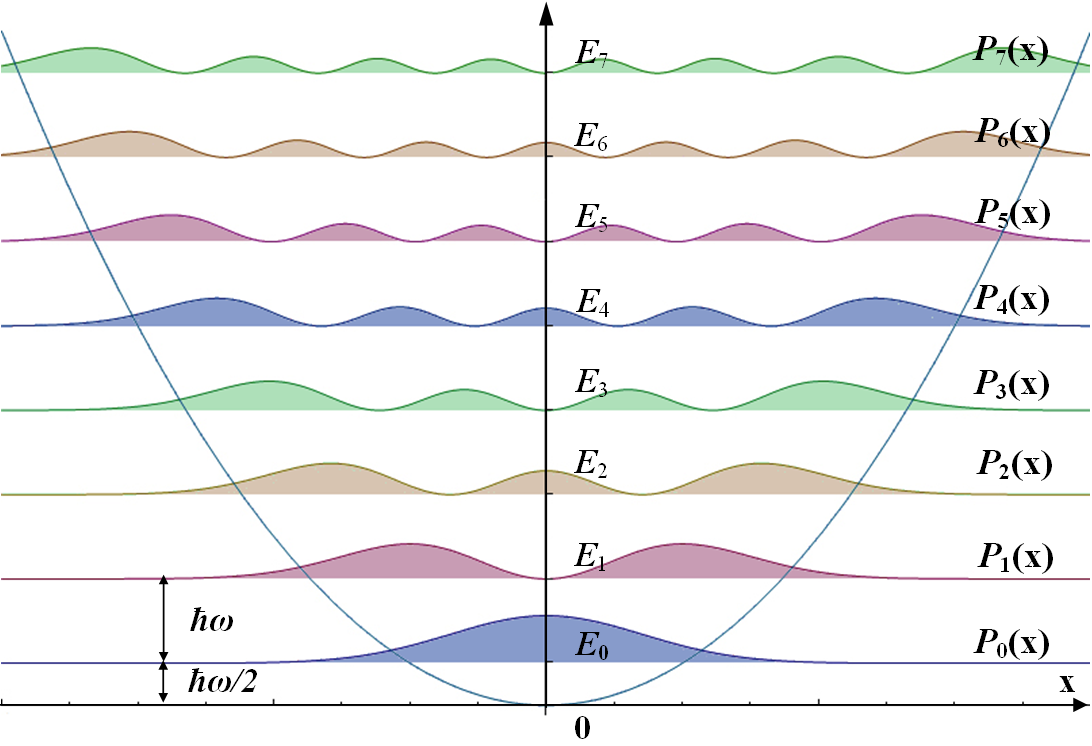 |
three minds | state | observable | measurement | |
The Dirac-von Neumann axioms of quantum mechanics, formulated in terms of a complex Hilbert space H of countably infinite dimension, suppose for a quantum system that
• states ψ are rays in H, in other words, unit vectors of H up to complex scalar multiples
• observables are self-adjoint operators A on H, that is, <Ax,y>=<x,Ay> for all x,y ∈ H
• measurements assign states to observables, and the expected value of observable A for a system in state ψ is <Aψ,ψ>=<ψ,Aψ>
Wikipedia: Dirac-von Neumann axioms
#51  |
1932 |
![]() |
foursome | causa materialis | causa formalis | causa efficiens | causa finalis |
Martin Heidegger, in "The Question Concerning Technology", echoed Aristotle's fourfold causality, distinguishing
• causa materialis, the material, the matter out of which something is made
• causa formalis, the form, the shape into which the material enters
• causa finalis, the end, in relation to which the thing required is determined as to its form and matter
• causa efficiens, which brings about the effect that is the finished thing
The Question Concerning Technology #50  |
1954 |
![]() |
foursome | structure | activity or trait | causation and development | adaptation and evolution |
Dutch biologist Nikolaas Tinbergen in "On Aims and Methods in Ethology, extending the work of Julian Huxley, distinguished four levels of analysis of animal behavior.
• Evolutionary (ultimate) explanations why evolved the structures it has
◦ Function (adaptation) why this structure helps with a reproductive or survival problem in the current environment
◦ Phylogeny (evolution) why this structure evolved in the species over many generations
• Proximate explanations how an organism's structures function
◦ Mechanism (causation) how the structures work mechanically
◦ Ontogeny (development) how an individual's structures developed from DNA
Wikipedia: Tinbergen's four questions #49  |
1963 |
![]() |
foursome | | physics | physics: mechanics | metaphysics |
In "Novum Organum", Francis Bacon distinguished
• metaphysics, the investigation of eternal and immutable forms, fundamental laws
• physics, the investigation of the efficient cause (mechanics) and of matter, and the latent process and latent configuration, what ordinarily occurs in nature
Wikipedia: Four causes #48  |
1620 |
![]() |
foursome | | material | efficient | form |
Francis Bacon, in his "Advancement of Learning", spoke interms of Plato's notion of ideal forms and Aristotle's four causes in asserting that natural science considers only material and efficient causes (matter and forces) but not forms. He thought of forms as ideal laws of nature.
Wikipedia: Four causes #47  |
1605 |
 |
three minds | induction | syllogism | | |
English statesman and philosopher Francis Bacon, in "Novum Organum", attacked syllogism and promoted induction as the way to investigate and discover truth.
• Syllogism is often applied to supposedly indubitable truths, yielding questionable conclusions, detached from reality.
• Induction focuses on the senses and particulars and builds up conclusions, step-by-step, of ever greater certainty and generality.
Novum Organum #46  |
1620 |
![]() |
foursome | tribe | cave | market | theatre |
Francis Bacon, the founder of empiricism, in his "Novum Organum", warned that objective reasoning must reject four idols of received doctrine:
• idols of the tribe (Idola tribus) are rooted in human nature, our physical senses, the false regularities they presuppose.
• idols of the cave (Idola specus) are prejudices specific to each individual soul, their inclinations and education.
• idols of the market (Idola fori) are conventions that facilitate fellowship and commerce but introduce errors and confusion through badly defined words and fallacious ideas.
• idols of the theatre (Idola theatri) are culturally received philosophical dogmas which are simply fictions.
Wikipedia: Novum Organum
#45  |
1620 |
![]() |
foursome | matter | form | agent | finality |
Thomas Aquinas, in his Commentary on the Sentences of Peter Lombard, demonstrated that Aristotle's four causes are the only causes. He ordered them: matter is made perfect by form, form is made perfect by agent, and agent is made perfect by finality.
Wikipedia: Four causes #44  |
1256 |
 |
three minds | possible intellect | agent intellect | | |
Aristotle argued that since the mind can think when it wishes, there must be two faculties:
• Possible intellect is a "blank tablet" which stores the abstract concepts that the mind can consider.
• Agent intellect recalls these ideas and combines them to form thoughts. It also abstracts the content of sensed objects and stores that as concepts in the possible intellect.
Wikipedia: On the Soul #43  |
-350 |
 |
three minds | sensitive | rational | | |
Aristotle (384-322 BCE) distinguished three kinds of soul.
• Plants have a nutritive soul by which they nourish themselves and reproduce.
• Animals moreover have a sensitive soul by which they sense, feel pleasure and pain, and desire, may imagine and remember.
• Humans moreover have a rational soul by which they think when they wish, possibly falsely.
Wikipedia: On the Soul #42  |
-350 |
 |
foursome | final | formal | efficient | material |
Aristotle (384-322 BCE) in his Physics and his Metaphysics, spoke of four kinds of reasons - four causes - that could be given as explanations why.
• material cause is the natural, latent potential of the raw material, as with marble
• formal cause is the pattern or form by which a thing is of a particular type, as with an iconic image
• efficient cause is the agent which causes change and drives transient motion, as with a chisel
• final cause is the end or purpose for the sake of which a thing is done, as with a statue
Wikipedia: Four causes
Stanford: Aristotle on Causality #41  |
-329 |
 |
foursome | stone as thing | stone as appearance | stone as location | |
In the Gospels, Jesus fasts for 40 days and then is tempted in three ways, all related to stone:
• The tempter came and said to him, “If you are the Son of God, command that these stones become bread.”
• Then the devil took him into the holy city. He set him on the pinnacle of the temple, and said to him, “If you are the Son of God, throw yourself down, for it is written, ‘He will command his angels concerning you,’ and, ‘On their hands they will bear you up, so that you don’t dash your foot against a stone.’"
• Again, the devil took him to an exceedingly high mountain, and showed him all the kingdoms of the world and their glory. He said to him, “I will give you all of these things, if you will fall down and worship me.”
Wikipedia: Temptation of Christ #40  |
100 |
 |
foursome | word is taken away | word does not take root | word is choked | word bears fruit |
Jesus explained his parable of the sower: Don’t you understand this parable? How will you understand all of the parables? The farmer sows the word.
• The ones by the road are the ones where the word is sown; and when they have heard, immediately Satan comes and takes away the word which has been sown in them.
• These in the same way are those who are sown on the rocky places, who, when they have heard the word, immediately receive it with joy. They have no root in themselves, but are short-lived. When oppression or persecution arises because of the word, immediately they stumble.
• Others are those who are sown among the thorns. These are those who have heard the word, and the cares of this age, and the deceitfulness of riches, and the lusts of other things entering in choke the word, and it becomes unfruitful.
• Those which were sown on the good ground are those who hear the word, accept it, and bear fruit, some thirty times, some sixty times, and some one hundred times.”
Wikipedia: Parable of the Sower #39  |
70 |
 |
three minds | flesh | spirit | watch and pray | |
Jesus, at Gethsemane, asked his disciples to keep watch while he prayed, but they fell asleep. What, couldn’t you watch with me for one hour? Watch and pray, that you don’t enter into temptation. The spirit indeed is willing, but the flesh is weak. He thus distinguished flesh and spirit, but also a third faculty that can keep watch and pray.
Matthew 26:40-41 #38  |
88 |
![]() |
foursome | mixture of the unlimited and the limited | unlimited | limited | cause of the mixture of the unlimited and the limited |
Plato (c.427-348 BCE) wrote his dialogue Philebus between 360 and 347 BCE. In it, Socrates divides all of reality into four categories:
• the unlimited (ápeiron), whatever can be increased or decreased, as with "warm" or "cold"
• the limited (péras), as with mathematical quantities
• the mixture of the unlimited and the limited
• the cause of the mixture of the unlimited and the limited, namely measure and order
Wikipedia: Philebus #37  |
-353 |
![]() |
three minds | neural networks | symbolic processing | combined | |
The history of artificial intelligence has two main threads.
• Neural networks are bottom up implementations inspired by the connections by which neurons in the brain process information. In 1943, Walter Pitts and Warren McCulloch analyzed networks of idealized artificial neurons.
• Top down implementations are based on high-level symbolic representations of problems, concepts, logic and algorithms. In 1955, Allen Newell and Herbert Simon created the Logic Theorist, which proved theorems in logic and math.
• Combined approaches are increasingly popular.
Wikipedia: History of artificial intelligence #36  |
1955 |
![]() |
three minds | brain | mind | laws of life | |
American British fund manager John Templeton identified 200 laws in his "Worldwide Laws of Life". He remarked on Marcus Aurelius's teaching, "Your life becomes what you think" by distinguishing brain and mind. "The mind, which is invisible, directs the thinking process. It tells the brain how to sort experience and fact, and how to give shape and form to new ideas." Moreover, in the introduction, he speaks of understanding and practicing the laws of life, the set of rules by which we should live, the spiritual law (the Tao) by which things work, the relationship between thoughts, feelings, ideas and the physical activities which express them.
Templeton. Worldwide Laws of Life: 200 Eternal Spiritual Principles. #35  |
1998 |
 |
three minds | judicial | executive | legislative | |
Political philosopher Montesquieu of the French Enlightenment argued in "The Spirit of Law" that liberty depended on the distribution of political powers amongst three branches:
• legislative power to enact laws and amend or abrogate them
• executive power to make peace or war, conduct diplomacy, provide against invasions and establish public security
• judicial power to punish criminals and resolve disputes
Wikipedia: Separation of powers: Montesquieu's_separation_of_powers_system #34  |
1748 |
![]() |
three minds | sensory input | internal model | minimize surprise | |
British neuroscientist Karl Friston introduced the free energy principle, a theoretical framework of active inference, according to which the brain reduces surprise or uncertainty by developing internal models for making predictions and responds to sensory input by updating the model or adjusting the environment.
Karl Friston, James Kilner, Lee Harrison. A free energy principle for the brain.
#33  |
2006 |
![]() |
three minds | stimuli | sensations | | |
German physicist and physician Hermann von Helmholtz, inspired by Hermann Lotze, developed a notion of unconscious inference. Objects and sensations are linked by sense nerves. Sensations are not copies of stimuli but are rather signs which symbolize those stimuli. Furthermore, the mind makes its own mental adjustments, unconscious inferences, to construct a coherent picture of experience, practicing and learning skills, such as depth perception, or the identification of various objects.
Wikipedia: Unconscious inference
Stanford: Hermann von Helmholtz
#32  |
1868 |
![]() |
three minds | facts | laws | standards of value | |
German philosopher Rudolf Hermann Lotze lectured on a wide range of philosophical subjects. In bringing unity to culture, he sought to combine the study of the
• laws by which the mind is obliged to think about things
• facts of the world outside (cosmology) and the world within (psychology)
• standards of value by which we approve or disapprove, aesthetically and ethically, thus establishing culture
Wikipedia: Hermann Lotze #31  |
1874 |
![]() |
three minds | muscle sensations | local signs | | |
German philosopher and biologist Rudolf Hermann Lotze proposed in "Microcosmus: An Essay Concerning Man and His Relation to the World" that there are innate anatomical mechanisms such that when a muscle stimulates a nerve, that stimulus is converted into a local sign (Lokalzeichen) which is interpreted by the mind as refering to a particular location in space.
Stanford: Hermann Lotze #30  |
1856 |
 |
three minds | synthetic a posteriori | analytic a priori | synthetic a priori | |
Immanuel Kant, perturbed by skeptic David Hume's paradoxical critique of causal thinking, teased out the distinction between knowledge a posteriori (after the fact, empirically) and a priori (before the fact, necessarily) and the distinction between statements which are synthetic (fused together, bottom up) and analytic (broken up, top down). In his resolution of the paradox, Kant distinguished
• synthetic a posteriori statements - which we gather and assemble from experience
• analytic a priori statements - which we deduce logically from first principles
• synthetic a priori statements - which apply the innate templates by which we engage and comprehend the world, which hold in parallel with the world
Wikipedia: Immanuel Kant #29  |
1781 |
 |
three minds | judgment | practical reason | pure reason | |
German philosopher Immanuel Kant published his Critique of Pure Reason in 1781, Critique of Practical Reason in 1788, and Critique of Judgment in 1790. These three faculties each have their own stance.
• Judgment makes determinations in terms of how we ourselves feel, whether regarding sensory, aesthetic knowledge, or abstract, teleological ideas. What may I hope?
• Practical reason formulates the course of action that we are to take morally, supposing that we have free will. What should I do?
• Pure reason circumscribes the limits of our knowledge, what we are able to know about what we are able to know. What can I know? #28  |
1781 |
 |
three minds | matters of fact | relations of ideas | | |
David Hume, in An Enquiry Concerning Human Understanding, distinguished
• matters of fact - contingent, associative, synthetic, dependent on observer, discoverable by experience, known after the fact - a posteriori
• relations of ideas - necessary, universal, analytic, true before verification - a priori
This pronounced distinction came to be known as Hume's fork.
Wikipedia: Hume's Fork #27  |
1748 |
 |
three minds | impressions | ideas | | |
Scottish skeptic, empiricist, naturalist David Hume, in "A Treatise of Human Nature: Being an Attempt to Introduce the Experimental Method of Reasoning into Moral Subjects", divides mental perceptions into
• impressions - sensory, forceful, lively, vivacious
• ideas - which are reflections on impressions, copies of impressions
Wikipedia: David Hume #26  |
1739 |
 |
three minds | quid facti | quid juris | quid jus | |
German philosopher Immanuel Kant, in his Critique of Pure Reason, II.I.9, appealed to the legal distinction between
• quid facti - the question of fact: by what facts?
• quid juris - the question of right: by what right?
Philosophy Stack Exchange. What is Quid Juris?
In "The Metaphysical Elements of Justice", he also distinguished between quid juris and
• quid jus - the question of justice, the concept of law - by what concept of law?
Paul Dominic. 'Quid jus?' and 'Quid juris?' #25  |
1781 |
 |
three minds | carnal | soulish | spiritual | |
Paul, in his first letter to the Corinthians, characterizes people based on how they receive his teaching.
• Carnal people (sarkivós) attend to the flesh, thus suffer jealousy and strife.
• Soulish people (psychikós) attend to the mind, are atuned to human wisdom, and find spiritual matters foolish and incomprehensible.
• Spiritual people (pneumatikos) attend to the spirit, that which is of beyond the world, that which relates spiritual people with spiritual matters.
Wikipedia: Tripartite (theology) #24  |
53 |
![]() |
three minds | impulsive | reflective | | |
Social psychologists Fritz Strack and Roland Deutsch distinguished two systems for decision making.
• In the impulsive system, decisions are made using schemes and little thought is required.
• In the reflective system, decisions are made using knowledge and processing incoming information.
Fritz Strack, Roland Deutsch. Reflective and impulsive determinants of social behavior.
Wikipedia: Dual process theory #23  |
2004 |
![]() |
three minds | economic | martial | sacral | |
French mythographer Georges Dumézil investigated his trifunctional hypothesis that prehistoric Proto-Indo-European society (and subsequent Southern Russian, Germanic, Norse, Greek, Indian societies) consisted of three classes as reflected in myths.
• performed economic functions and were ruled by the other two classes.
• Warriors waged war.
• Priests judged in disputes and tended to supernatural concerns.
Wikipedia: Trifunctional hypothesis #22  |
1929 |
 |
three minds | right hemisphere | left hemisphere | | |
American cognitive neuroscientist Roger Sperry, his students Michael Gazzaniga and Jerre Levy and other colleagues studied split-brain patients, whose brain hemispheres were disconnected and shown to differ in behavior.
• The right hemisphere possesses capabilities for gestalt, problem solving, recognizing faces, symbolic reasoning, art, and spatial relationships
• The left hemisphere is the primary area for analysis, language, needed for naming, better at writing, speaking, reading and mathematical calculation.
Wikipedia: Split-brain
John Cutting. Principles of psychopathology: two worlds, two minds, two hemispheres
R.W.Sperry. Hemisphere deconnection and unity in conscious awareness. #21  |
1967 |
 |
three minds | sensibility | sense | | |
Jane Austen's novel "Sense and Sensibility" contrasts two sisters.
• Elinor Dashwood, age 19, has sense, feels responsible for family and friends, places their interests above her own, suppresses her own strong emotions, is perceived as indifferent or cold-hearted.
• Marianne Dashwood, age 16, manifests sensibility, is romantically inclined, eagerly expressive, is attracted to a handsome, romantically spirited man.
Wikipedia: Sense and Sensibility #20  |
1811 |
 |
three minds | McCoy | Spock | Kirk | |
American television producer Gene Roddenberry's science fiction series Star Trek featured three officers of the starship USS Enterprise.
• Chief Medical Officer Dr. Leonard H. "Bones" McCoy champions human emotional feelings, compassionately, sardonically.
• Science Officer Spock, half human, half alien, solves problems using logic coolly, imperturbably.
• Captain James T. Kirk commands the ship and makes tough decisions relying on the advice of Spock and McCoy.
Wikipedia: Star Trek: The Original Series #19  |
1966 |
 |
three minds | heuristic | analytic | dispositional | |
British psychologist Jonathan ST.B.T. Evans, responding to the theory of hypothetical thinking by Evans, Over and Handley, extended his own model, distinguishing:
• heuristic processes that construct the most plausible or relevant model and then apply that to make inferences and judgments
• dispositional processes that (depending on the task at hand, available time, motivation, personal choice) intervene or not to switch from heuristic processes to analytic processes
• analytic processes that explicitly reason and evaluate whether the model is satisfactory, though also subject to biases, such as minimizing the challenge to existing models
Jonathan ST.B.T. Evans. The heuristic-analytic theory of reasoning: Extension and evaluation #18  |
2006 |
 |
three minds | heuristic | analytic | | |
British cognitive psychologist Jonathan St B.T. Evans of Plymouth University distinguished
• heuristic processes, which generated representations of problem content, as relevant, though possibly omitting relevant or including irrelevant information
• analytic processes, which derived inferences or judgments based on those representations
Evans. Heuristic and analytic processes in reasoning. British Journal of Psychology. 75 (4): 451–468.
Wikipedia: Dual process theory #17  |
1984 |
![]() |
three minds | performance | introspection | | |
Cognitive psychologists Wason and Evans introduced dual process theory in discussing an experiment on the four-card problem where subjects select cards to determine whether it is true that "If a card has a vowel on one side, then it has an even number on the other side". They distinguished performance (selecting cards) and introspection (justifying the selection). They argued that performance precedes and causes introspection, yielding rationalization.
Peter Cathcart Wason, Jonathan ST.B.T. Evans. Dual processes in reasoning? #16  |
1974 |
![]() |
three minds | least exacting | most convenient | least effort | |
Guillaume Ferrero articulated the law of least effort. An information seeker will generally use the most convenient search method in the least exacting mode available.
Wikipedia: Principle of least effort #15  |
1894 |
![]() |
three minds | associative | rules based | | |
Cognitive scientist Steven Sloman of Brown University overviewed the history of the distinction of
• associative reasoning with calculations based on similarity structure and temporal contiguity
• rules based reasoning based with calculations based on rules that operate on symbolic structure with logical content and variables
He also notes the interest in hybrid systems.
Steven A. Sloman. The Empirical Case for Two Systems of Reasoning.
#14  |
1996 |
![]() |
three minds | heuristic | systematic | | |
American social psychologist Shelly Chaiken developed the Heuristic-systematic model of information processing which distinguishes
• heuristic processing - retrieving and applying a judgmental rule contextually regarding the validity of a message without fully processing the semantics of a message
• systematic processing - comprehensive, analytic, detailed, cognitive processing of judgment-relevant information, comprehending the content and evaluating the arguments
Wikipedia: Heuristic-systematic model of information processing #13  |
1980 |
![]() |
three minds | peripheral | central | | |
Richard E. Petty and John Cacioppo proposed the Elaboration Likelihood Model of persuasion, with two major routes:
• peripheral route processes have low elaboration, require little thought, as by classical conditioning and mere exposure
• central route processes have high elaboration, require more thought, as with expectancy-value and cognitive processes, resulting in greater persistence and resistance to change
Wikipedia: Elaboration likelihood model #12  |
1980 |
 |
three minds | random experience | reason | intuition | |
Dutch Portuguese Jewish philosopher Baruch Spinoza, in his Ethics, distinguished
• the first kind of knowledge - knowledge from random experience, sensory images, pains and pleasures, confused ideas, from a given perspective at a given time, that something is, arising from effects upon the body
• the second kind of knowledge - reason, true and adequate ideas, perfect knowledge, of what and how and why things are, and could not be otherwise, arising from discourse and inference, comprehending its causal and conceptual relations to all things, including the modes of God, what is inherently necessary and not contingent
• the third kind of knowledge - intuition, personally grasps what is known by reason with a single unified insight
Stanford: Baruch Spinoza #11  |
1677 |
![]() |
three minds | associative thought | true reasoning | | |
Pragmatist philosopher William James, founder of American psychology, distinguished
• associative thought - empirical thinking - trains of images suggested one by another - which is reproductive, based on past experience
• true reasoning - which is productive, can deal with novel data, helps us out of unprecedented situations
Steven A. Sloman. The Empirical Case for Two Systems of Reasoning.
#10  |
1890 |
![]() |
three minds | experiencing self | remembering self | | |
Experimental psychologists Daniel Kahneman and Jason Riis conducted experiments to distinguish
• an experiencing self, which attests to the pleasure or pain felt at any moment
• a remembering self, which subsequently reflects on the pleasure or pain felt
Daniel Kahneman, Jason Riis. Living, and thinking about it: two perspectives on life
Kahneman later summarized this: "I am my remembering self, and the experiencing self, who does my living, is like a stranger to me."
Wikipedia: Thinking, Fast and Slow #9  |
2005 |
 |
three minds | beauty | virtue | piety | |
The 3rd Earl of Shaftesbury, in his "Inquiry Concerning Virtue and Merit", argued that what is beautiful, being harmonious and proportionable, is thereby true. And what is both beautiful and true, is agreeable and good.
There is a common and natural sense of what is sublime and beautiful in things.
...the admiration and love of order, harmony and proportion of whatever kind is naturally improving to the temperament and to social affection, and extremely helpful to virtue - which is itself nothing but the love of order and beauty in society.
...whatever the order of the world produces is mainly just and good. Therefore in the course of events in this world, whatever hardship may seem to force from any rational creature a hard censure of his private condition or lot, he can still through reflection come to have patience and to acquiesce in it.
virtue is not complete unless it is accompanied by piety, because where piety is lacking there can’t be the same benignity, firmness, or constancy, the same good composure of affections, or uniformity of mind.
Anthony Ashley Cooper, Earl of Shaftesbury. An Inquiry Concerning Virtue or Merit.
#8  |
1711 |
 |
three minds | beautiful | virtuous | and | |
The ancient Greek phrase καλὸς κἀγαθός (kalos kagathos) means the beautiful (kalos) and virtuous (agathos). Since the days of Herodotus it described the ideal man, the gentleman, the chivalrous warrior. The Athenian aristocracy thus referred to itself.
Wikipedia: Kalos kagathos #7  |
-430 |
![]() |
three minds | thesis | antithesis | synthesis | |
Johann Gottlieb Fichte, a founder of German idealism, gave lectures, published in 1794/1795 as Foundations of the Science of Knowledge, where he related three ideas.
• thesis is a formal statement
• antithesis is an opposing statement
• synthesis is their resolution based on what they have in common
This relation thesis-antithesis-synthesis is often used to refer to Hegel's triadic thinking which came later.
Scholarly Community Encyclopedia: Thesis, Antithesis, Synthesis #6  |
1794 |
 |
three minds | appetite | spunk | reason | |
Greek philosopher Plato described in his Republic three classes which manifested three parts of the soul.
• Commoners (farmers, artisans) should live in moderation. They manifest appetite (epithumetikon).
• Warriors should moreover be brave. They manifest spunk (thumetikon).
• Rulers should moreover be wise. They manifest reason (logistikon).
Wikipedia: Plato's theory of soul #5  |
-375 |
 |
three minds | id | superego | ego | |
Jewish Austrian neurologist Sigmund Freud, founder of psychoanalysis, introduced id, ego, superego in his 1920 essay "Beyond the Pleasure Principle" and formalized them in his 1923 essay "The Ego and the Id".
• The id is the dark, inaccessible part of our personality, the unconscious source of bodily needs and wants, emotional impulses and desires, satisfying drives (aggressive and sexual) by seeking pleasure.
• The ego is the reason and common sense, the organizing principle for thoughts and interpretations, which minds the reality of the external world, seeks self-preservation by balancing the demands of the id, external world and superego.
• The superego is the conscience, the internalization of cultural rules, absorbed from parents and authorities, expressing ideals and personal goals.
Wikipedia: Id, ego and superego #4  |
1920 |
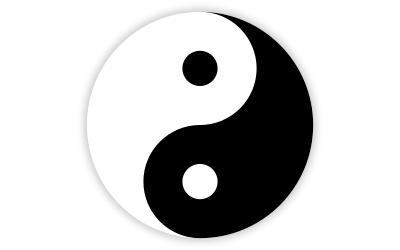 |
three minds | yīn 陰 | yáng 陽 | | |
Chinese philosopher Zou Yan (305-240 BCE) founded the Yin and Yang School.
• Yin is the feminine or negative principle (characterized by dark, wetness, cold, passivity, disintegration, etc). The dark side of the hill.
• Yang is the masculine or positive principle (characterized by light, warmth, dryness, activity, etc). The sunny side of the hill.
Wikipedia: Yin and Yang #3  |
-275 |
 |
three minds | firstness | secondness | thirdness | |
American thinker Charles Sanders Peirce, inspired by Kant, distinguished three universal categories.
• Firstness is a monic relationship, as with a quality.
• Secondness is a dyadic relationship of a relate and a correlate.
• Thirdness is a triadic relationship of a sign, object and interpretant.
Wikipedia: Categories (Peirce) #2  |
1867 |
 |
three minds | System 1 | System 2 | | |
Experimental psychologists Daniel Kahneman and Amos Tversky distinguished two different ways the brain forms thoughts.
• System 1 is fast, automatic, frequent, emotional, stereotypic, unconscious.
• System 2 is slow, effortful, infrequent, logical, calculating, conscious.
Wikipedia: Thinking, Fast and Slow #1  |
2011 |
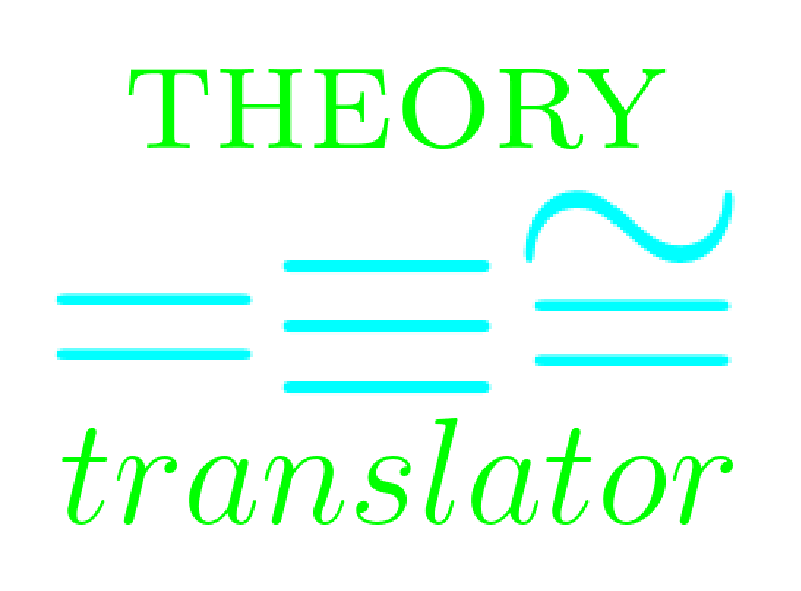
 Suggest an example!
Suggest an example!















































































































































































































































































































































